Exercise collection
Discover 300+ exercises with easy guides, showing how to do each move and the muscles they work.
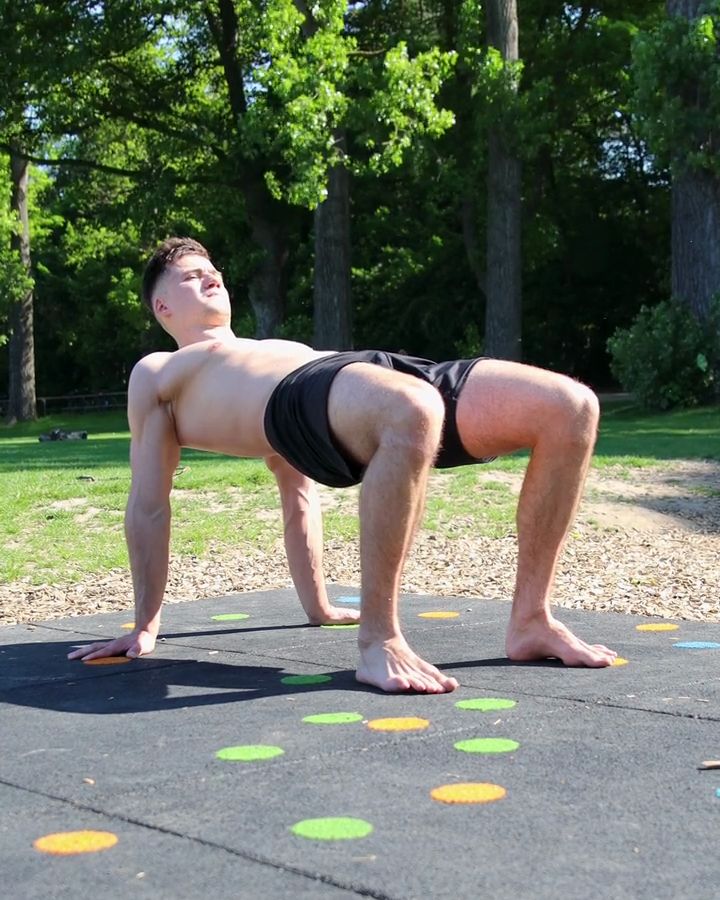
Table Top Hold
This static exercise from the calisthenics world can enhance your strength, mobility, and flexibility levels. It is particularly effective for the shoulders, upper back, and triceps, and is excellent for beginners.
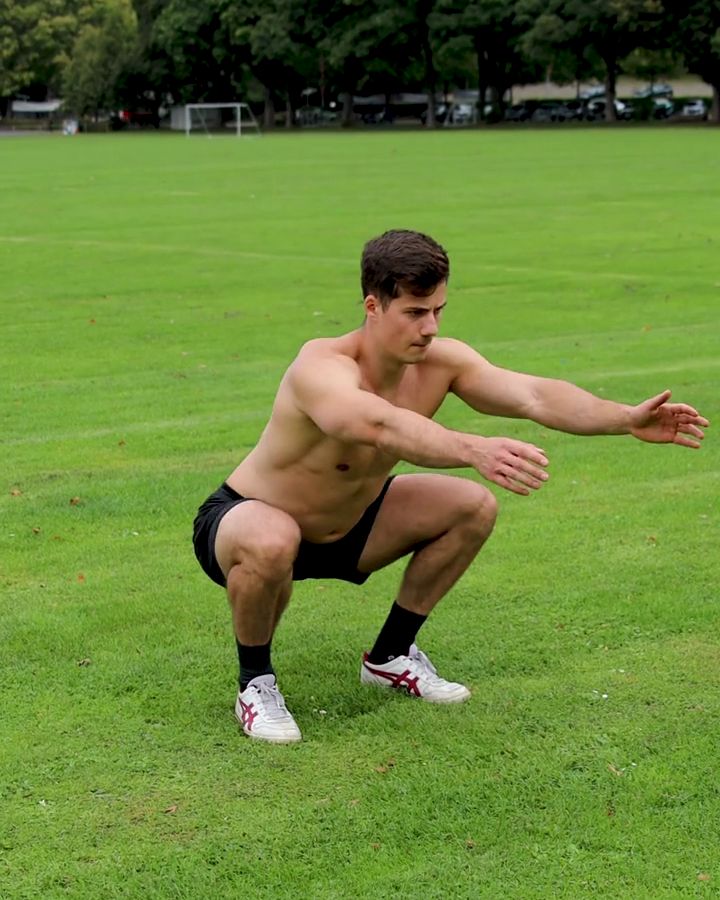
Bodyweight Squats
The bodyweight squat is probably the most well-known fitness exercise in the world. It strengthens your legs and glutes. However, it is not as easy to perform as it looks. Many still think that it's bad to push the knees beyond the toes. This myth has long been debunked. Much more important is that you perform the movement slowly and controlled, gradually increasing it. If you can perform 20-30 bodyweight squats, then goblet squats, barbell squats, or assisted single-leg squats could be a great progression.
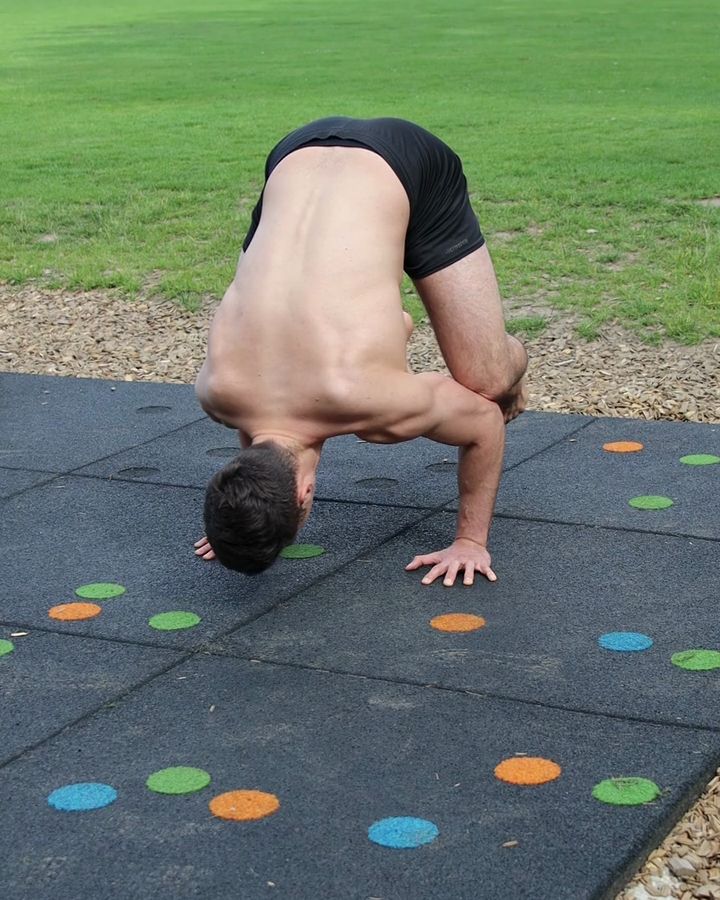
Crow Pose / Frog Stand
The Crow Pose, also known as the Yoga Crow or Frog Stand, is more of a balance exercise than an upper body strength workout. Wrist mobility and proper weight shifting over the hands are key. To overcome the fear of falling, it can help to rest your head lightly on the floor—this provides stability and a sense of security. The exercise starts from a squat: place your hands shoulder-width apart, rest your knees on your upper arms, and shift your weight forward until your feet lift off the ground. Advanced practitioners can try the one-legged Crow, where one leg is lifted, requiring extra core and arm strength. A more challenging variation is pressing from the Crow into a Handstand.
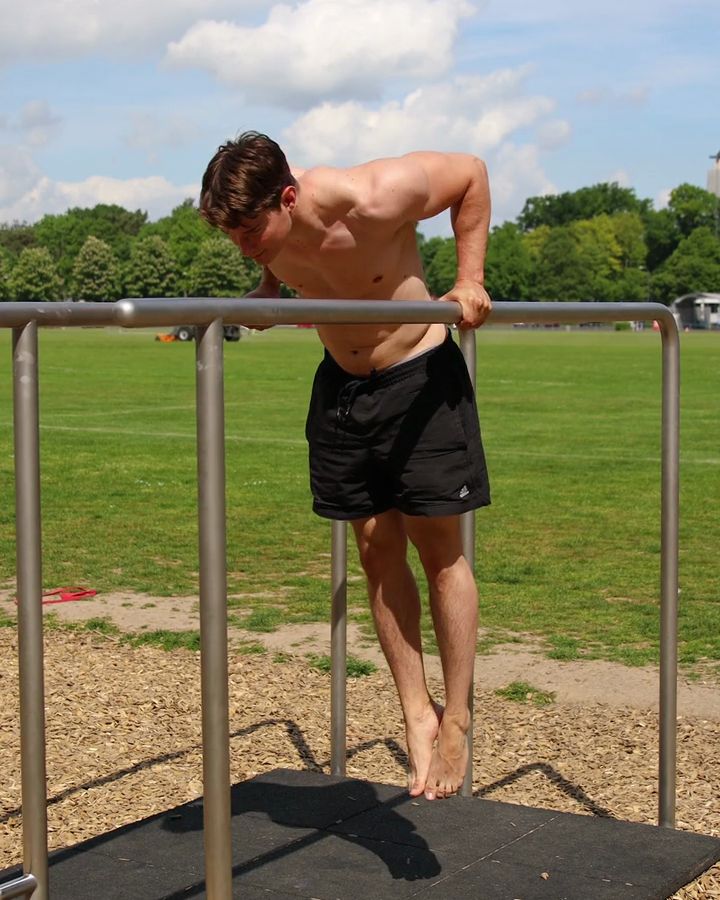
Dips on the Parallel Bars
Parallel Bar Dips are an effective exercise for building strength and muscle mass, particularly in the chest and triceps area. They are well-suited for training with additional weight, such as a weight vest or dip belt. Although parallel bar dips require less stabilization than Ring Dips, they are ideal for anyone looking to specifically build muscle mass and strength.
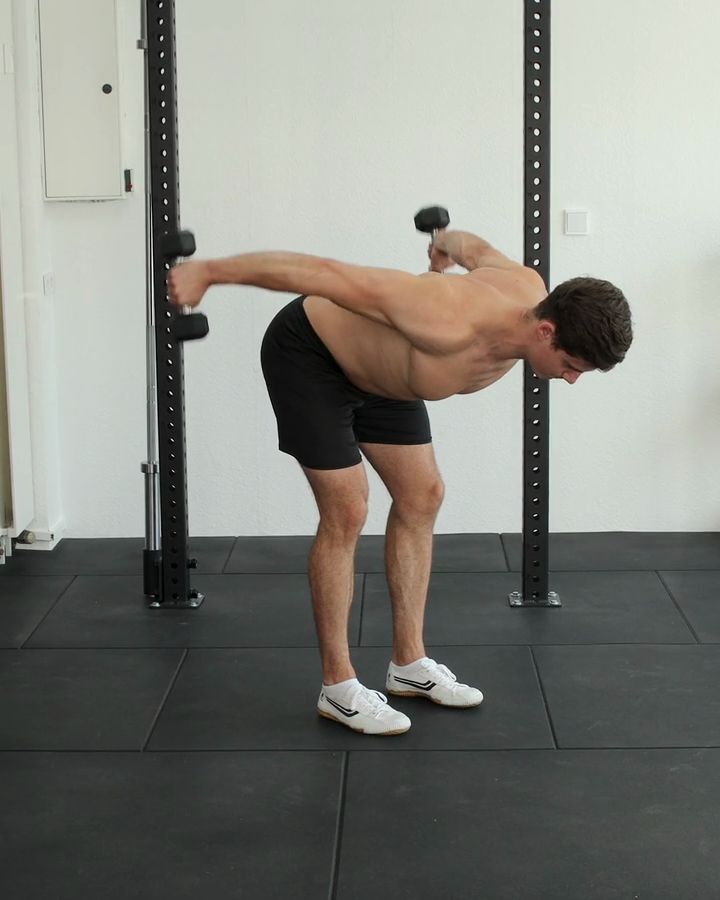
A Raises with dumbbells
This exercise is perfect for strengthening the upper back and shoulders. It is easy to learn and ideal for building muscle.
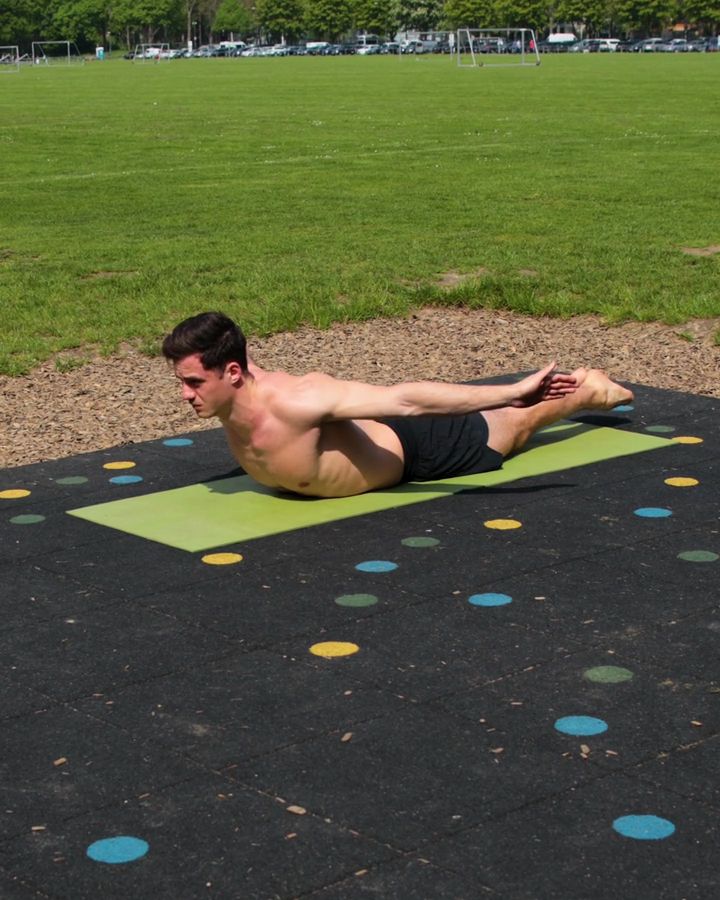
Superman Exercise
Effectively train and strengthen your lower back muscles with this proven bodyweight exercise. Ideal for beginners, it focuses on proper form and requires no special equipment.
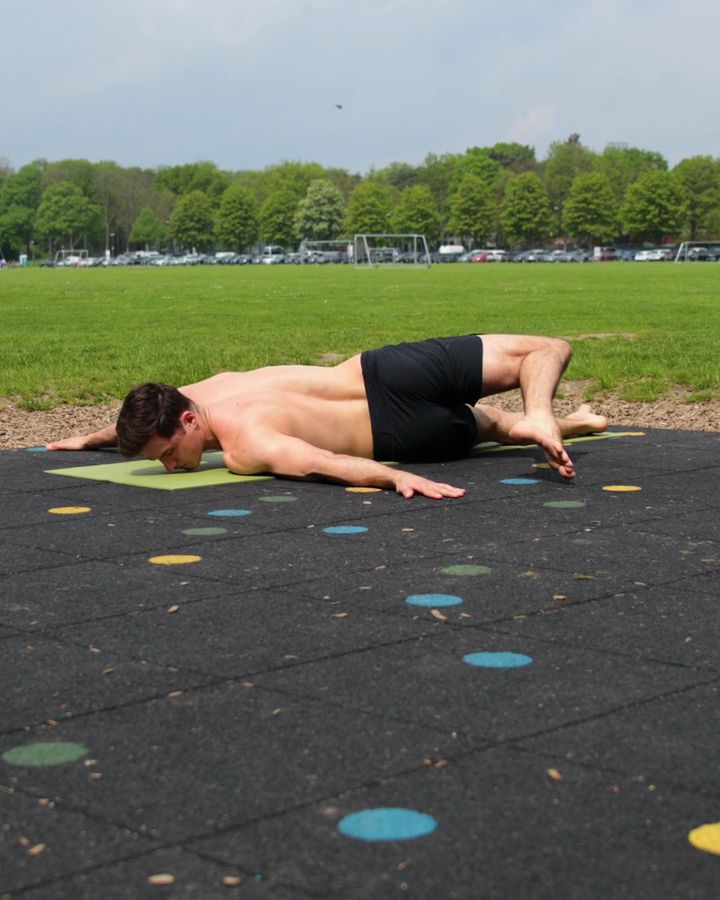
Scorpion Stretch
The scorpion stretch is ideal for improving the mobility of your lower back. It primarily targets the strengthening and flexibility of your hip and lumbar spine muscles.
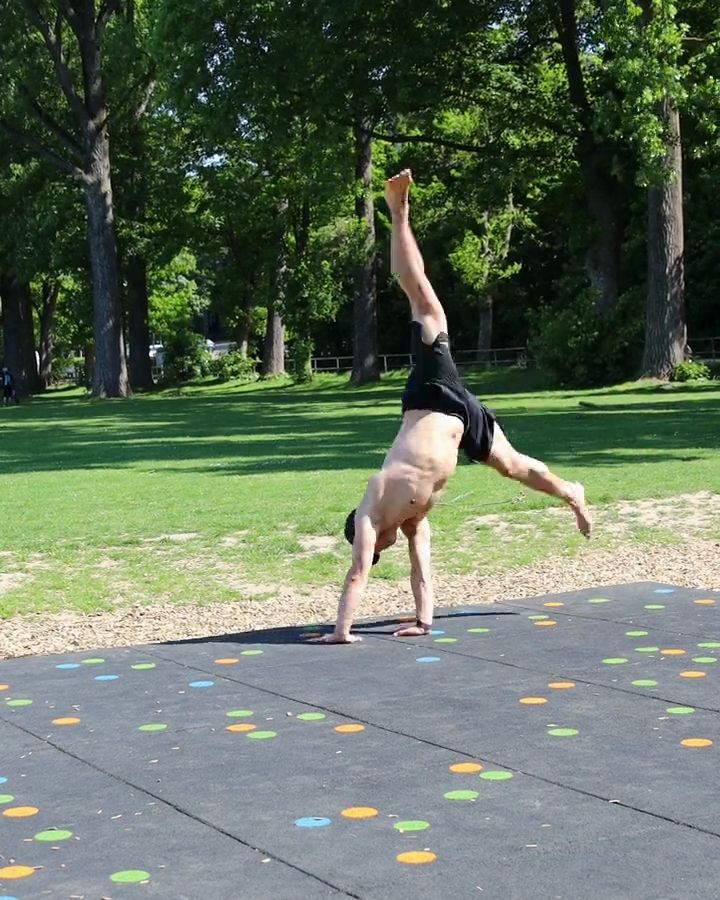
How to Cartwheel
Practicing cartwheels can increase your shoulder strength and prepare you for demanding movements like the Handstand. This advanced exercise also helps improve flexibility in the hips and shoulders.
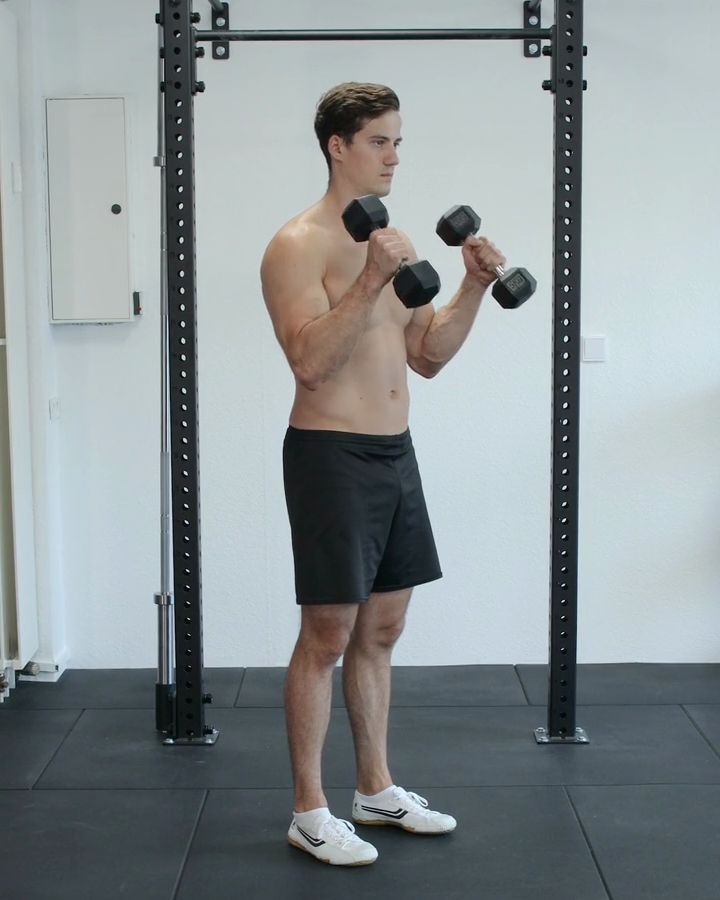
Hammer Curls with dumbbells
Hammer curls work more on the muscles on the side and underside of your upper arm, especially the brachialis and brachioradialis. This exercise helps to make your upper arms and forearms overall stronger and thicker by targeting different muscles than regular Biceps Curls. Using dumbbells makes it easy to perform and well-suited for beginners. Regular hammer curls are performed with both arms simultaneously.
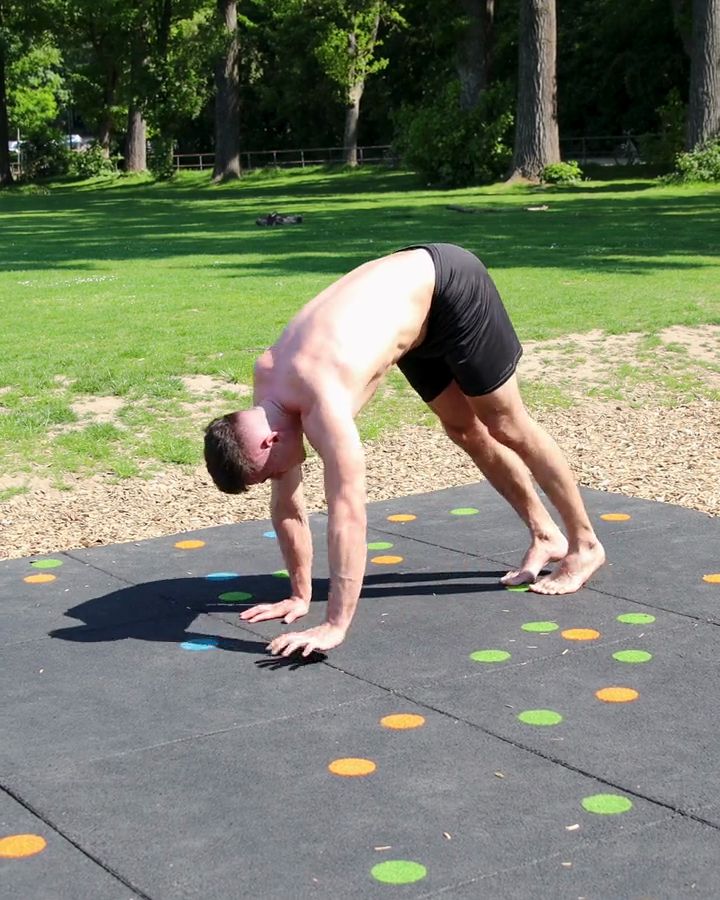
Inchworm
The inchworm is a classic exercise from Crossfit that primarily trains your shoulders and mobilizes the back of your legs. It is also suitable for beginners and can help you lay the foundation for more demanding exercises like the Handstand.
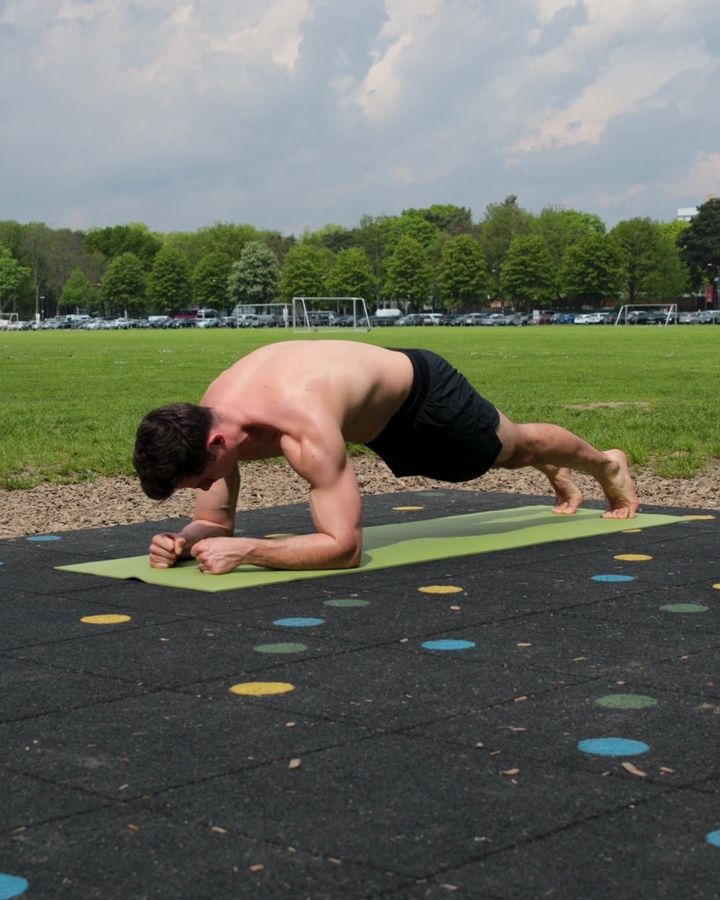
Plank
The plank is one of the most widespread exercises for the abdominal muscles. No equipment is needed, so it can be done anywhere. However, a common mistake is not tightening the glutes and allowing the body to sag. This means the abdominal muscles are not working, and instead, the passive musculoskeletal system, including the spine, bears the load. Read here to find out what you need to watch out for to perform it correctly.
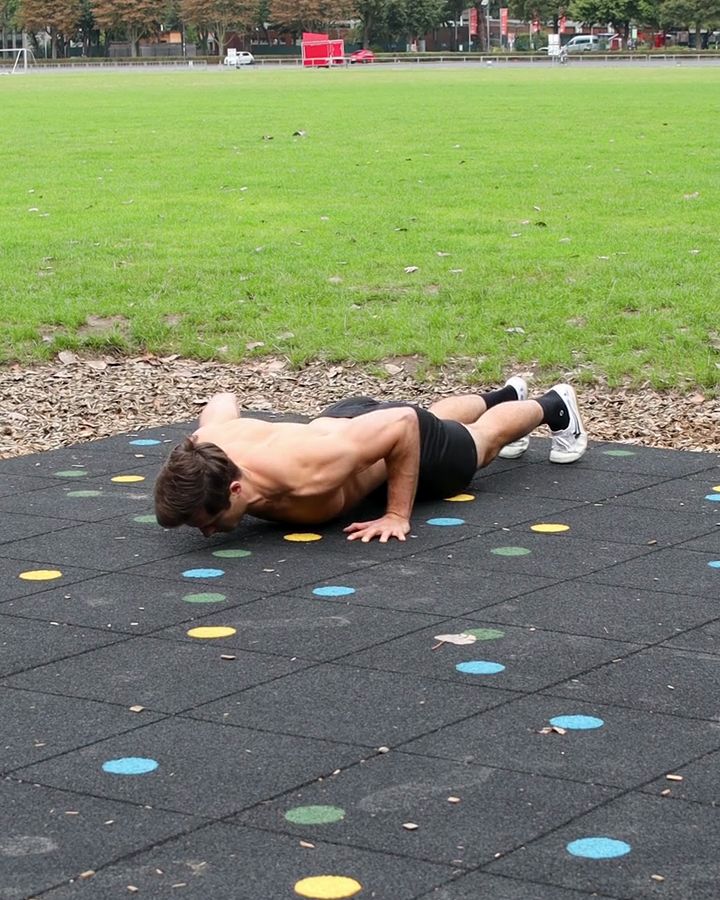
Push Ups
Push-ups are one of the most versatile and effective exercises for home workouts and are suitable for all fitness levels. Different variations can target specific muscle groups such as the chest, shoulders, and triceps. In calisthenics, there are numerous push-up variations that incorporate different equipment and positions. Particularly popular are diamond push-ups, which intensely target the triceps. Push-ups on gymnastics rings are especially interesting for advanced practitioners. There are also push-up variations that specifically target the shoulders, like pike push-ups. Calisthenics professionals will enjoy more advanced exercises such as archer push-ups or Bulgarian push-ups.
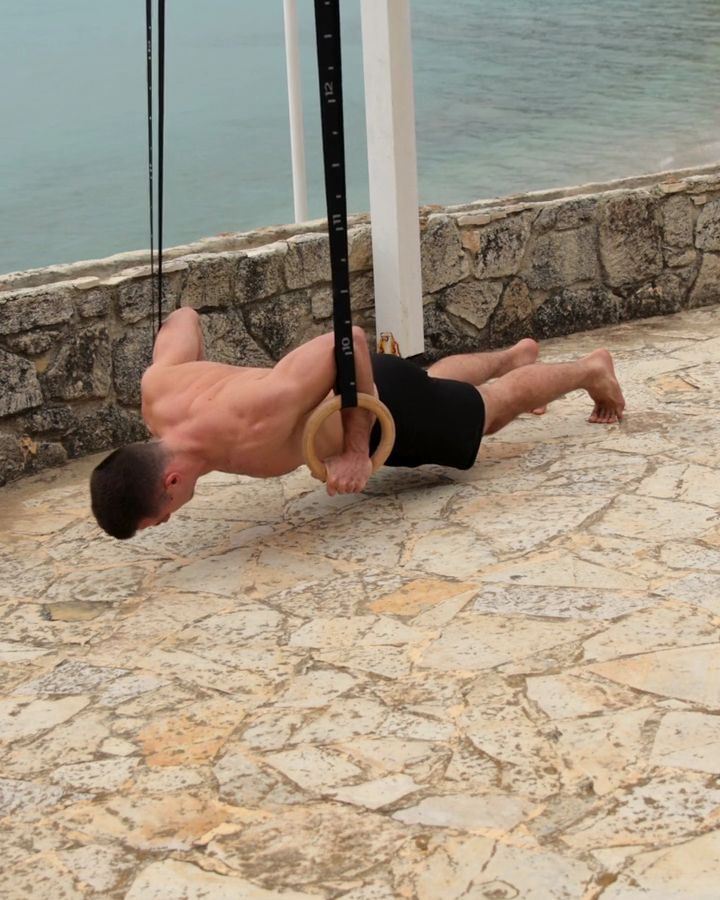
Push Ups on the rings
Ring push ups are an excellent exercise for the chest muscles. Since the rings move freely in space, the chest can be stretched and contracted more effectively during the push up. In other words, we have a greater range of motion compared to regular push ups on the floor. Additionally, we have observed that many people who experience shoulder pain with push ups on the floor can perform push ups on the rings without pain.
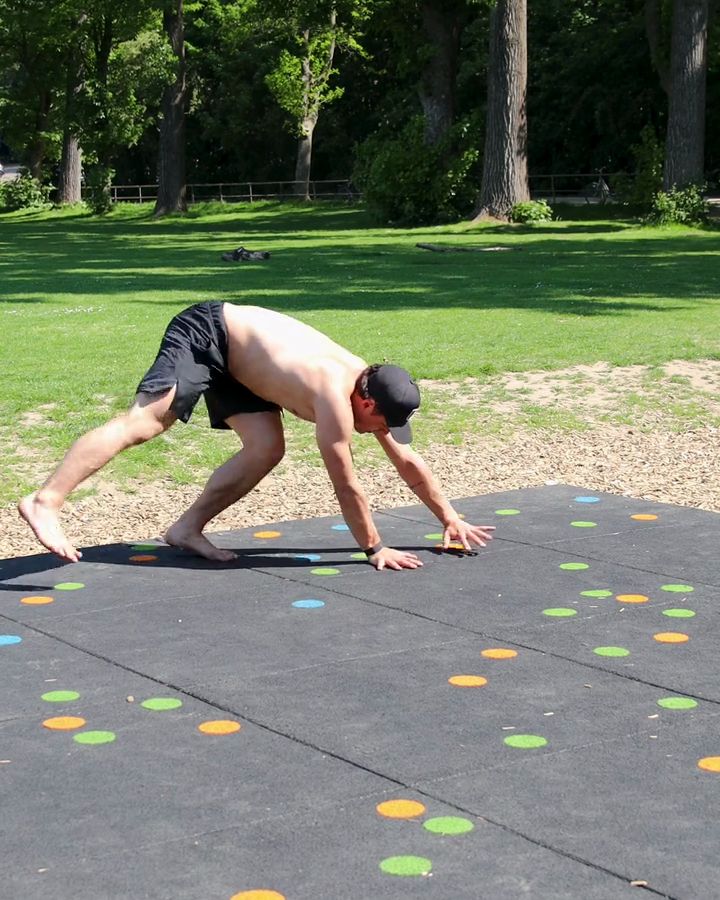
Animal Move - Monkey
Animal Moves are fitness exercises where you move like different animals. The monkey is perfect for beginners. This exercise helps you work towards more challenging exercises like the Handstand.
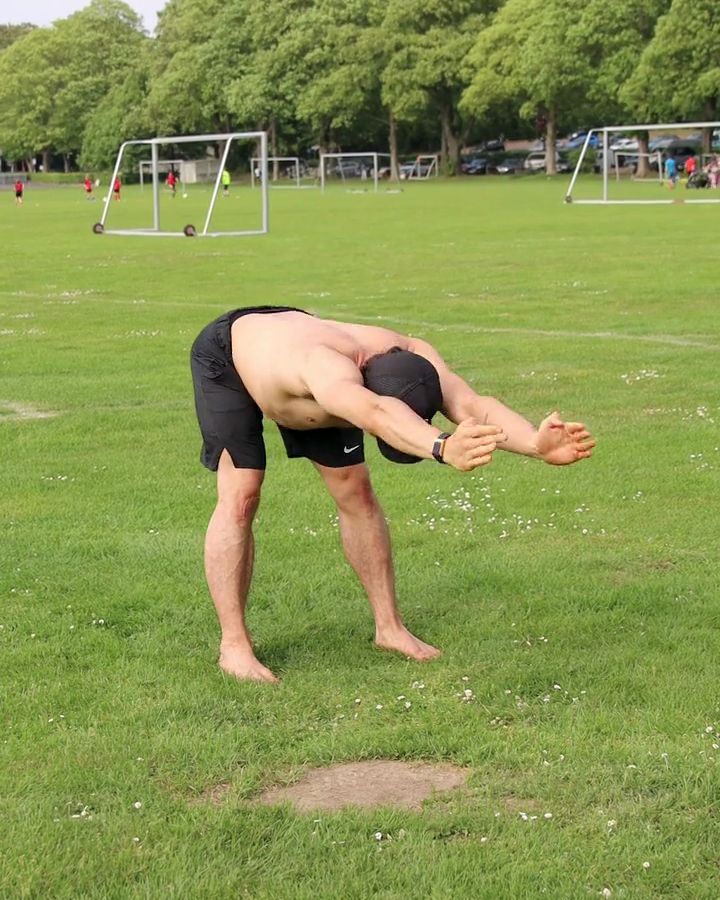
Good Mornings
This exercise primarily targets your glutes, hamstrings, and lower back. It is ideal for beginners, positively impacting mobility and supporting muscle growth. For advanced practitioners, Weighted Good Mornings are recommended.
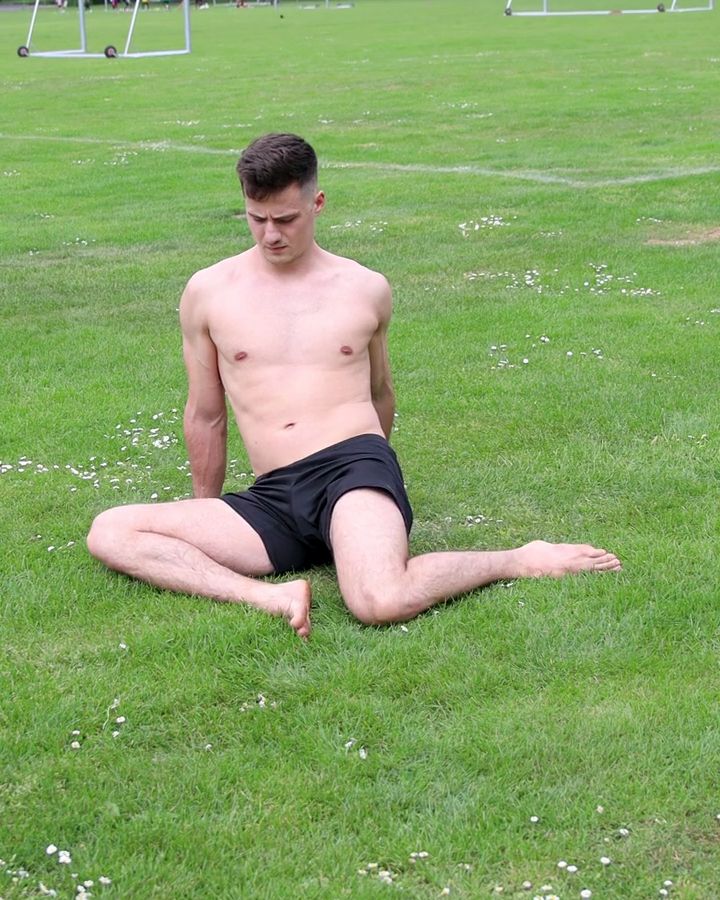
90 90 Stretch
This stretching exercise primarily targets your gluteal muscles and improves the mobility of your hips and knees. It is especially suitable for beginners in calisthenics and requires no additional equipment.
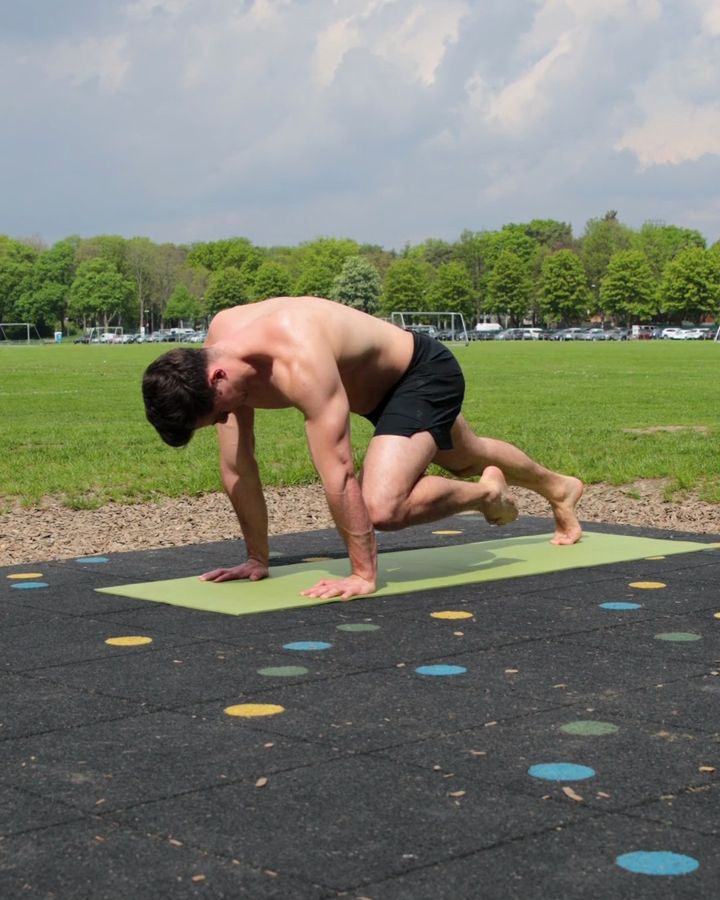
Mountain Climbers
The mountain climber, also known as the running plank, is a versatile exercise that works the entire body, focusing on the arms, shoulders, quadriceps, and core. This exercise, which is especially suitable for beginners, is performed from the high plank or static push-up position by alternately bringing one knee to the chest and back, mimicking a running motion against the ground. Despite its apparent simplicity, the mountain climber engages the whole body and increases heart rate, making it an excellent addition to a morning workout, whether at home, in the gym, or even at the office.
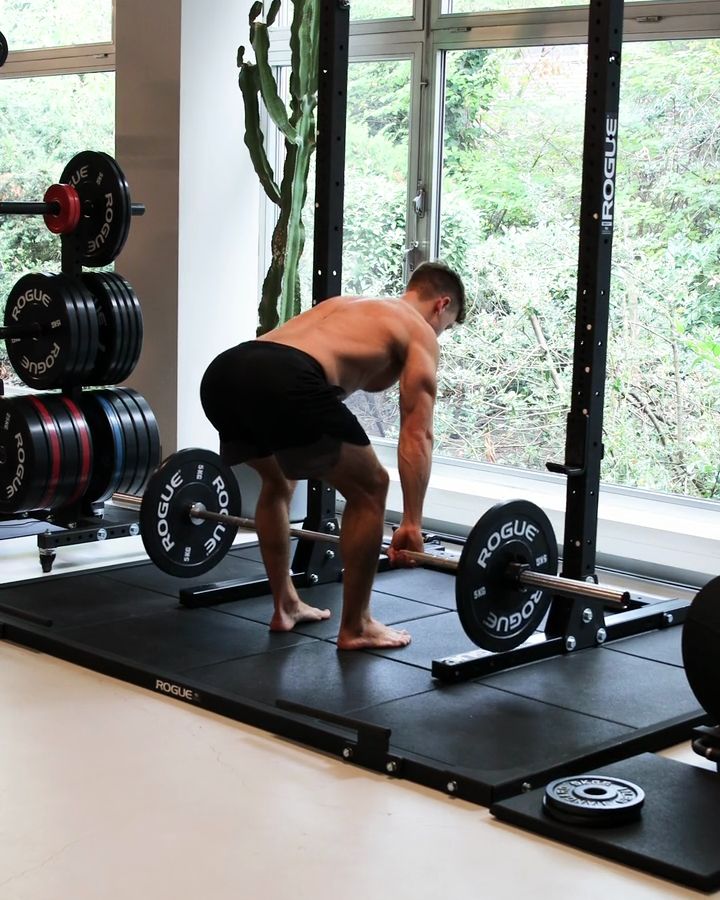
Romanian Deadlift with a barbell
The Romanian deadlift, also known as the "Romanian Deadlift" or simply "RDL," is an excellent exercise for strengthening the posterior chain, particularly the lower back, hamstrings, and glutes. Unlike the classic barbell deadlift, where the movement starts from a deeper position, the Romanian deadlift keeps the knee position almost unchanged, with the focus on a controlled hip hinge. This allows for targeted activation of the posterior muscle groups while also being gentle on the knee joints. The origin of the Romanian deadlift dates back to 1990 when a Romanian weightlifter introduced this technique in the United States to provide Olympians with a new method for developing strength and athleticism. Since then, the exercise has become a staple in gyms worldwide and can be performed with both barbells and dumbbells.
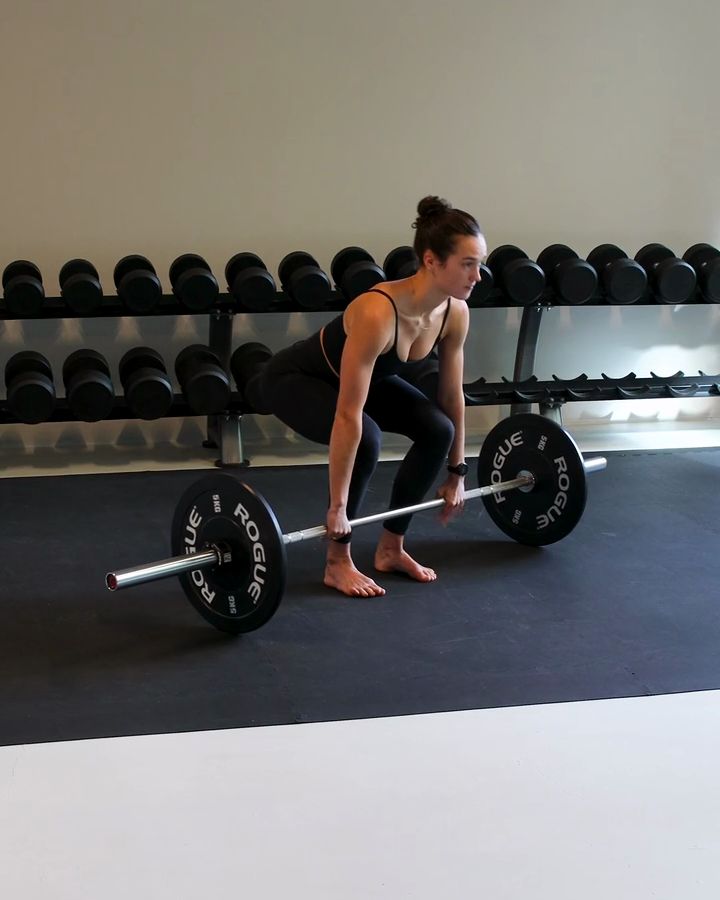
Conventional Deadlift with a barbell
The conventional deadlift, also known as the classic deadlift, is a fundamental exercise that strengthens the back, glutes, and legs. When performed with proper technique, it offers significant benefits but requires precise execution to avoid back injuries. Especially advanced athletes can lift heavy weights with this exercise. Variants such as the dumbbell deadlift or using a Smith machine are suitable for beginners.
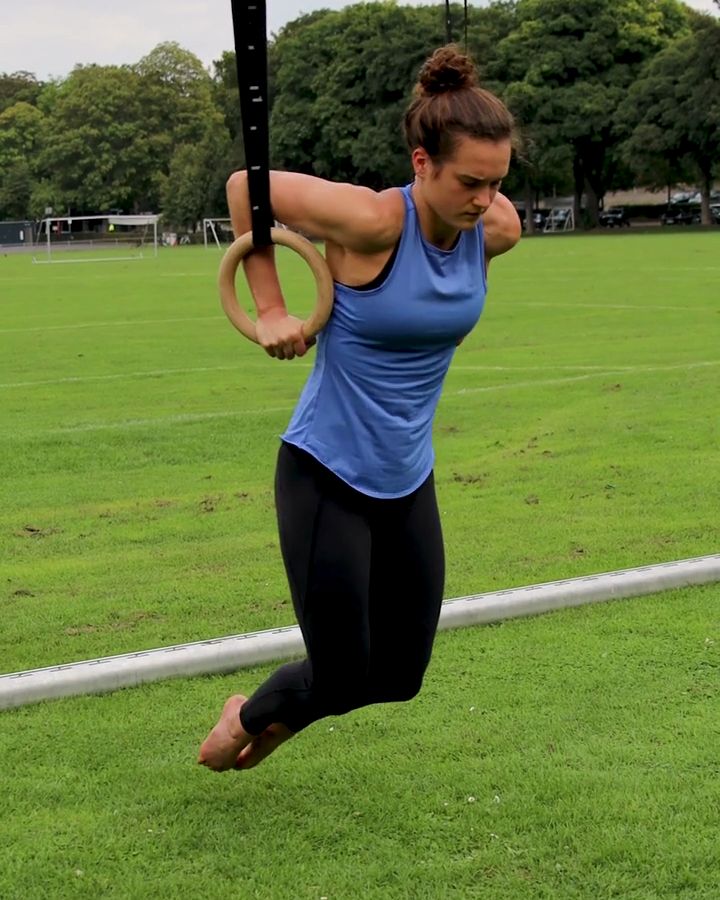
Ring Dips
Ring Dips are a challenging variation of classic Dips on parallel bars, requiring a great deal of stability and strength. They engage more muscle groups and promote strength and symmetry in the chest, triceps, and shoulders. Dips on the rings prepare you for even more demanding exercises, such as the Ring Muscle Up.
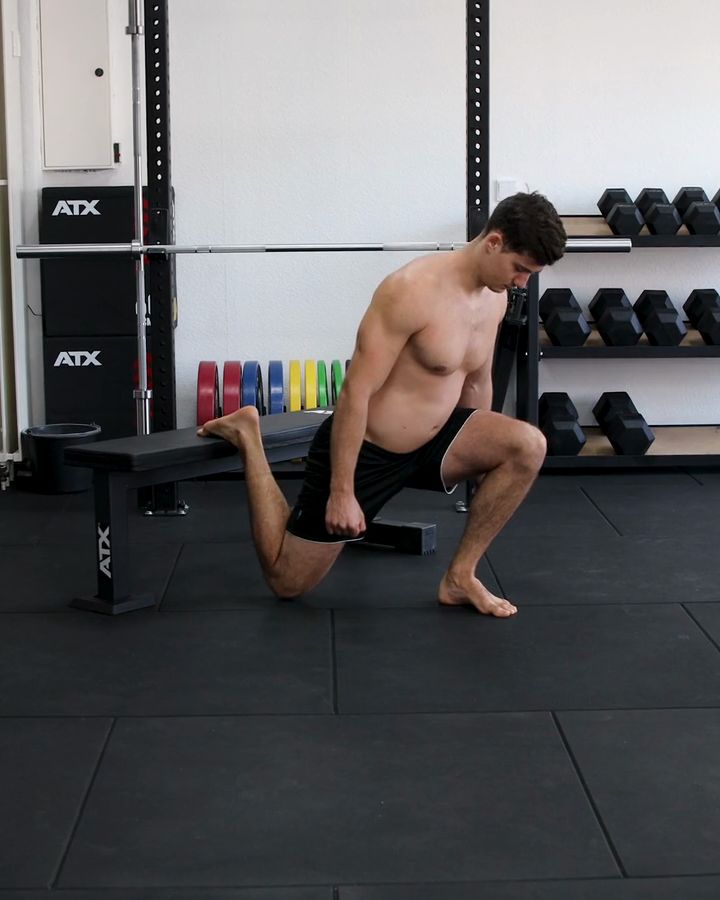
Bulgarian Split Squats
The Bulgarian Split Squat helps to balance the strength differences between your legs, as each leg is trained individually. Due to the large range of motion, the exercise improves your mobility in the hips, ankles, and knees. It is particularly popular because, unlike Barbell Squats, it does not put a heavy load on the lower back.
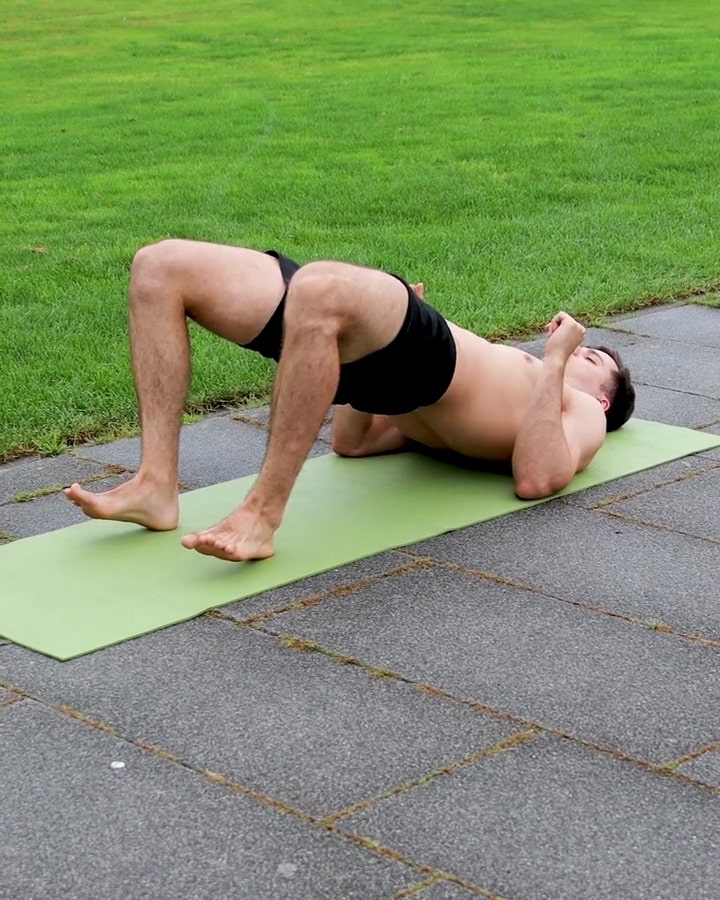
Hip Thrusts
This exercise is primarily dedicated to building your glute muscles and is particularly suitable for beginners. It primarily engages the hip and knee joints. If the exercise with just your body weight is too easy, you can use additional weight or perform the Single-Leg Hip Thrusts.
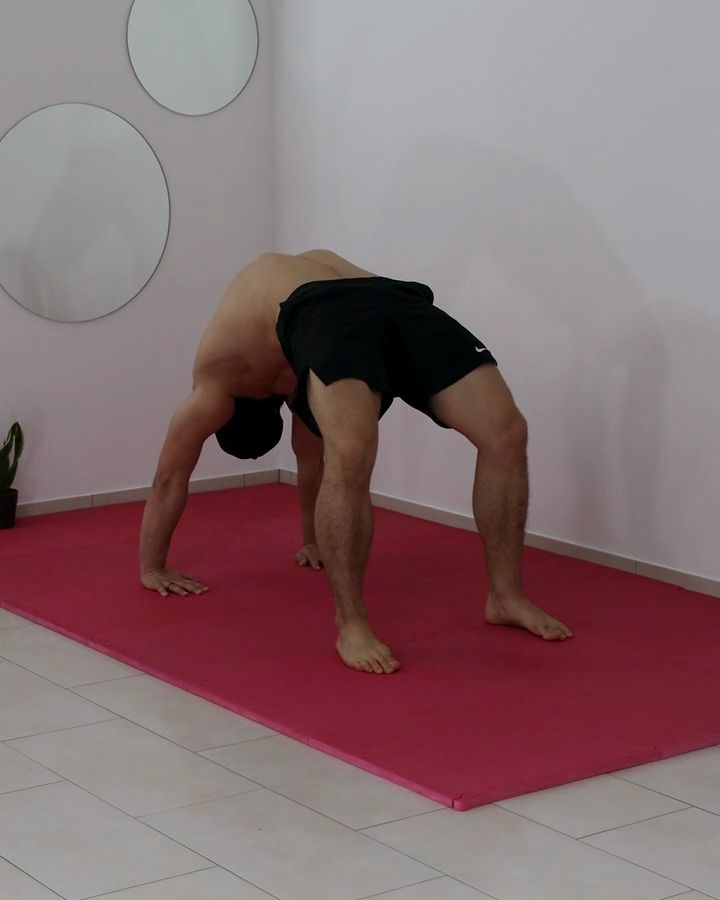
Bridge Hold
The bridge, also known as the wheel pose in yoga, is an intense backbend that stretches the front of the body and requires upper body strength. It is an excellent way to enhance the flexibility of your hips and spine. Although it is often considered a beginner exercise, it is complex and requires targeted training to avoid injuries.
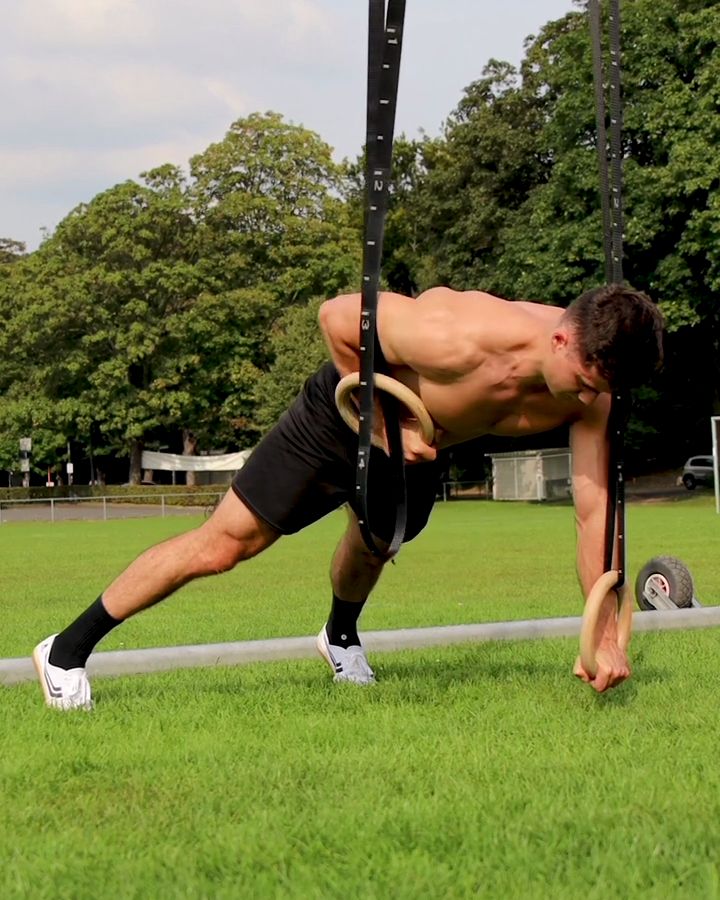
Renegade Rows with gym rings
Renegade Rows on the gymnastics rings strengthen your core muscles because the body tends to rotate. However, we prevent this rotation by tightening the core. The exercise is essentially an anti-rotation exercise that trains the muscles in the core responsible for rotating the torso. This exercise is great for sports that involve a lot of rotations and powerful impacts, like tennis, handball, javelin throwing, and more.
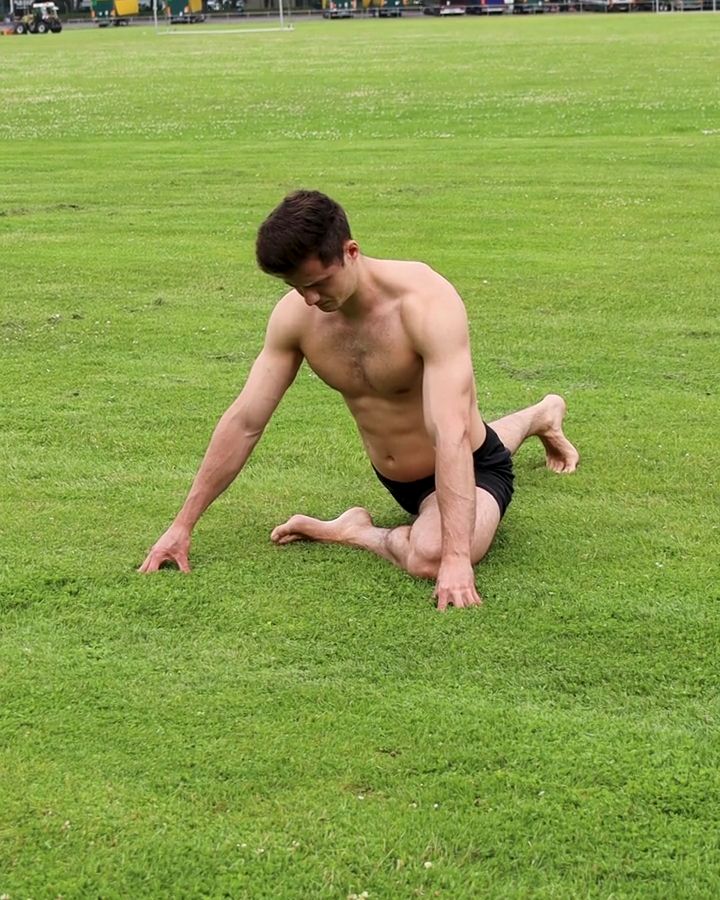
Pigeon Pose
The Yoga Pigeon Pose (Eka Pada Rajakapotasana), also known as Pigeon Pose or Pigeon Stretch, is a hip-opening exercise that primarily targets the glutes, hip flexors, and lower back. It promotes flexibility and relaxation but can also be performed in advanced variations with deeper backbends or leg stretches. A key aspect of this pose is maintaining proper hip alignment to maximize its effects on the muscles and prevent injuries. This asana is excellent for mobilization and stretching, though mindfulness is essential, especially regarding the knees and lower back. When performed with the correct technique, the Yoga Pigeon Pose can release tension, improve posture, and deepen your yoga practice. For a more active and intensive variation of the static pose, you can try Pigeon Good Mornings, which add a dynamic movement to further strengthen the muscles.
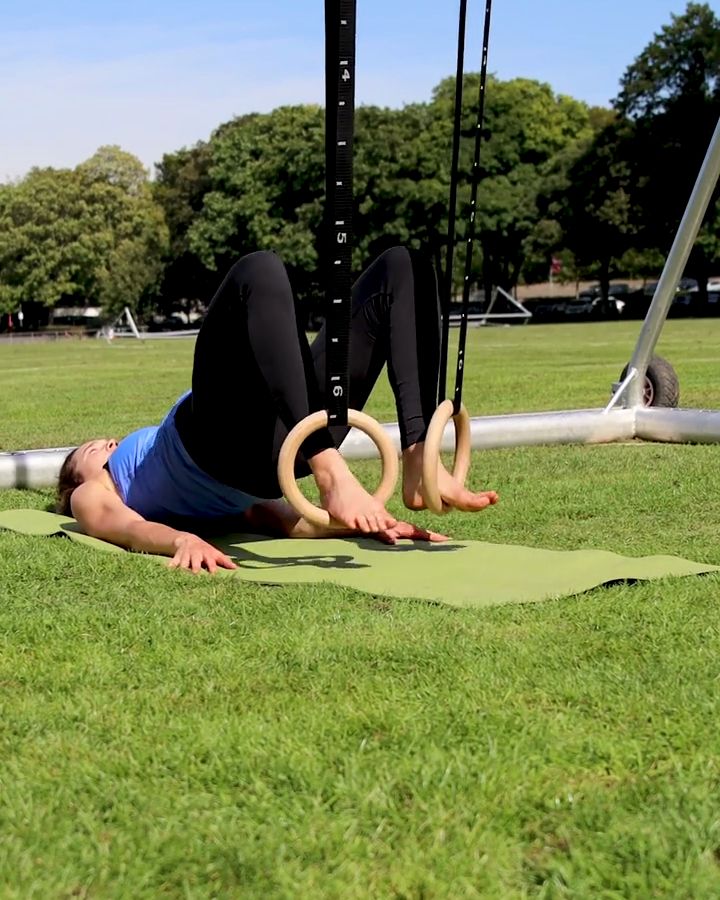
Leg Curls with gym rings
Leg curls on gymnastics rings, also known as "Hamstring Curls" or "Ring Leg Curls," are an effective calisthenics exercise for strengthening the hamstrings. This exercise not only targets the hamstrings but also improves stability and overall body tension. Using the rings makes the exercise particularly intense, challenging the muscles in a completely new way. It’s perfect for those looking to train their leg muscles functionally and without machines.
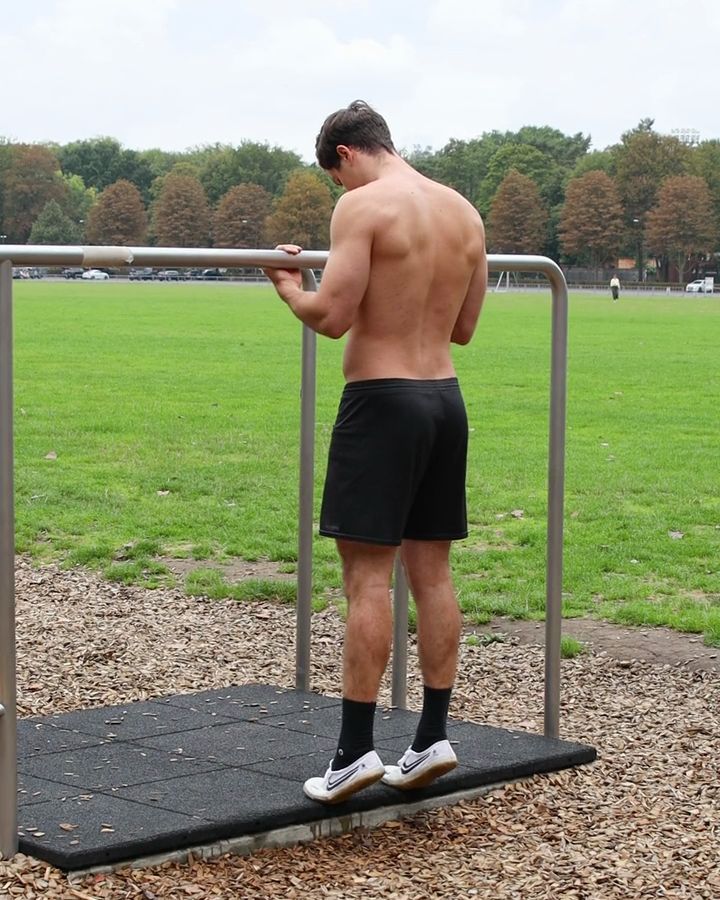
Calf Raises
Standing calf raises are a fundamental exercise for strengthening the calf muscles. This exercise can be performed using just your body weight or additional weights, making it suitable for beginners and advanced individuals.
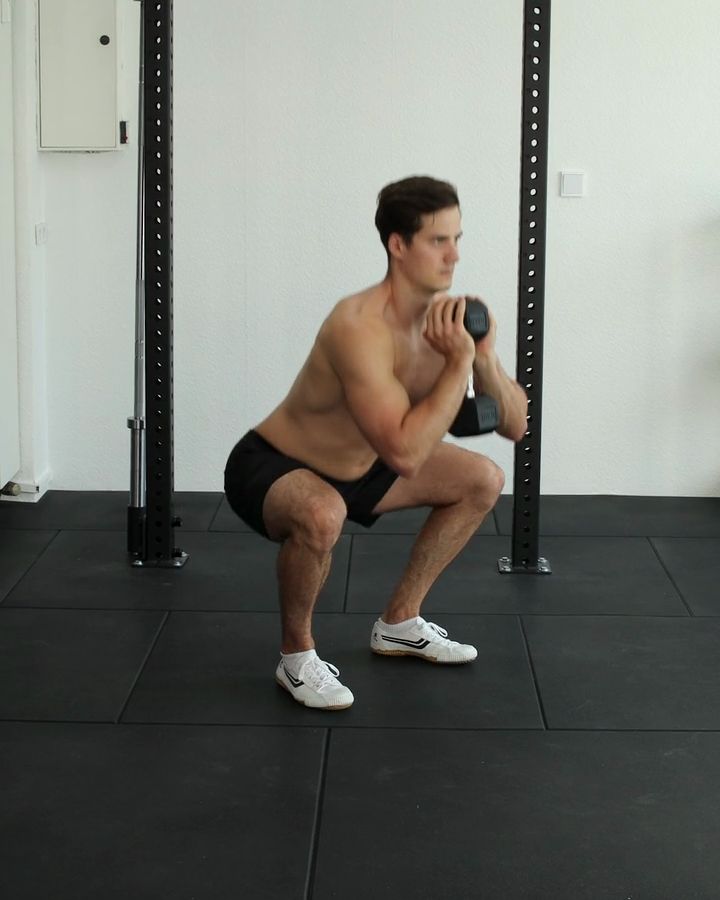
Goblet Squat with a dumbbell
The goblet squat is an effective exercise for strengthening the leg and glute muscles, where a dumbbell or kettlebell is held in front of the chest. Compared to the classic weighted squat, the goblet variation offers better balance and makes it easier to maintain an upright posture, which is especially beneficial for beginners. Additionally, the position of the weight in front of the body engages the core muscles more intensely, making the exercise ideal for training core stability.
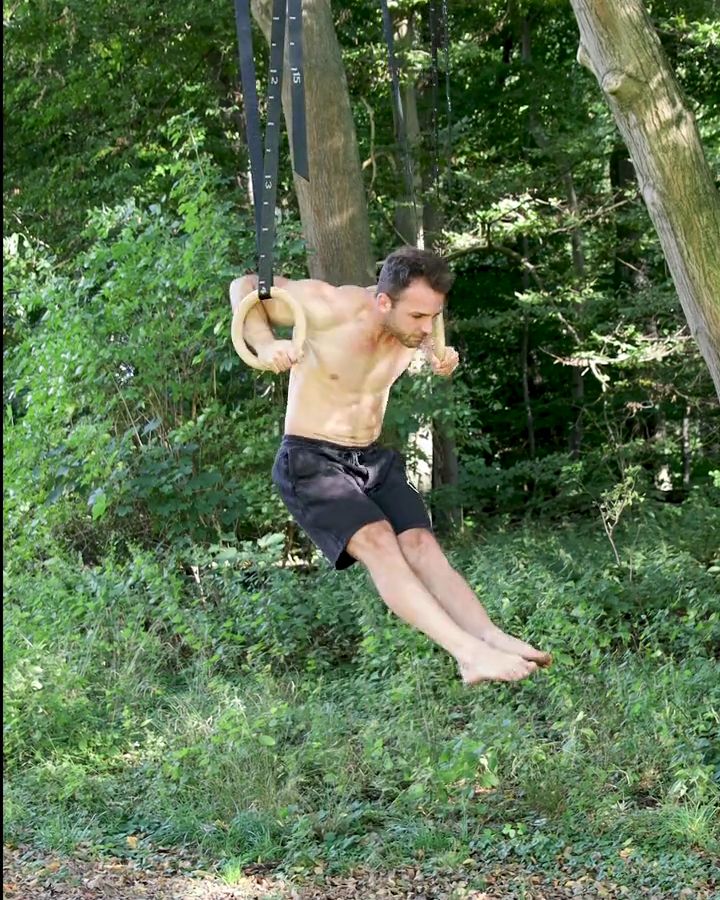
Ring Muscle Up
Ring Muscle-Ups are one of the most challenging exercises in Calisthenics and offer a special challenge that goes far beyond the classic Pull-Ups. This complex movement not only requires tremendous strength in the latissimus dorsi, biceps, and trapezius but also perfect coordination and body control. Due to the instability of the gymnastic rings, the entire stabilizing musculature is also intensely activated. The Ring Muscle-Up is a combination exercise consisting of a Pull-Up on the rings, the Transition, and a Ring Dip. An ideal preparatory exercise to learn the Transition is False Grip Rowing with transition. This exercise helps you learn the False Grip, the necessary grip to transition from a hanging position to the support hold.
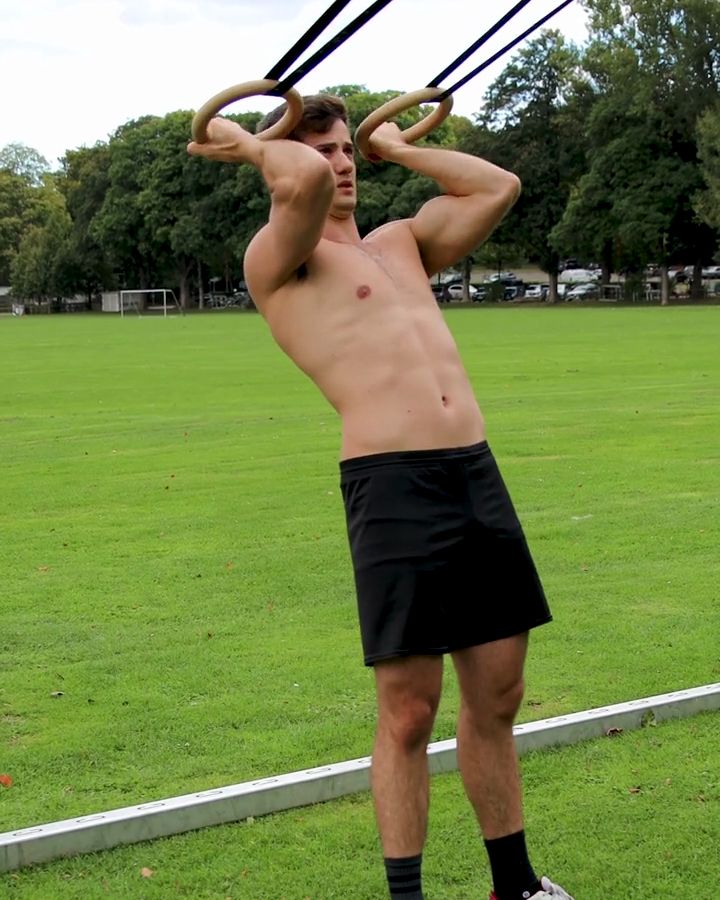
Biceps Curls with gym rings
Bicep curls on the gymnastics rings are an effective exercise to train the biceps specifically. The difficulty level depends on the body angle: the more upright you stand, the easier the exercise, as less body weight needs to be moved. In calisthenics, there are only a few exercises that isolate the biceps. Another popular variation is the Pelican Curls.
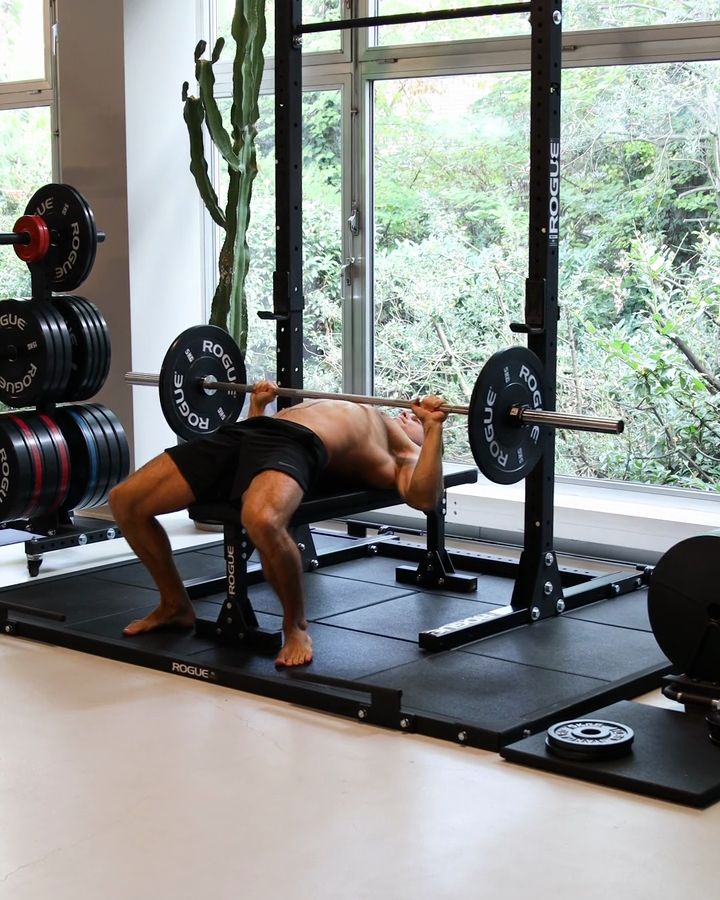
Barbell Bench Press
The Bench Press, also known as the Barbell Bench Press or Chest Press, is an essential fundamental exercise for targeted chest muscle development. This exercise can be performed with various equipment, such as barbells, dumbbells, or on the Smith machine. While the Dumbbell Bench Press offers greater freedom of movement, significantly more weight can be lifted during the flat Bench Press with barbells.
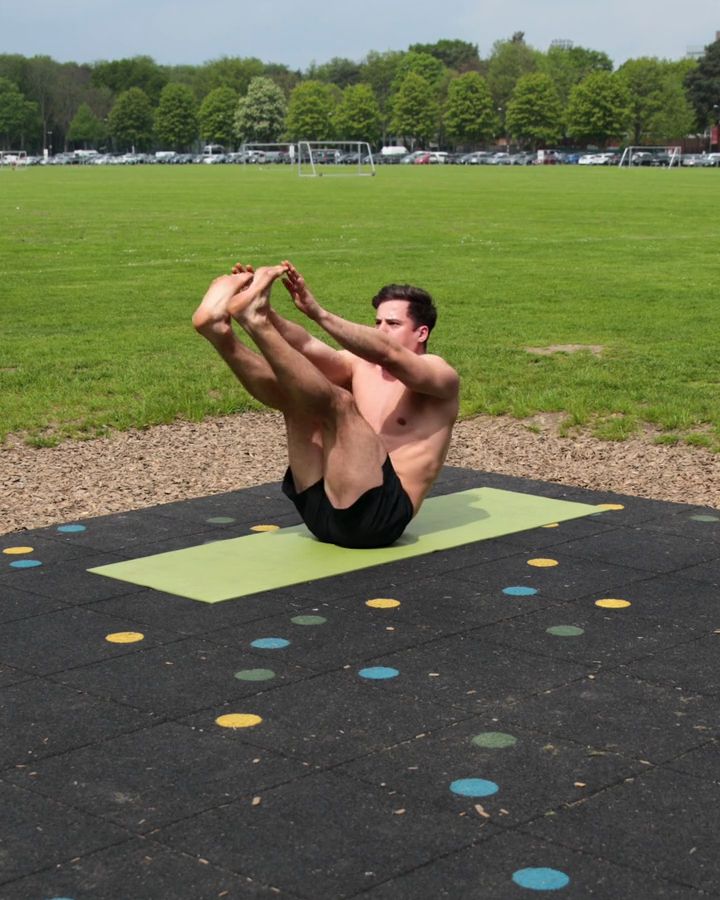
Jackknifes
The Jackknifes, also known as V-Ups, V-Sit-Ups, or Jackknife Sit-Ups, is a popular exercise for strengthening the abdominal muscles. This versatile exercise is widely used in the fitness community and offers various modifications that can be tailored to individual training needs. The main focus of the jackknife is on the rectus abdominis muscle, while the oblique abdominal muscles also provide supportive work.

Butterfly Reverse with dumbbells
The Butterfly Reverse exercise specifically strengthens your upper back and shoulders. It is easy to perform, ideal for muscle building, and serves as preparation for more complex exercises.
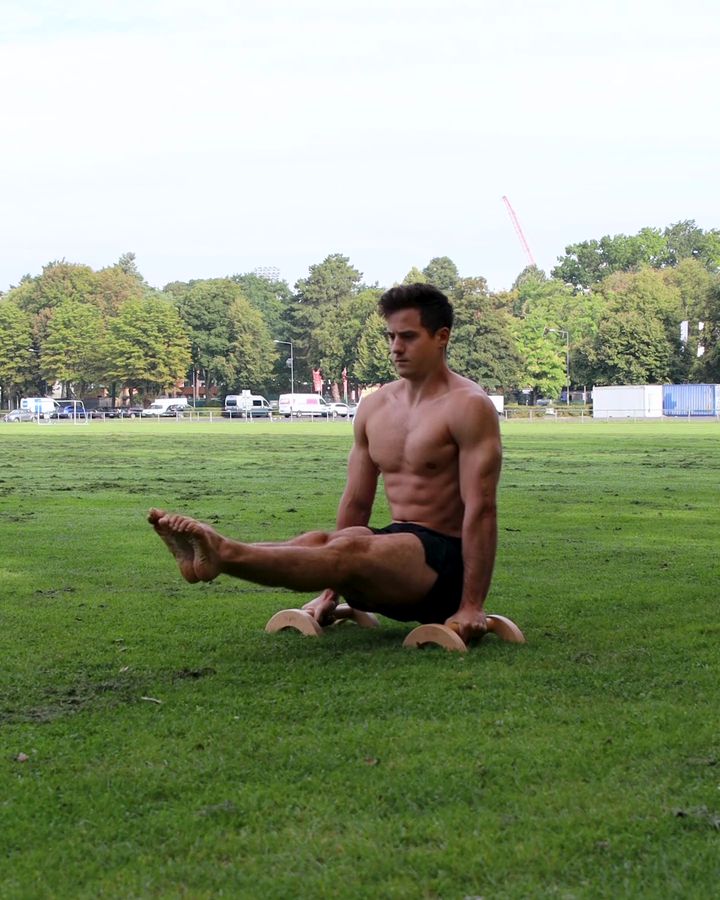
L-Sit
The L-sit is a well-known exercise from gymnastics that is also very popular in calisthenics. It requires strong abdominal muscles, some flexibility in the back of the legs, strength in the hip flexors, and stability in the shoulder girdle. Depending on the training equipment used for the L-sit, the exercise can be easier or more difficult.
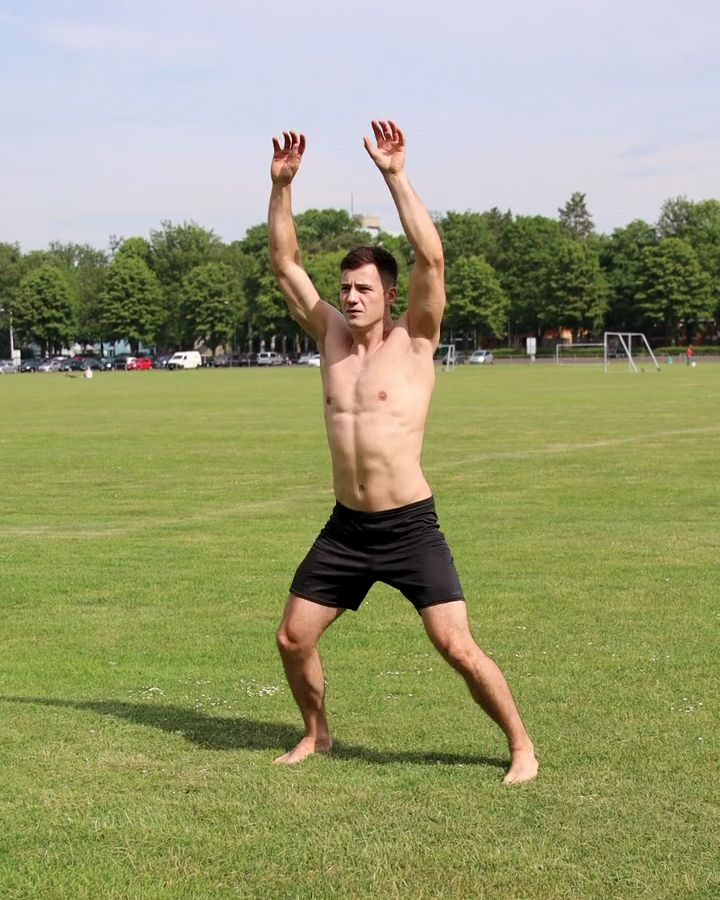
Jumping Jacks
Jumping jacks are a classic cardio exercise that activates the entire body and quickly elevates the heart rate. This simple yet effective exercise involves jumping from a standing position with legs spread apart while bringing the arms together overhead, then returning to the starting position. Jumping jacks enhance cardiovascular fitness, improve coordination, and can be performed virtually anywhere without any equipment.
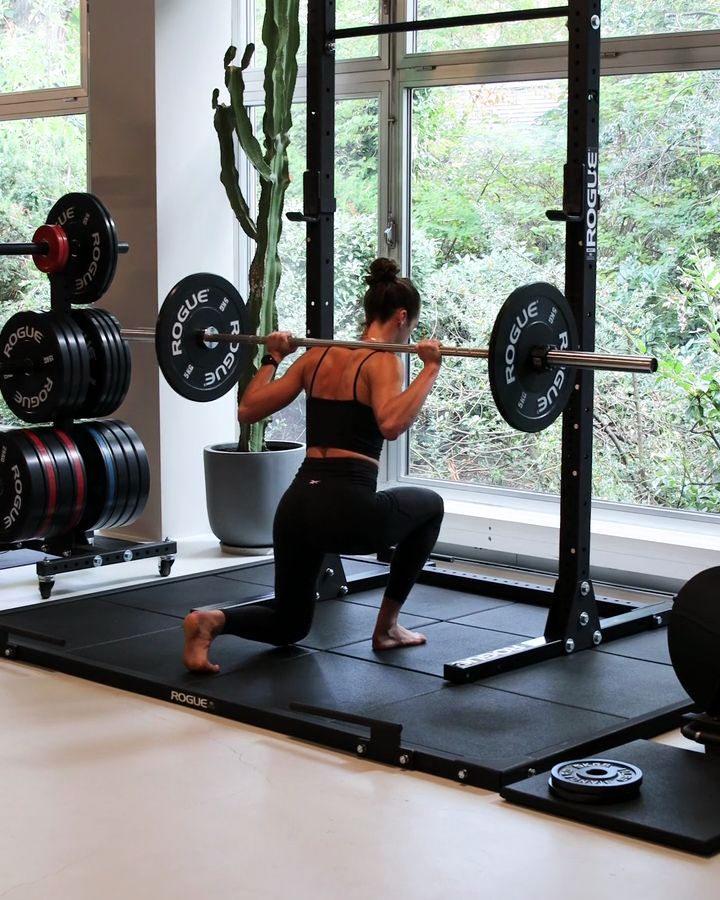
Lunges
Barbell lunges, also known as barbell lunges, are an effective lower body exercise that provides an ideal way to improve strength and stability. This exercise is suitable for both beginners and advanced practitioners. If you're looking for an exercise that also enhances explosiveness and coordination, jumping lunges are a great alternative.

Compressions
This exercise aims to improve the mobility of your hips. As a beginner, you will particularly benefit from it, as it helps you build the foundation for advanced exercises like the L-Sit.
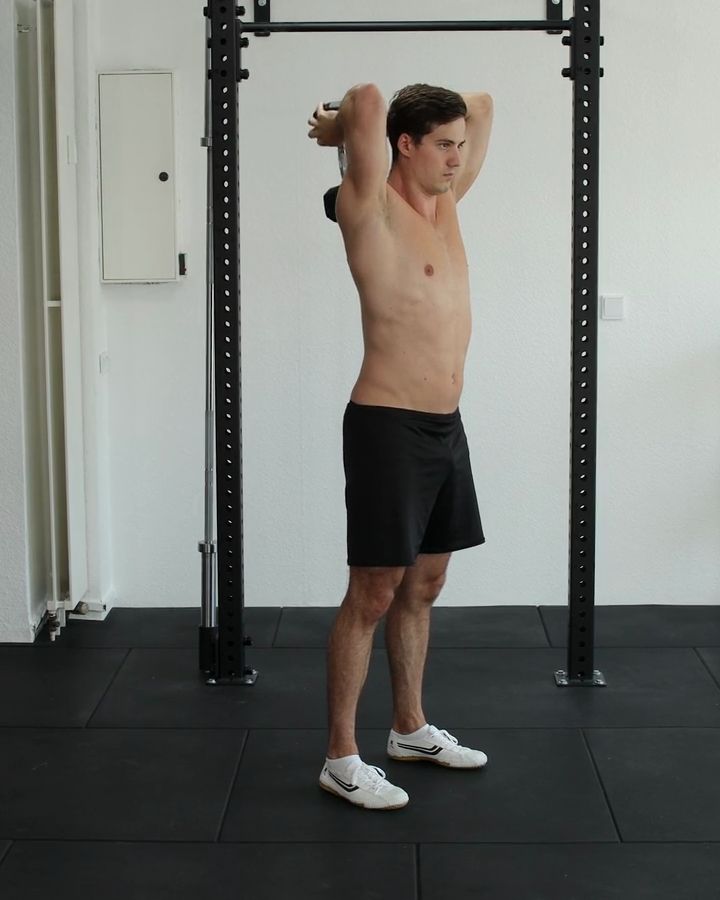
Triceps Extensions with a dumbbell
Tricep extensions with a dumbbell, also known as "Dumbbell Tricep Extensions" or "Overhead Tricep Extensions," are an effective exercise for targeting the triceps. This exercise isolates the tricep muscle and allows for precise control of the movement. Using a dumbbell makes the exercise versatile and can be adjusted to suit individual fitness levels. It's ideal for those looking to specifically build their arm muscles. Common alternative exercises to dumbbell tricep extensions include dips and close-grip push-ups.
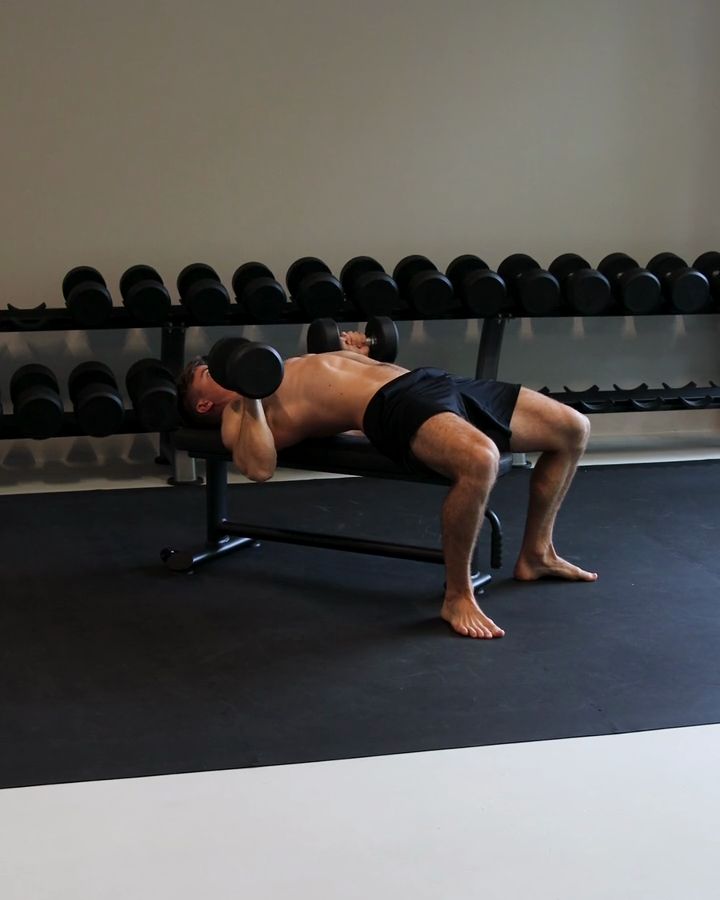
Bench Press with dumbbells
The bench press, is an essential exercise for the development of the chest muscles. Compared to using a barbell or the multipress, bench pressing with a dumbbell allows for greater freedom of movement, which places more strain on the stabilizing muscles. As an alternative to a bench, the exercise can also be performed on the floor. This variant is known as the floor press. However, the range of motion is limited in the floor press. Those with healthy shoulders should therefore prefer bench pressing on the bench.
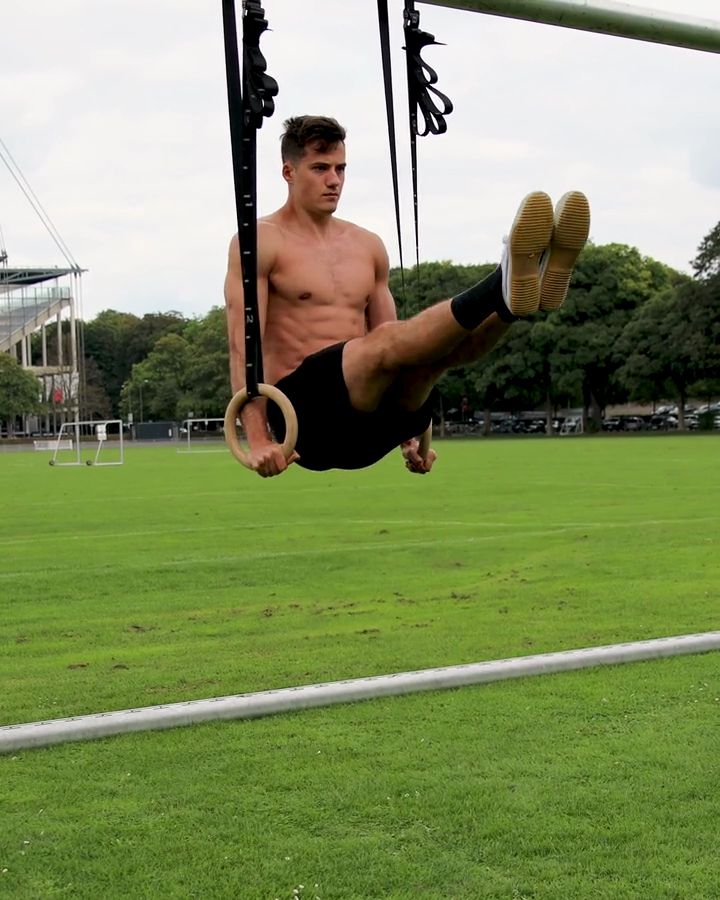
Leg Raises on the rings
Leg raises on gymnastics rings are an excellent exercise for strengthening the abdominal muscles and hip flexors. The instability of the rings also engages the shoulders and deep core muscles, making the exercise particularly challenging. This exercise is ideal as preparation for the L-Sit.
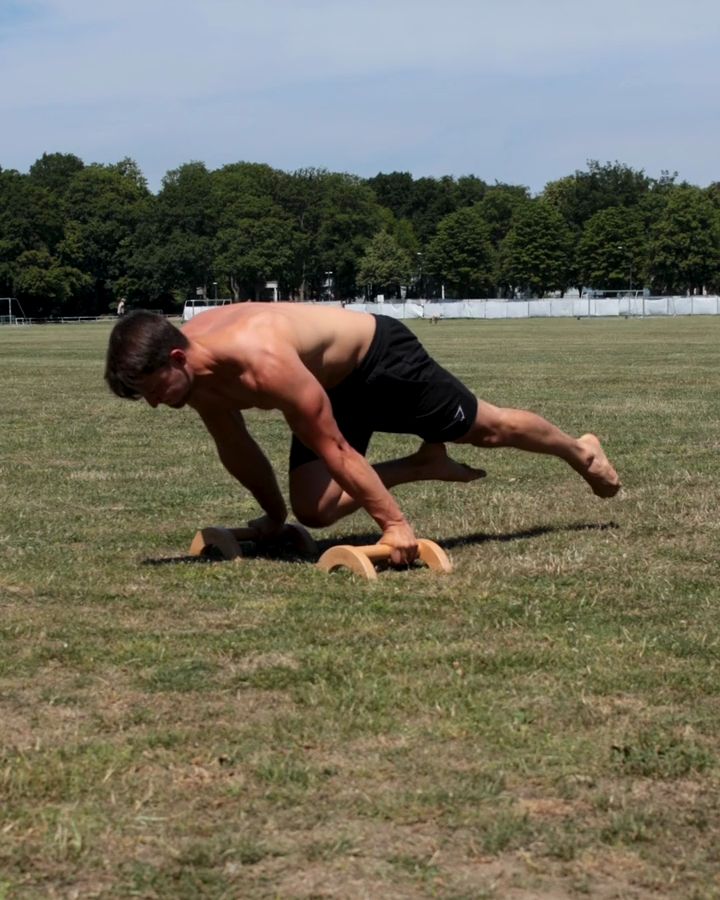
One Leg Planche with Paralletes
The One Leg Planche is an advanced calisthenics skill in which the body hovers parallel to the ground, with only one leg extended. It requires tremendous strength in the shoulders, core, and arms. The One Leg Planche is a preparatory exercise for the Straddle Planche.
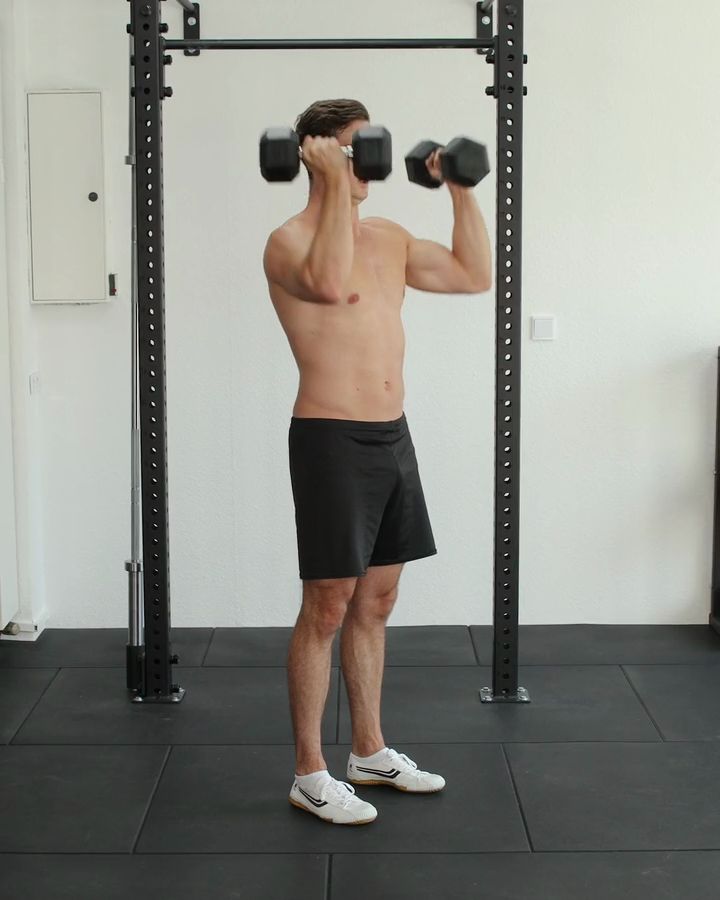
Arnold Press with dumbbells
The Arnold Press, also known as the Rotational Shoulder Press or Schwarzenegger Press, is a fitness exercise developed by Arnold Schwarzenegger, specifically designed for targeted shoulder muscle development. This exercise can be performed either standing or seated and is excellent with dumbbells or kettlebells. Learn more about the correct execution of the exercise in the following article.
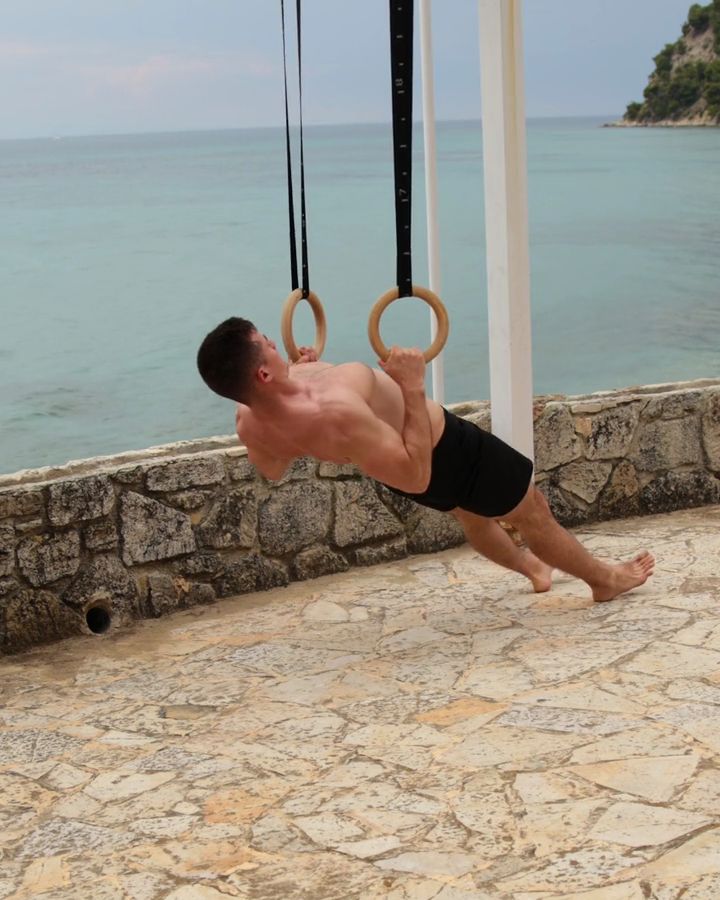
Ring Rows
Rowing on gymnastics rings is an effective calisthenics exercise that strengthens the back, rear shoulders, and arms. Using your body weight as resistance, you pull yourself up on the rings, which also enhances your core stability. Compared to dumbbell rows or barbell rows, where the movement is more isolated, rowing on the rings requires more overall body tension. This exercise is ideal for building functional strength and specifically targeting the core muscles. It fits perfectly into a classic calisthenics routine and prepares you for more intense exercises, such as ring pull-ups} or {ring muscle-ups, row to the stomach, and row to the forehead are possible, allowing for more focused training of different regions of the back.
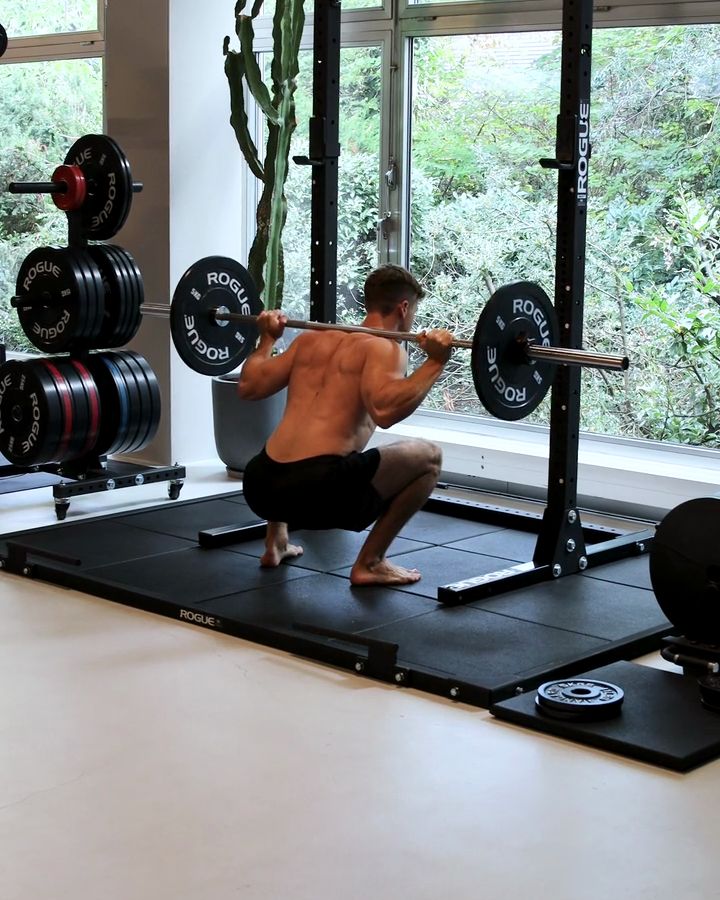
Barbell Back Squats
Back squats are one of the fundamental exercises in strength training. They are typically performed with a barbell, allowing for progressive overload. Back squats primarily target the thigh muscles, particularly the quadriceps and glutes. Additionally, they strengthen the core and lower back, as these muscles are crucial for stability and control during the exercise. Back squats are among the most well-known foundational exercises in strength training, as they promote overall body strength and stability, improve functional movements in daily life, and, when combined with other strength exercises like deadlifts or lunges, provide an excellent foundation for leg training.
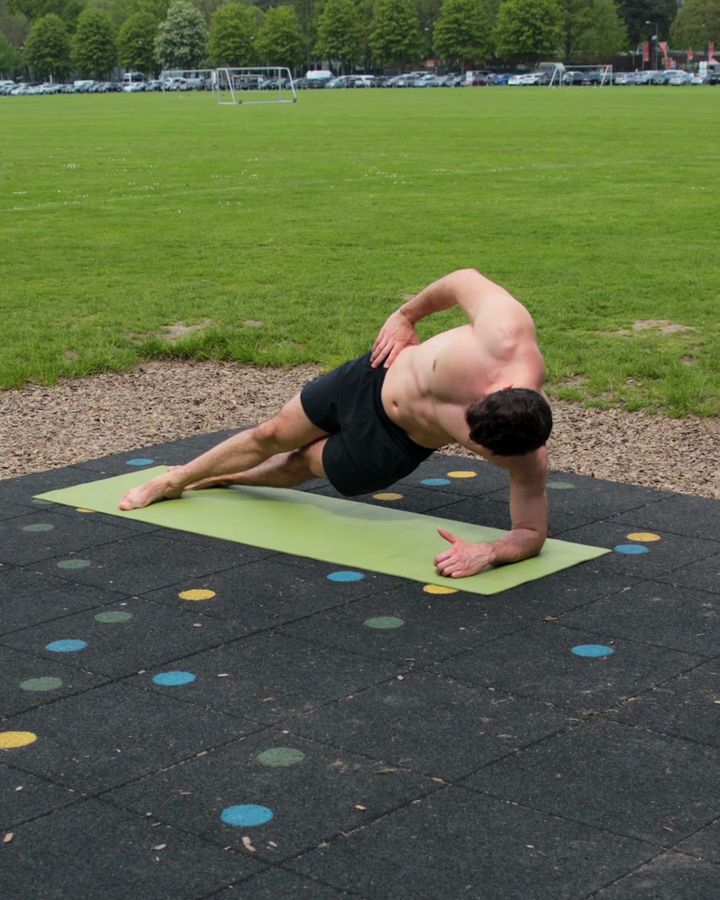
Side Plank
The side plank on the elbow is an effective exercise for strengthening the lateral abdominal muscles and stabilizing core muscles. This exercise not only promotes core stability but also improves posture and balance.
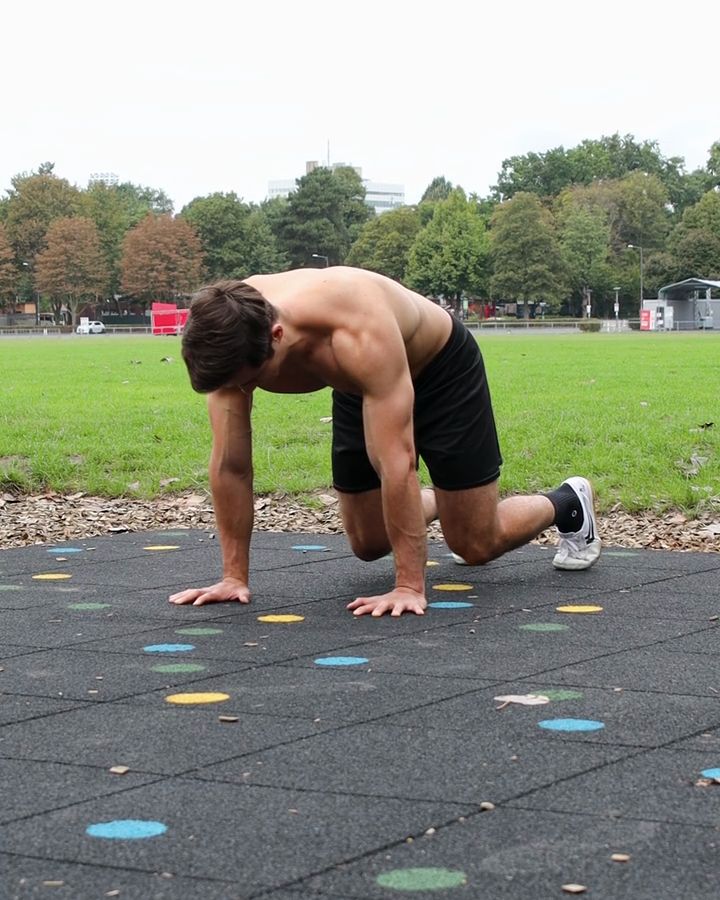
Quadruped Stand, All Fours Position
The Quadruped Stand, also called the All Fours Position, strengthens your shoulder and belly muscles. It’s a great beginner exercise and an easy way to start bodyweight training. When done correctly, the Quadruped Stand is just as good for your core as the Plank. It helps you stay stable, improves your posture, and you can make it harder by lifting one arm or one leg.
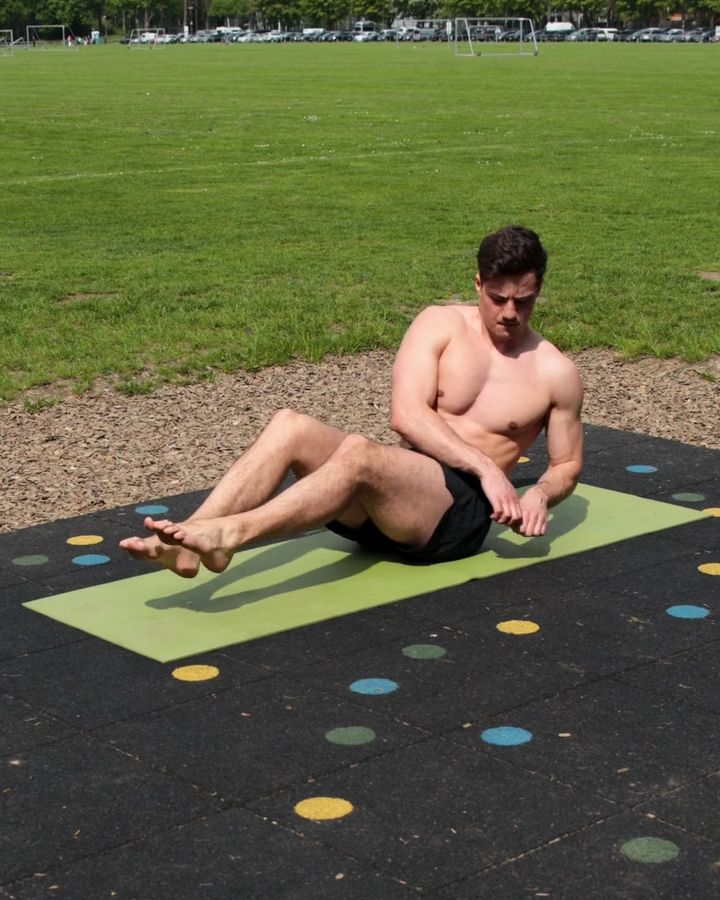
Russian Twists
The Russian Twist is an effective exercise for the lateral and straight abdominal muscles. You sit on the floor, lean your upper body back slightly, and rotate your torso alternately to the right and left. Alternatively, you can hold a weight or dumbbell in front of you during the exercise. Make sure to perform the movement in a controlled manner with your abdomen tensed to achieve the best results and avoid injuries.
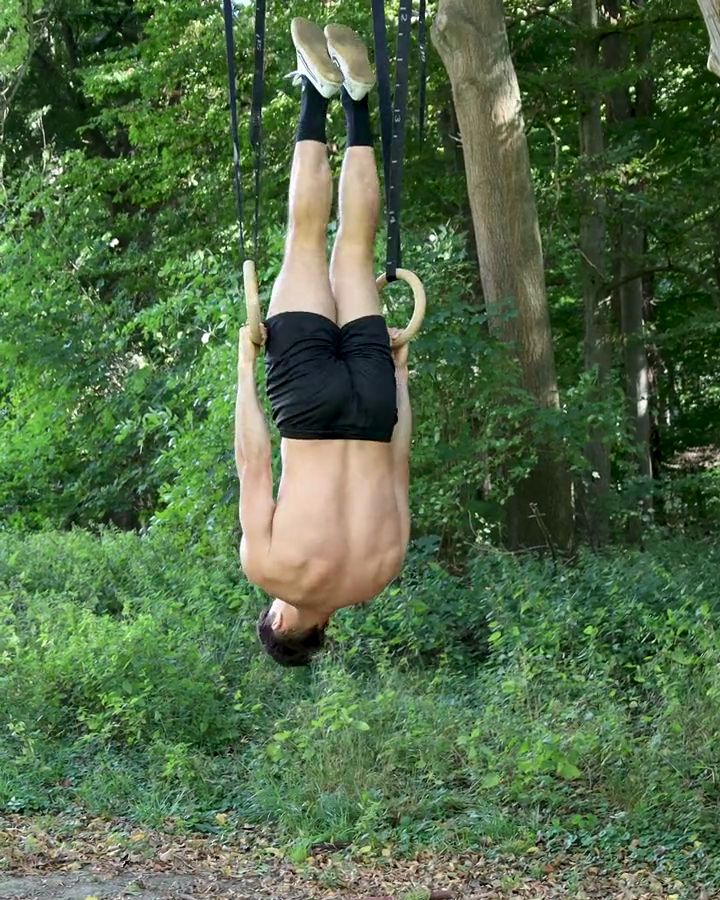
Inverted Hang with gym rings
The inverted hang lift is an effective exercise for strengthening the latissimus and abdominal muscles. This exercise is typically performed on gymnastic rings. When done on a pull-up bar, the inverted hang becomes slightly more challenging because you can't keep your legs completely vertical due to the bar. The lift is an excellent preparatory exercise for the Skin The Cat.
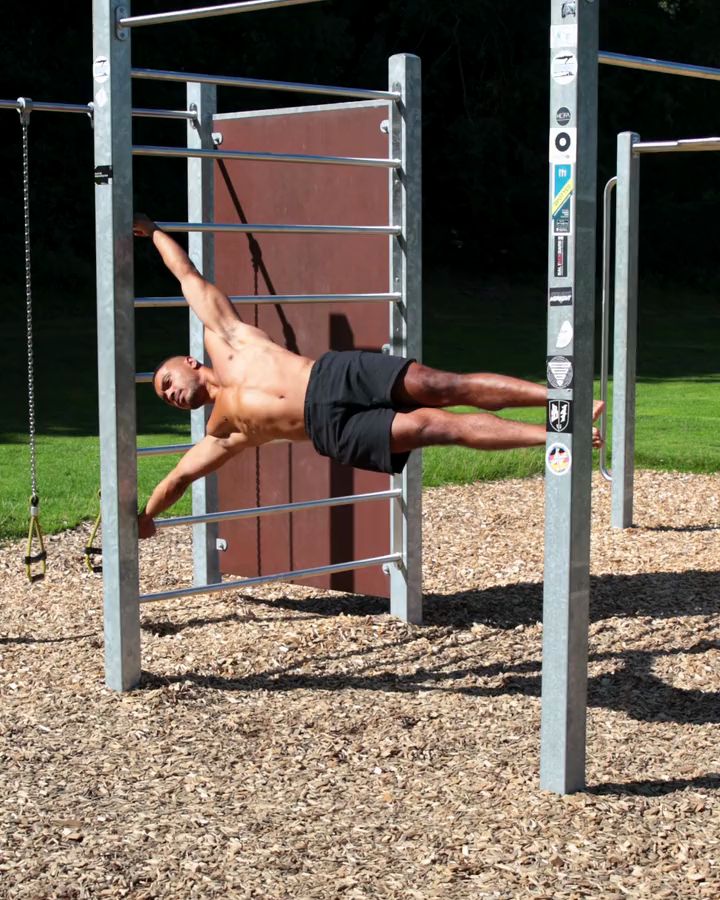
Human Flag
The Human Flag is a very challenging exercise from calisthenics, where you hold onto a pole sideways and stretch your body horizontally in the air. You need strong abdominal muscles, shoulders, and arms for this exercise. Your upper arm pulls the pole towards you while your lower arm pushes it away. Simultaneously, your abdominal and back muscles are tensed to keep your body stable. It requires a lot of strength and body control to perform this exercise against gravity.
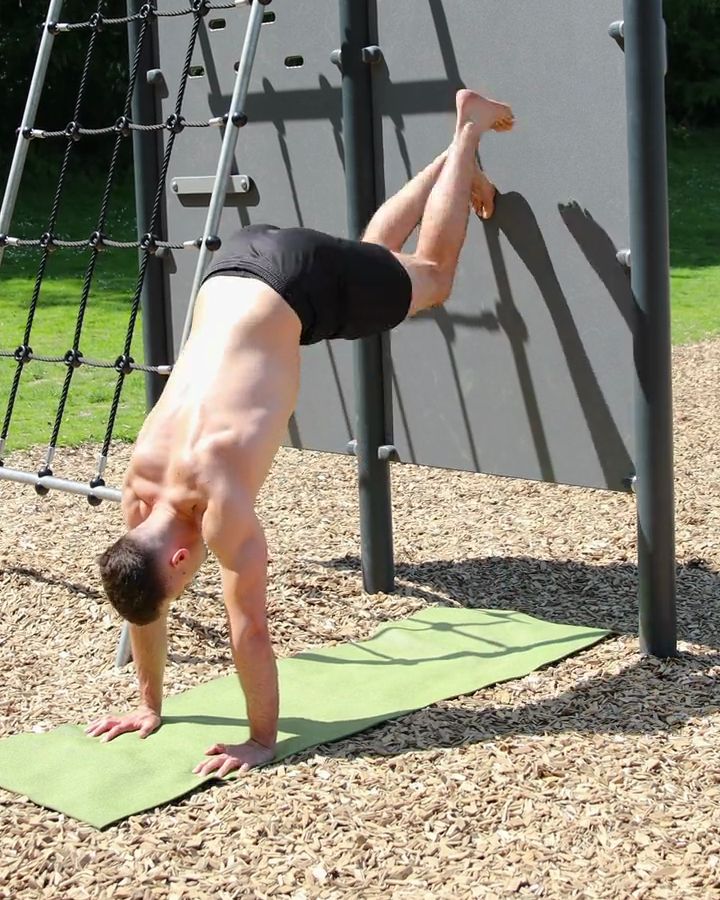
Wall Walks
Wall walks are an effective exercise for strengthening the shoulders while also intensely engaging the abdominal muscles. You begin in a plank position against the wall and walk your feet up the wall as your hands gradually move closer to it. This exercise also promotes body stability and coordination. Learning wall walks has the advantage of improving the vertical position, facilitating the transition to more advanced exercises like the handstand or the handstand swimmer.
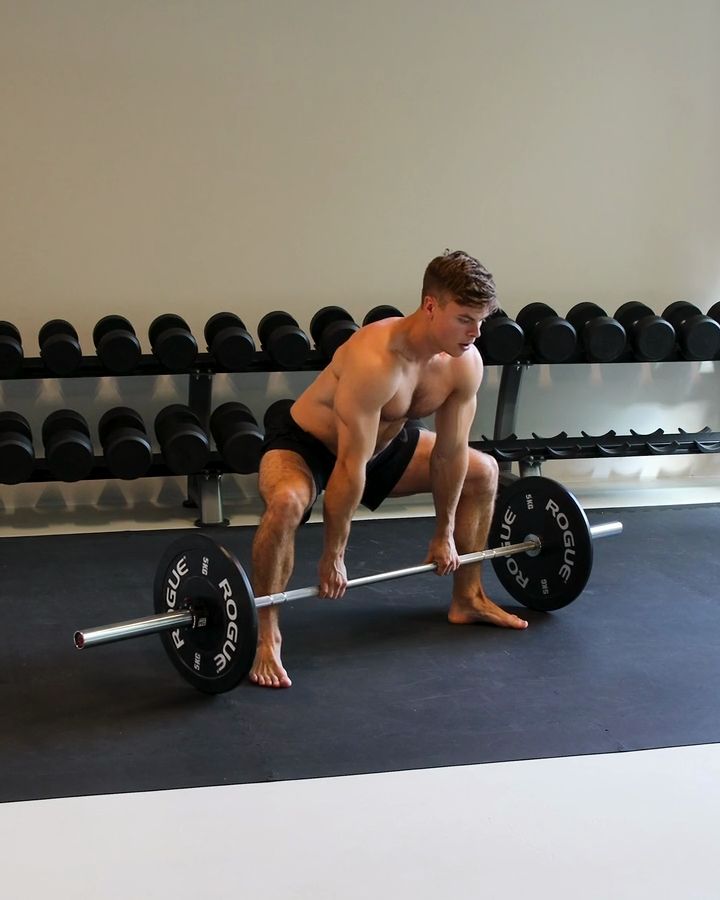
Sumo Deadlift with a barbell
The sumo deadlift is a variation of the classic deadlift, where the feet are positioned wide apart, with the toes pointing outward. This stance allows for a more upright torso position and places greater emphasis on the thighs and glutes, while slightly reducing the strain on the lower back. With the barbell version of the sumo deadlift, you can lift heavier weights compared to the dumbbell sumo deadlift.
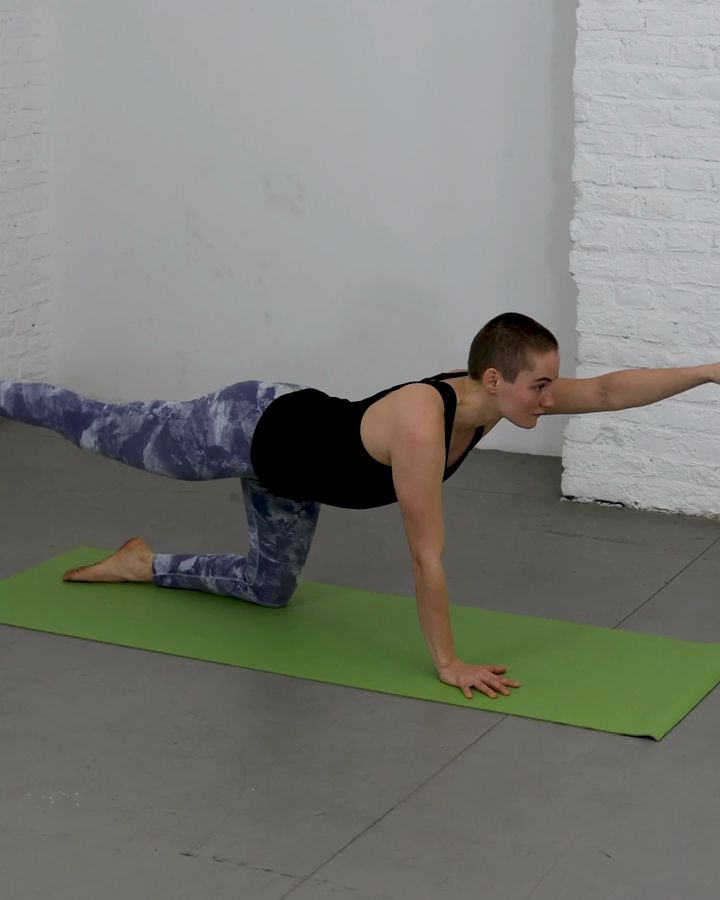
Bird Dog
The bird dog exercise is a bodyweight exercise that specifically trains core stability and coordination. In this exercise, the right arm and left leg, as well as the left arm and right leg, are alternately extended while keeping the core stable. This exercise improves balance and enhances control of the body's center, which is especially important for maintaining a healthy posture and preventing back pain. Since it can be performed without equipment, it's also ideal for home workouts. This exercise is particularly suitable for beginners, as it is relatively simple to perform yet still effective.
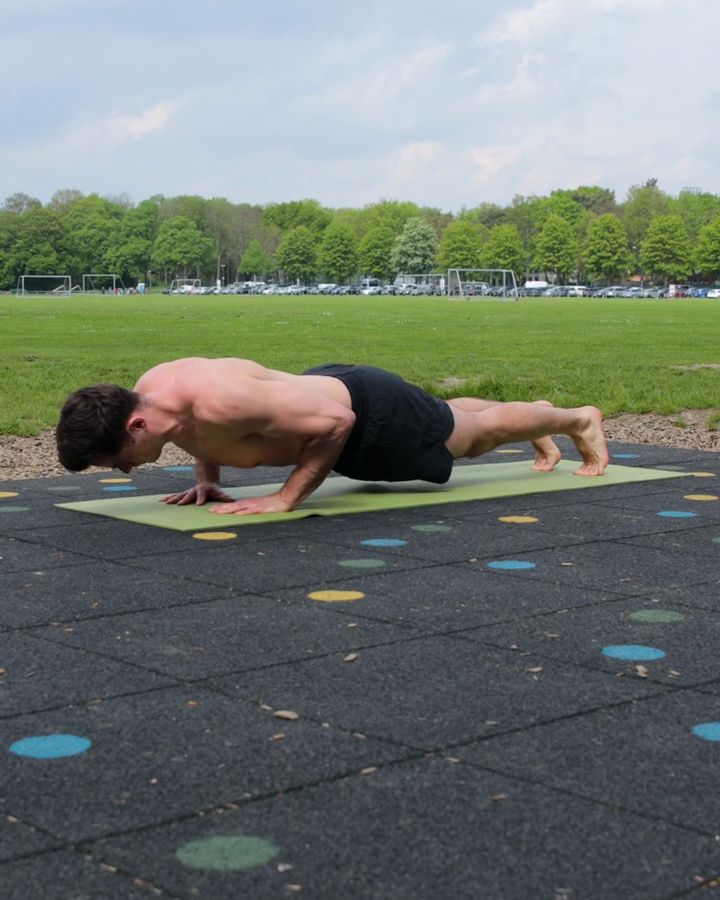
Diamond Push Ups
Diamond push-ups, also known as diamond push-ups, are an intense variation of classic push-ups. In this exercise, the hands are placed close together, with the thumbs and index fingers forming a diamond or triangle shape, which puts particular emphasis on the triceps.
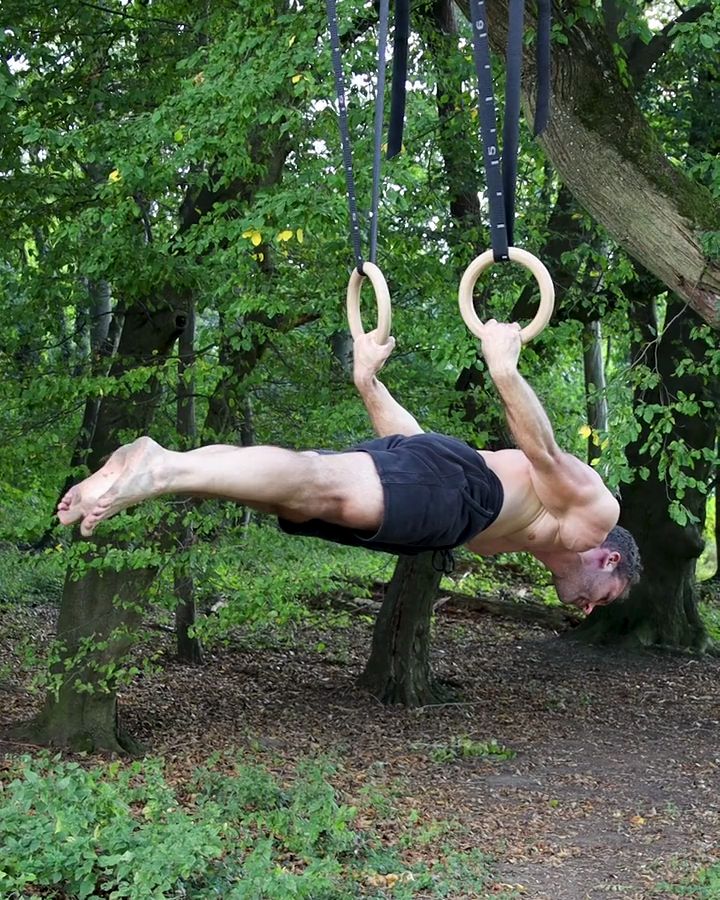
Back Lever with gym rings
The back lever is a calisthenics exercise where the body is held horizontally with the stomach facing the ground. It requires strong body tension and primarily trains the biceps, shoulder, and core muscles. The back lever particularly challenges stability and body control and demands both strength and flexibility in the arms and shoulders. This advanced exercise requires patience and consistent training. To prepare, various progressions are recommended: The tucked back lever is a basic exercise where the knees are pulled to the chest to strengthen the core muscles. The straddle back lever and the single-leg back lever are more advanced variations, where spreading or extending the legs increases the load. Exercises like back lever pulls help further develop the necessary strength and stability in the upper body. The front lever is often mentioned alongside the back lever, where the body is also held horizontally, but with the face facing upwards.
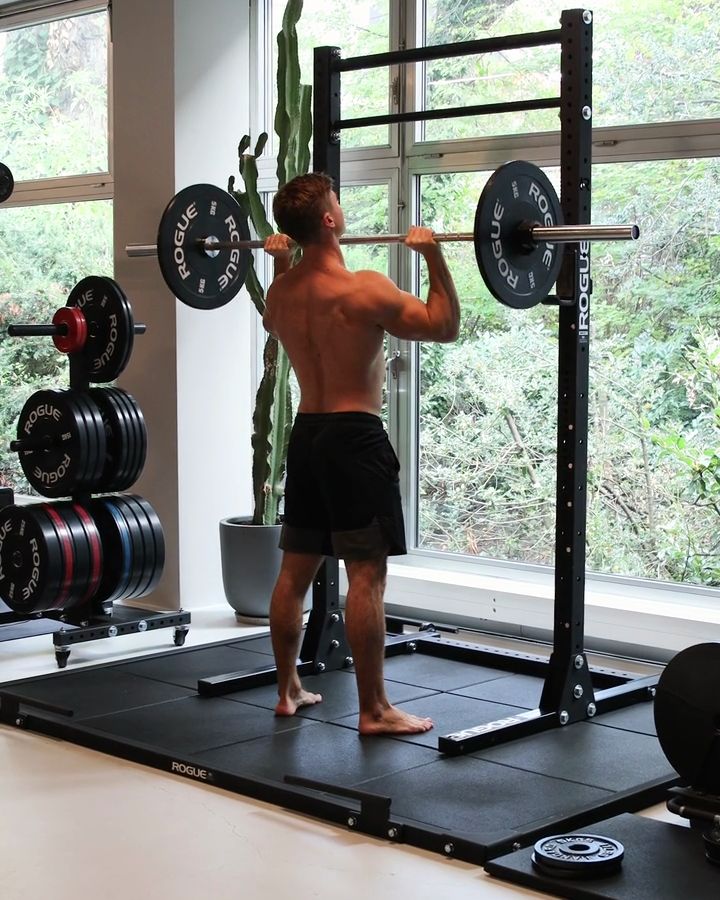
Shoulder Press with a barbell
Dumbbell shoulder press offers more freedom of movement and promotes stability, as each side of the body works independently. Compared to the barbell version, it requires more coordination but allows for a more customized range of motion.
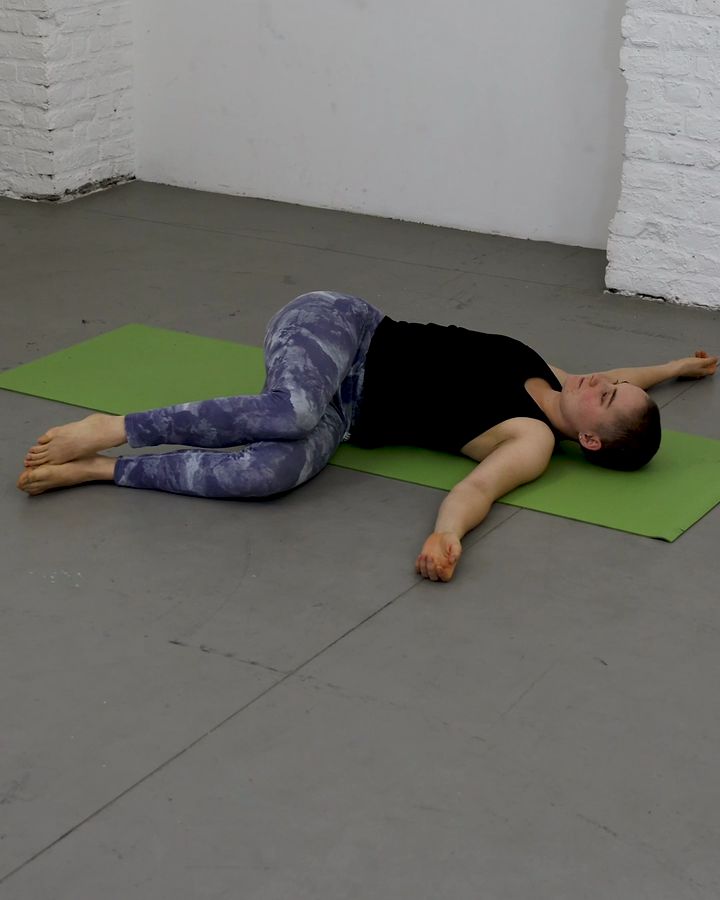
Spine Twist
The spine twist is an effective exercise for mobilizing the spine and stretching the lateral core muscles. Lying on your back, lift your legs to a 90-degree angle and slowly lower them to the side while keeping the upper body stable on the floor. This rotational movement enhances flexibility in the lower back and hips, making it excellent for relieving back pain, recovering after intense workouts, or as part of a mobility program. It improves spinal mobility and is a gentle alternative to more intensive core exercises.

Scapular Pull Ups
Scapular pull-ups strengthen the muscles around the shoulder blades and improve their control and activation. You hang from a pull-up bar and pull the shoulder blades down and together without bending the arms. This movement primarily activates the muscles of the upper back and shoulders and serves as an excellent preparatory exercise for pull-ups, as it helps maintain shoulder stability.
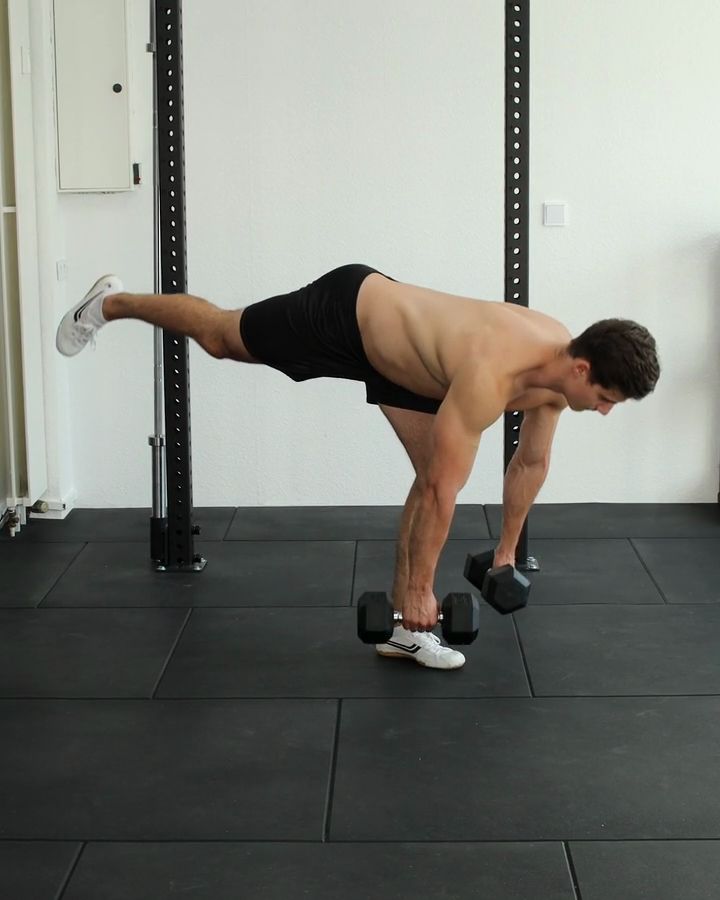
Single Leg Deadlifts with dumbbells
Single-leg deadlifts with dumbbells are an effective exercise for improving balance and stability. In this variation, the weight is carried on one leg, which particularly engages the posterior leg muscles and core. Compared to the classic deadlift, the single-leg deadlift with dumbbells demands more balance since all the weight is supported by one leg. It should not be confused with the sprinter deadlift, where the back leg lightly touches the ground during the movement instead of hovering freely in the air.
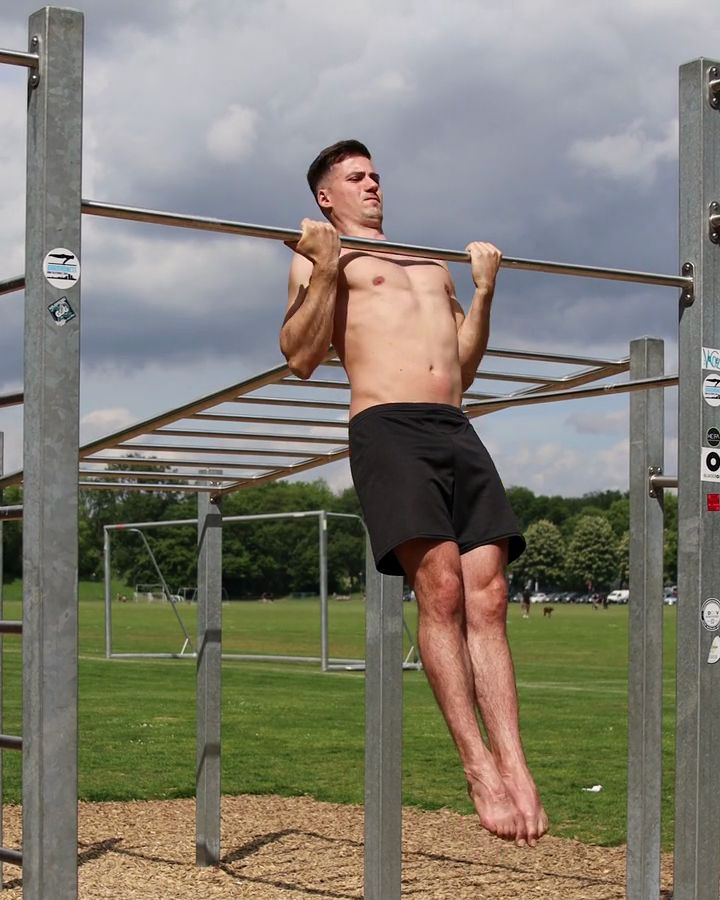
Chin Ups
Underhand pull-ups, also known as chin-ups or supinated pull-ups, are a variation of the classic pull-up where the palms face the exerciser. This grip position shifts the focus more towards the biceps and the lower parts of the back, adjusting the movement and engaging the muscles differently compared to the classic overhand pull-up. Chin-ups provide an effective alternative to the traditional pull-up, allowing for targeted upper body strength development.

Hamstring Curls with gym rings
Unlike traditional hamstring curls on a machine, hamstring curls on gymnastics rings are performed in a free-hanging position, which not only targets the hamstrings but also challenges the stability of the entire core. This exercise requires more balance and body control due to the instability of the rings and the need to move your body weight against gravity. As a result, not only the legs but also the glutes and lower back muscles are more intensely activated. Gymnastics ring hamstring curls are ideal for building functional strength and stability.
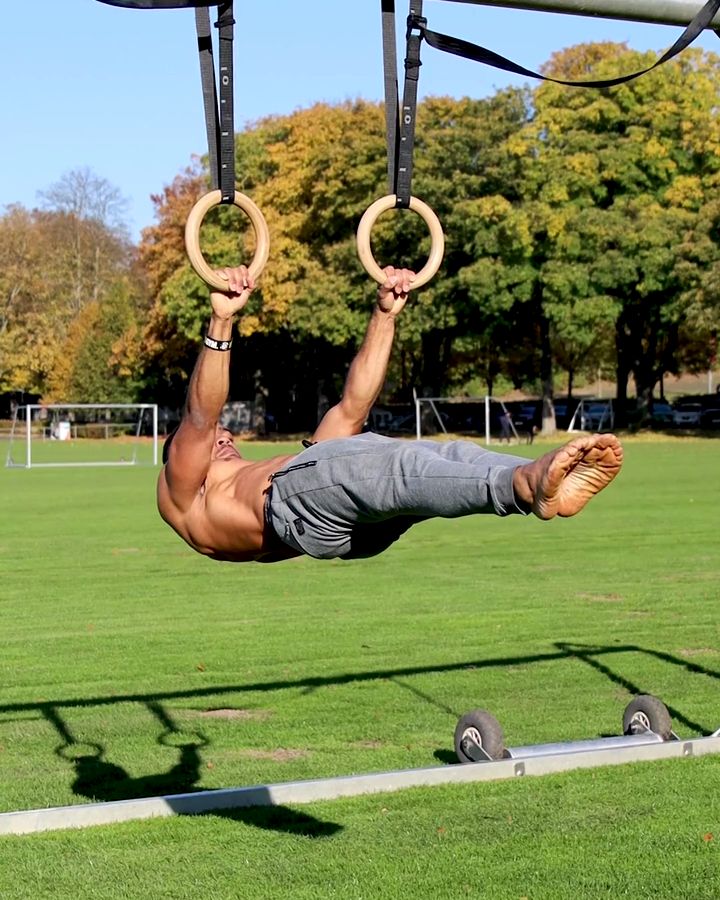
Front Lever with gym rings
This exercise, known as the "Front Lever" is a pinnacle move in calisthenics, characterized by a horizontal body position where the body is held parallel to the ground. The arms are extended on the rings, and the entire body is stabilized in a straight line from head to toe. The challenge of this exercise lies in maintaining this position without allowing the body to sag or bend, which requires an extremely high level of core tension. In calisthenics, the Front Lever is considered a benchmark for strength, body control, and functional fitness. The Front Lever can be trained through various progressions, where the legs are in a tucked, partially tucked, straddled, or one-leg bent position. There are also dynamic variations, such as Front Lever Pulls or Front Lever Rows, to increase the intensity and training effect.
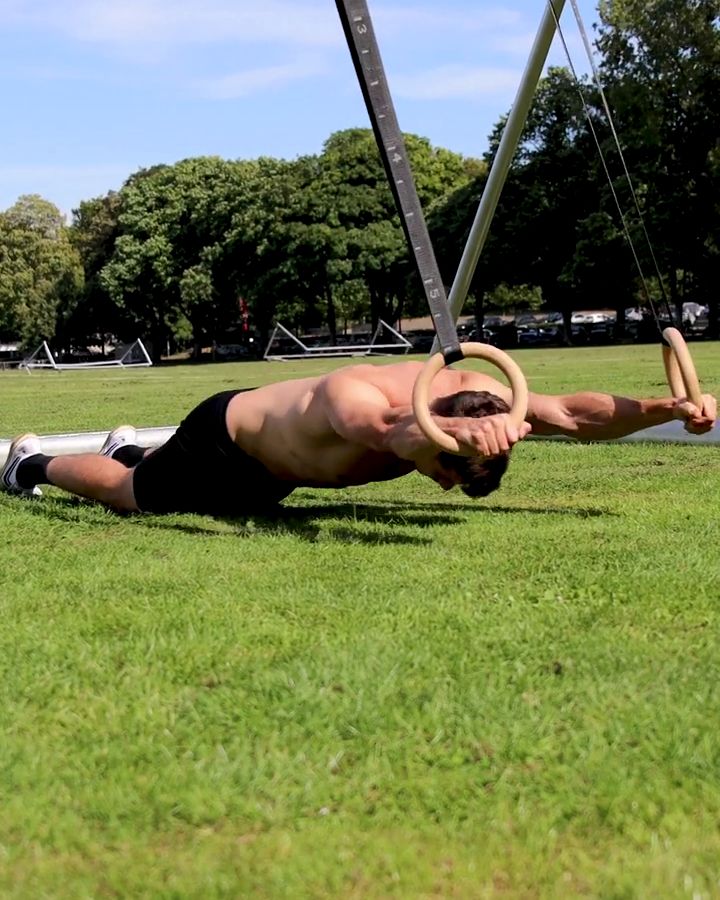
Rollouts with gym rings
Rollouts on the gymnastic rings, also known as "Ring Rollouts" or "Ab Rollouts," are a challenging calisthenics exercise for strengthening the abdominal muscles and the entire core. This exercise requires a high level of body tension and, in addition to the abdominal muscles, also trains the shoulders and lower back. The instability of the rings makes the exercise particularly intense, making it ideal for advanced athletes looking to take their core strength to the next level.
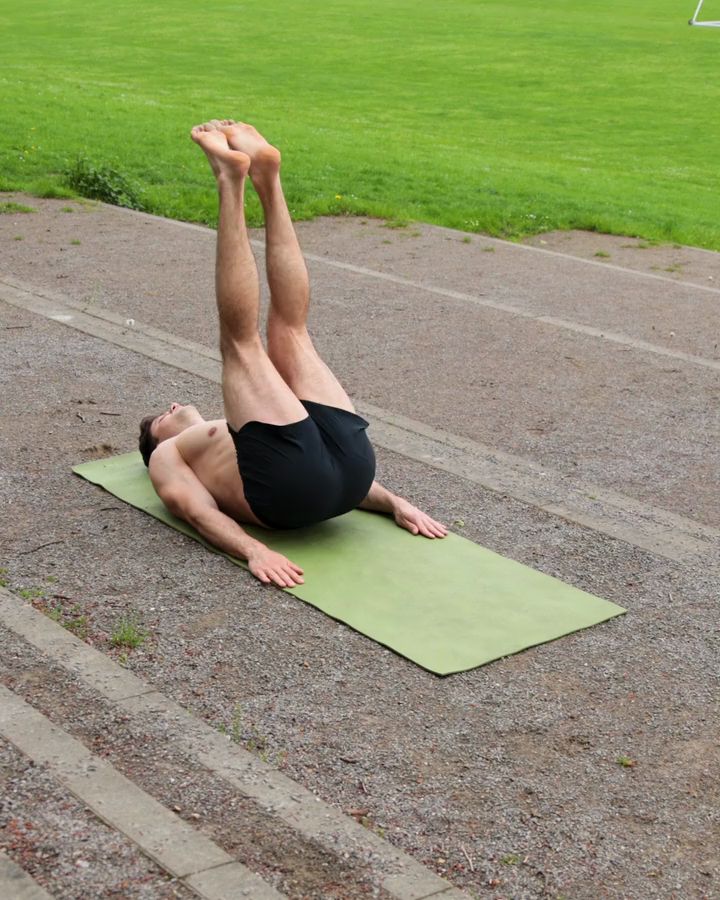
Lying Leg Raises
Lying leg raises are an effective exercise for strengthening the abdominal muscles, particularly the lower abs. This exercise should not be confused with lying knee raises, as it specifically targets lifting the straight legs, thereby providing a more intense challenge for the abdominal muscles. Known as "Leg Raises" or "Leg Lifts," lying leg raises are a bodyweight exercise suitable for both beginners and advanced practitioners aiming to build a strong and stable core. In addition to this classic, floor-based version, there are other challenging variations of leg raises, such as hanging leg raises on a pull-up bar or on rings. These variations not only require strong abdominal muscles but also good grip strength and body tension. Another option is leg raises in the dip position on parallel bars or the ring variant, where the legs are raised from a supported but unstable position. These different exercises provide a comprehensive challenge for the abdominal muscles, making the training more varied and intense.
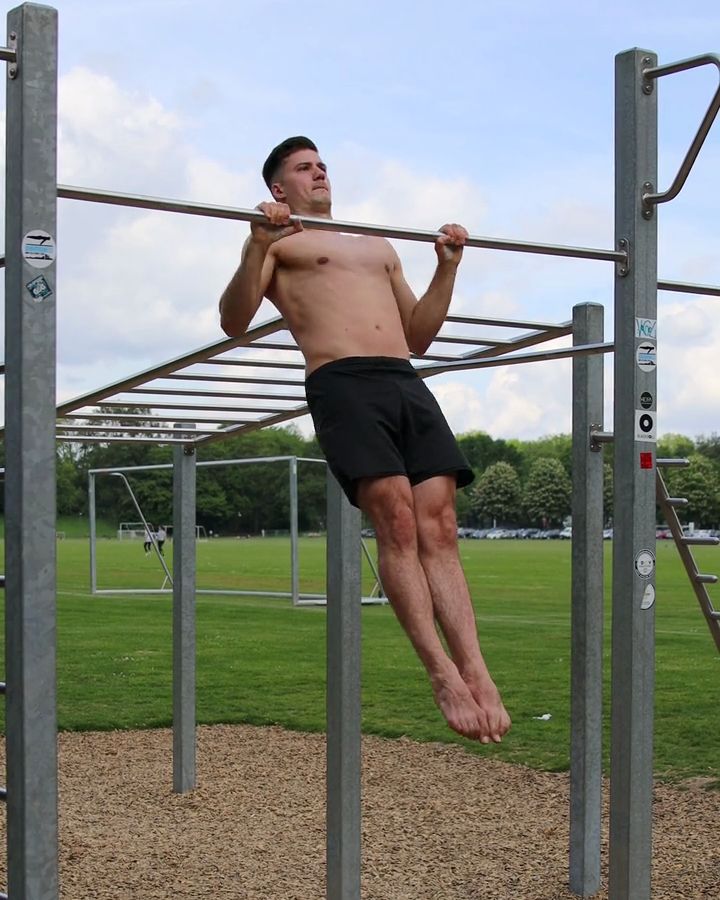
Explosive Pull Ups
Explosive pull-ups are a dynamic variation of the classic pull-ups, where the body is pulled upwards with explosive force. This exercise primarily engages the upper body muscles, including the back, shoulders, and arms, while also requiring core stabilization. The movement ends in a quick, powerful extension, bringing the chin above the bar. Explosive pull-ups are often used as a preparatory exercise for muscle-ups, as they develop the necessary strength and explosive power in the upper body required for the more advanced movement.
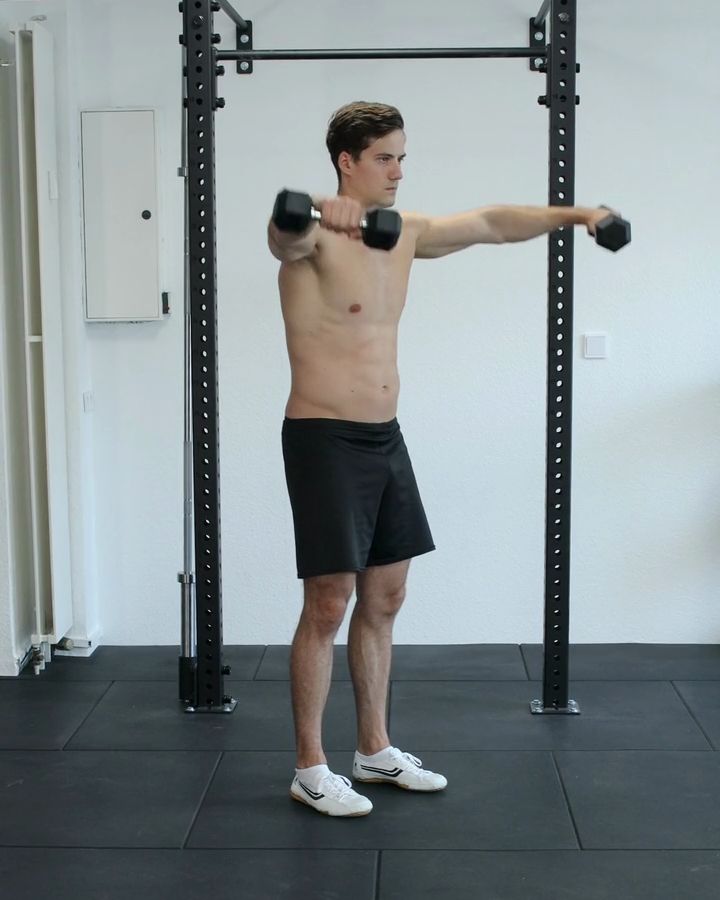
Lateral Raises with dumbbells
The lateral raise with dumbbells is an effective isolation exercise that primarily targets the lateral part of the shoulder muscles (M. deltoideus pars acromialis). This exercise helps to define the shoulders and develop a broader shoulder area. You maintain an upright posture and lift your arms sideways to shoulder height to optimally activate the muscles. You only need dumbbells, and beginners can easily perform it.
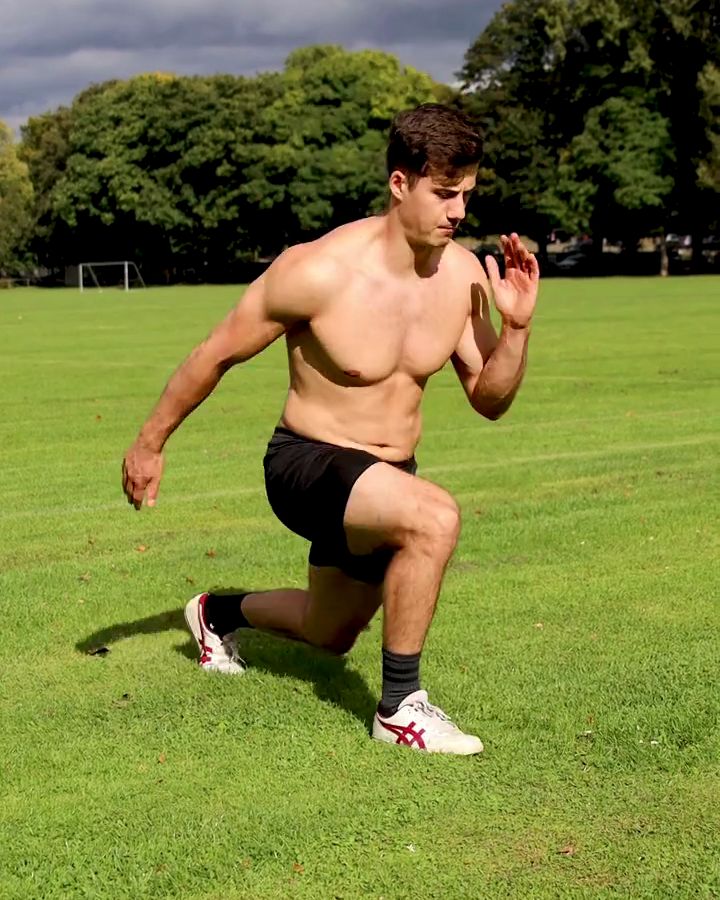
Jumping Lunges
Jumping lunges are a dynamic variation of the classic lunge, in which a jump is performed between switching legs. Similar to jump squats, this exercise trains the entire leg and glute muscles while simultaneously promoting coordination and balance. The inclusion of jumps also increases the heart rate and strengthens the cardiovascular system. Jumping lunges are particularly well-suited for HIIT workouts or as an addition to strength training sessions.
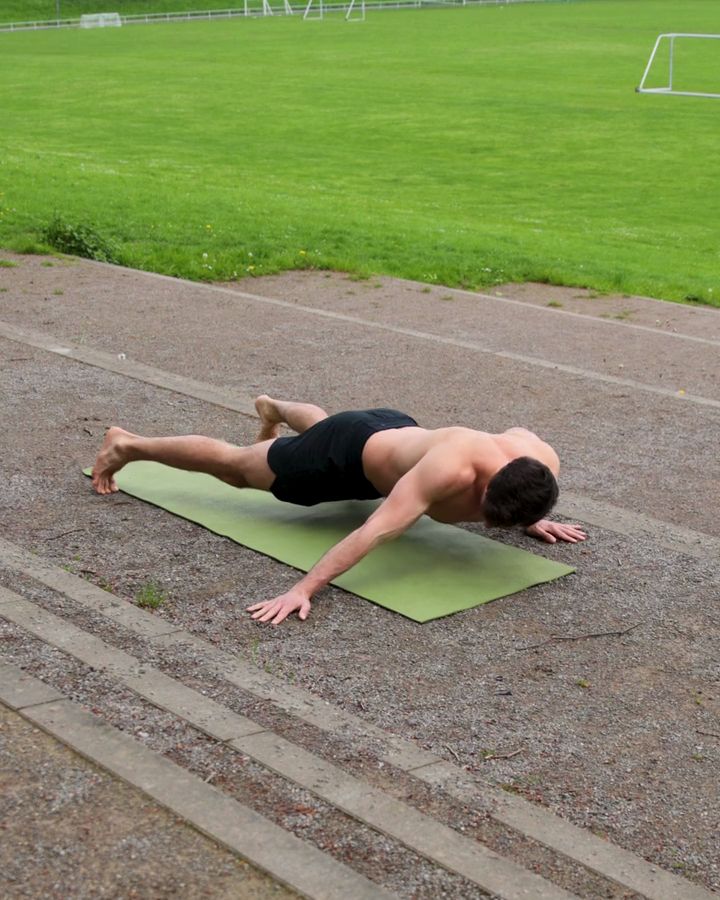
Archer Push Ups
Archer push-ups, also known as archer press-ups, are a challenging variation of the classic push-up. They primarily target the upper body while also engaging the core muscles through the lateral shifting of weight. One side of the body bears more weight while the other remains extended, resulting in an asymmetrical load. This exercise requires good body control. The archer push-up can be seen as a precursor to the one-arm push-up, where a greater portion of the body weight is also supported by one side.
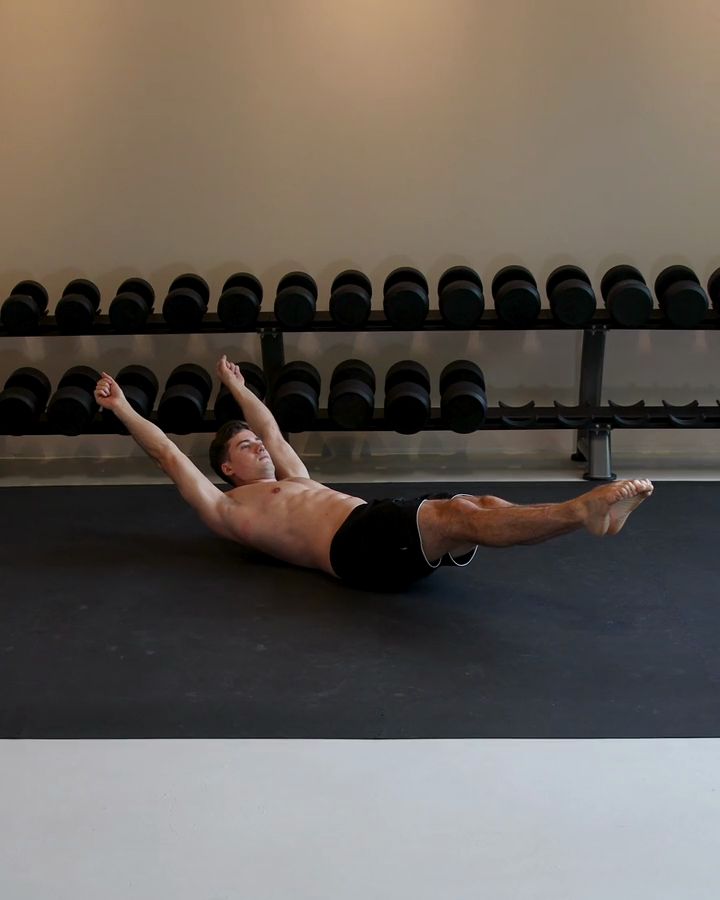
Hollow Body Hold
In the hollow body hold, you lie on your back and tense the entire body while pressing the lower back firmly into the floor. This static exercise primarily targets the abdominal muscles and is especially popular in gymnastics and calisthenics to improve core strength. A similar exercise is the forearm plank, where the abdominal and core muscles are also strengthened through static holding work.
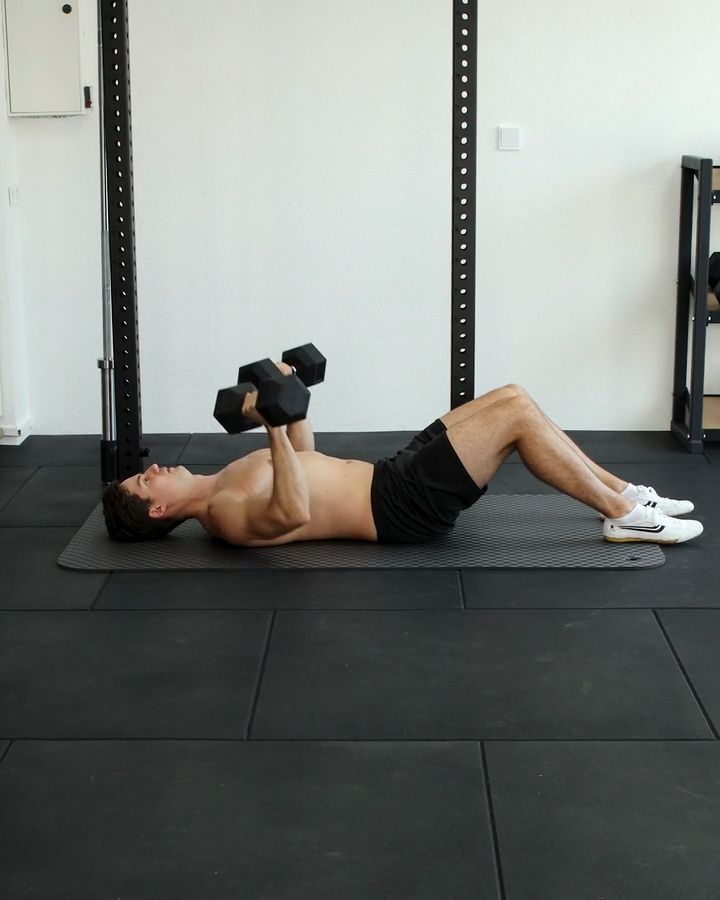
Floor Press with dumbbells
The floor press is an exercise where you lie on the ground and press the dumbbells up from the chest. Compared to the classic bench press, the range of motion is shorter since the movement is limited by the floor, reducing the strain on the shoulders. This exercise is particularly suitable for beginners, rehabilitation, or when a bench is unavailable. When performed on a flat bench, it is referred to as the dumbbell bench press.
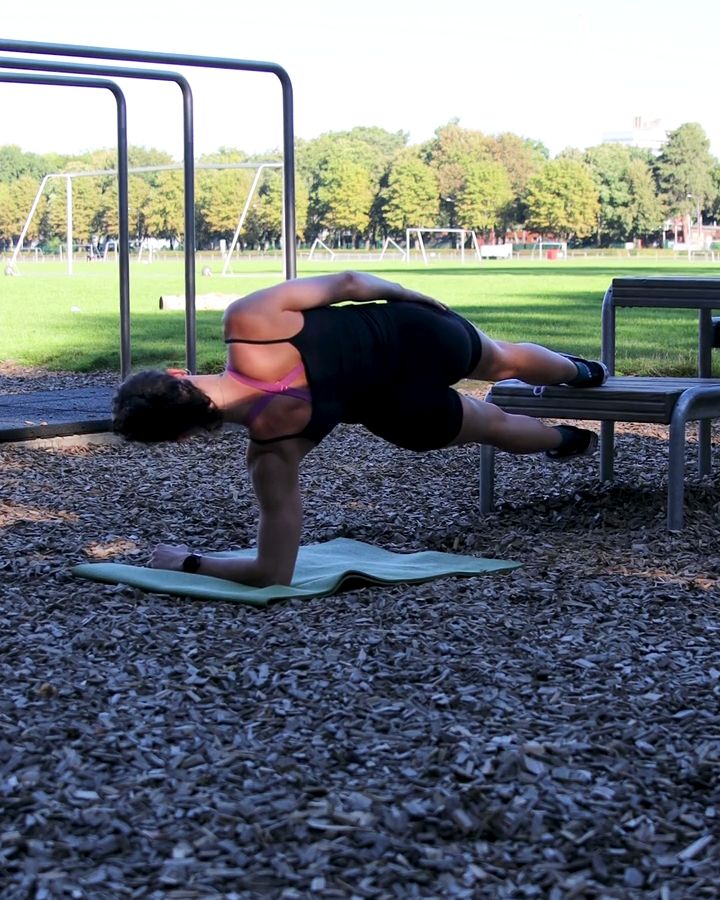
Copenhagen Plank
The Copenhagen plank is an exercise where you support yourself on one forearm while placing one leg on an elevated surface, such as a bench. It primarily strengthens the core muscles and the adductors, while also promoting hip stability. This exercise is particularly popular in rehabilitation sports and sports involving quick changes of direction. A similar exercise is the side plank, which also strengthens the core muscles but targets the abductors instead of the adductors.
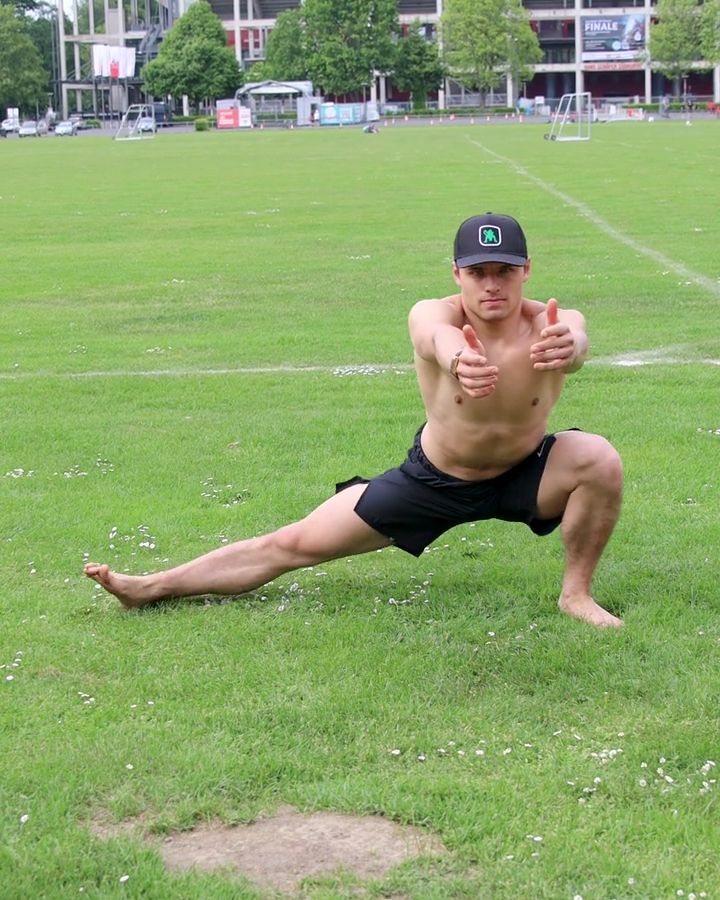
Cossack Squats
The Cossack squat is a lower body exercise. In this movement, you shift side to side, keeping one leg straight while the other bends. This creates an intense stretch in the inner thigh muscles and improves hip mobility. This exercise is especially good for enhancing your hip flexibility.
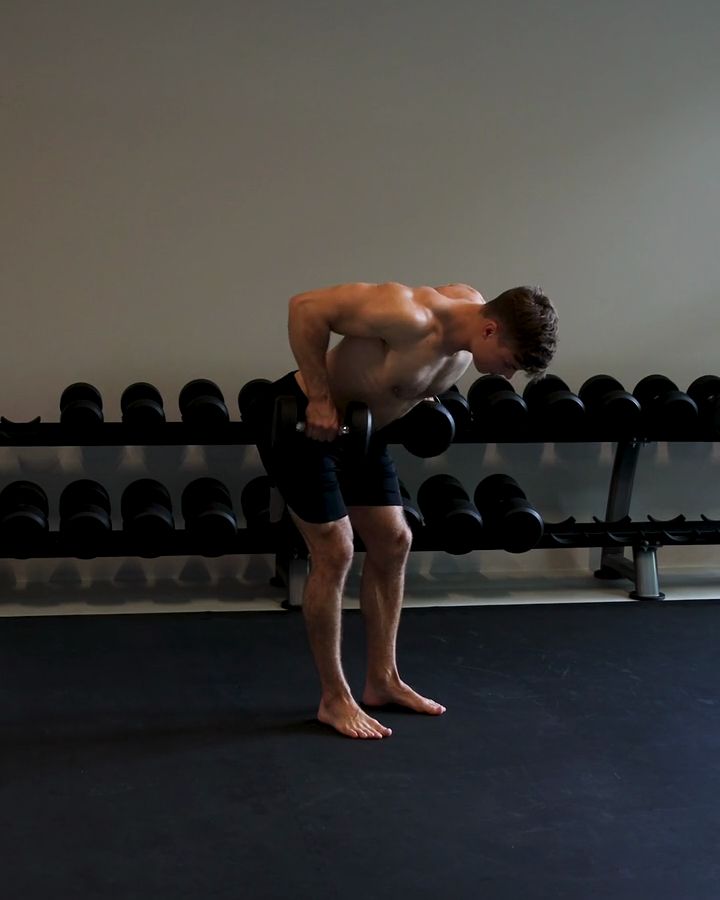
Bent Over Rows with dumbbells
The Bent Over Row with dumbbells is an effective exercise for the upper back. The upper body is leaned forward while the dumbbells are pulled up in a controlled manner, bringing the shoulder blades together. It is important to keep the back straight and perform the movement slowly. This exercise can also be done with a barbell.
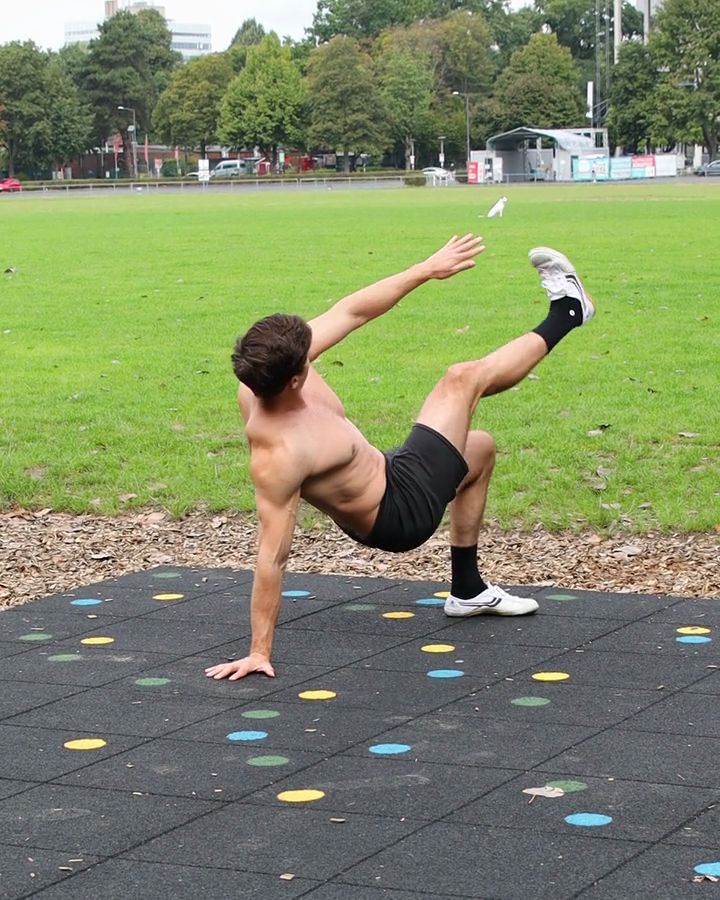
Break Dancer Exercise
The breakdancer exercise is a dynamic movement that effectively trains your core muscles as well as your shoulders and upper back. It simultaneously improves stability, coordination, and flexibility by challenging you with controlled rotations. This exercise is ideal for adding variety and intensity to your workout.
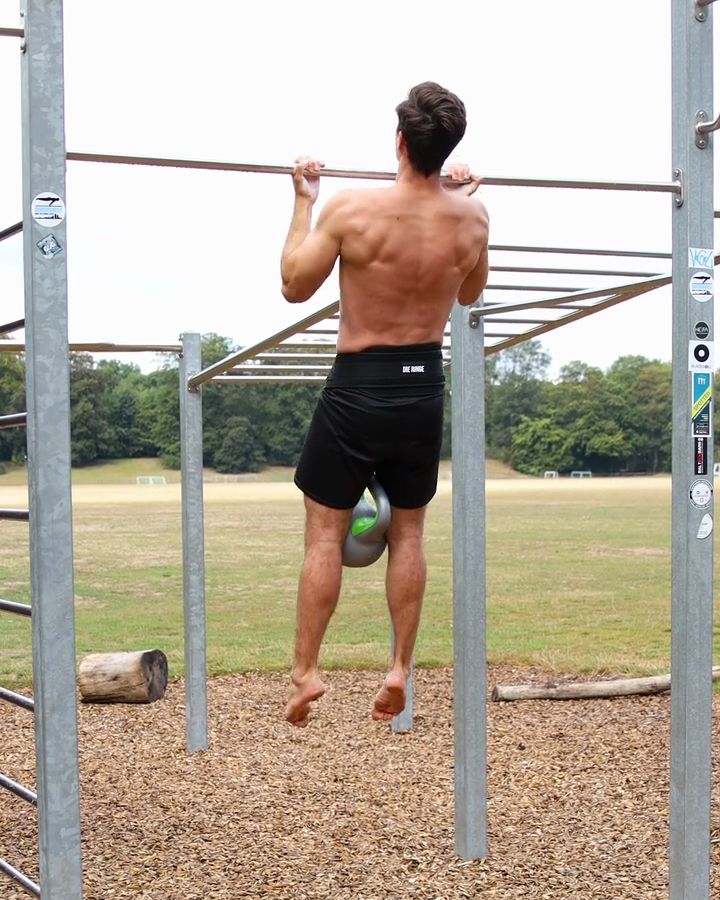
Weighted Chin Ups
Weighted chin-ups, also known as chin-ups with a neutral grip, are an excellent exercise for the back and biceps. Compared to weighted pull-ups (overhand grip), there are slight differences in the muscles targeted between the two variations—differences even measured in studies. However, the differences are so small that they hardly matter for most people, unless you’re pursuing serious bodybuilding goals. Both exercises activate muscles similarly, with chin-ups emphasizing the biceps and slightly engaging the chest, while pull-ups target the lower trapezius a bit more. Bottom line: both are great for building a strong back. But if your goal is to learn the bar muscle-up, then the weighted pull-up is the better choice!
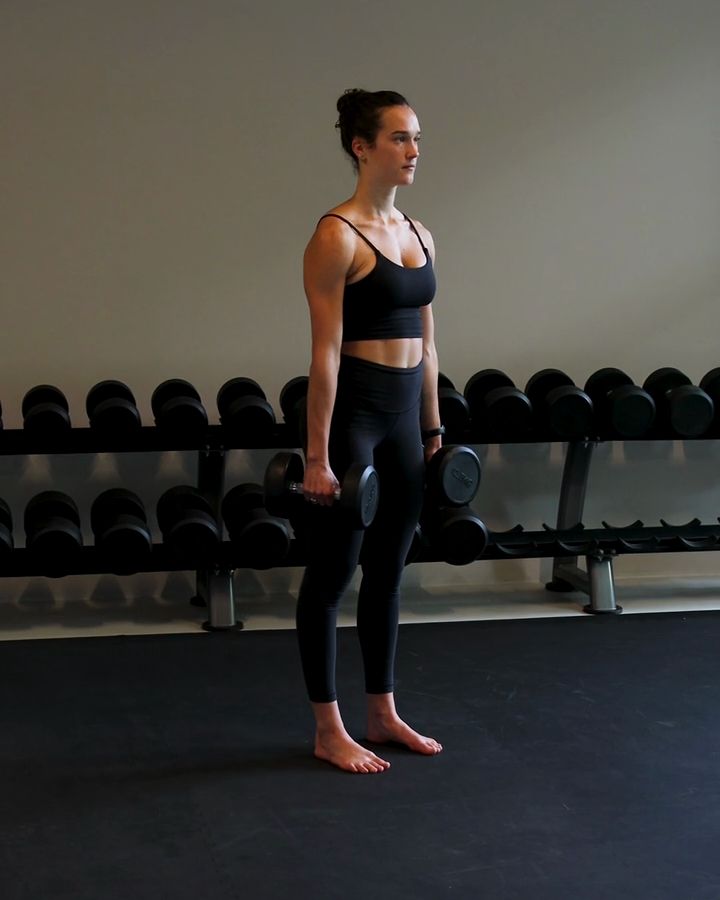
Shrugs with dumbbells
Shrugs, also known as neck pulls, are a popular fitness exercise for strengthening the neck muscles and upper back. This exercise can be performed in various forms, including with barbells, cable machines, Smith machines, or resistance bands. Athletes can choose between standing and seated versions, as well as positioning the weights in front of or behind the body. Here you see standing shrugs with dumbbells.
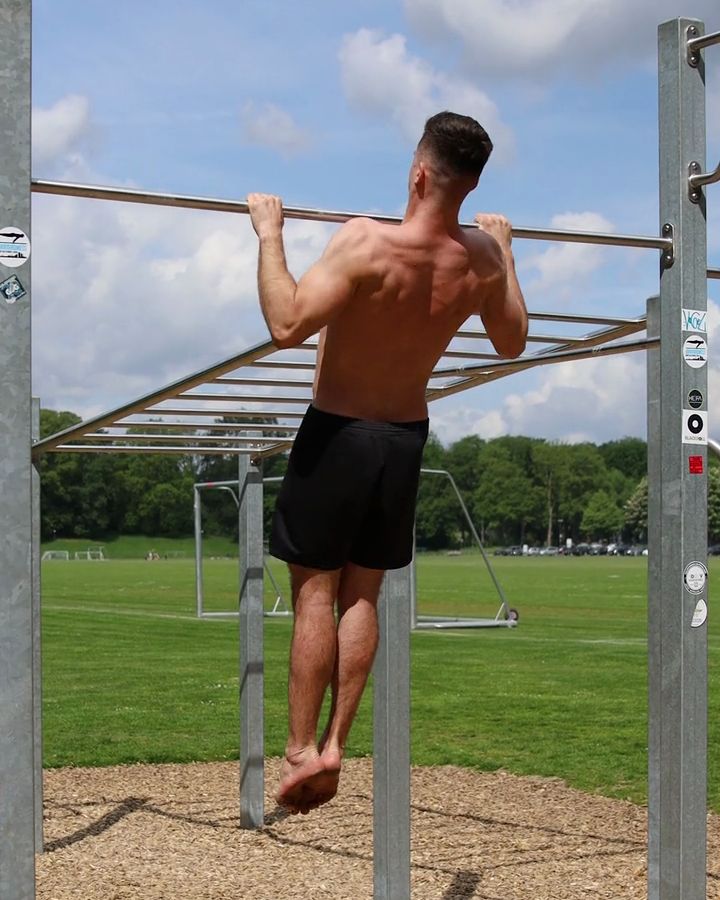
Pull Ups
The overhand grip pull-up on the bar is a classic exercise in strength training that effectively strengthens the muscles of the back and arms. In this variation, the palms face away from the body. The overhand grip pull-up is not only a benchmark for functional upper body strength but also an excellent exercise for improving grip strength and body control. Similar exercises like the Ring Pull Up or the L-Sit Pull Up offer additional challenges. Furthermore, learning the overhand grip pull-up, combined with explosive pull-ups, lays the foundation for successfully mastering the Bar Muscle Up.
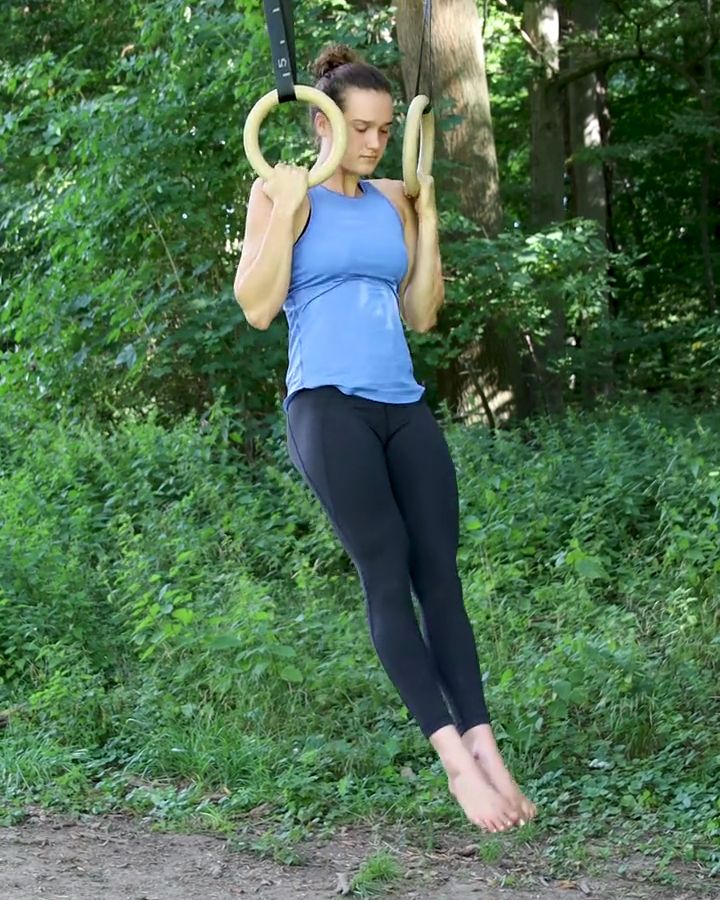
Chin Ups with gym rings
Pull-ups on gymnastics rings, also known as ring pull-ups, are a fundamental exercise in calisthenics. Compared to classic overhand grip pull-ups on a bar, ring pull-ups are often gentler on the wrists and elbows since the rings are freely rotatable and can adapt to the body's natural movement. However, the muscles engaged remain the same as with bar pull-ups. Ring pull-ups also serve as an ideal preparation for advanced exercises such as the ring muscle-up or L-sit pull-ups on rings.
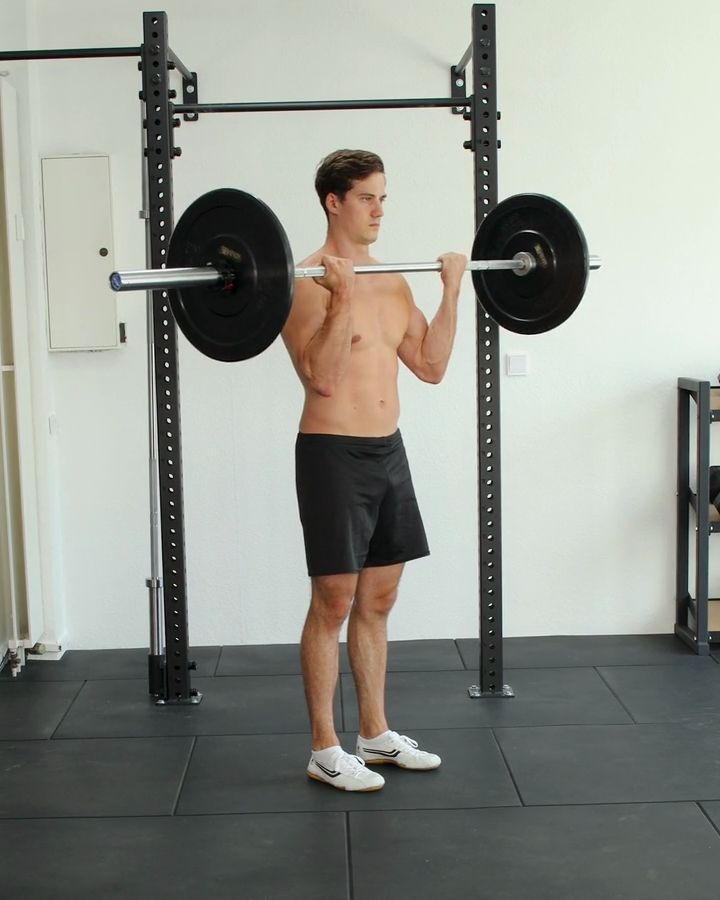
Biceps Curls with a barbell
Barbell biceps curls are a fundamental exercise in strength training, particularly effective for building and strengthening the biceps muscles. This variation allows you to train both arms simultaneously. The ability to use heavier weights compared to dumbbells enables more intense training stimuli, making the barbell biceps curl a popular choice for athletes looking to increase their upper arm size and strength. With alternative exercises like dumbbell biceps curls or biceps curls on gymnastic rings, similar training stimuli can be achieved.
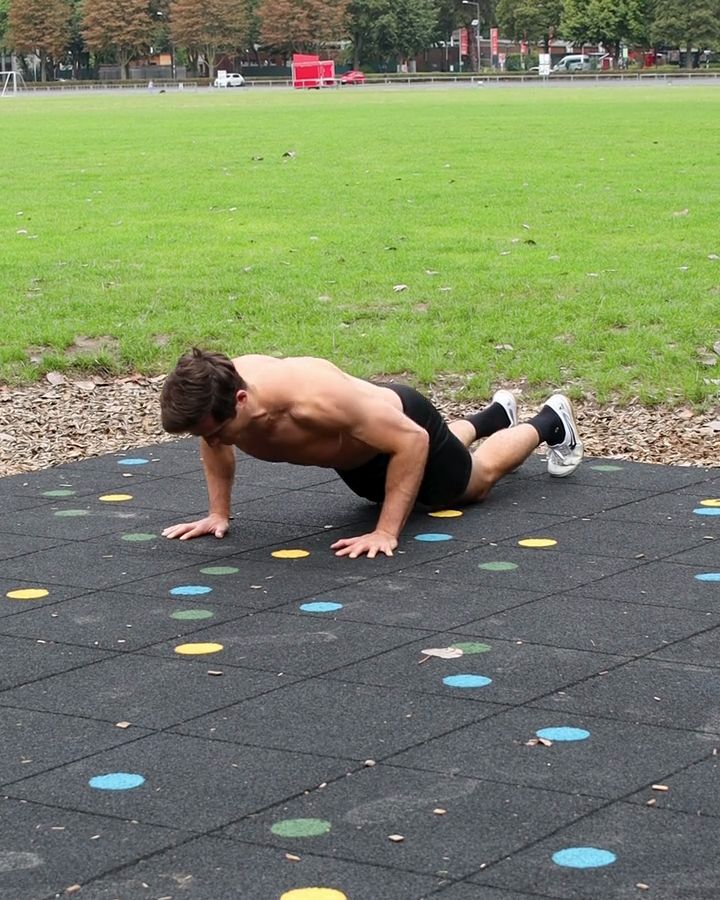
Negative Push Ups
Negative push-ups, also known as eccentric push-ups, are an exercise where you slowly and controlled lower your body from the top push-up position to the ground. This movement trains the chest, shoulders, and triceps and is particularly effective for muscle building. Negative push-ups are ideal for beginners looking to improve their strength and control, or for advanced athletes who want to increase their training intensity. The negative push-up is an ideal preparatory exercise for learning the classic push-up as it builds eccentric strength in the relevant muscles. It facilitates the transition to more advanced exercises that require greater body control and balance.
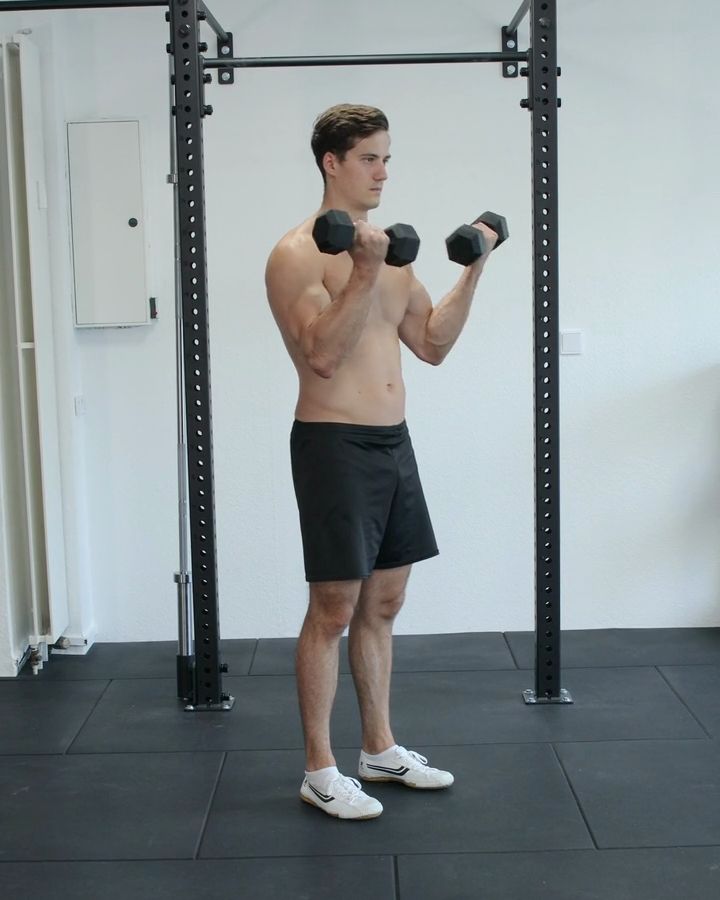
Biceps Curls with dumbbells
Bicep curls are a classic bodybuilding exercise specifically designed to strengthen and shape the biceps muscles. While performing the exercise with a dumbbell allows for isolated training of each arm, bicep curls with a barbell offer the opportunity to use heavier weights. The exercise bicep curls on gymnastics rings provides an excellent alternative, especially when you're traveling and don't have access to a gym.
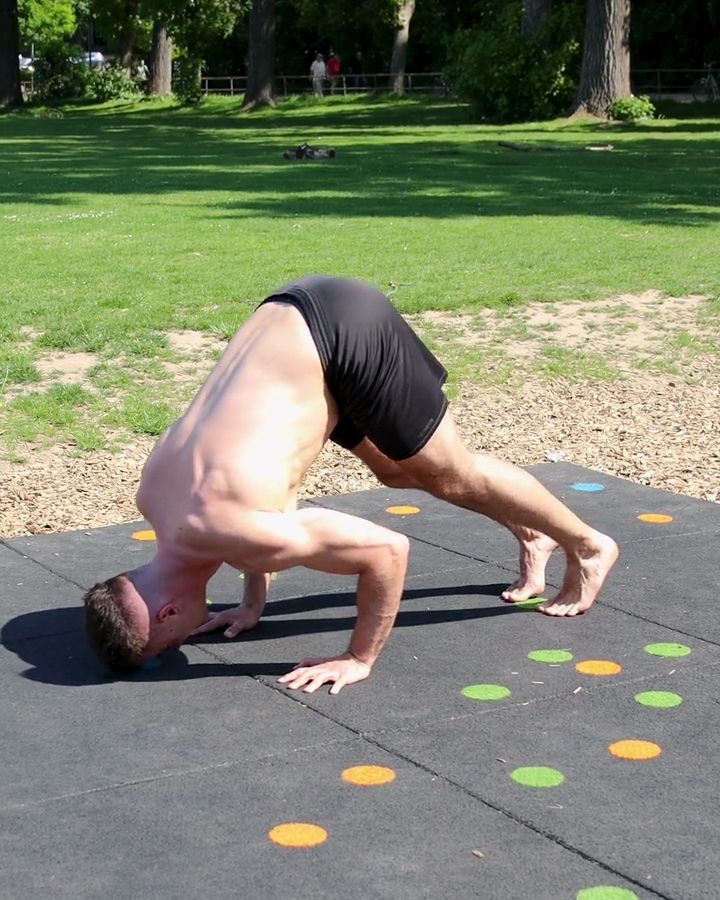
Pike Push Ups
Pike pushups, also known as "shoulder push-ups" or "pike press," are an excellent calisthenics exercise for strengthening the shoulders and triceps. This exercise mimics the movement of a handstand push-up, making it ideal for those looking to build shoulder strength without using weights. Popular weighted alternatives include shoulder presses and Arnold presses.
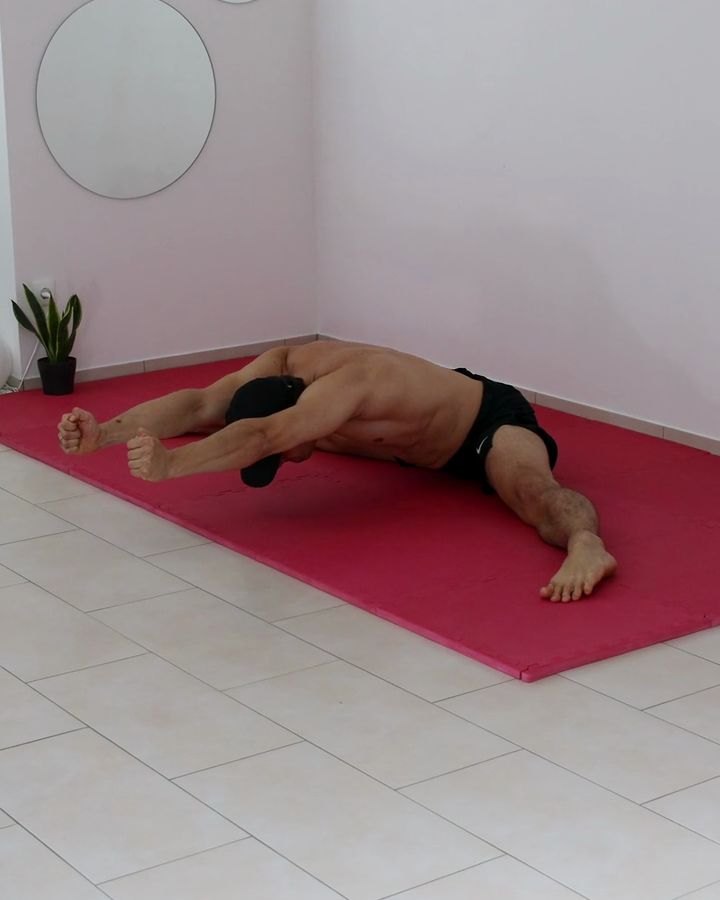
Pancake Stretch
The pancake stretch is a flexibility exercise that primarily enhances flexibility in the hips, groin area, inner thighs, and hamstrings. In this stretch, you sit on the floor with your legs spread apart and bend your upper body forward. The further you lean forward, the more intense the stretch becomes. The pancake stretch is a mobility prerequisite for the Press Handstand and a preparatory exercise for the Splits.
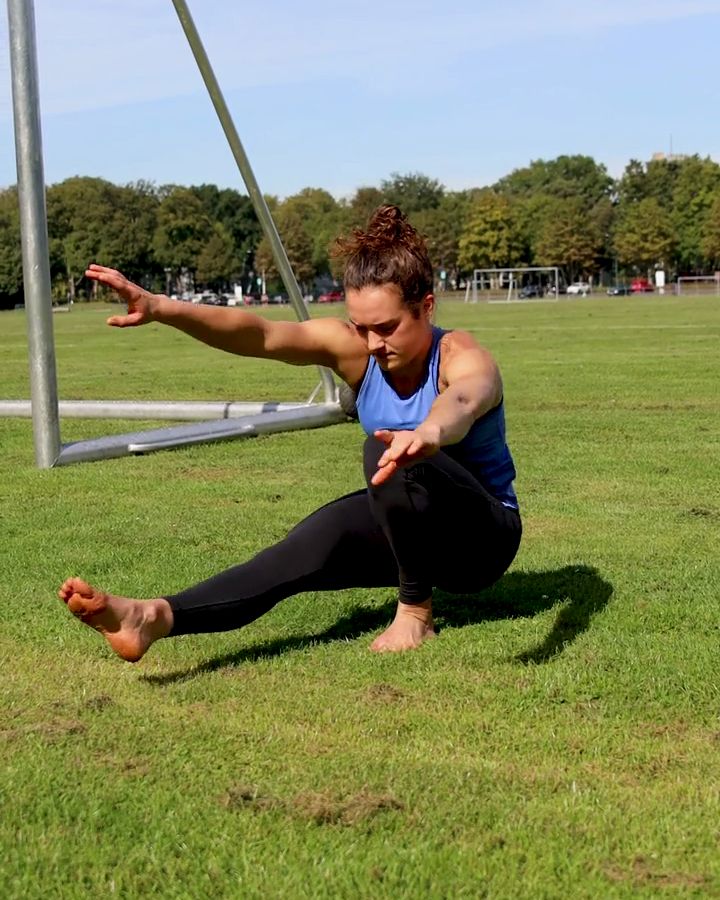
Pistol Squats
The pistol squat is a challenging single-leg squat where you lower yourself deep into a squat while keeping the other leg extended forward. This exercise requires not only strength but also good balance and flexibility. It particularly targets the thighs, glutes, and core muscles. Those who want to work their way up to pistol squats can start with supportive exercises like the Bulgarian split squat or deep squat with weight to build the necessary strength and flexibility. Progressions of the pistol squat, which are explained further below, are also useful for learning the movement. Even more complex is the so-called dragon squat, where the free leg is crossed behind the standing leg as you lower into the squat.

Dead Bug
The Dead Bug exercise falls under the category of core exercises and aims to strengthen the abdominal muscles. It is particularly effective for improving stability and control throughout the entire body. During the exercise, the arms and legs are moved alternately. It is important to keep the lower back in contact with the floor to maintain tension in the abdominal muscles. A similar exercise is the Bird-Dog, where you start in a quadruped position instead of lying on your back.
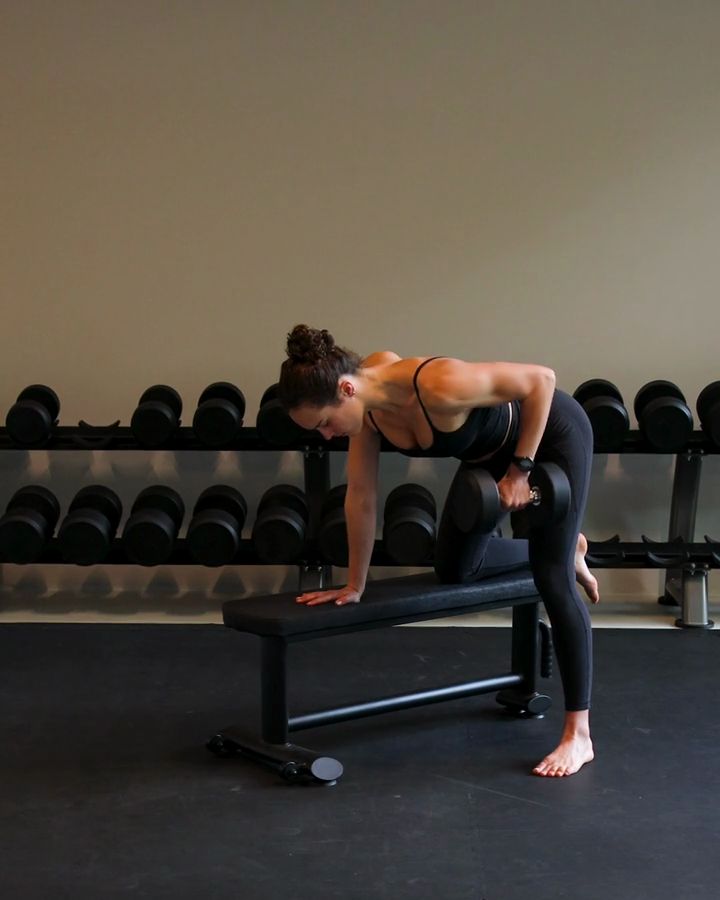
One Arm Row with dumbbells
One-arm dumbbell rows are among the most effective back exercises in bodybuilding. Compared to one-arm rows with gymnastics rings, this variation has the advantage of allowing the use of lighter weights, making it suitable for beginners as well.
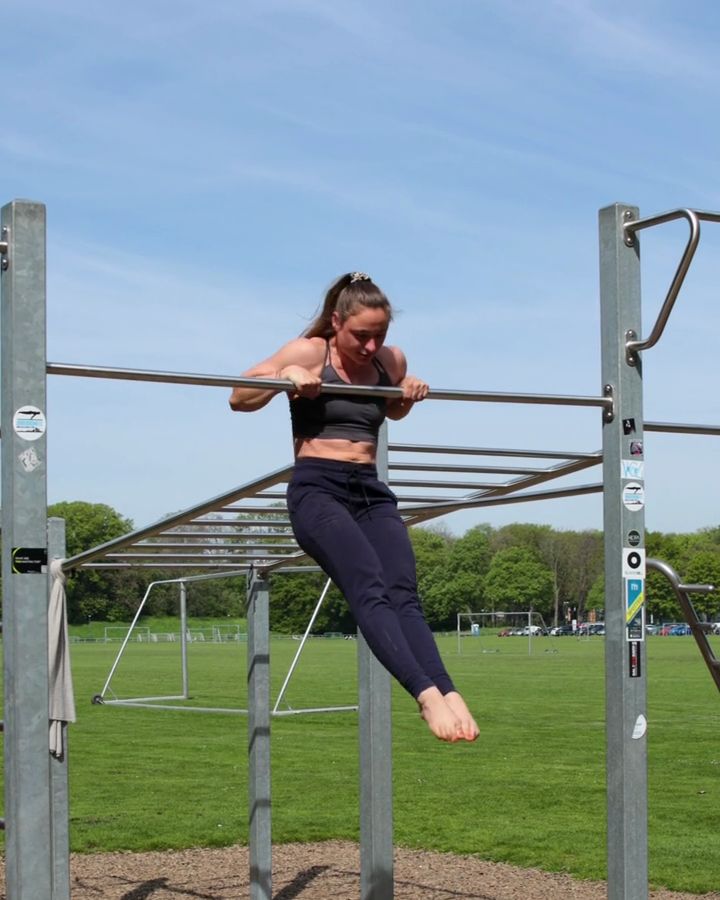
Bar Muscle Ups
The bar muscle-up, or muscle-up on the bar, is an advanced exercise where you first pull yourself up to a bar with a pull-up and then push yourself over the bar into a dip. This exercise trains the entire upper body, particularly the back, shoulders, chest, and arms, while enhancing both strength and coordination. It requires explosive pulling power and precise technique to perform the movement smoothly. The bar muscle-up is especially popular in CrossFit and calisthenics for demonstrating body control and strength.
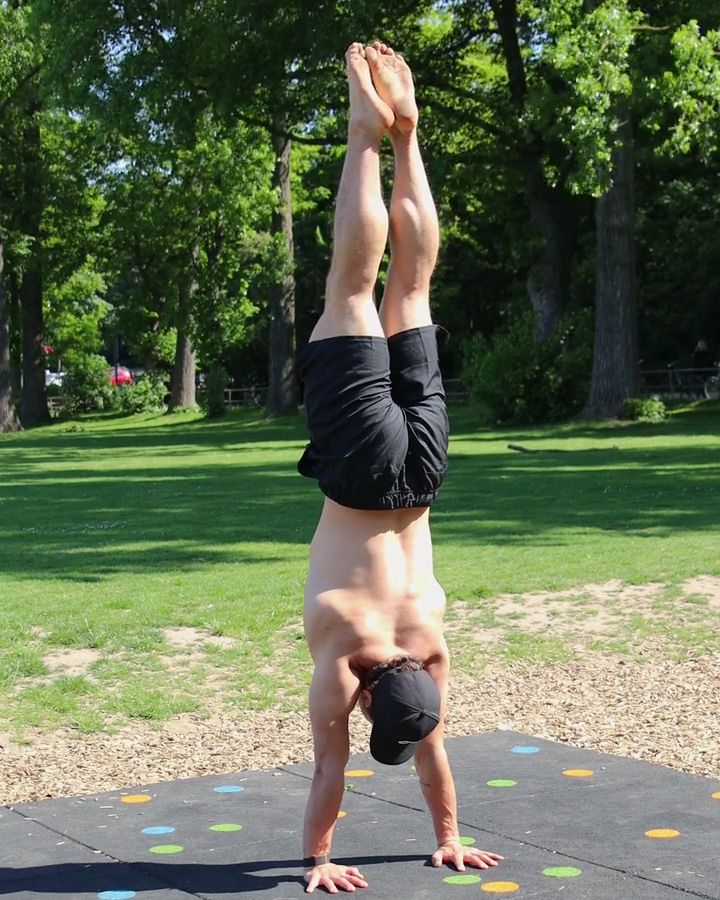
Handstand
The handstand is one of the most fundamental and significant exercises in calisthenics. It requires not only strength in the shoulders, arms, and upper back but also balance and precise body control. Regular practice is the key to mastering the handstand. In addition to the handstand, there are other challenging exercises, such as the Handstand Push-up, where you bend your arms and push yourself back up while in a handstand. An ideal preparatory exercise for this is the Pike Push-up. This variation combines the benefits of the handstand with a more stable starting position and targets similar muscle groups, making it especially suitable for beginners. The Swiss Handstand is a challenging progression where you powerfully press into a handstand with straight arms—a great challenge for advanced athletes.
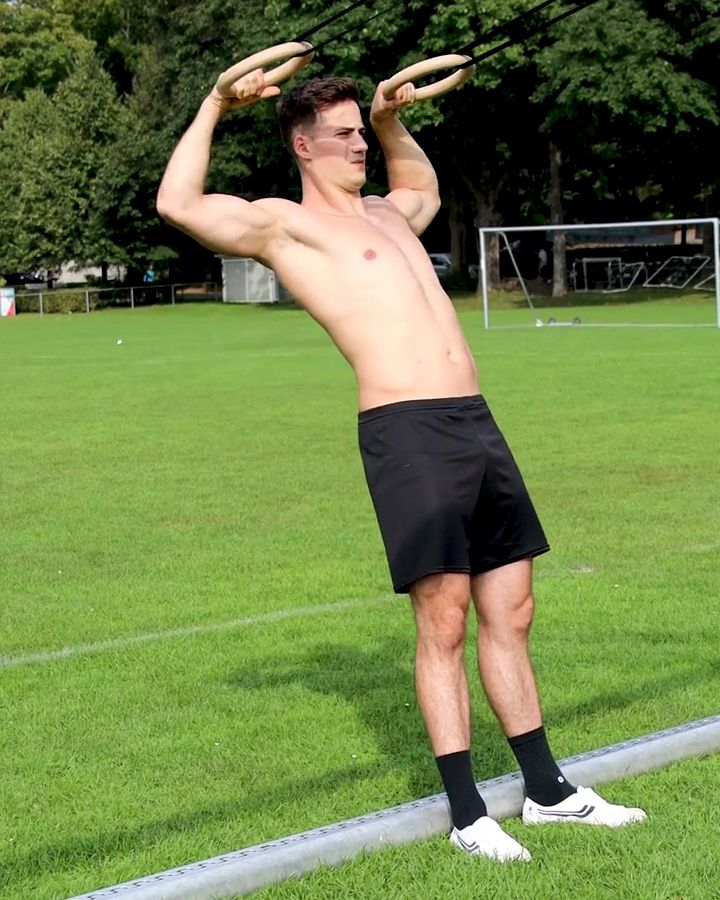
Face Pulls with gym rings
Face pulls are an exercise specifically designed to strengthen the rear shoulder muscles and the upper back. By pulling towards the face and rotating the arms outward, the rotator cuff and rear deltoids are activated, which helps to build shoulder strength and prevent shoulder injuries. This exercise is particularly effective in correcting muscular imbalances in the shoulder area and can also promote better posture.
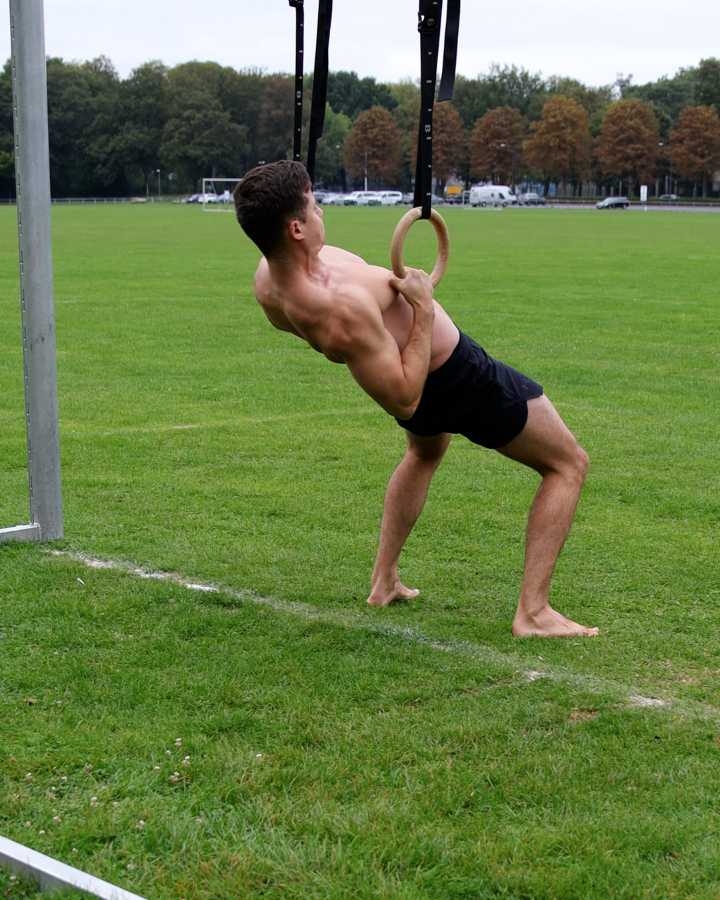
One Arm Row with gym rings
The one-arm row on gymnastics rings is a unilateral pulling exercise. It offers a more intense alternative to one-arm dumbbell rows and is an excellent way to add variety to your training routine.
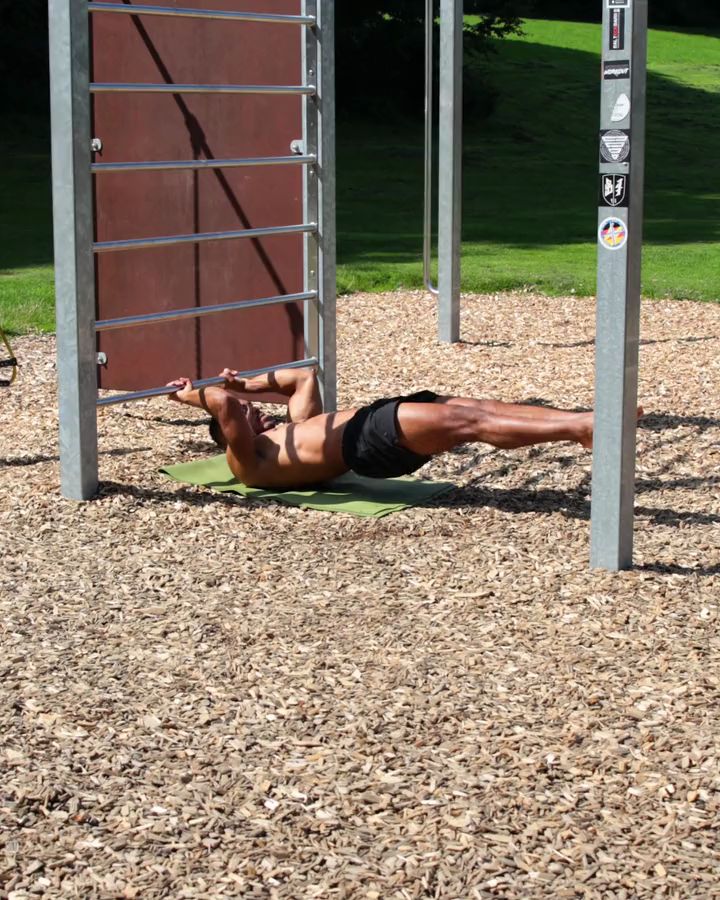
Dragon Flag
The Dragon Flag is a challenging core exercise, famously associated with Bruce Lee, and is notorious for its intense demands on the abdominal muscles. This exercise targets the entire midsection for strengthening. During execution, the body is held almost horizontally, with the upper back being the only point of contact with the floor. Although the Dragon Flag is an extremely demanding exercise, it is entirely possible to master it by training progressively. Effective preparatory exercises include the One-Leg Dragon Flag, where one leg is lifted while the other remains on the ground, the Tuck Dragon Flag, where the knees are pulled to the chest, and the Negative Dragon Flag, which focuses on the controlled downward movement. Essential preparatory exercises to master beforehand include the static holds Plank and Hollow Body Hold.
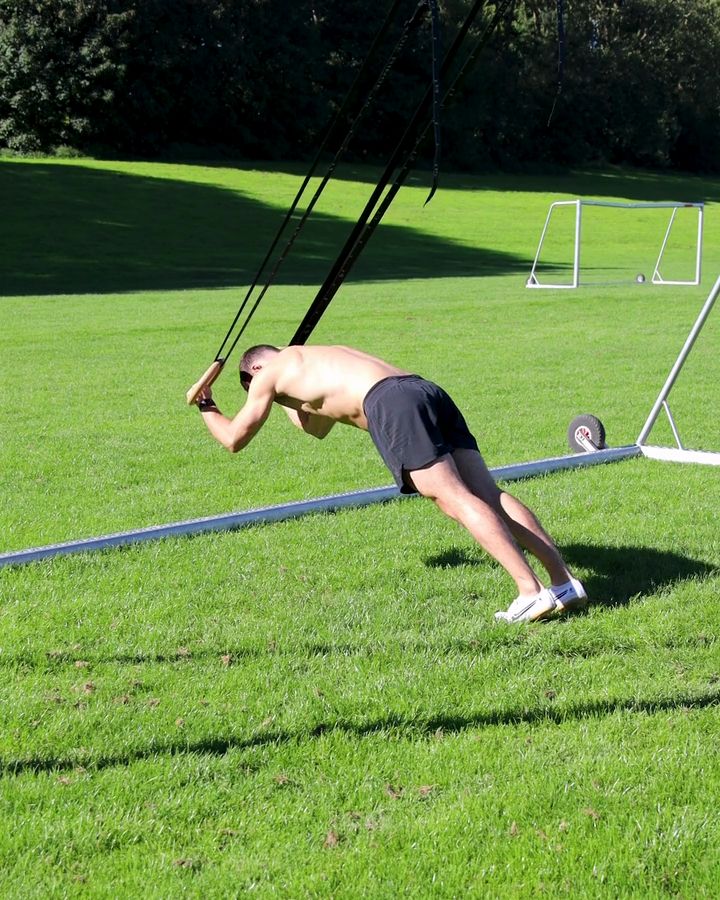
Triceps Extensions with gym rings
Triceps Extensions on the rings focus on building muscle in the triceps and are an excellent preparation for more advanced exercises like Ring Push-ups or Ring Dips. In this exercise, you start in an inclined plank position with your arms extended while gripping the rings. By bending your elbows in a controlled manner, you lower your body forward and then return to the starting position with a powerful extension of the arms.
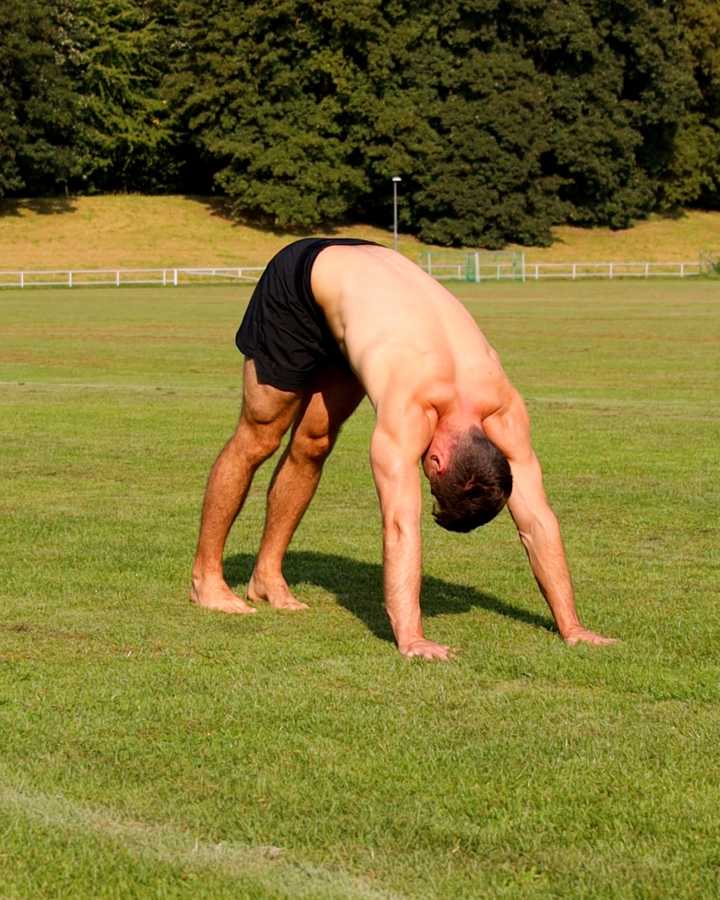
Downward Dog Pose
The downward-facing dog pose is one of the most well-known yoga poses and often serves as a starting point for many other exercises. In this position, you stretch your body into an inverted V-shape, with your hands firmly on the ground and your hips lifted upwards. This pose stretches the muscles at the back of the legs, strengthens the shoulders, and improves spinal flexibility. The downward-facing dog also promotes circulation and can help relieve tension in the back.
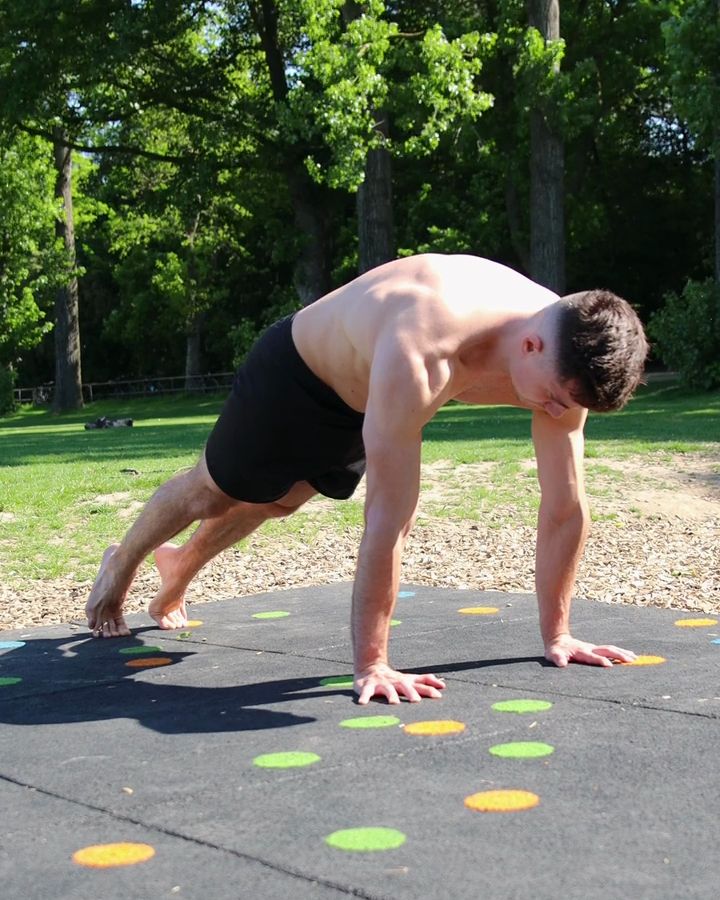
Push Up Hold
The static push-up, also known as the push-up hold, is an isometric exercise. In this exercise, you maintain the push-up position without moving up or down as you would in classic push-ups. This exercise is particularly effective for training the upper body, as it requires you to maintain tension over an extended period. The static push-up challenges not only your strength but also your endurance and mental toughness.
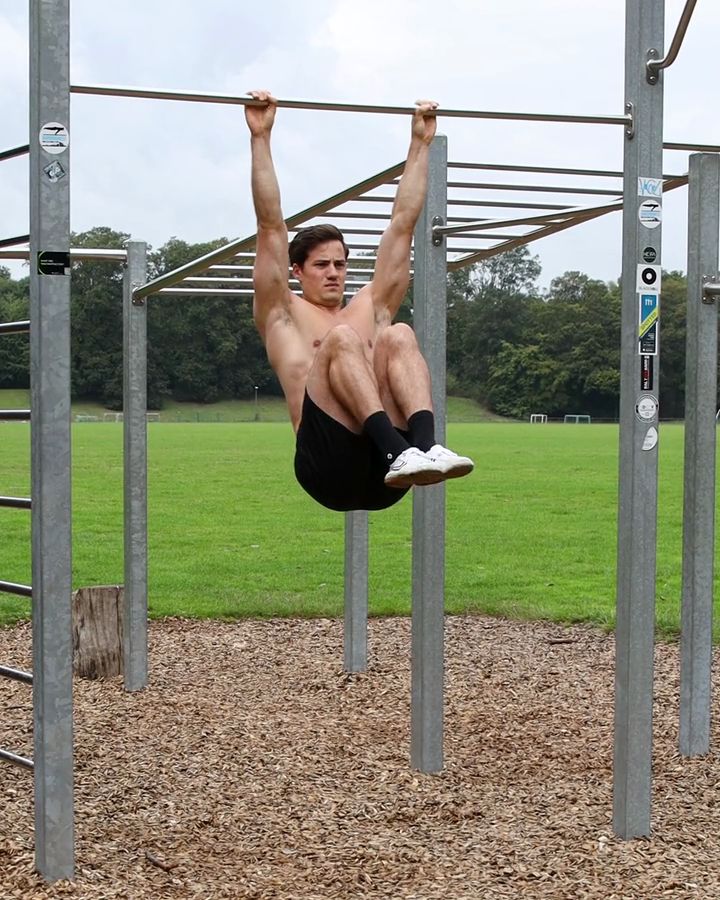
Hanging Leg Raises
Hanging leg raises are an effective exercise for training the abdominal muscles, particularly the lower abs. In this exercise, you hang from a bar and lift your straight legs in a controlled manner up to hip height. This exercise requires core strength and strong grip strength. Compared to leg raises on the dip bar or rings, hanging leg raises are better suited for focusing on the abdominal muscles since you don't need to support your body. Additionally, they are an excellent preparation for the more complex exercise toes to bar.
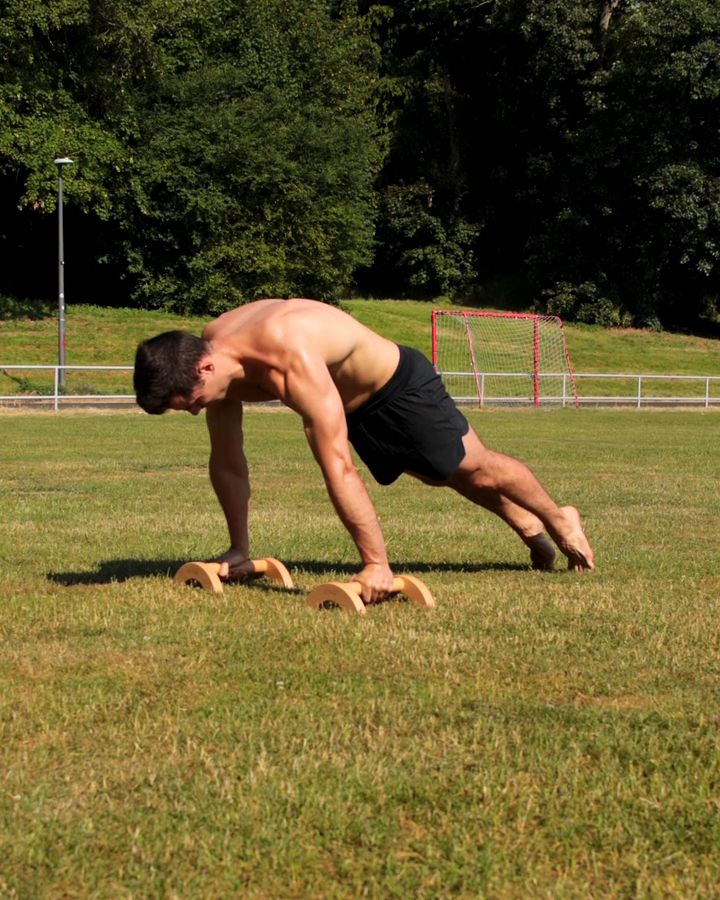
Planche Lean
The Planche Lean is one of the best exercises to prepare for the Planche, one of the most impressive calisthenics moves. Using parallettes helps reduce strain on the wrists and provides a more stable grip.
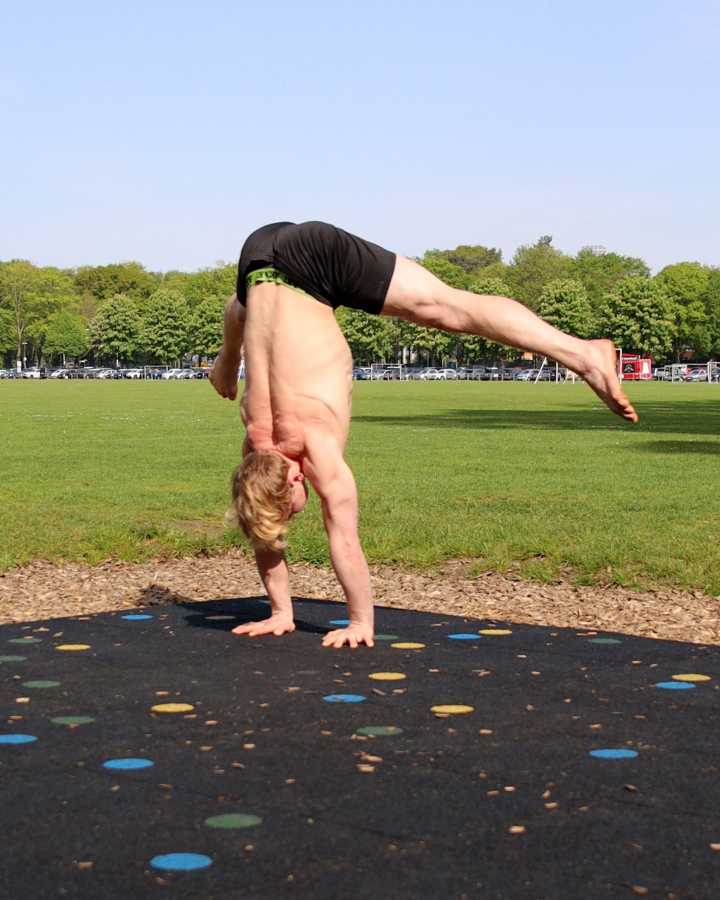
Straddle Press Handstand
The Press Handstand is one of the most challenging ways to get into the Handstand. You start from a straddle position and pull your legs past your body into the handstand. This exercise requires a high level of strength, flexibility, and stability in the handstand.
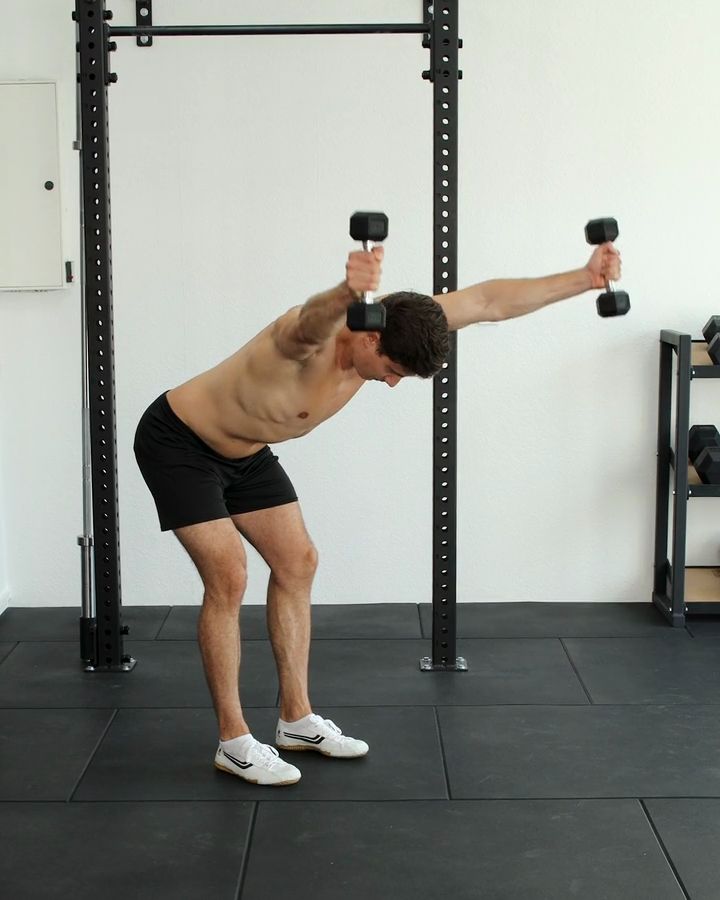
Y Raises with dumbbells
Y raises with dumbbells are an effective exercise for strengthening the upper back muscles, particularly the trapezius. This exercise helps improve posture and prevent shoulder issues. Unlike classic shoulder exercises like Lateral Raises or Front Raises, Y raises focus on external rotation of the shoulder joints, which is crucial for shoulder stability. They are a great alternative to exercises like Face Pulls, as they target similar muscle groups.
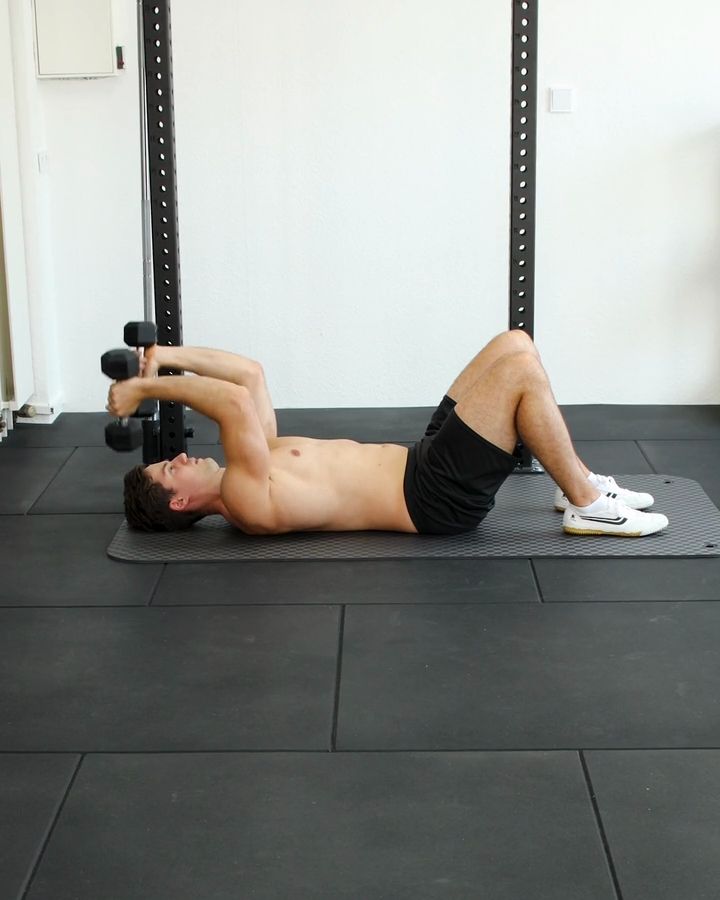
Lying Triceps Extensions with dumbbells
Lying triceps extensions are an isolation exercise that specifically strengthens the triceps, focusing on the bending and extending of the elbows. Compared to standing dumbbell triceps extensions, the lying variation offers a more stable position, reducing strain on the lower back while effectively targeting the triceps.
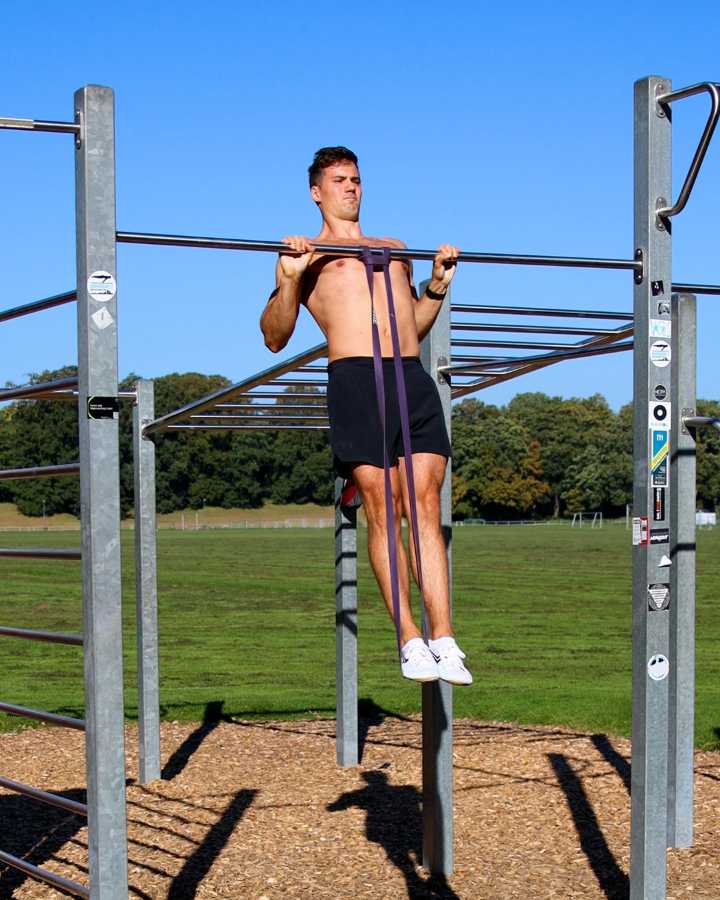
Banded Pull Ups
Band-assisted pull-ups make traditional pull-up training easier by providing support through a resistance band. This exercise is particularly suitable for beginners or individuals looking to build upper body strength before being able to perform unassisted pull-ups. It primarily targets the back and arms. Compared to regular overhand-grip pull-ups, the intensity is reduced, allowing for a focus on proper form. This variation also helps in progressively learning pull-ups, similar to how negative pull-ups serve as a stepping stone to completing full pull-ups.
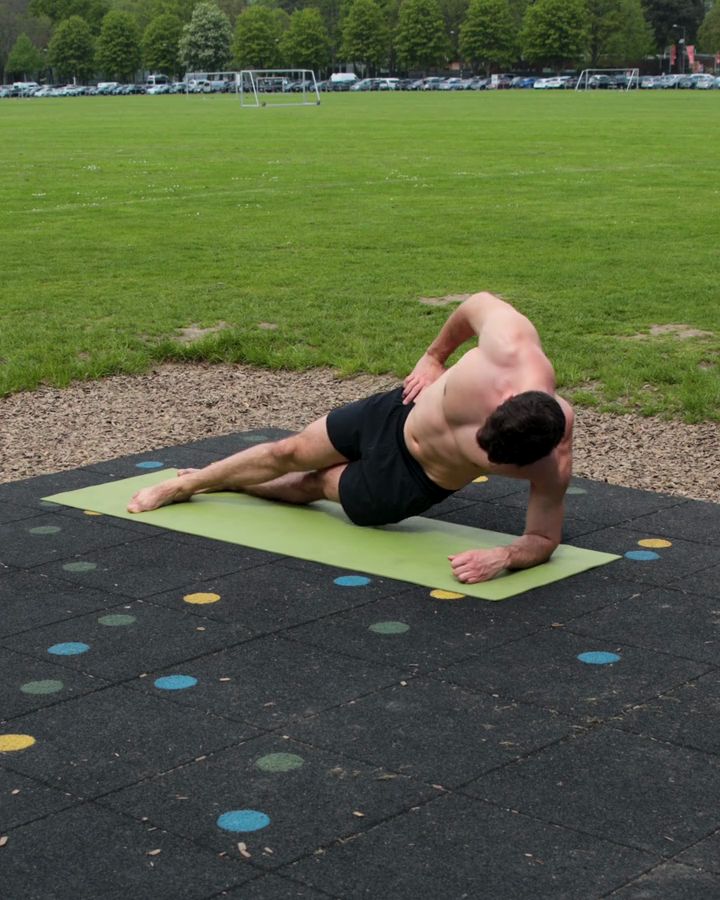
Side Plank Crunches
Side Plank Crunches specifically target the oblique abdominal muscles through lateral flexion, which is the side bending of the spine. They build upon the Static Side Plank Position by adding a dynamic movement. Another dynamic exercise alternative in the side plank position is the Side Plank Rotation.
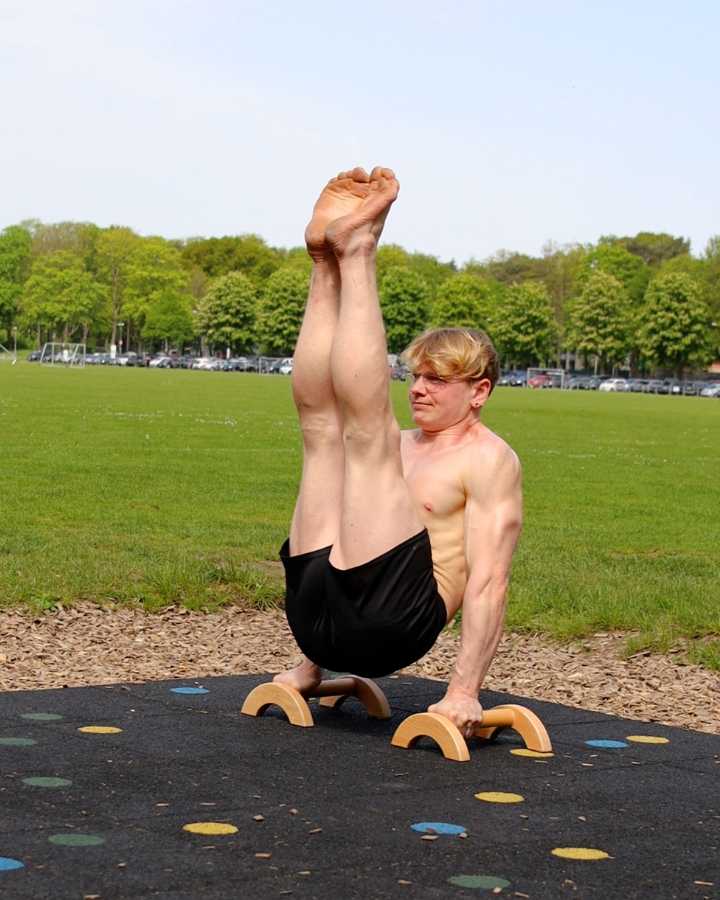
V-Sit with parallettes
The V-Sit is a challenging exercise that requires significant strength in the abdominal muscles, hip flexors, and high flexibility in the hamstrings. The body forms a “V” shape by lifting the legs and upper body off the ground and holding them in the air. This exercise is a more advanced variation of the L-Sit, as it demands greater core tension and flexibility. The V-Sit is often confused with the Boat Pose.
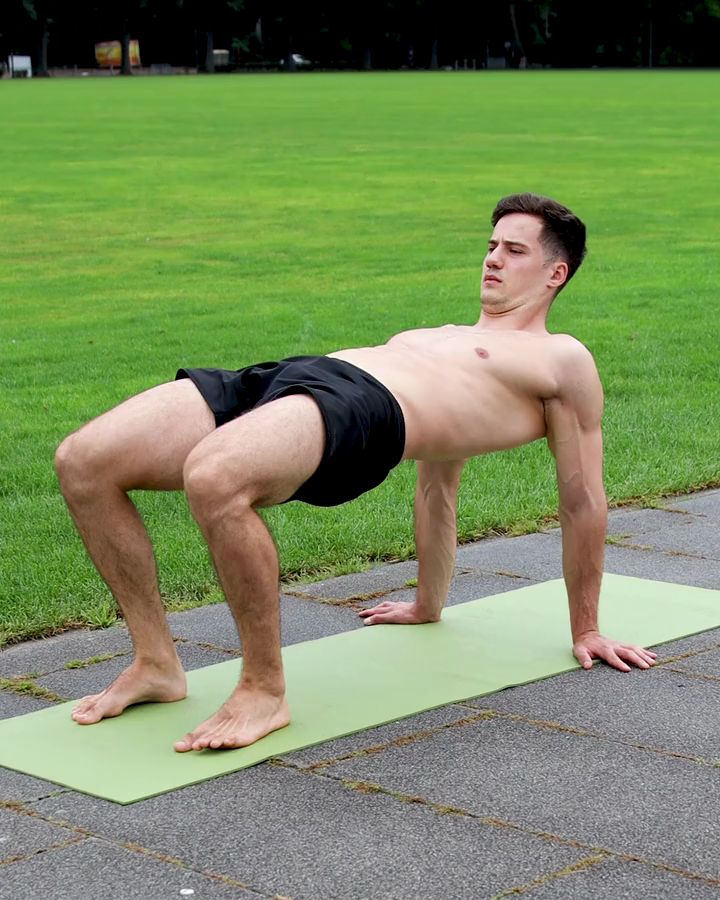
Table Rocks
Table Rocks primarily train the shoulders, triceps, and core while also improving shoulder flexibility. The exercise requires holding the body in a table-like position, similar to an inverted plank, with the hips actively pushed upwards.
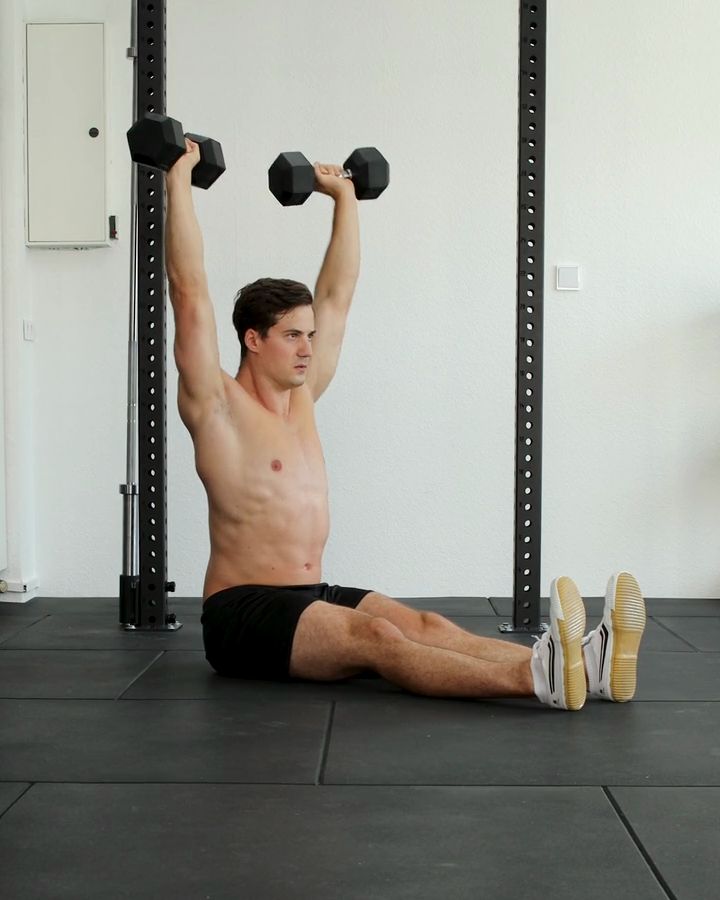
Z Press with dumbbells
The Z press with dumbbells, like the shoulder press or the Arnold press, primarily strengthens the shoulder muscles. You sit flat on the floor and press the dumbbells overhead while keeping your core and abdominal muscles engaged for a stable posture. This exercise also enhances shoulder stability and mobility.
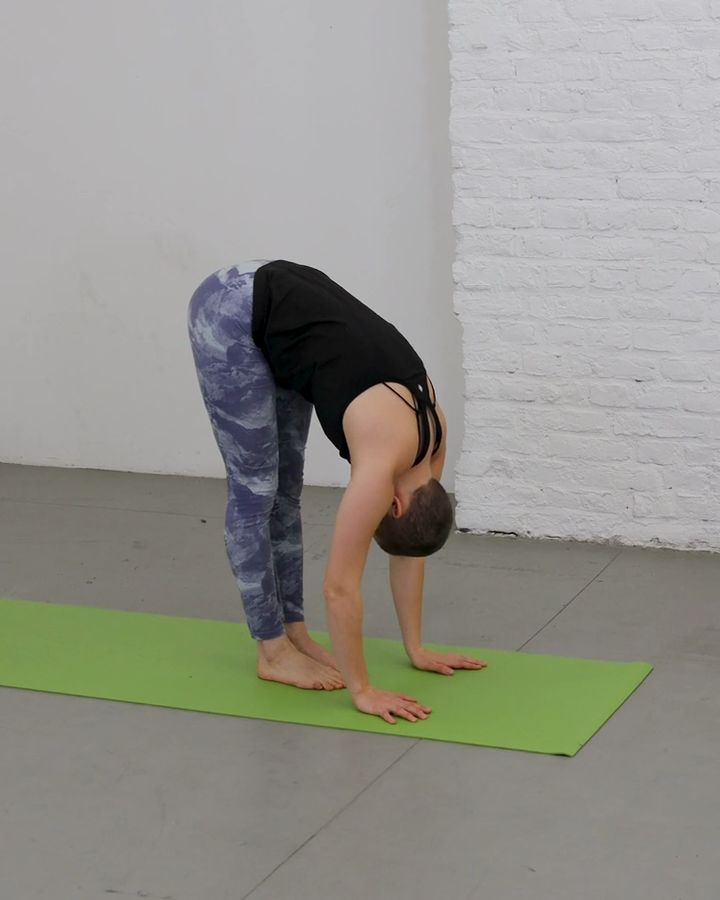
Jefferson Curls
Jefferson Curls are a dynamic exercise that stretches and strengthens the back muscles as well as the hamstrings. By slowly bending the upper body, this exercise improves flexibility and stability in the back. Other exercises that stretch the posterior chain include Good Mornings or the Elephant Walk.
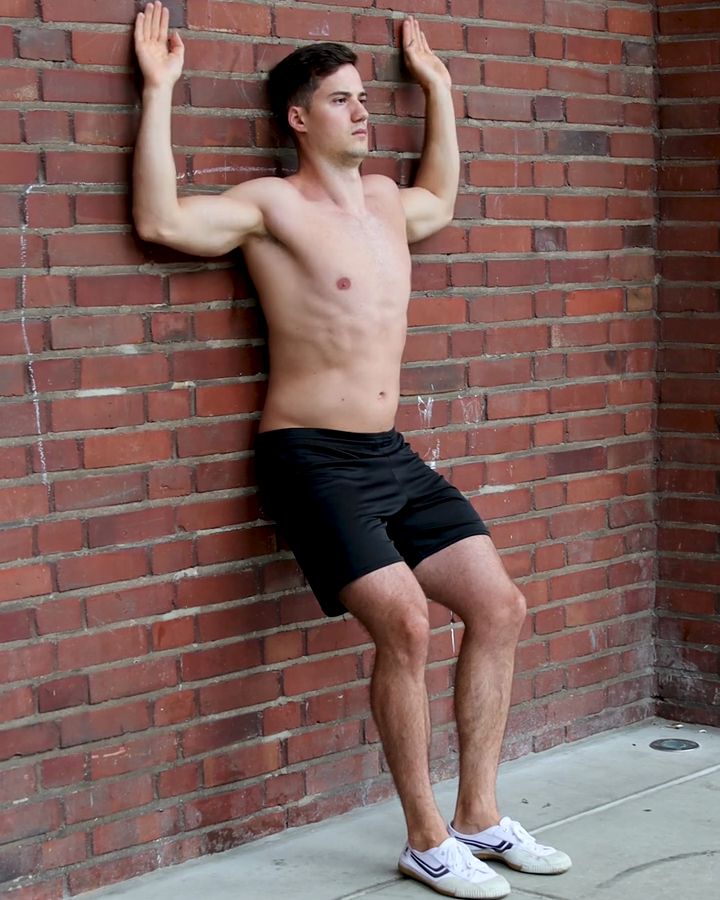
Wall Slides
In Wall Slides, you stand with your back against the wall and move your arms up and down along it. This exercise improves shoulder mobility and is particularly effective for correcting posture. Similar to Wall Slides, Face Pulls also target the shoulders and upper back. In Face Pulls, a cable machine or gymnastic rings are used to pull the hands toward the face.
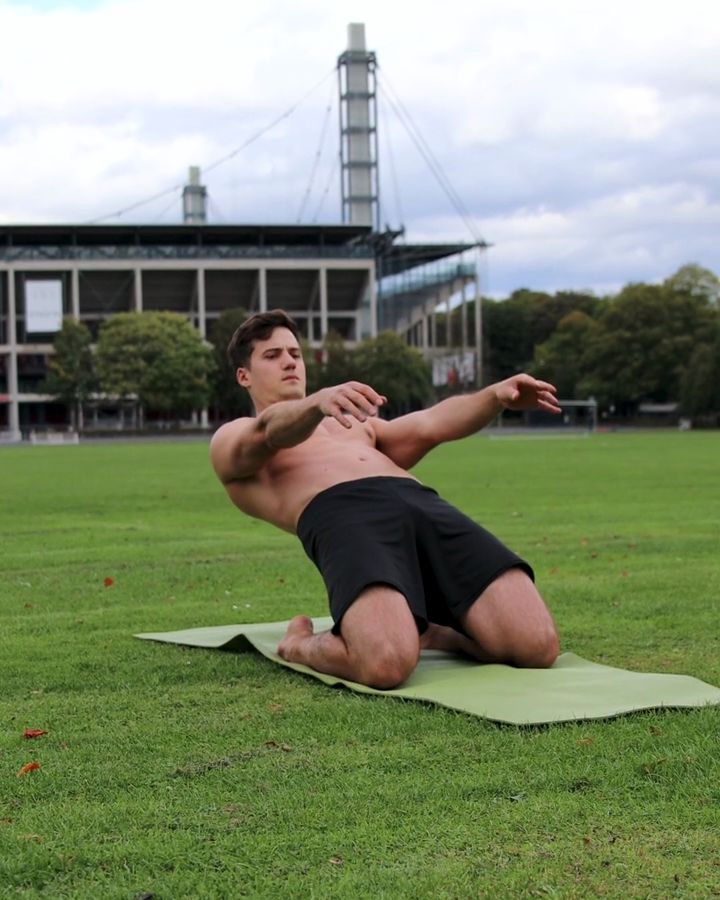
Reverse Nordic
The Reverse Nordic is an effective exercise that primarily strengthens the thigh muscles while simultaneously stretching the hip flexors. In this movement, you kneel on the ground and lean your torso backward in a controlled manner while keeping the hips extended. This requires both strength in the legs and core as well as good hip flexor flexibility. As the counterpart to classic Nordic Hamstring Curls, which focus on the posterior thigh muscles, the Reverse Nordic targets the anterior thigh muscles. While the Reverse Nordic involves leaning the torso backward, the Nordic Hamstring Curls involve leaning forward and controlling the descent. Both exercises complement each other perfectly for a balanced leg workout.
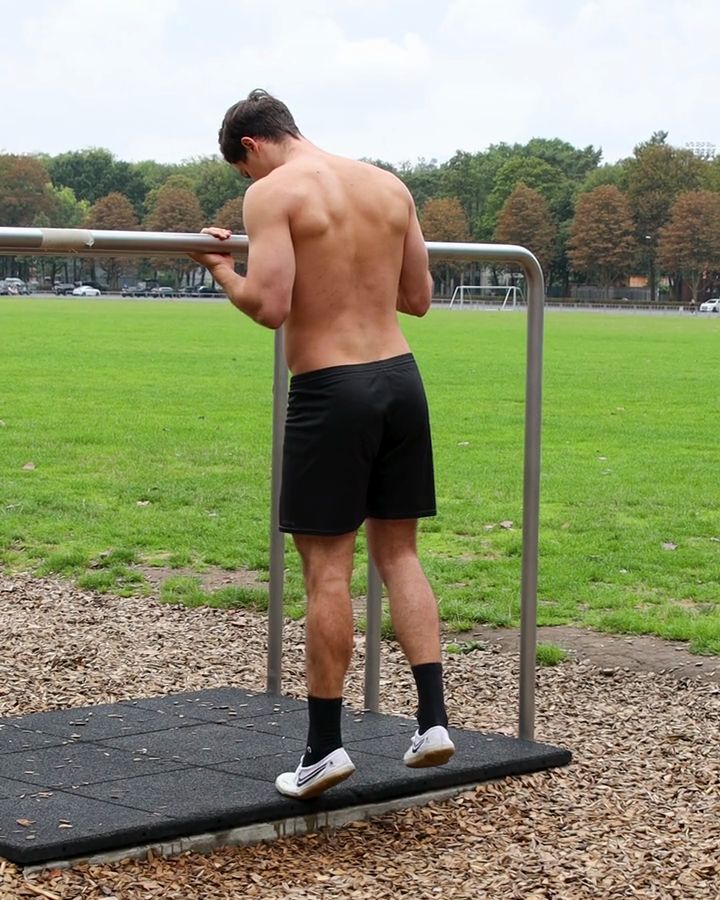
Single Leg Calf Raises
In the single-leg calf raise, you stand on one leg and slowly push your heel upward. This exercise trains your calves and strengthens the stabilizing muscles in the ankle and lower leg. It can be performed on a flat surface or an elevated step to increase the range of motion.
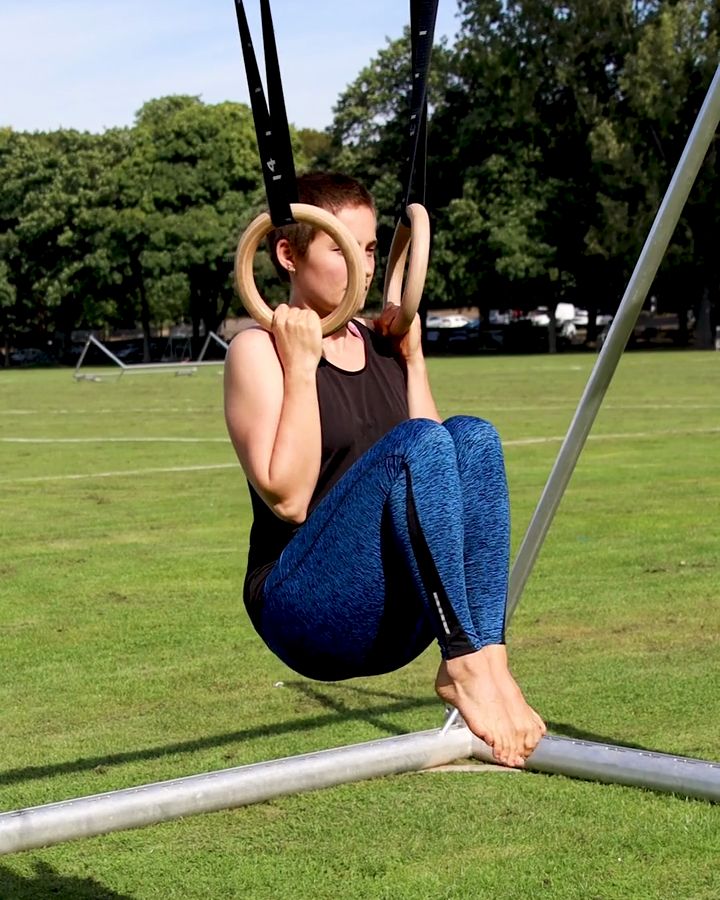
Chin Up Hold with bent legs
The bent-arm hang with bent legs or Pull Up Hold is the top position of a pull-up with the legs pulled up. You hold onto the pull-up bar or gymnastics rings and pull your legs up in a bent position while keeping the upper body stable. This exercise is especially useful for learning the pull-up or specifically addressing weaknesses in the upper part of the pull-up movement.
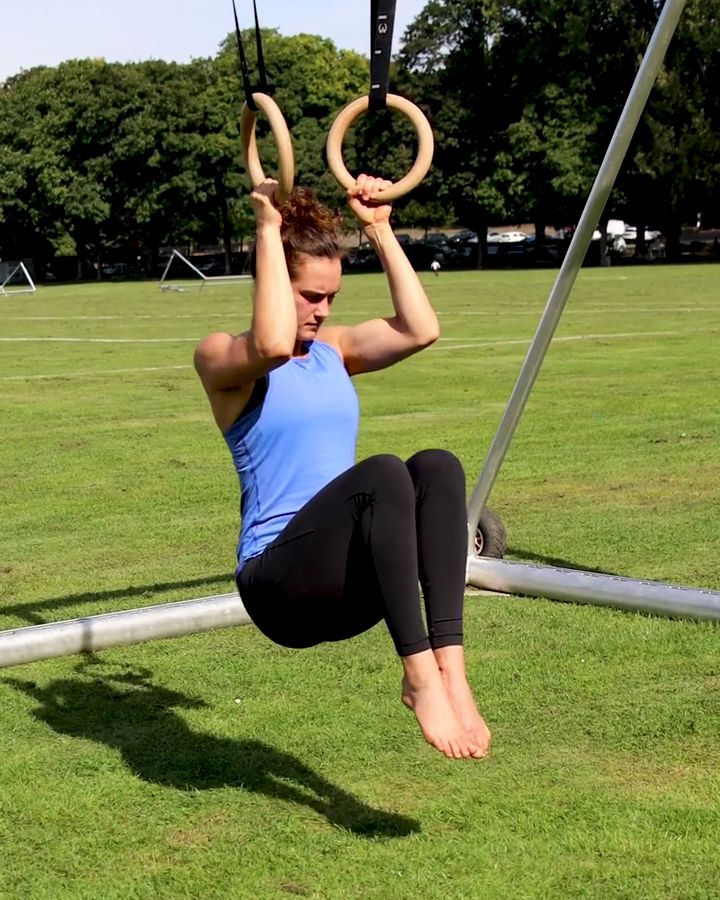
Negative Chin Ups with gym rings
Negative pull-ups on gymnastics rings are an effective exercise for the back and biceps. The focus is on the eccentric phase of the movement, meaning the slow lowering of the body. This exercise helps build strength and is useful for learning normal chin-ups.
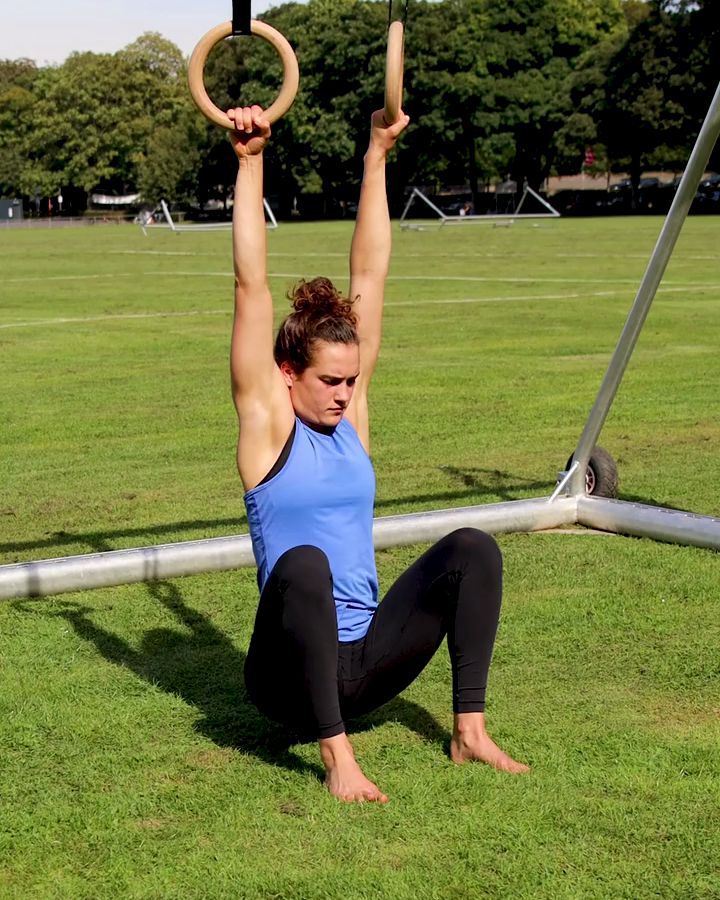
Assisted Pull Ups
Assisted Pull Ups on the gymnastic rings target the upper arm and back muscles. In this exercise, you grab the rings and pull yourself up while keeping support with your feet on the ground. This makes the movement easier and helps to develop the technique and strength needed for the first Pull Ups.
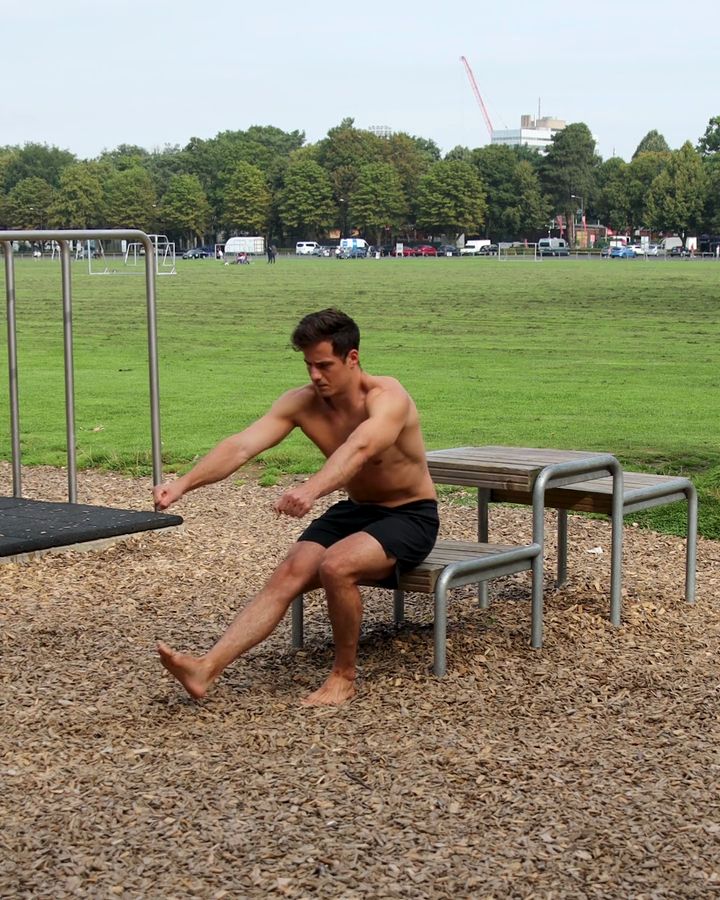
Pistol Squat To Box
Pistol Squats to Box, or Sit Downs, are a progression exercise of the Pistol Squat, aimed at strengthening the leg muscles, especially the quadriceps and glutes. In this exercise, a one-legged squat is performed in front of a box or bench, allowing you to sit down at mid-height. The raised surface reduces the range of motion, making the exercise easier for beginners. Other progression exercises for the Pistol Squat with similar intensity include Assisted One-Legged Squats and Negative One-Legged Squats.
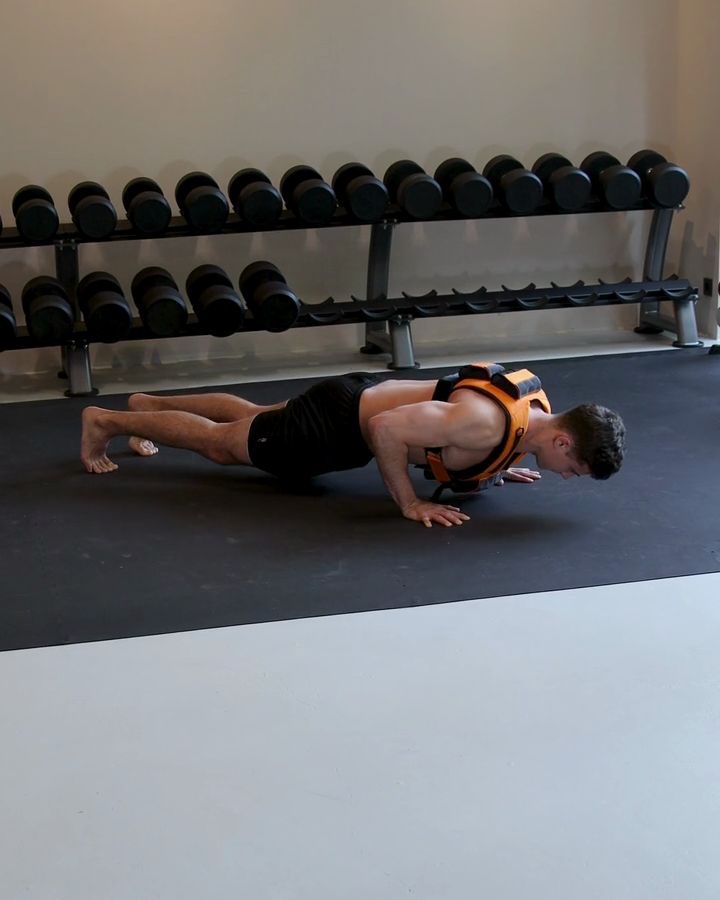
Weighted Push Ups
The weighted push-up is an advanced variation of the classic push-up. In this exercise, additional weight, such as a weighted vest or a plate, is placed on the back to increase the intensity of the workout.
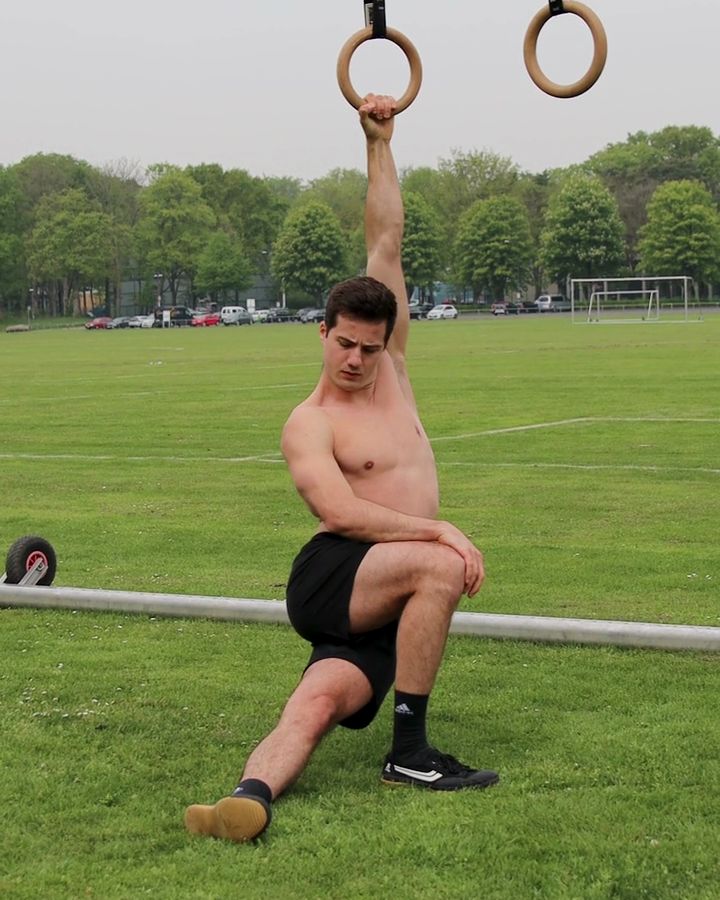
Lat Stretch with gym rings
The lat stretch on the gymnastic rings is an effective exercise for mobilizing and stretching the back muscles, especially the latissimus. In this stretch, you hold onto the rings with your hands and gently lower your upper body, creating a strong pull in the side muscles of the back. This stretch works well as part of a cool-down routine or for recovery after intense strength exercises like pull-ups or rowing.
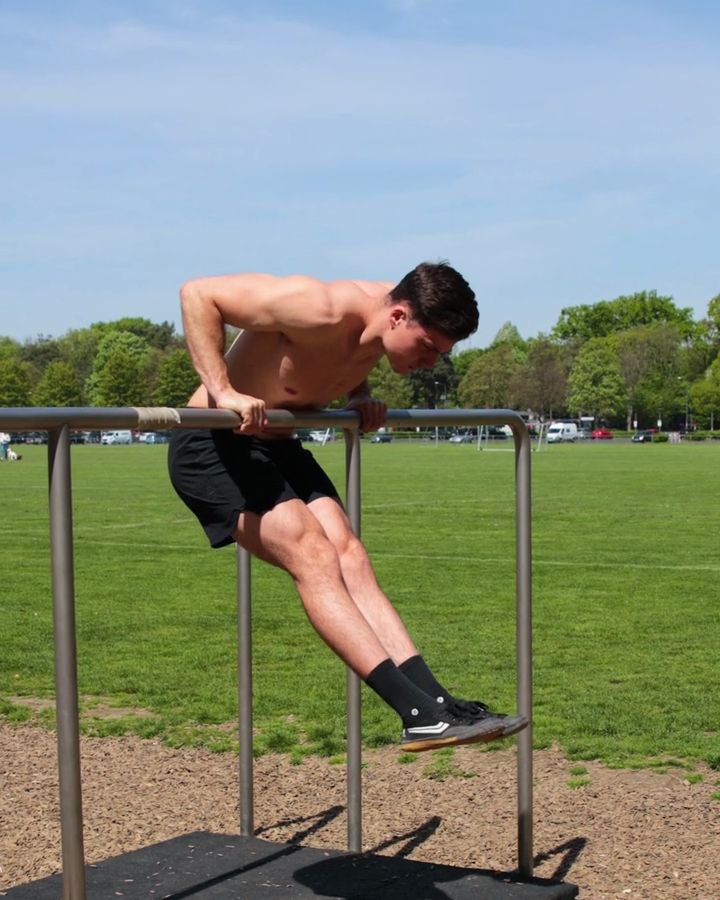
Straight Bar Dips
Straight bar dips are a challenging dip variation performed on a straight bar instead of parallel bars. This exercise primarily targets the chest, shoulders, and triceps. Compared to parallel bar dips, the straight bar requires a greater forward lean of the upper body and allows for a smaller range of motion. Straight bar dips are not only a standalone exercise but also play a key role in learning the bar muscle-up. During the transition, the body moves from the pulling phase (pull-up) into the dip, placing significant demand on the chest, shoulders, and triceps. A common challenge is "getting stuck" in the transition phase. Mastering straight bar dips and explosive pull-ups provides a solid foundation to overcome this difficult part of the muscle-up transition.
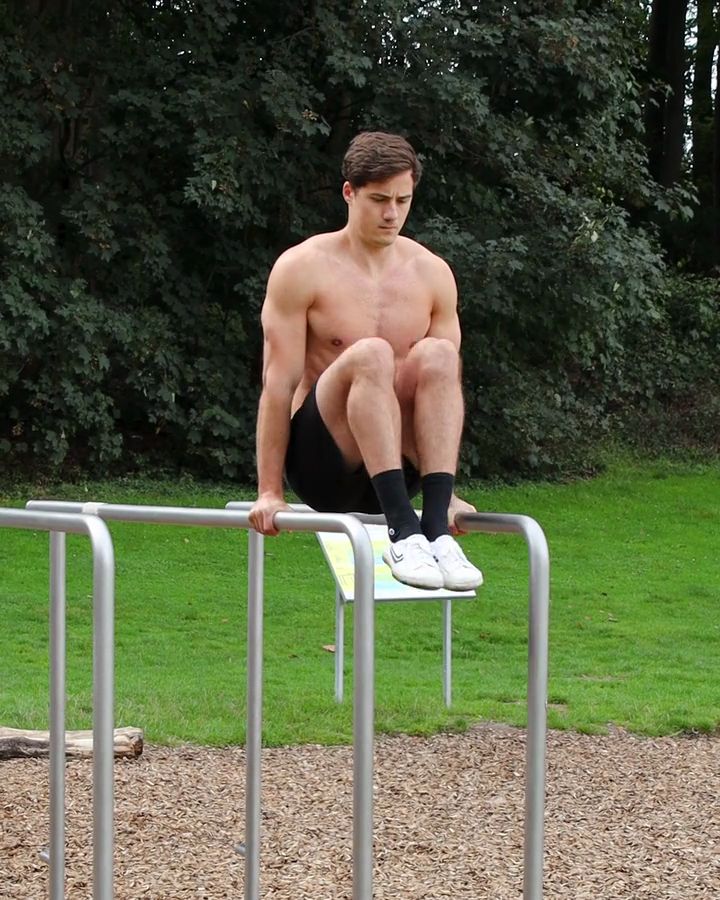
Knee Raises on parallel bars
Knee raises primarily train the abdominal muscles and hip flexors, similar to the L-Sit or leg raises. During the exercise, the knee is pulled up to the chest while keeping the upper body upright. This exercise can be performed while standing or hanging from a pull-up bar. Knee raises can be done with different equipment. In the parallel bars variation, the arms stabilize the body, which intensively engages the shoulder and core muscles.
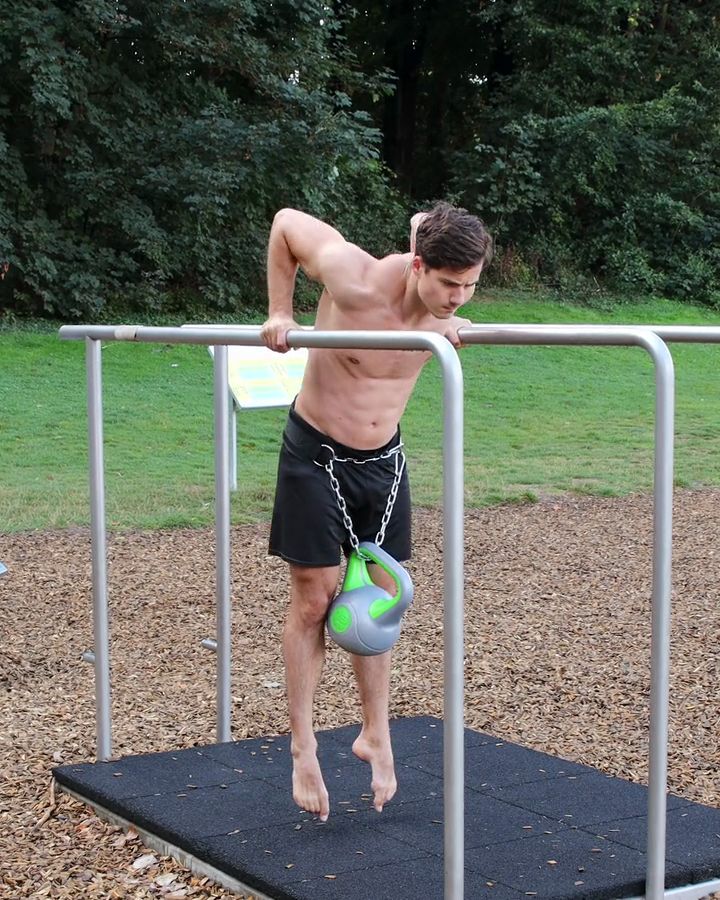
Weighted Dips
Weighted dips are an intense variation of classic dips, where additional weight is used to increase the resistance. They primarily target the chest muscles, triceps, and front shoulders. Compared to regular dips, they offer a greater challenge, making them especially suitable for advanced athletes looking to achieve more muscle growth and strength. The extra weight is often added using a [weight belt](https://shop.dieringe.com/products/dip-gurtel) with weight plates or kettlebells. Weighted dips are a great addition or progression from classic dips and can also serve as an alternative to bench press, providing a different angle to work the upper body.
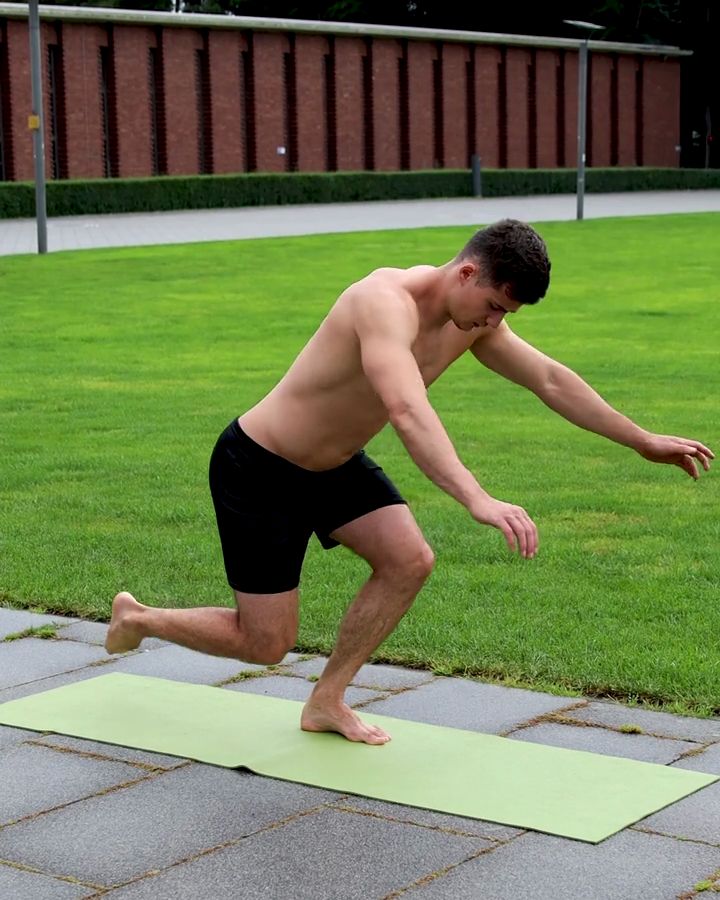
Skater Squat, Shrimp Squat
The Skater Squat, also known as the Shrimp Squat, is an effective single-leg exercise for strengthening the quadriceps, glutes, and stabilizing muscles. You stand on one leg while the other is moved backward and bent. The goal is to lower the back knee toward the ground in a controlled manner without touching the foot down and then stand back up. This exercise improves strength, balance, and coordination and is a joint-friendly alternative to Pistol Squats since it puts less stress on the knee. If you have trouble with balance, you can hold onto a wall or railing at first.
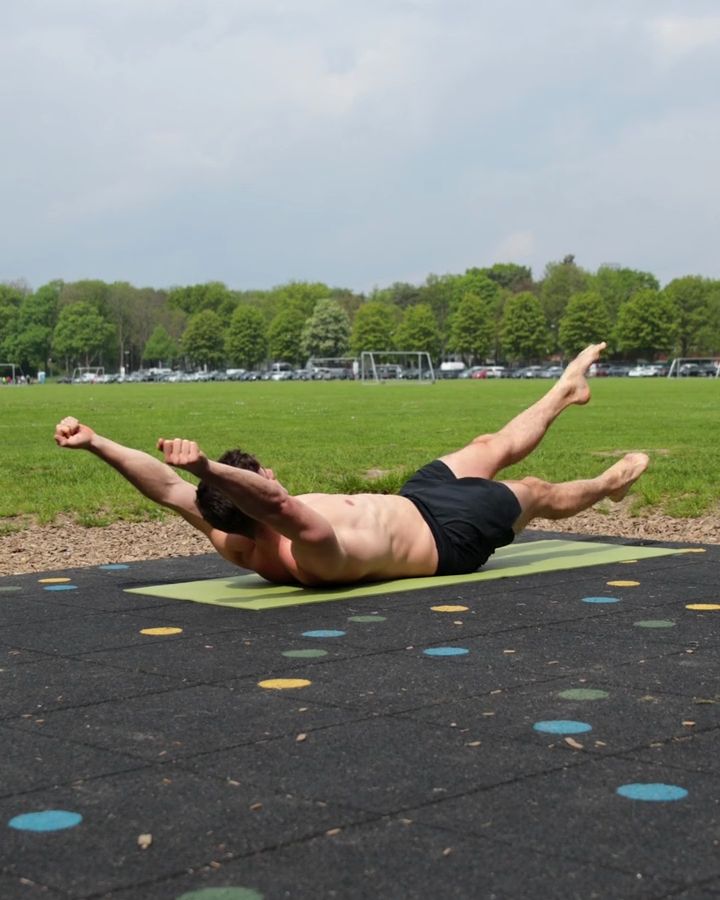
Scissor Kicks
Scissor kicks primarily train the abdominal muscles and hip flexors. This exercise is performed while lying on your back, alternately lifting the legs. It is important to keep the lower back pressed against the floor. Scissor kicks complement a range of abdominal exercises that can be performed in a supine position without equipment, such as the V-Ups Hold, Leg Raises, and the Hollow Body Hold.
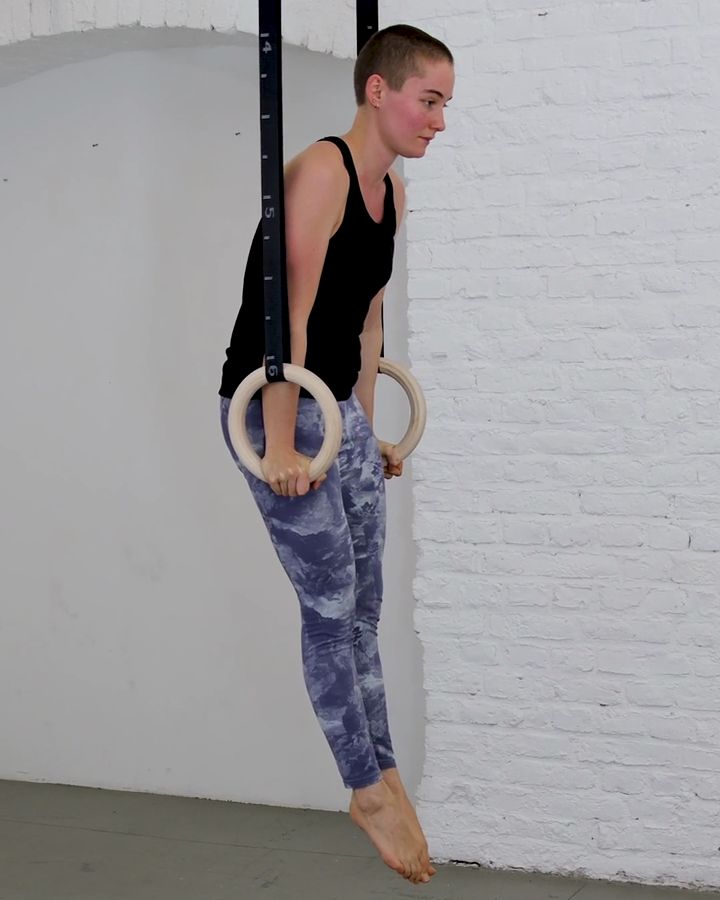
Support Hold on Gymnastic Rings
The Support Hold on the gymnastic rings engages the entire upper body, especially the chest, back, and shoulders. Due to the instability of the rings, it requires more strength and body tension than the Parallel Bars Support Hold. According to this [study](https://dieringe.com/de/blog/ringe-vs-barren), muscle activity in the chest and back muscles is higher on the rings, while the Parallel Bars Support Hold places more demand on the trapezius muscle.
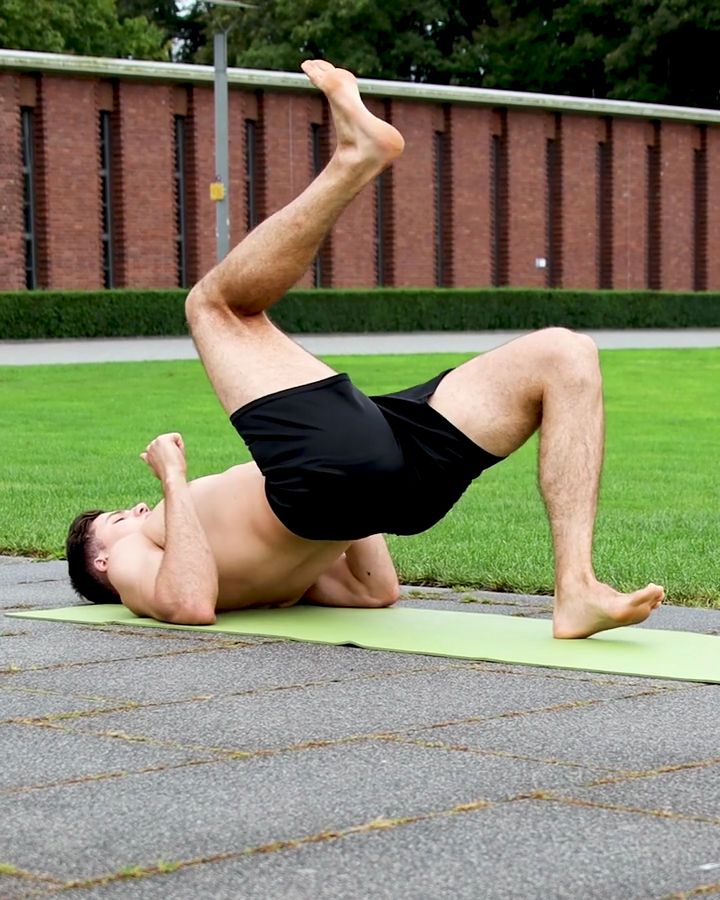
One Leg Hip Thrusts
Single-leg hip thrusts are a variation of the classic hip thrust where only one leg is used to push the hips upward. This exercise specifically strengthens the glute muscles, lower back, and hamstrings. The single-leg movement also improves stability and balance, as each side works independently. Compared to regular hip thrusts, this variation provides a more intense load per leg and is great for correcting muscular imbalances. To increase the muscular load without focusing on imbalance, the weighted hip thrust is a good option.
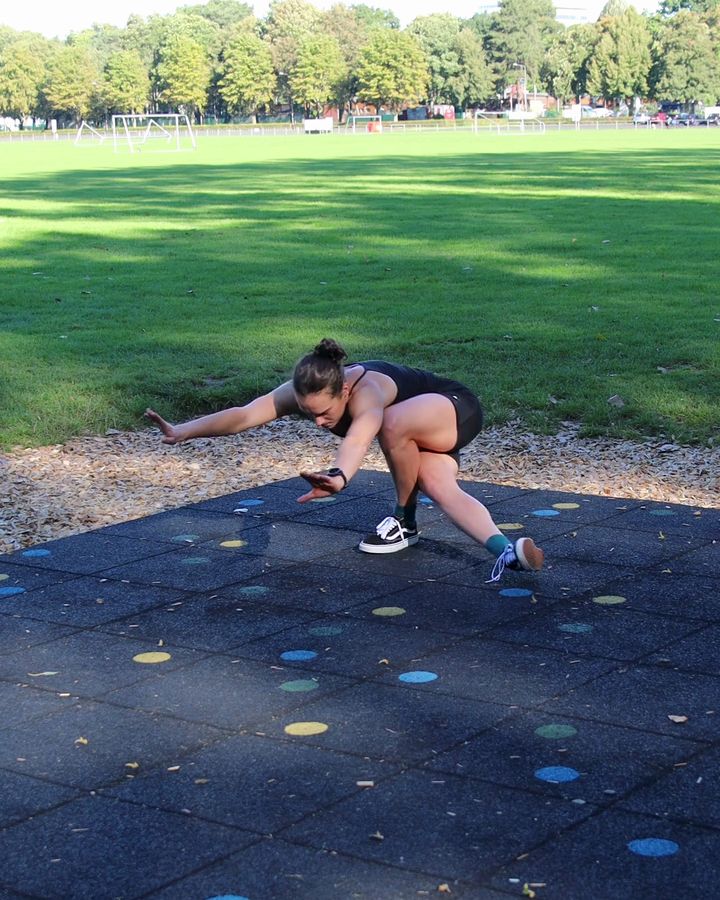
Dragon Squats
Dragon squats, similar to the Pistol Squat, are an advanced exercise that primarily strengthens the glutes, thighs, and core. In this movement, one leg is crossed behind the standing leg as the body lowers into a squat. This exercise promotes balance, stability, and mobility in the hips and ankles.
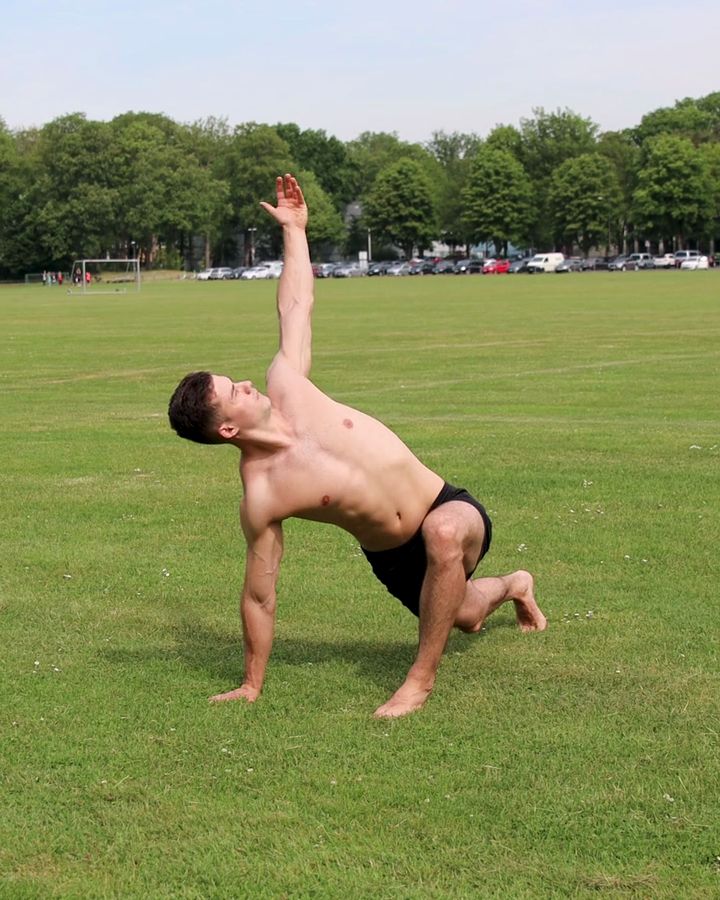
Worlds Greatest Stretch
The "World's Greatest Stretch" is a dynamic mobility and warm-up exercise that targets multiple muscle groups at once. It combines stretches for the hips, hamstrings, spine, and shoulders. This movement enhances flexibility and mobility by activating the entire body. This exercise is especially recommended for athletes and fitness enthusiasts.
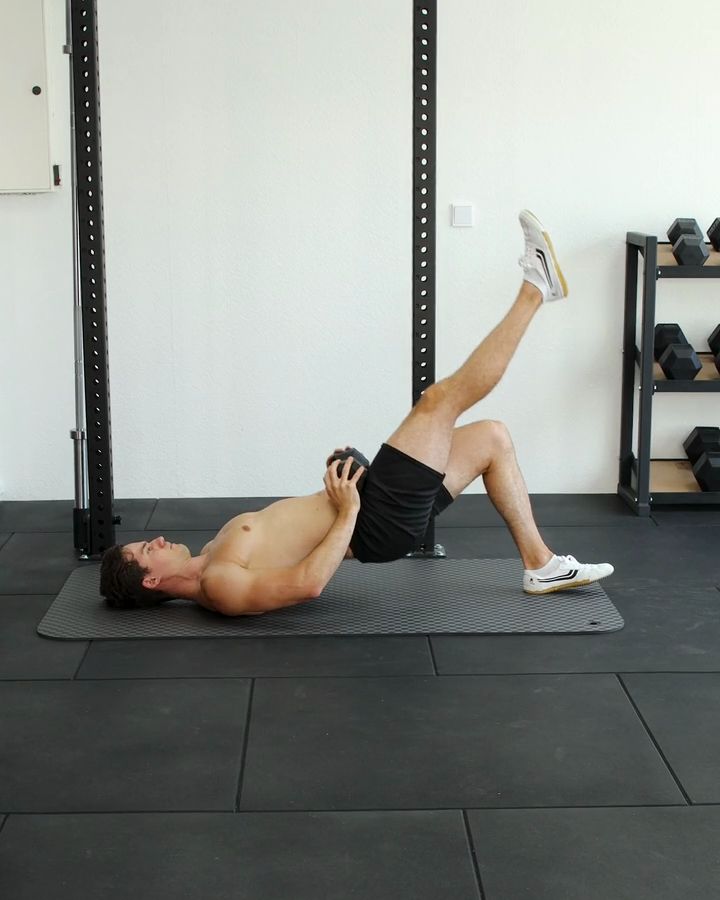
Single Leg Hip Thrusts with a dumbbell
Here's a refined version of the English translation: Single-leg hip thrusts with weight, typically done with a dumbbell, primarily target the glutes, hamstrings, and lower back. The upper back is supported on a bench or the floor, with a dumbbell placed on the hips while one leg is lifted off the ground. This unilateral exercise enhances stability and helps correct muscle imbalances between the legs. It requires good balance and core engagement to ensure proper form. Alternatively, the exercise can be performed as a Hip Thrust without Dumbbell.
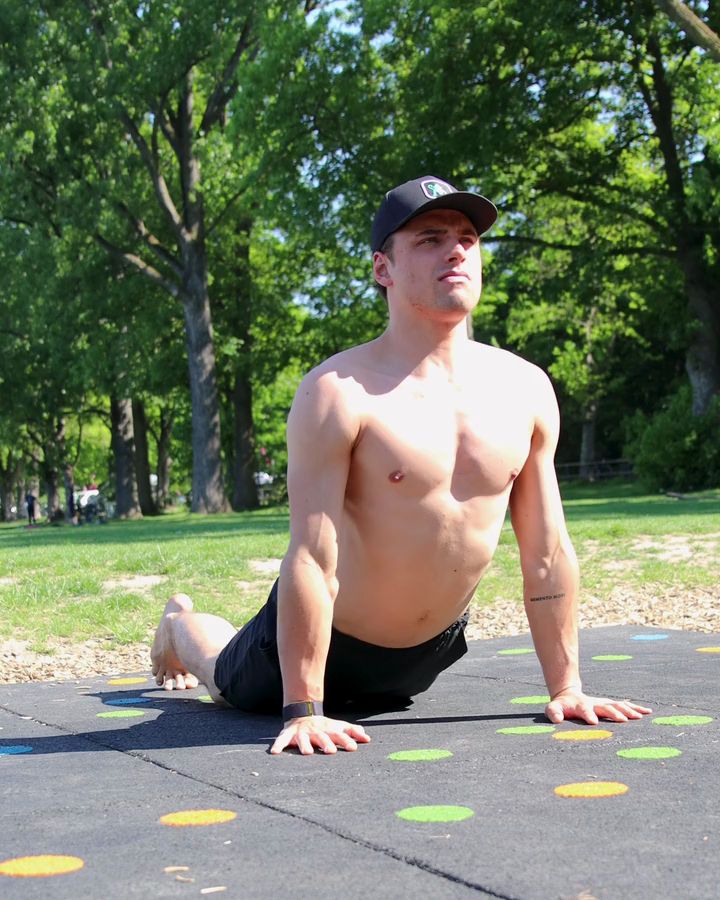
Hindu Push Ups
Hindu Push-Ups are a dynamic variation of the classic push-up. They target the chest, shoulder, and triceps muscles while incorporating fluid movements that also engage the lower back and core muscles. Hindu Push-Ups improve both flexibility and strength, as they combine elements of strength training with mobility exercises.
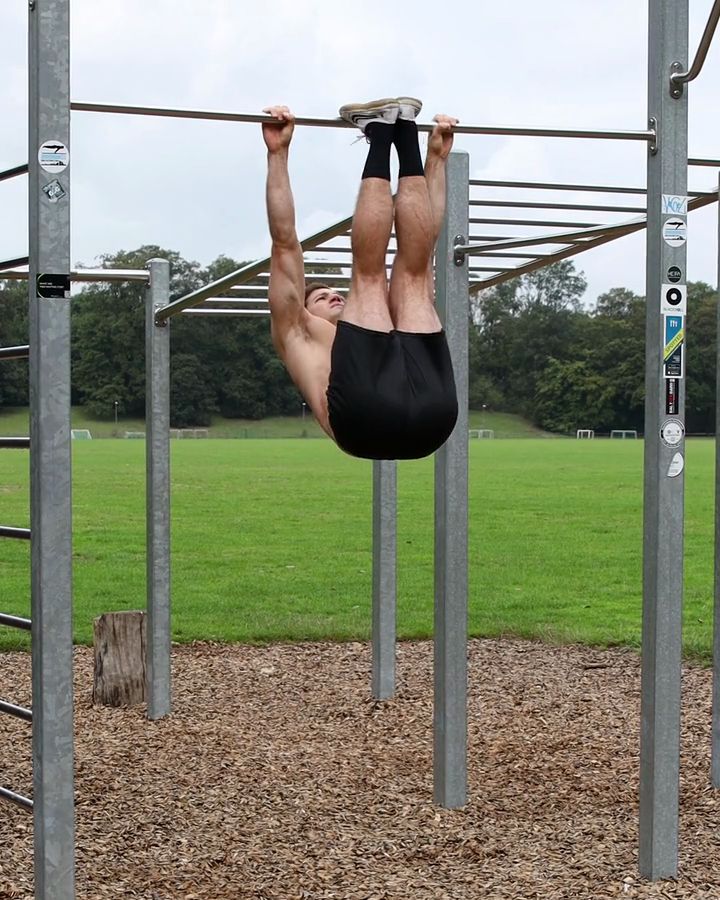
Toes To Bar
Toes to Bar is a dynamic exercise performed on a pull-up bar where the legs are swung upward from a hanging position until the toes touch the bar. In German, this exercise is also called "Anristen." It can also be performed on gymnastic rings, which offers advantages, such as allowing the toes to move further past the line of the pull-up bar, which can be helpful for transitioning into a Skin the Cat. Similar to the hanging leg raise, this exercise specifically targets the lower abdominal muscles. Additionally, it engages the hip flexors and improves grip strength.
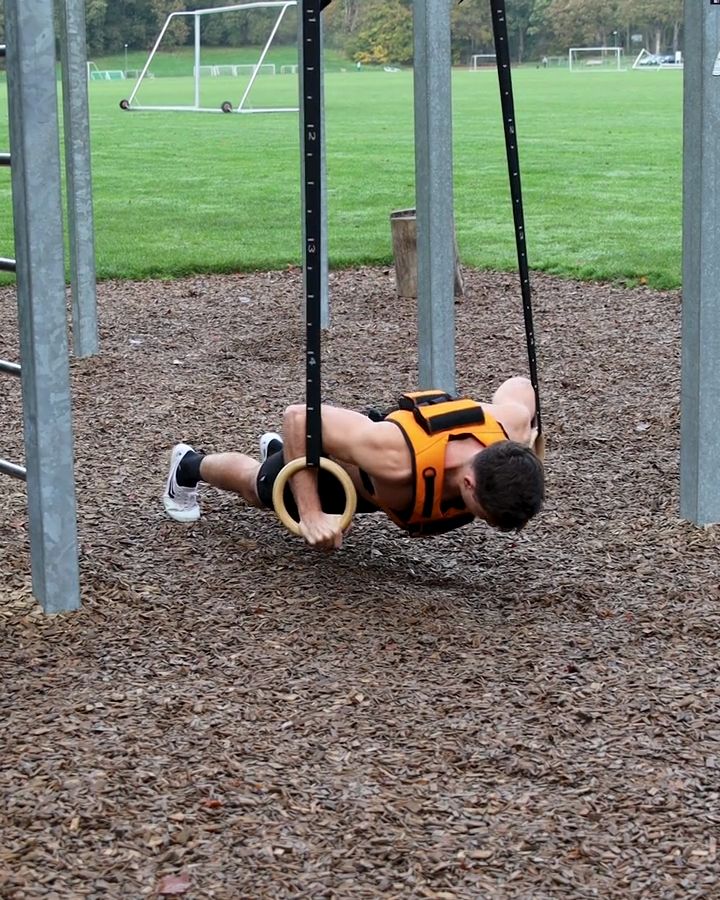
Weighted Ring Push Ups
Weighted push-ups on gymnastic rings are one of many variations in the push-up family. In addition to the chest, shoulders, and triceps, this exercise also places a greater emphasis on the core and the entire stabilizing musculature. The rings allow for an individualized width and grip position, which is very comfortable for the shoulders. Additionally, due to the instability, smaller muscle groups have to work harder to keep the body stable. This variation is a direct progression of the regular weighted push-ups.
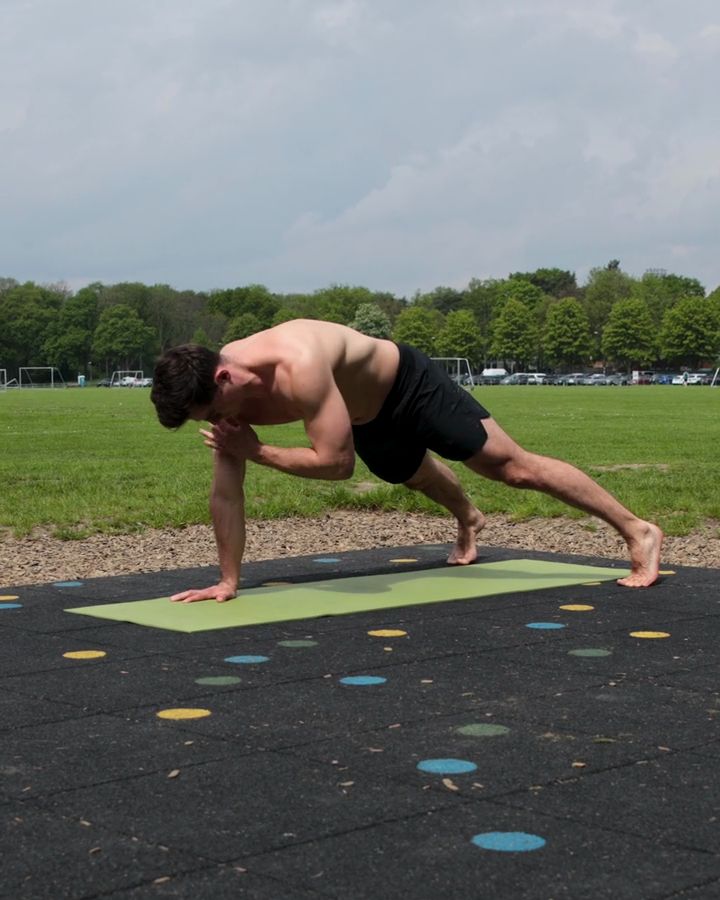
Push Up Shoulder Taps
Shoulder Tapping is an exercise that strengthens the upper body, especially the core, shoulders, and arms. During the exercise, you hold a static push-up position and tap the opposite shoulder with one hand. This challenges balance and stability in the core.
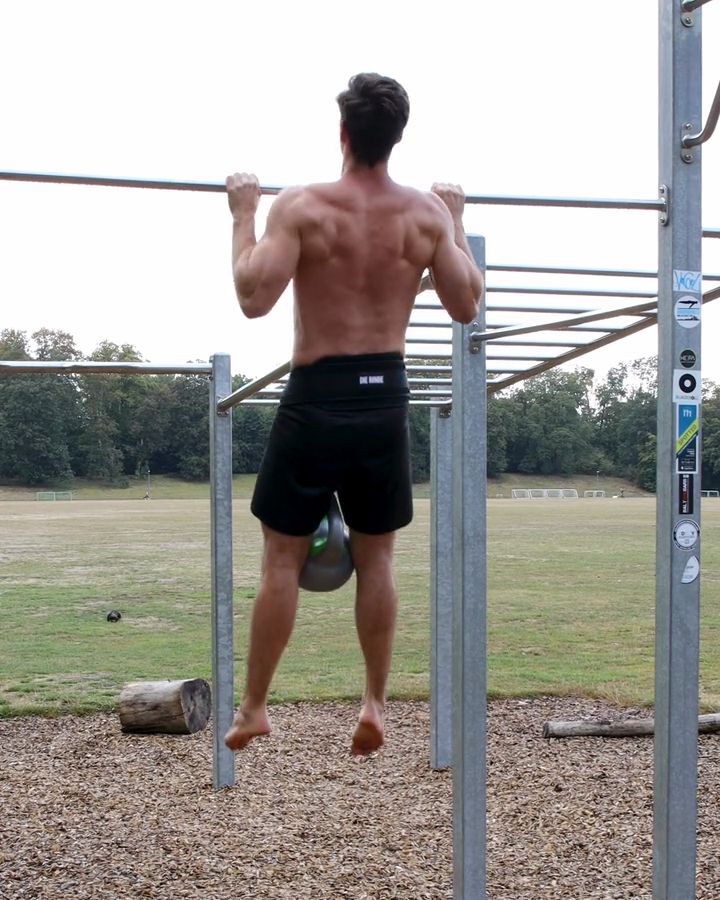
Weighted Pull Ups
Weighted pull-ups with an overhand grip (palms facing forward) intensify the classic pull-up by adding extra weight to specifically train the upper back, latissimus, and biceps. They are an ideal progression from regular overhand grip pull-ups on the bar, allowing you to gradually increase the load and challenge the muscles further. While there are slight differences in muscle engagement between weighted chin-ups and weighted pull-ups—differences even confirmed in studies—they’re minimal enough that they hardly matter for most people, unless you have ambitious bodybuilding goals. Both exercises activate muscles in similar ways: chin-ups engage the biceps and chest slightly more, while pull-ups work the lower trapezius a bit more. Bottom line: both versions are great for building a strong back. But if you aim to learn the bar muscle-up, the weighted pull-up is the better choice!
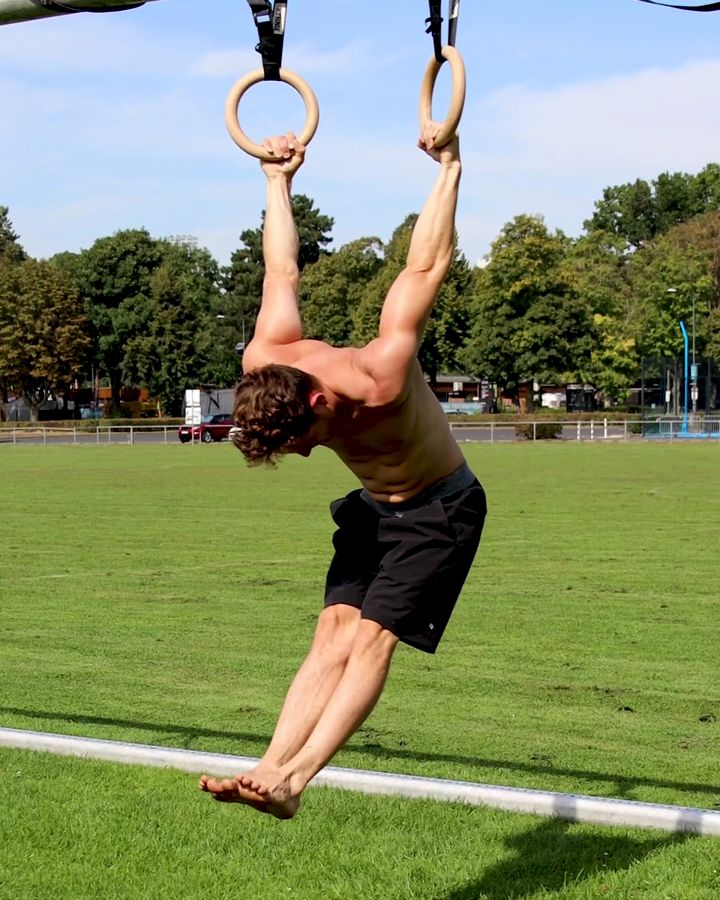
Skin The Cat with gym rings
"Skin the Cat" is a full-body exercise that promotes shoulder mobility and trains upper body strength, particularly in the back, abdominal, and shoulder muscles. For this exercise, you hang from a bar or rings and slowly rotate your body through your arms until your hips are above your shoulders. It can be seen as an extension of the Toes to Bar or Toes to Rings, as it requires not only lifting the legs but also a complete body rotation, demanding greater flexibility and control. The name "Skin the Cat" likely originates from the English expression "there's more than one way to skin a cat," which roughly means that there are different ways to achieve a goal. In gymnastics terminology, the phrase refers to overcoming an obstacle by turning or "skinning" the body through a tight movement.
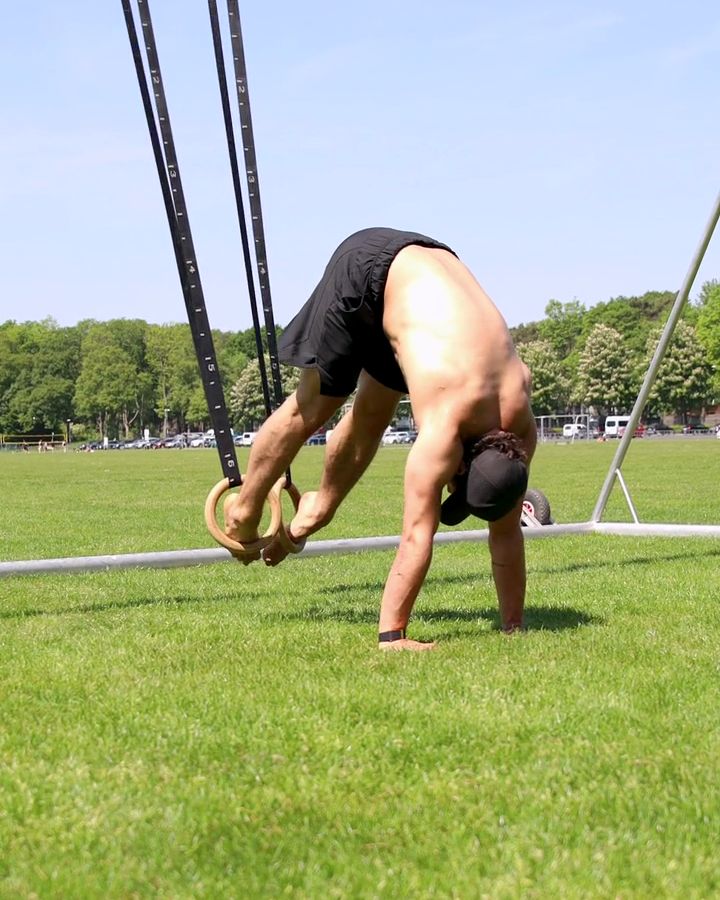
Ring Pike Ups
Ring pike ups with your feet in the gymnastic rings are a challenging exercise that heavily engages the abs, shoulders, and core. During the movement, you lift your hips upwards while keeping your legs straight, so that your body forms an inverted V-position. The instability of the rings further challenges the stabilizing muscles, especially in the shoulders and core, to maintain balance. This variation is a progression from regular pike ups and enhances your body tension.
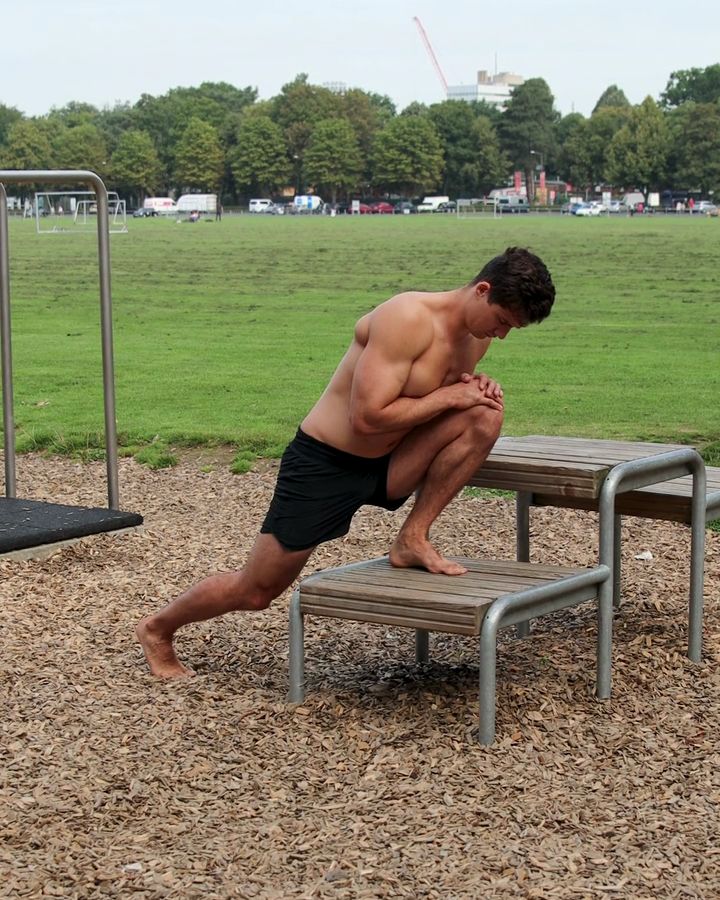
Ankle Stretch
This ankle mobility exercise helps improve your dorsiflexion. As a result, you can push your knee further over your toes, which is crucial for exercises like Squats or Pistol Squats. Limited ankle mobility is often the reason why many people struggle to perform certain exercises correctly. That’s why it’s beneficial to include this exercise in your warm-up or cool-down to ensure you have the necessary mobility for your training.
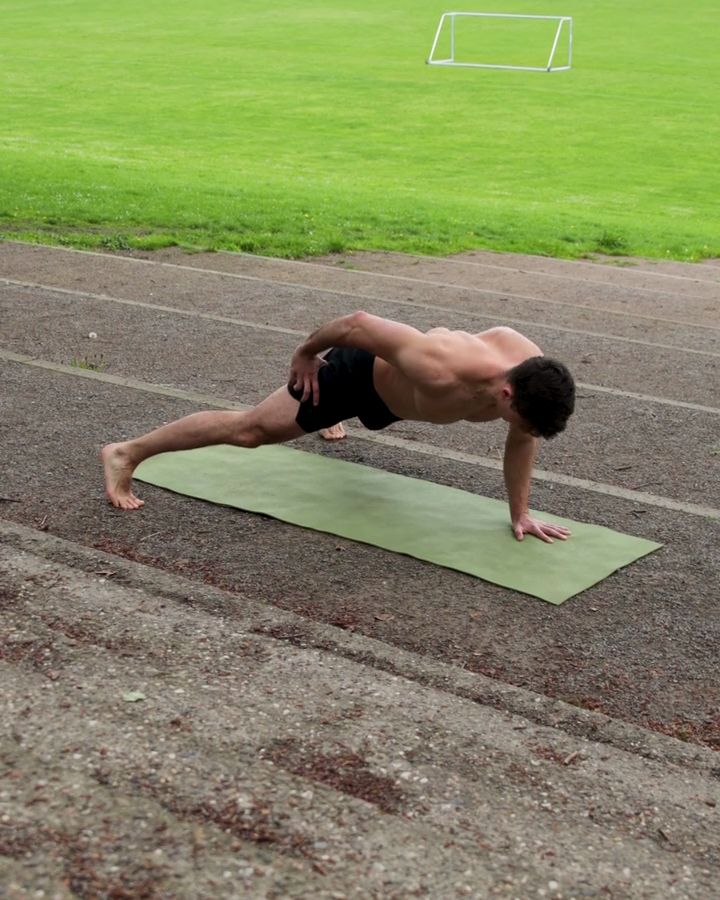
One Arm Push Ups
One Arm Push Ups are a challenging variation of the classic push-ups that require more strength and balance. They primarily train the chest, shoulders, and triceps, but also place a greater demand on the core for stabilization. This exercise is considered a top-level skill because it requires advanced strength and full-body control.
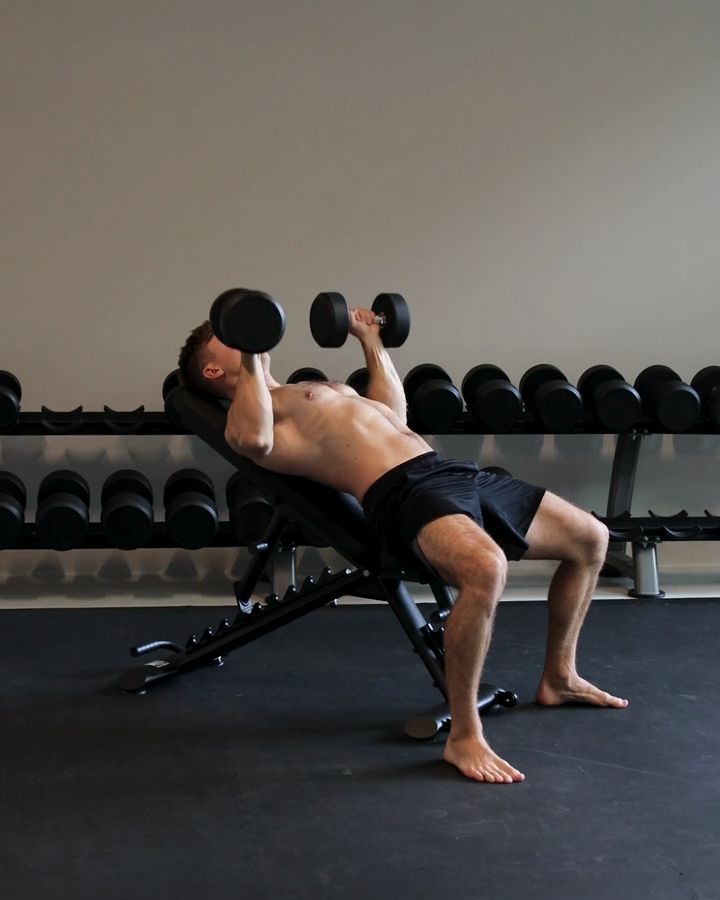
Incline Bench Press with dumbbells
Dumbbell pressing on the incline bench is an excellent exercise for specifically strengthening the upper chest muscles. The slightly inclined position of the bench places more emphasis on the upper part of the pectoral major, while the shoulders and triceps also actively contribute. This exercise is a variation of the classic flat bench press and is an ideal addition to achieve balanced chest muscle development. Compared to incline pressing with a barbell, using dumbbells allows for a greater range of motion and promotes symmetrical muscle growth, as each side has to work independently.
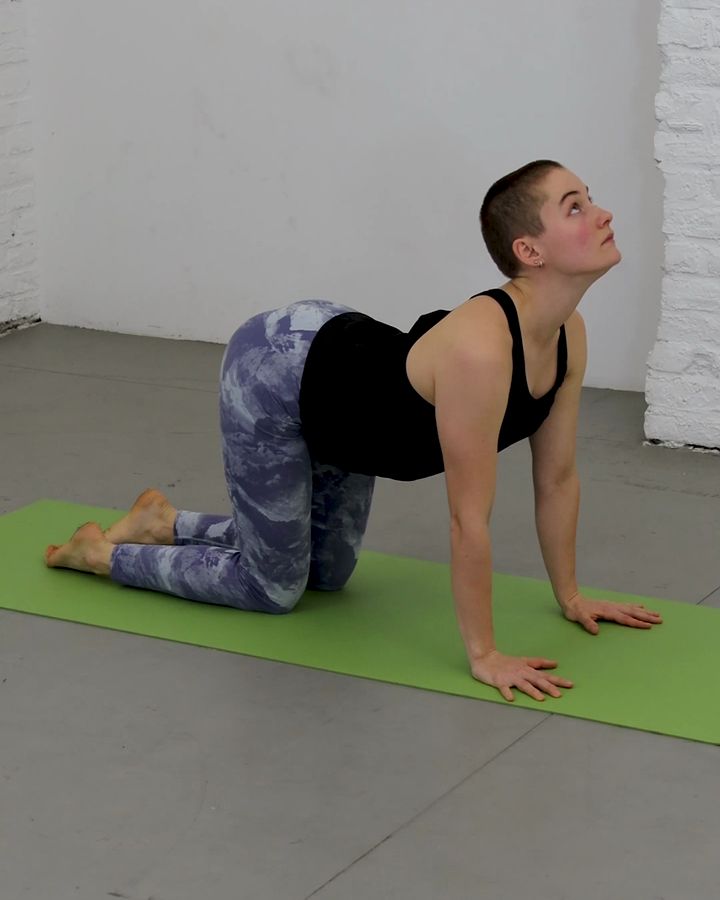
Cat Cow
Cat-Cow is a popular yoga exercise that mobilizes and stretches the back. It helps to mobilize the spine and improve back flexibility. The exercise alternates between the Cat and Cow positions.
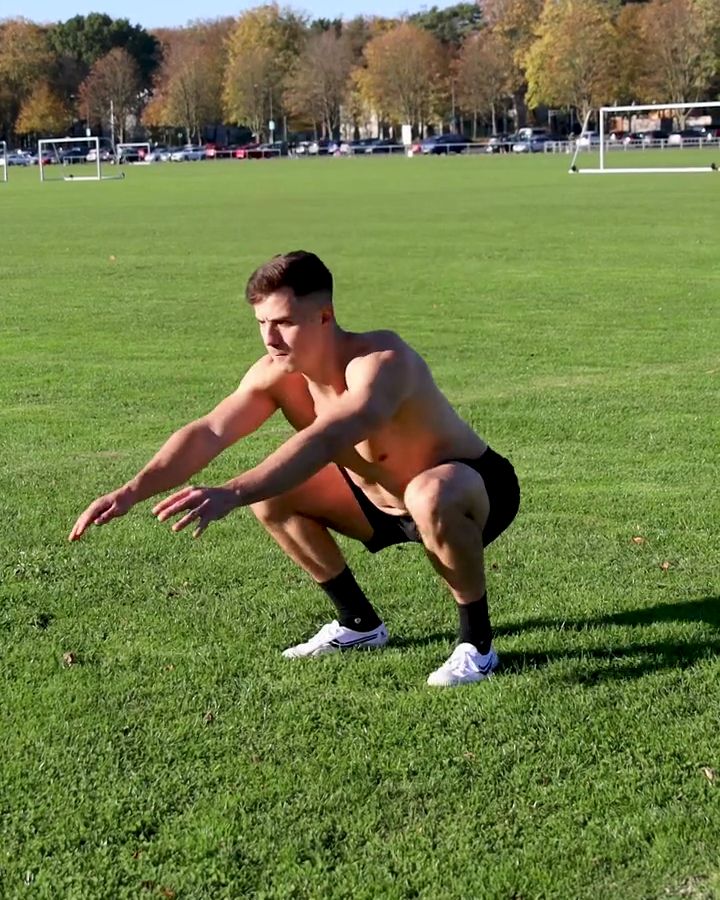
Jumping Squats
Jumping squats primarily train the muscles in the legs and glutes. This exercise is similar to a normal squat, but it includes an explosive jump in the movement.
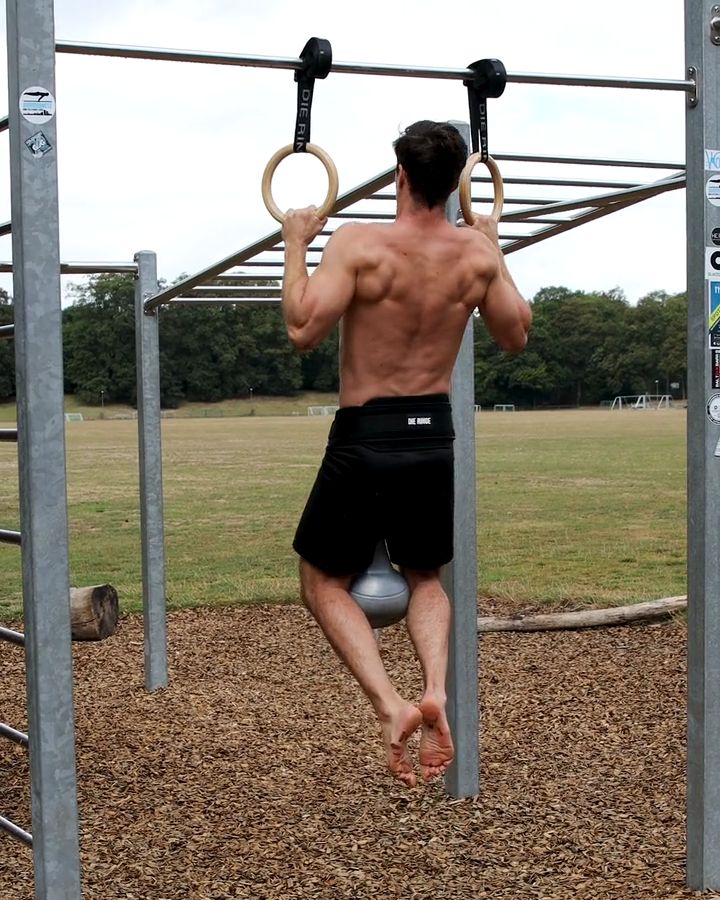
Weighted Ring Pull Ups
Weighted Ring Pull Ups are a challenging exercise for strengthening the upper body muscles, primarily working the back and biceps. The added weight increases the intensity compared to the classic pull-up.
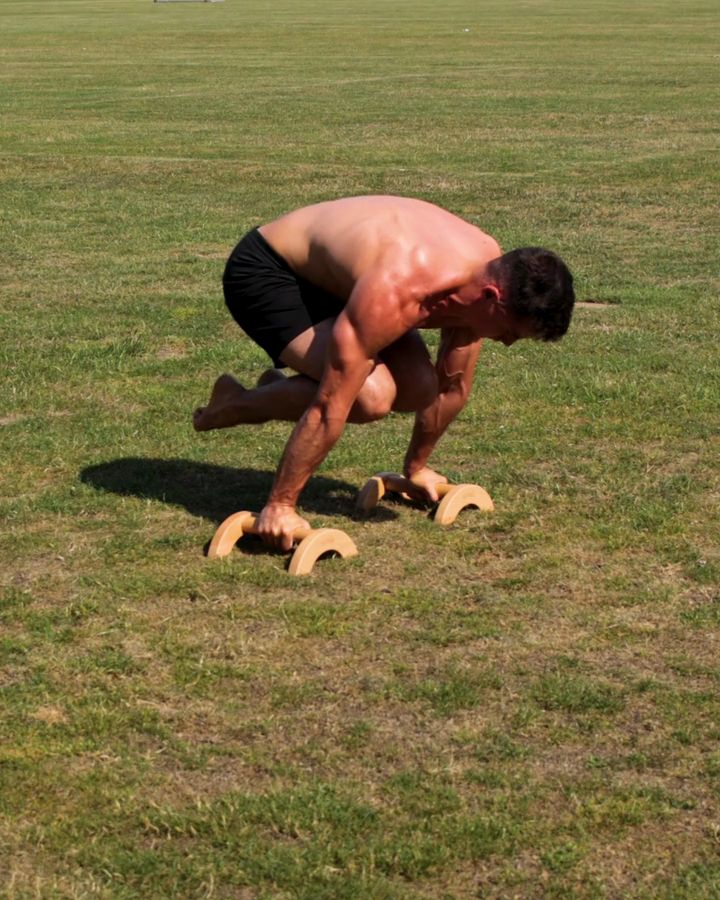
Tuck Planche on parallettes
The tuck planche is a fundamental preparatory exercise for the planche. In this position, the body is held horizontally above the ground with the legs tucked toward the chest and the arms straight. Parallettes make the grip easier, reduce strain on the wrists, and provide extra stability as well as more clearance for the legs and feet due to the elevated starting position. The frog stand is often mistaken for the planche, but it involves bent arms, not straight arms, and therefore doesn’t belong to the family of straight arm skills.
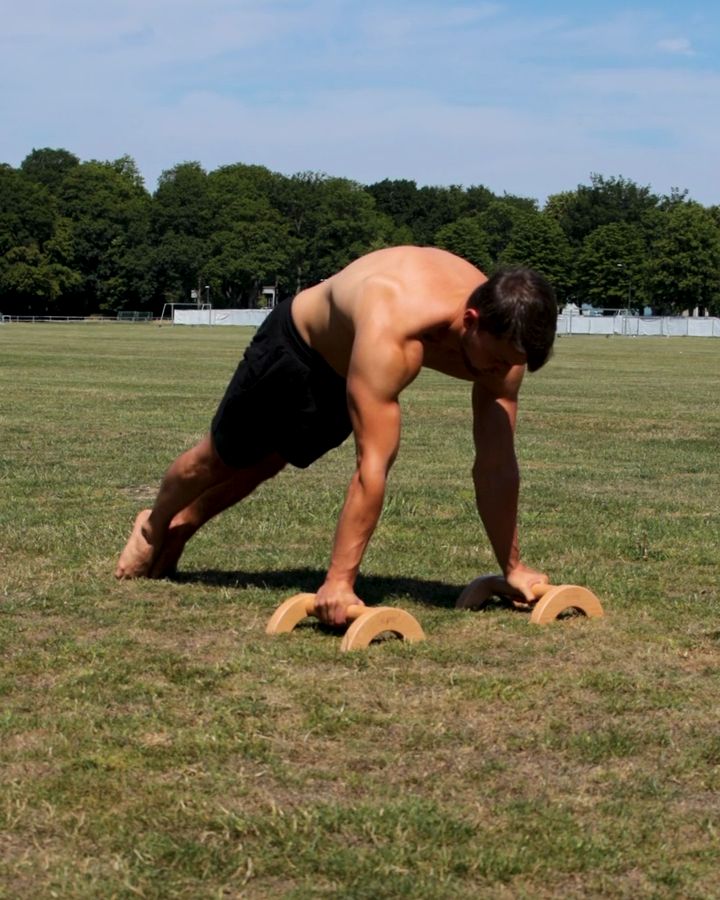
Scapular Push Ups with parallettes
Scapular Push-ups, also known as shoulder blade push-ups, are an exercise that specifically strengthens the shoulders and the serratus anterior. The arms stay straight while you control the movement of your shoulder blades, pulling them together and pushing them apart. This exercise enhances the stability and mobility of the shoulder blades. Scapular Push-ups are a great addition to regular push-ups, especially if you have issues with shoulder activation. They are also popular in planche training as they help train the technique of shoulder girdle protraction.
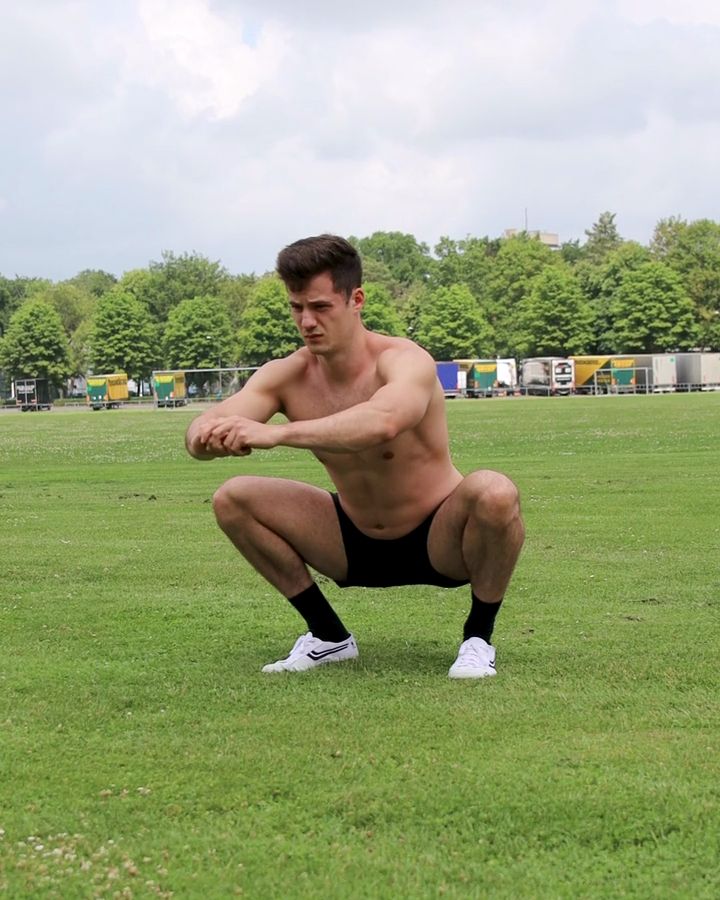
Deep Squat
The deep squat (Malasana), also known as the deep squat hold or "ass to grass" squat, is a fundamental exercise that promotes flexibility and stability in the lower body. It primarily targets the thighs, glutes, and lower back while also mobilizing the ankles, hips, and knees. This position improves posture and can help prevent back pain. Compared to a regular squat, you remain in the end position of a squat in the deep squat, placing the knees, hips, and lower back in a comfortable and relieving flexion. It is an excellent exercise to improve lower body mobility and serves as a foundation for advanced exercises like Pistol Squats or Goblet Squats.
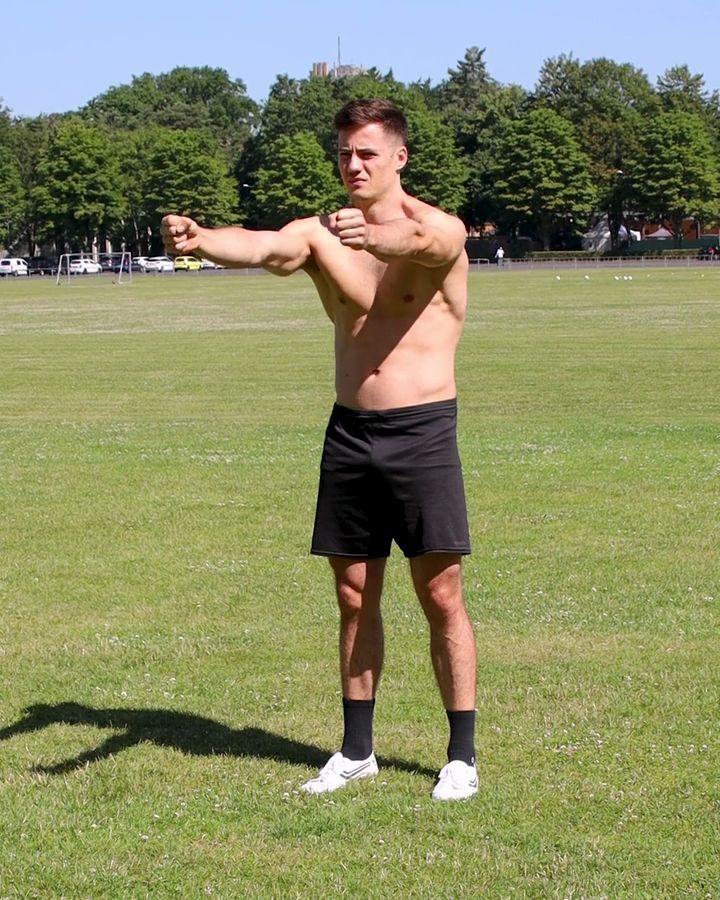
Protraction Retraction
Protraction and retraction describe the forward and backward movement of the shoulder blades (scapulae). During protraction, the shoulder blades move forward, away from the spine, which is important in exercises like push-ups or planks. Retraction pulls the shoulder blades back towards the spine, as seen in bent-over rows or pull-ups. Both movements are essential for the stability and mobility of the shoulder joints.
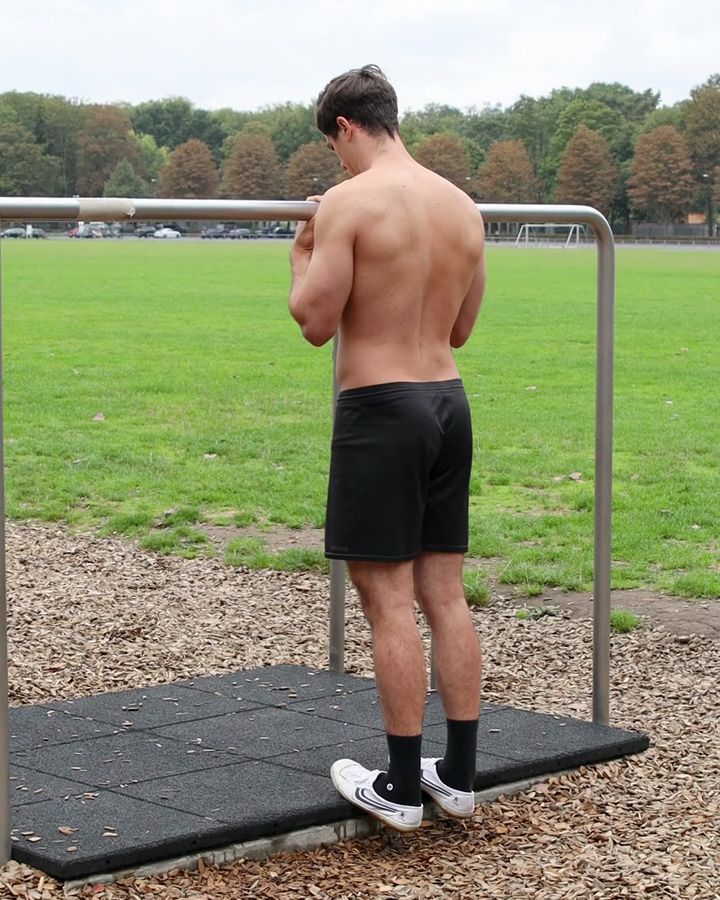
Calf Stretch
Calf stretching is a simple yet effective exercise to specifically target the muscles at the back of the lower legs. You stand with both feet on an edge and let your heels drop down as far as comfortable, holding the stretch within a tolerable range. This exercise improves calf muscle flexibility and helps release muscle tension, making it especially beneficial after intense workouts or long periods of walking or standing.
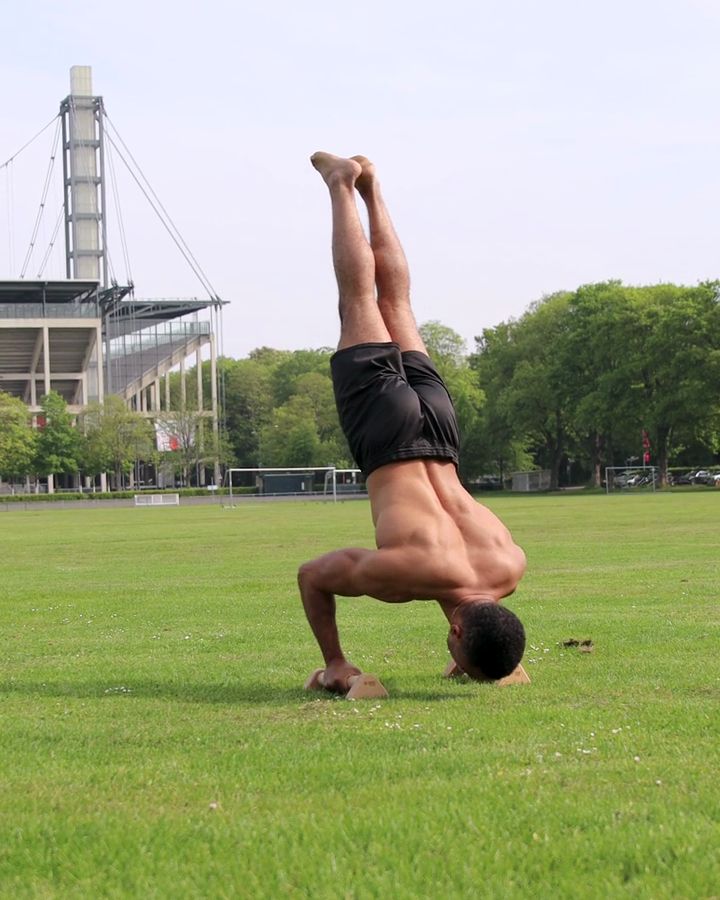
Handstand Push Ups with parallettes
Handstand push-ups on parallettes require a great deal of stability, strength, and coordination, as they are performed in a handstand position. Compared to regular push-ups, this exercise is much more intense, as you need to lift your entire body weight. It requires a stable handstand position and significant shoulder strength, making it a common advanced progression from exercises like Pike Push-Ups or wall handstand push-ups.
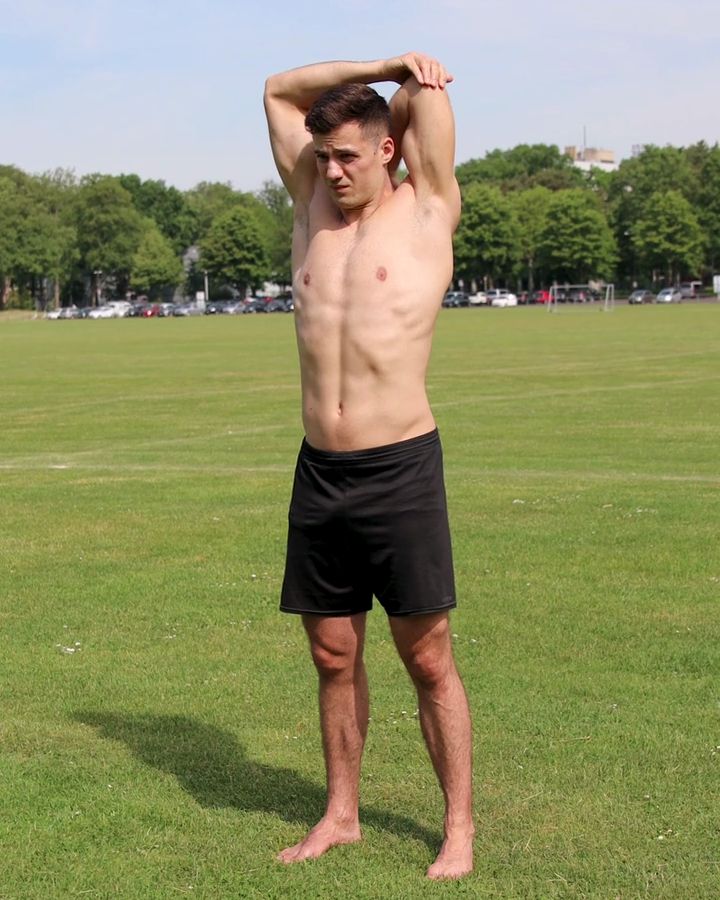
Triceps Stretch
The triceps stretch specifically targets the muscles at the back of the upper arm and improves shoulder mobility. One arm is bent behind the head, while the opposite hand gently presses the elbow down. This stretch is an ideal addition after triceps exercises to release tension and support recovery.
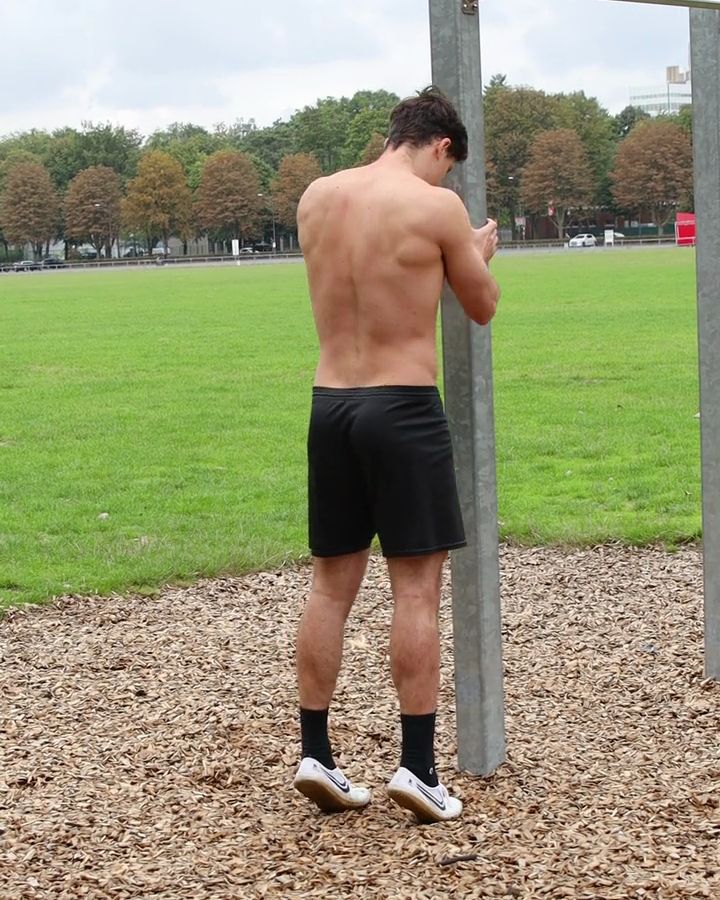
Toe Walk
Toe walks are a simple yet effective exercise for strengthening the calf muscles and improving balance. You walk on your tiptoes, which also engages the foot muscles and promotes ankle stability. This exercise is a great addition to calf raises and can help stabilize the overall foot and leg muscles, preventing injuries.
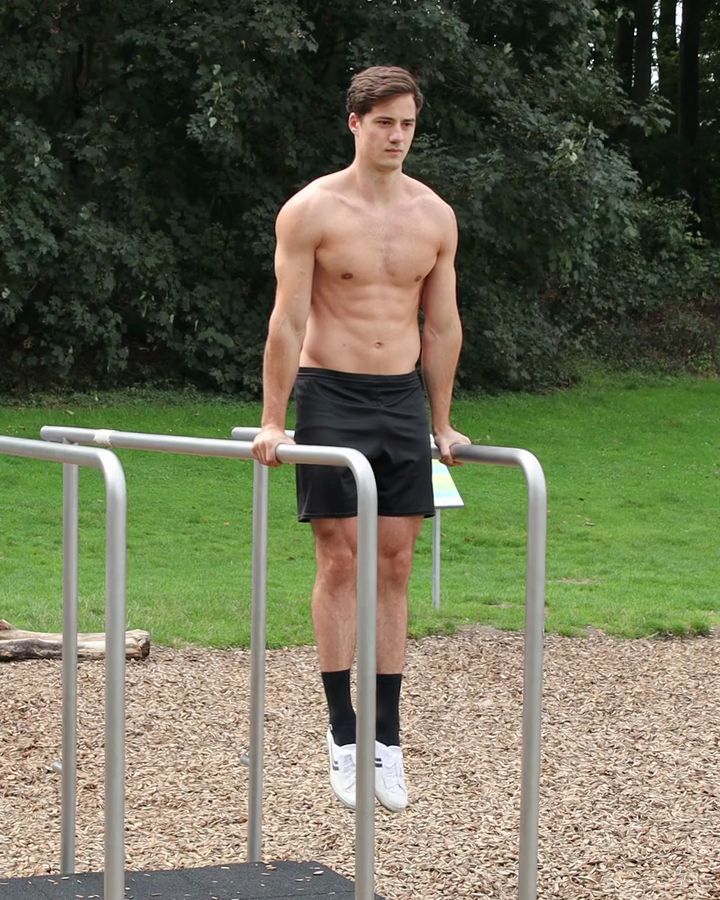
Parallel Bars Support Hold
The support on the parallel bars is a classic exercise that primarily trains the chest, shoulder, and arm muscles while stabilizing the core. You support yourself with straight arms on the parallel bars, enhancing body tension and balance. This exercise is a foundation for advanced movements like Dips and L-Sit, as it builds the necessary upper body strength and control.
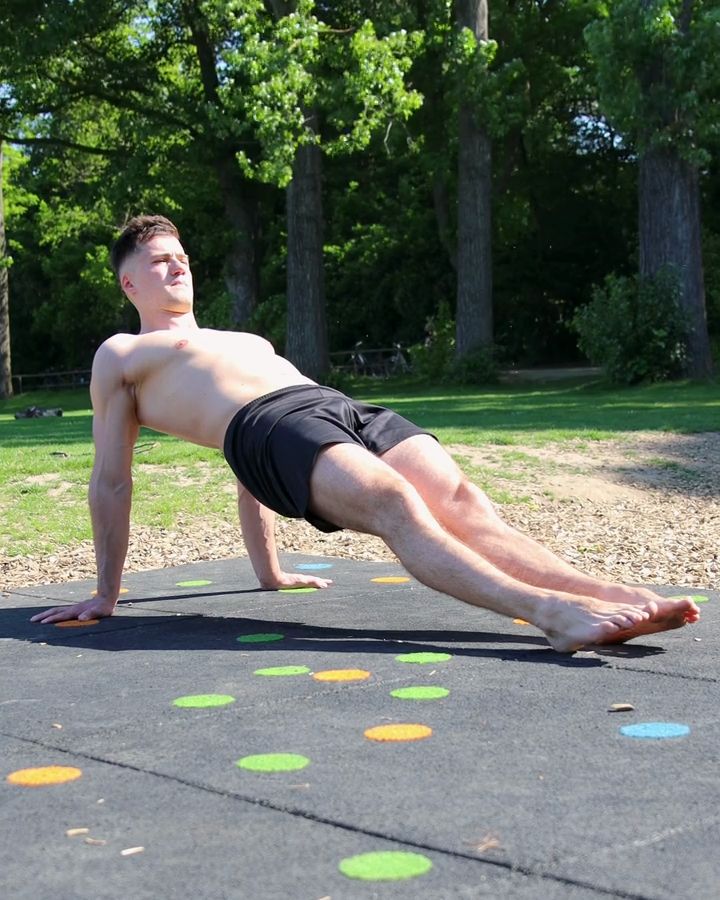
Reverse Plank
The Reverse Plank is a bodyweight exercise where the body is held in a straight line, face-up. This exercise is often underestimated despite its many benefits. It strengthens the posterior chain and can help improve posture, particularly for rounded shoulders or excessive lordosis. It targets the shoulder extensors, back muscles, glutes, and hamstrings, while stretching shortened muscles such as the hip flexors and shoulder and arm flexors. The Reverse Plank specifically builds strength in shoulder extension, something exercises like the German Hang or Skin The Cat cannot do, as these primarily train the muscles involved in shoulder flexion. Additionally, the Reverse Plank supports structural shoulder balance and helps prevent injuries. Another often overlooked benefit is its importance for advanced skills like the Manna and the V-Sit. The Reverse Plank is a foundational exercise for developing these challenging calisthenics skills.
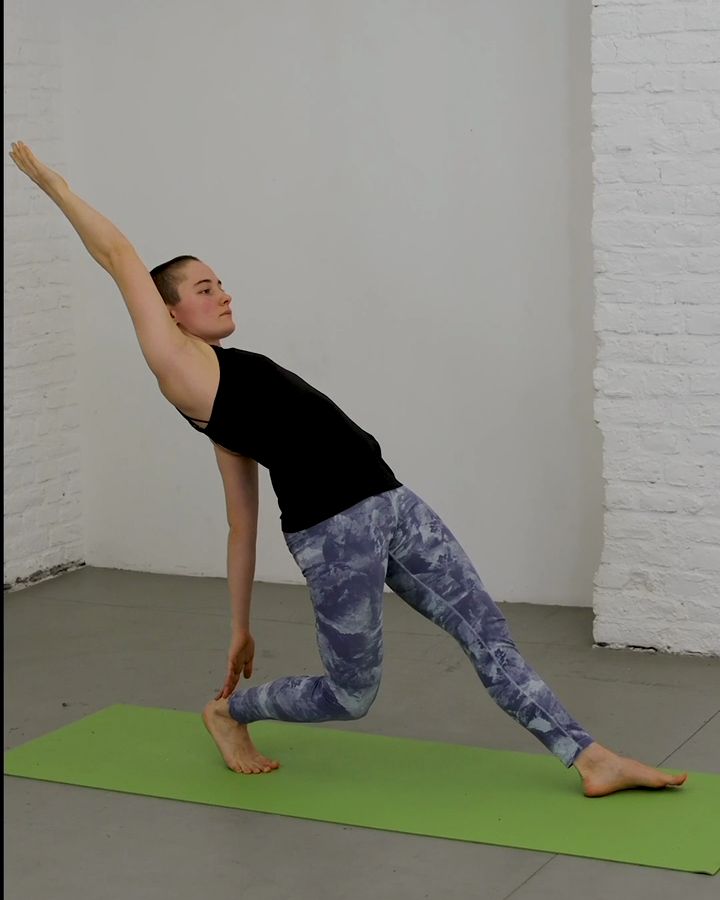
Diagonal Stretch
The full diagonal stretch is an advanced stretching exercise where the upper body is stretched diagonally, allowing for an intense stretch along the entire side of the body. This exercise improves flexibility in the hip flexors and lateral core muscles. It can relieve tension and pain in the lower back and is especially useful as a warm-up before running-intensive sports or for anyone who spends a lot of time sitting during the workday.
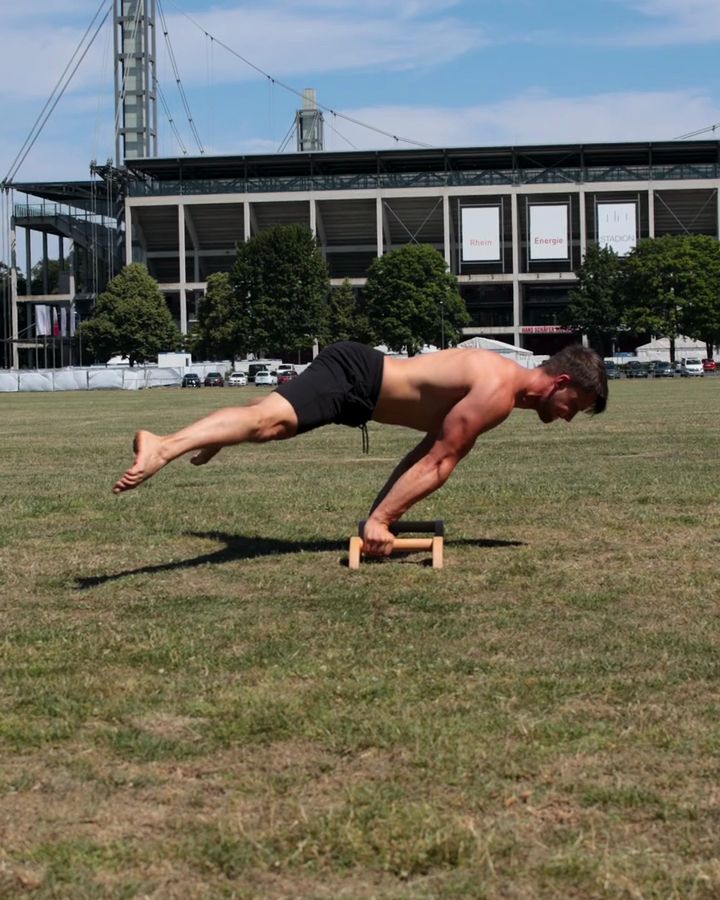
Straddle Planche with parallettes
The Straddle Planche is an advanced calisthenics exercise where the body is held horizontally and parallel to the ground, with the legs spread apart. This position shortens the lever arm, making the exercise easier compared to the Full Planche. It intensely trains the shoulders, core, and arms, requiring strong abdominal muscles, stable shoulder strength, and resilient wrists. The Straddle Planche can be performed on parallettes or directly on the ground, with the ground variation demanding greater wrist endurance. The regular Planche, where the legs are kept together, poses an even greater challenge, requiring more balance and strength.
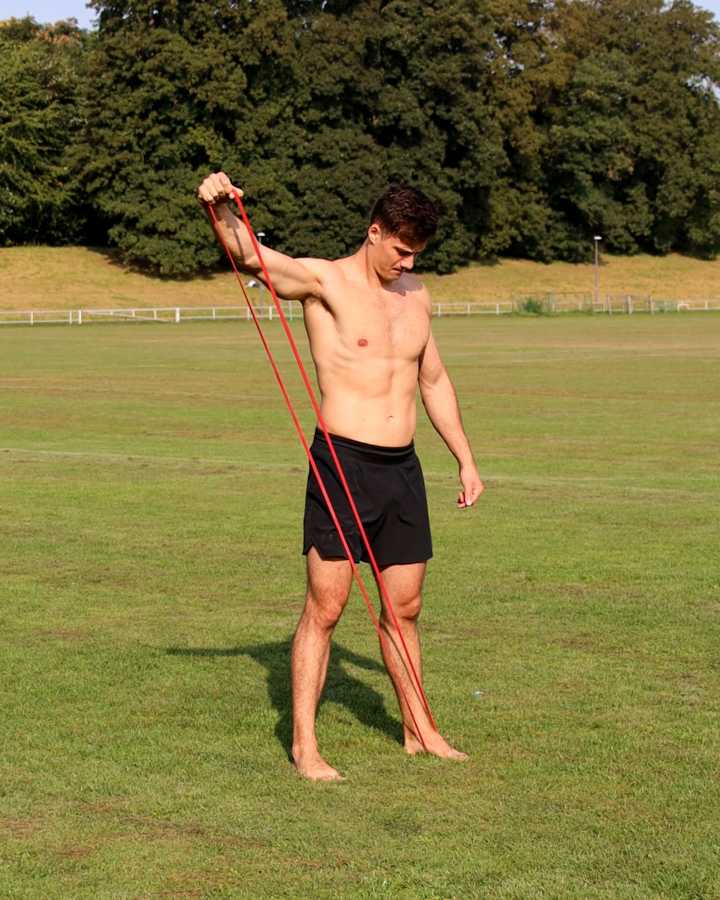
Banded Lateral Raises with a band
Lateral raises with a band are an excellent way to train the side shoulders when weights aren’t available for dumbbell lateral raises. To perform this exercise, stand on a resistance band, hold the ends, and lift your arms to the side until about shoulder height. The band provides increasing resistance, which evenly challenges the shoulder muscles.
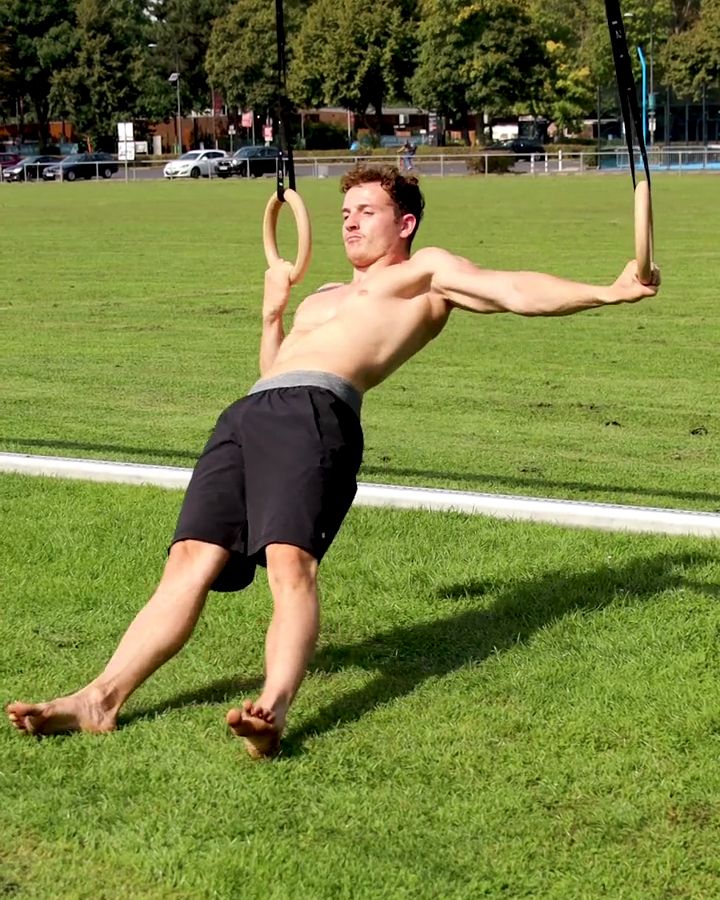
Gym Ring Archer Rows
Archer rows on gymnastic rings are a more advanced variation of classic rowing. In this exercise, one arm performs the row while the other stays extended to the side. This exercise specifically targets the upper back and biceps. Compared to traditional rowing exercises like dumbbell or barbell rows, ring training puts less strain on the lower back and legs, making it especially suitable for people with back pain. An additional progression of the Archer Rows is the one-arm row on gymnastic rings.
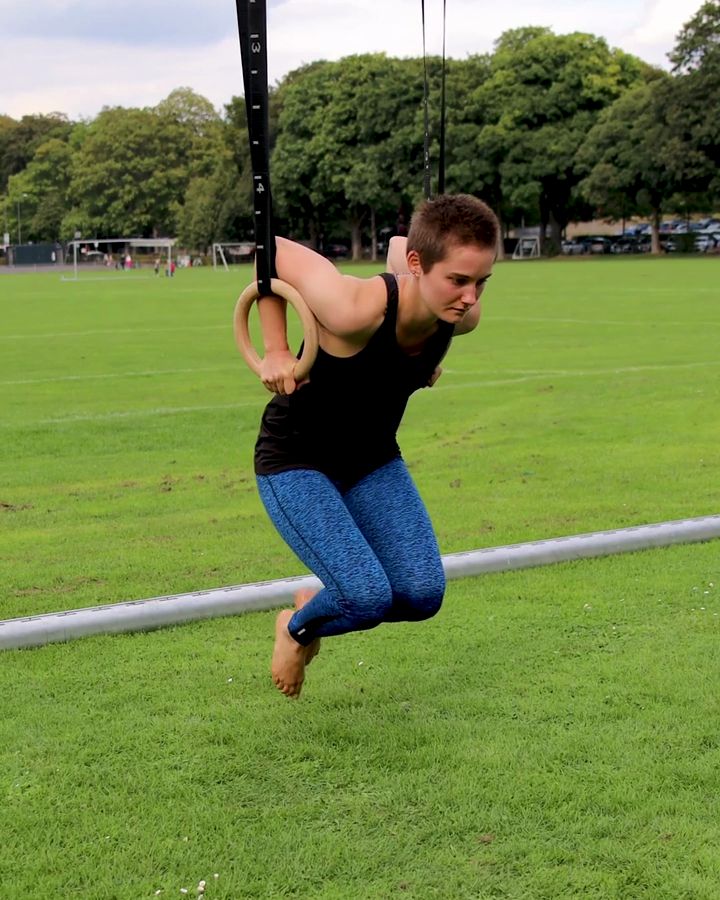
Negative Dips with gym rings
Negative dips on the rings focus on eccentric loading, where you lower yourself in a controlled manner. This phase intensely engages the chest, shoulders, and triceps and can lead to muscle soreness. Negative dips are an ideal preparatory exercise for ring dips.
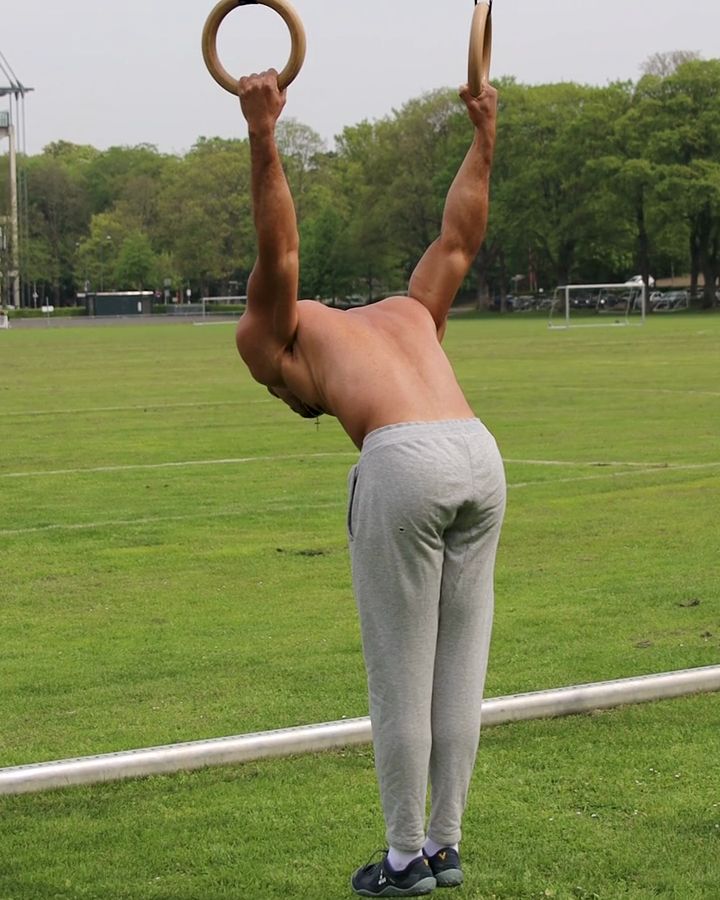
German Hang with gym rings
The German hang is a stretching and strength exercise where the body hangs backward from rings or a bar, with the shoulders maximally opened. This position provides an intense stretch for the chest and shoulder muscles while engaging the rear shoulder muscles, upper back, and arm flexors. The German hang improves shoulder stability and promotes mobility, making it especially valuable for advanced athletes in gymnastics, calisthenics, and strength training. It serves as a preparatory exercise for more complex movements like the skin-the-cat or the muscle-up and supports joint health by safely loading the shoulder in a deep stretch position when practiced in a well-structured training program with progressive load increases.
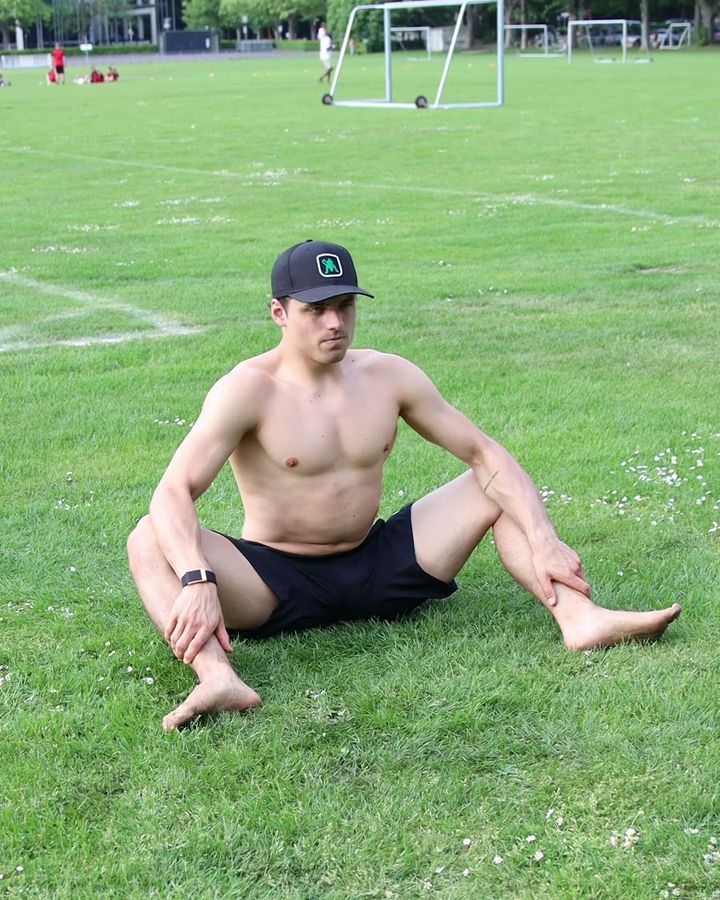
Bear Sit
The bear sit is a mobility exercise that specifically targets the hips and lower back. In this position, you sit on the floor with your legs spread wide, knees pointing outward, and feet flat on the ground. Keep your upper body upright while actively opening the hips. This exercise improves the flexibility of the adductors and is ideal as preparation for deep squats or as a complement to other mobility exercises like the 90/90 stretch.
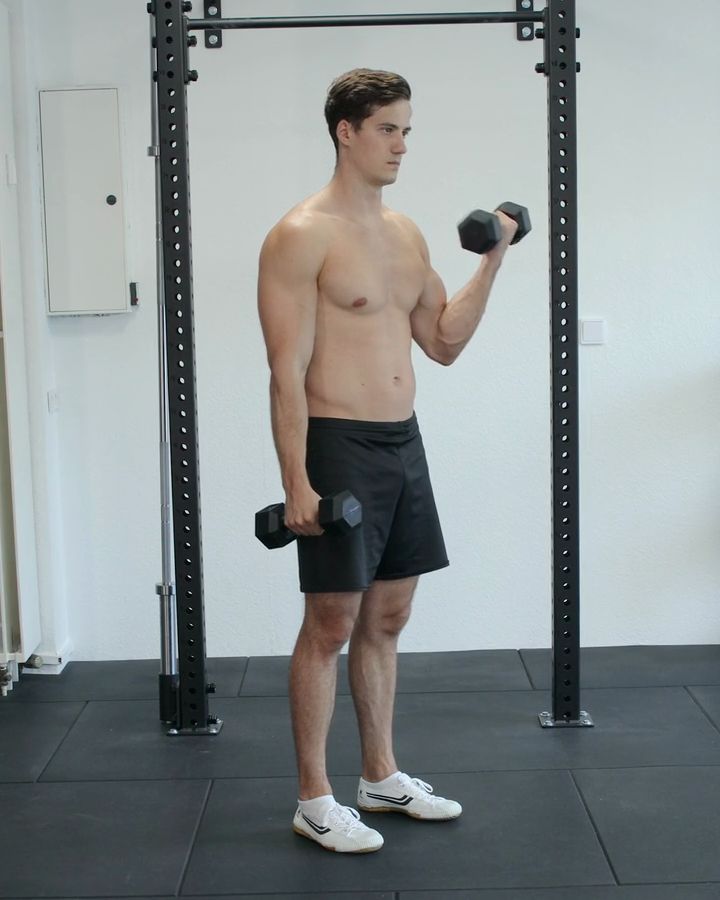
Alternating Biceps Curls with dumbbells
Alternating dumbbell bicep curls are a classic exercise for strengthening the arm muscles, especially the biceps. They are excellent for building more strength and muscle mass in the upper arms. Since each arm works alternately, the biceps are specifically isolated while the rest of the body remains stable. Compared to two-arm curls, this variation places a stronger focus on isolating each arm individually.
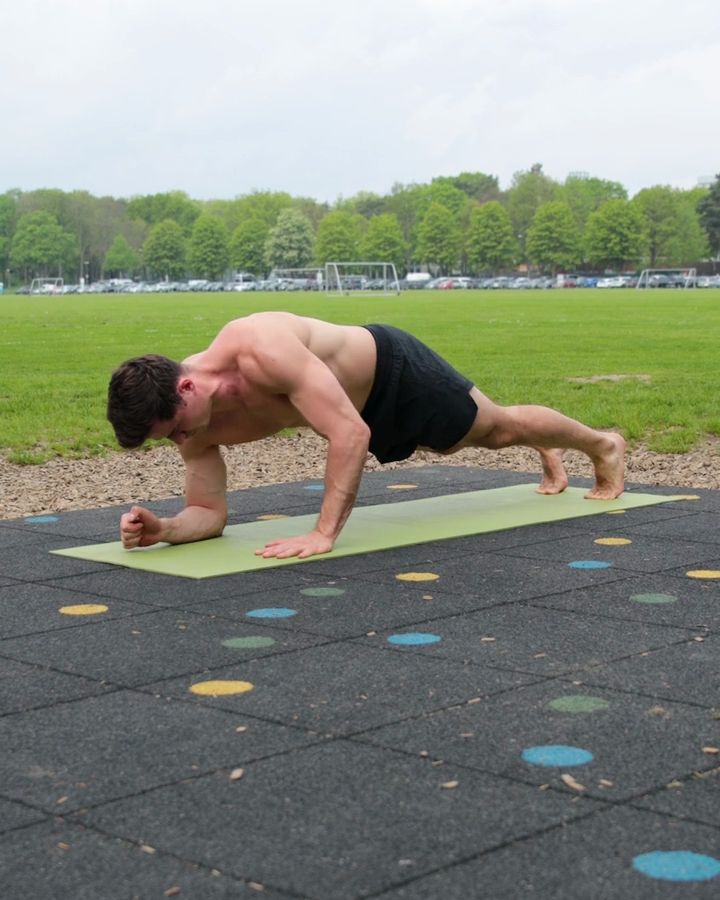
Plank Switches
Plank switches combine the stability of a plank with dynamic movements to train the core muscles, as well as the shoulders and arms. Compared to static planks, the movement from a forearm position to a hand support position adds an extra challenge, as the body must be kept stable during the transition. The focus of this exercise is on strengthening core stability, while the alternating shifts in support also require pressing strength.
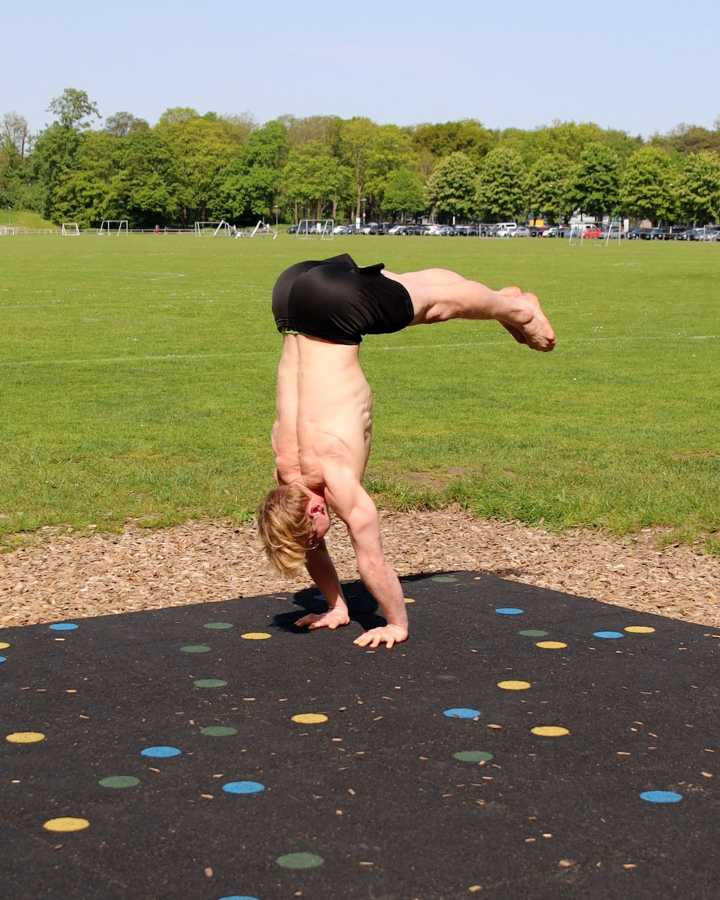
Press Handstand
The press handstand is an advanced way to enter the handstand, requiring a great deal of control, flexibility, and strength. Starting from a forward bend, the weight is shifted onto the hands. The feet are then lifted, and the spine is gradually aligned, vertebra by vertebra, until reaching the handstand position. In comparison, the straddle press handstand starts from a straddled forward bend. This makes the straddle press handstand slightly easier, as the legs can be brought up closer to the center of gravity.
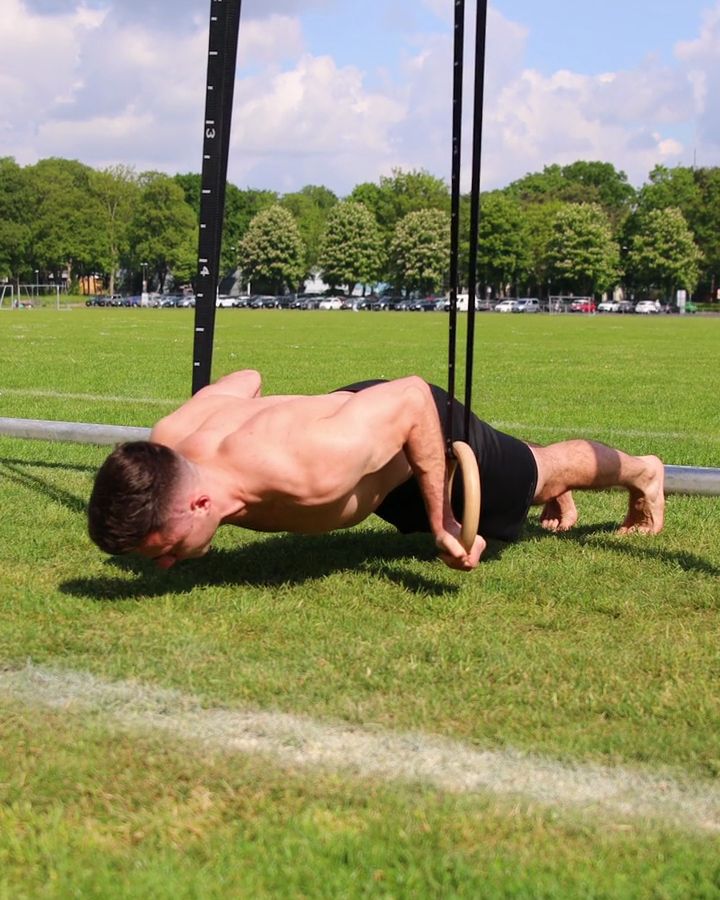
Pseudo Planche Push Ups with gym rings
Pseudo planche push-ups are an advanced variation of the classic push-ups that place greater emphasis on the shoulders. Unlike regular push-ups, the center of gravity is shifted forward by positioning the hands further back, roughly at hip level. This exercise is a great introduction to training for the planche. Other exercises, such as archer push-ups, provide a good alternative for those looking for less intense shoulder strain.
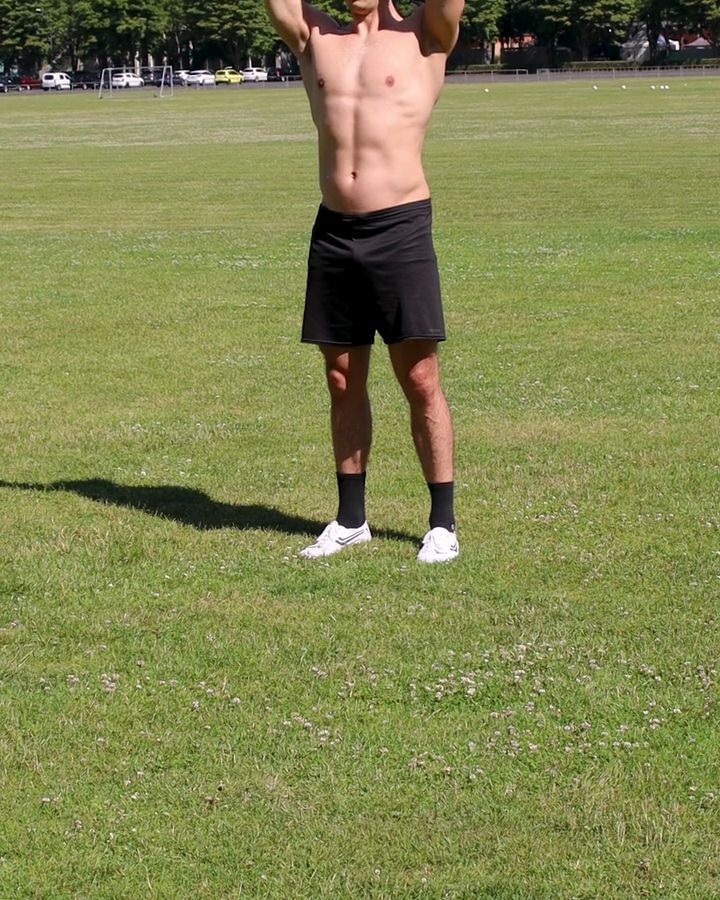
Elevation Depression
Elevation and depression refer to the upward and downward movement of the shoulder blades and are an effective exercise for strengthening the muscles around the shoulders and upper back. During elevation, the shoulder blades are pulled upwards, while during depression, they are actively pressed downwards. These movements primarily work the trapezius and rhomboid muscles. Elevation and depression can be integrated into various exercises, such as pull-ups or dips, to improve shoulder control and stability.
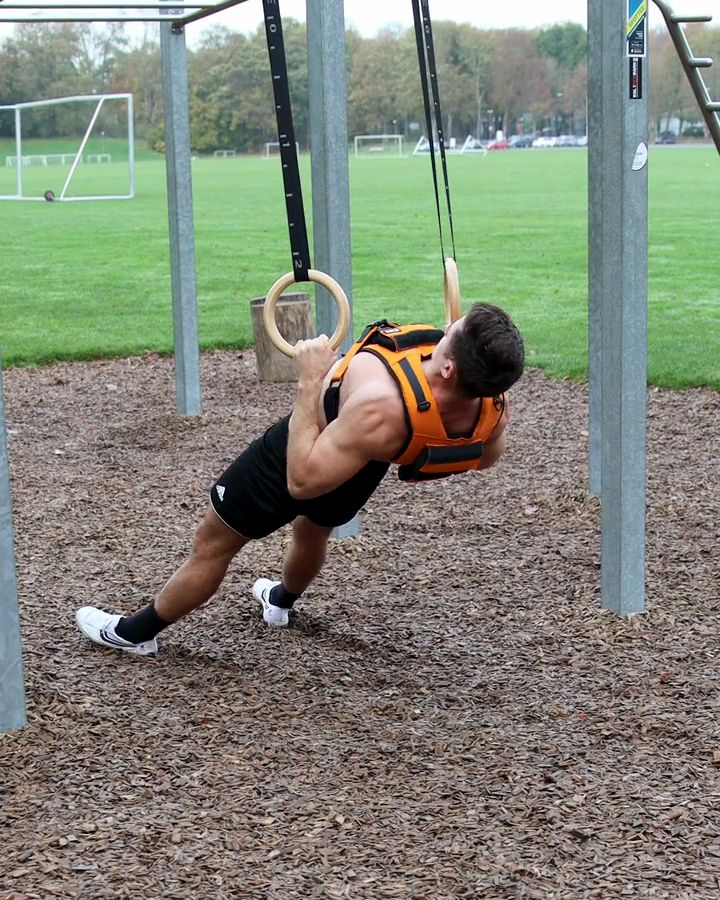
Weighted Ring Rows
Ring rows with a weight vest primarily strengthen the upper and middle back as well as the arm flexors, with the rings allowing for a customized grip. Wearing the weight vest increases resistance, providing an excellent way to make regular rows more challenging and continue delivering effective training stimuli. Unlike pull-ups, which use a vertical pulling pattern, rows focus on a horizontal pull, effectively targeting the upper back.
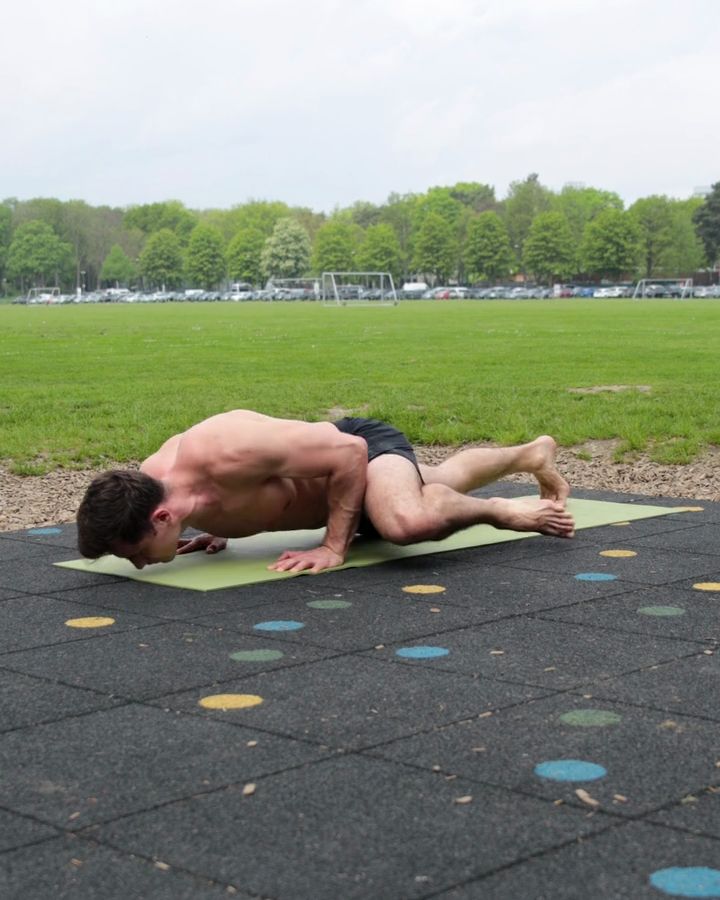
Spiderman Push Ups
Spiderman push-ups are a dynamic variation of the classic push-up, where the hip and core muscles are additionally engaged. As you lower yourself, one knee is brought to the side towards the elbow, which also promotes hip mobility. This exercise not only trains the chest, shoulders, and triceps but also the abdominal muscles. Spiderman push-ups are a great alternative or addition to classic push-ups or mountain climbers to improve mobility and body control.
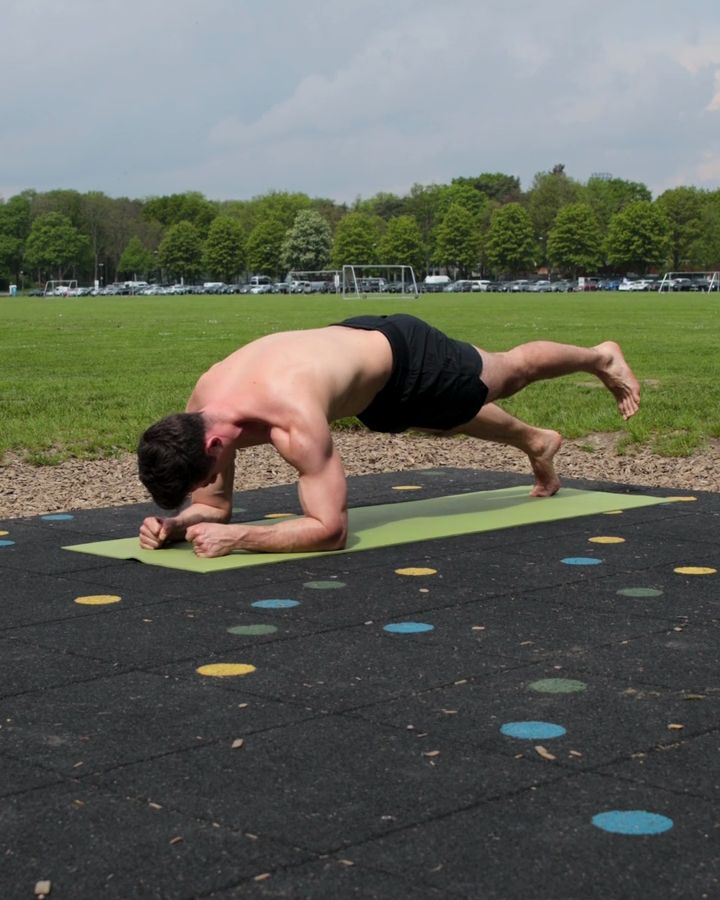
Plank Leg Lifts
Plank leg lifts combine the core stability of the classic plank with a dynamic leg lift, which engages not only the abs and back muscles but also the glutes and leg muscles more intensively. By alternating leg lifts, balance is challenged, and the core is activated more deeply. Compared to the forearm plank, this variation involves the lower body more, making the exercise more challenging and versatile.
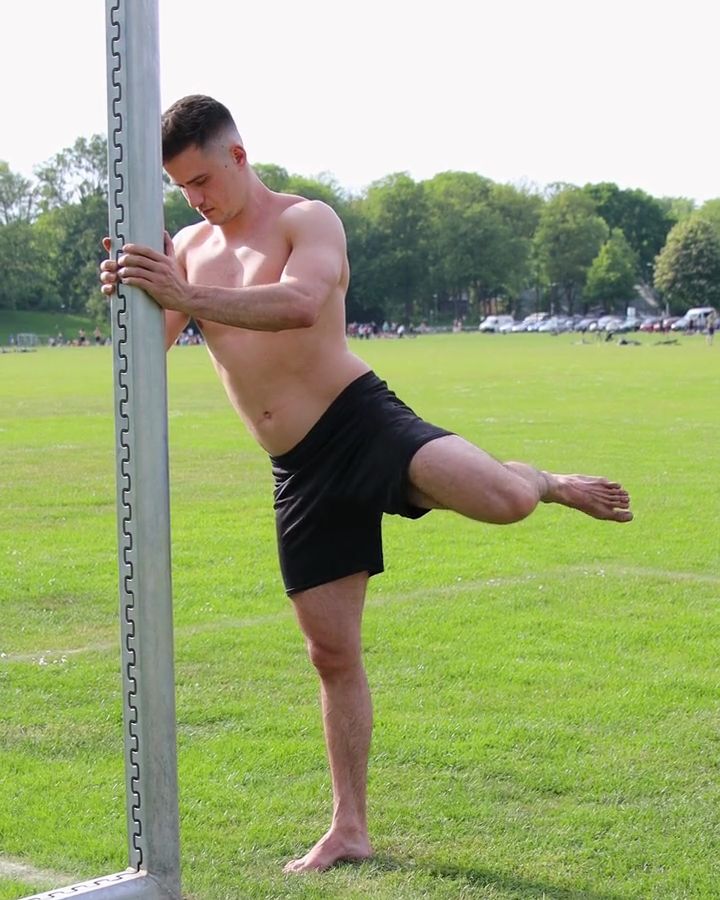
Hip CARs
Hip CARs (Controlled Articular Rotations) are a mobility exercise aimed at improving hip joint flexibility and control. Through slow, controlled movements, the full range of motion in the hip joint is utilized, activating the hip flexors, glutes, and adductors. This exercise is especially useful as a warm-up before more intense workouts or to enhance hip mobility and stability. Unlike static stretches, Hip CARs require active control, similar to dynamic mobility exercises like leg swings.
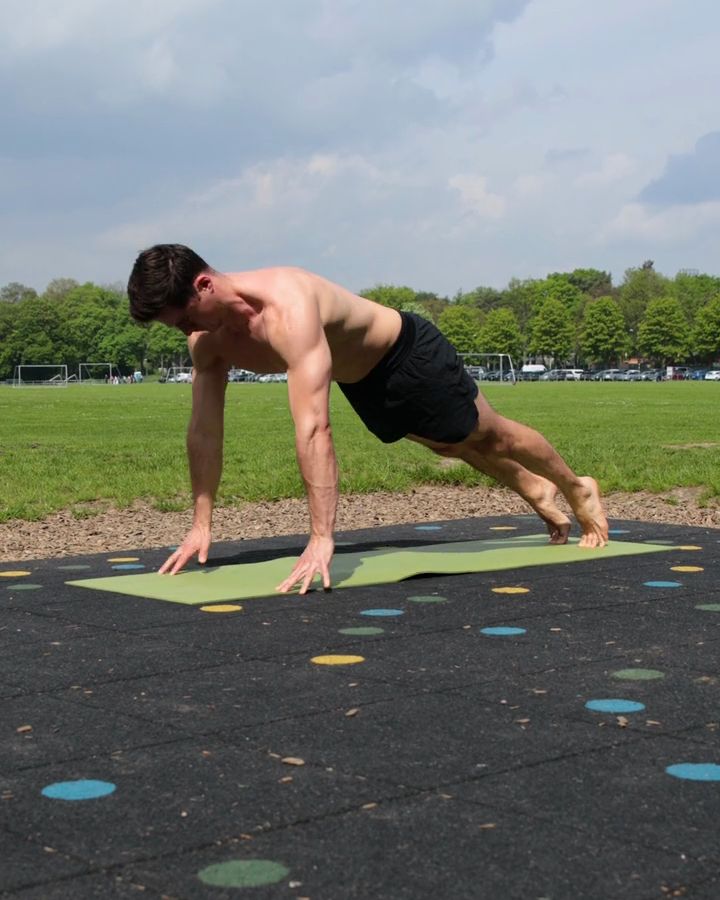
Explosive Push Ups
Explosive push-ups are a dynamic variation of the classic push-up and are particularly suitable for athletes looking to improve their explosiveness. During the exercise, the body is pushed upwards so powerfully during the upward movement that the hands briefly leave the ground. This primarily trains the chest, triceps, and front shoulders, while also increasing speed strength and explosiveness.
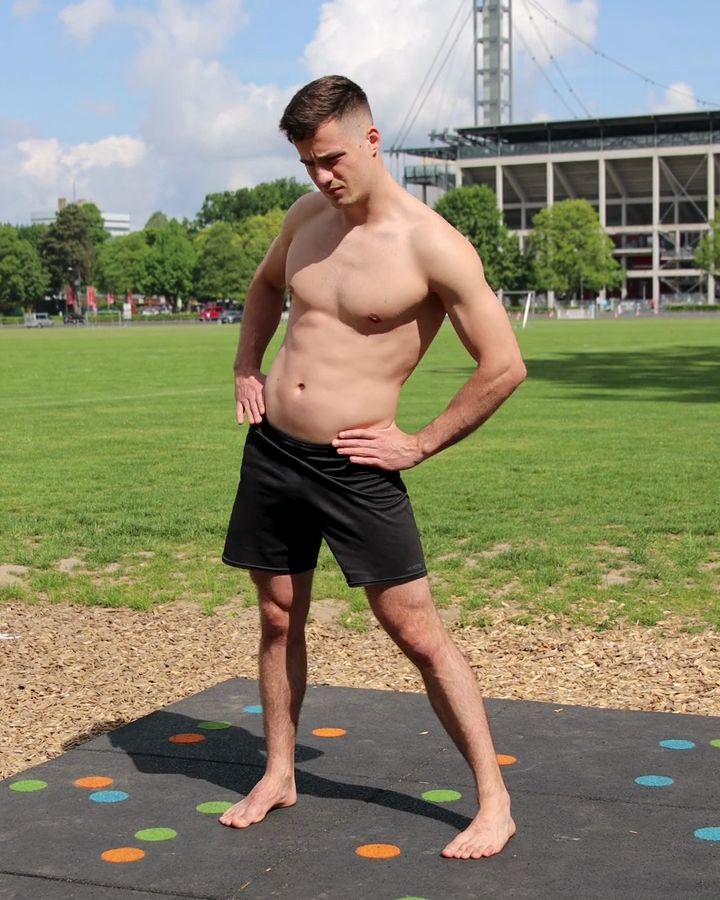
Hip Circles
Hip circles are a simple mobility exercise in which the hips are moved in a circular motion to improve flexibility and range of motion in the hip area. This exercise activates the muscles of the lower back, hips, and abs, and helps to distribute joint fluid, leading to better hip mobility and injury prevention. Hip circles are ideal as a warm-up exercise before physical activities or as part of a mobility routine, as they gently guide the hip joints through their full range of motion.
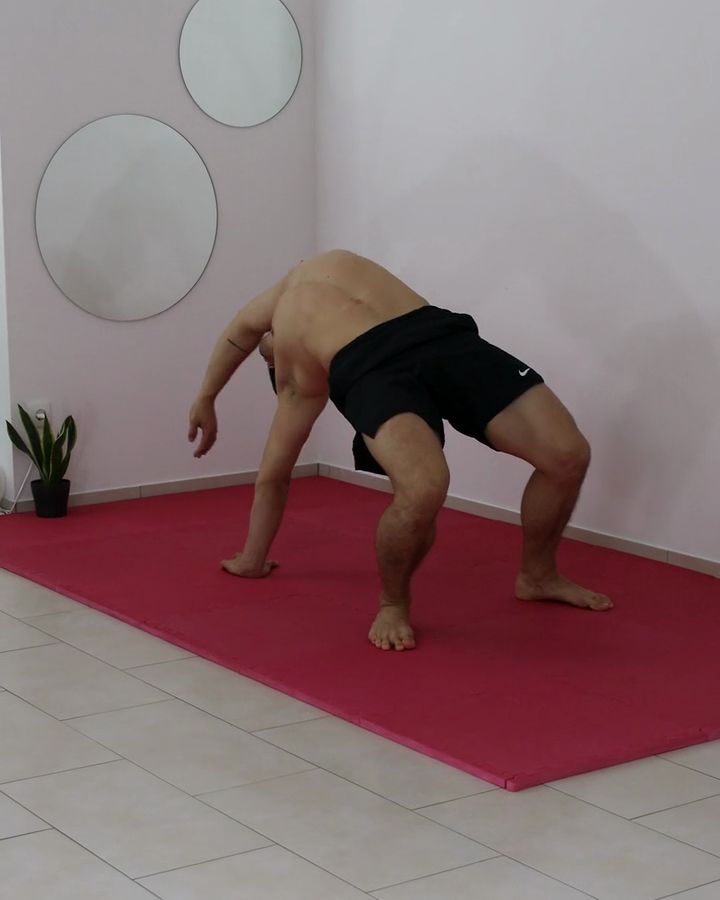
Bridge Rotations
The bridge rotation combines the classic bridge with a dynamic rotational movement to enhance both flexibility and strength throughout the upper body. This exercise intensely engages the back muscles, shoulders, and core. Unlike the static bridge, the rotation allows for active stretching and mobilization of the spine, improving coordination. The bridge rotation can be seen as a progression from the half bridge rotation, which serves as an easier entry point and helps train controlled movement execution.
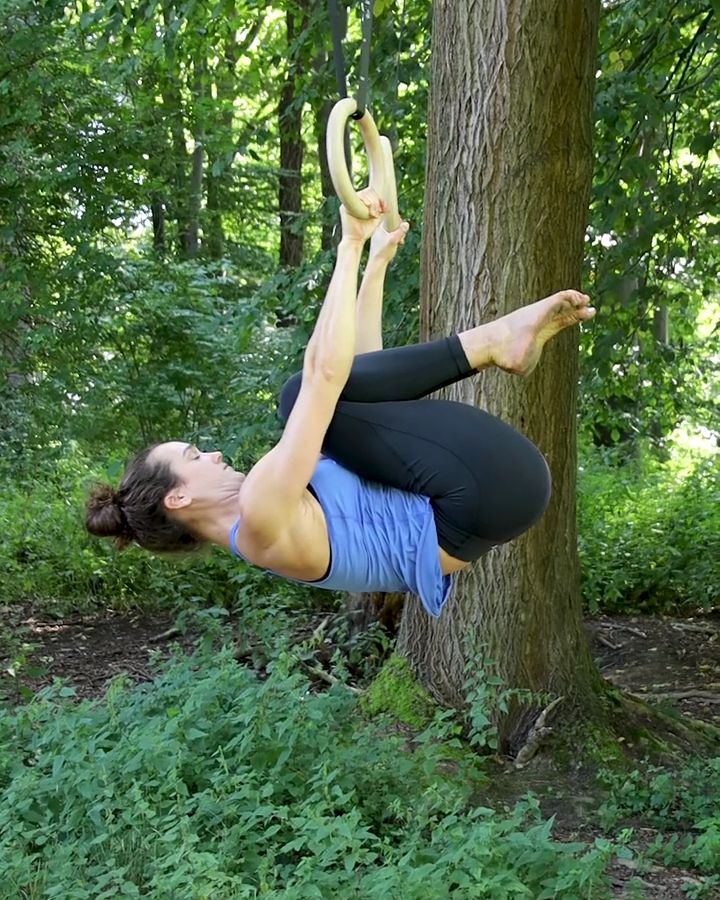
Tuck Front Lever with gym rings
The tuck front lever is an effective exercise for strengthening the back, core, and triceps muscles, and it serves as an ideal preparation for the full front lever. In this exercise, the knees are pulled towards the chest, and the body is held parallel to the ground while gripping a bar or rings. Due to the tucked legs, this exercise is easier than the regular front lever because the weight remains closer to the body’s center of gravity. The tuck front lever is perfect for beginners to build body tension and prepare for the advanced straight-leg variation.
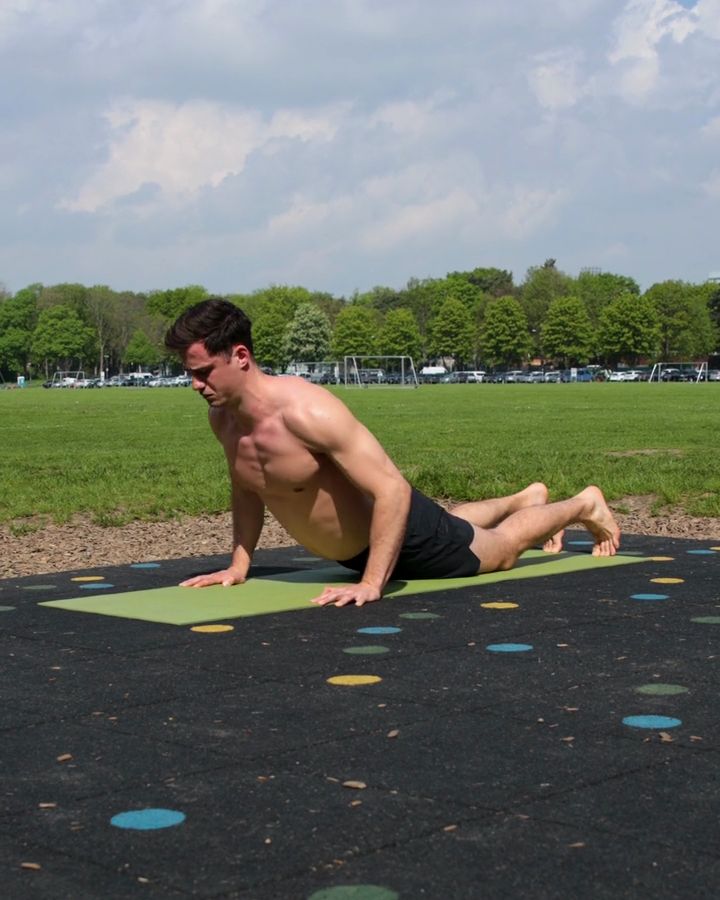
Cobra Push Ups
Cobra push-ups are one of the simplest push-up variations for beginners. They’re even easier than knee push-ups, as the movement involves pushing up in a way that resembles a cobra rising. The name comes from the way the upper spine lifts first, followed gradually by the rest of the body—much like a snake raising itself. A common myth suggests that this movement is a sign of improper form. While that may be true if done unintentionally, here it is a purposeful technique and therefore correct. A similar back position can also be seen in the ring cobra stretch. Cobra push-ups are thus an excellent introductory exercise for beginners learning classic push-ups, while also promoting flexibility and strengthening the lower back.
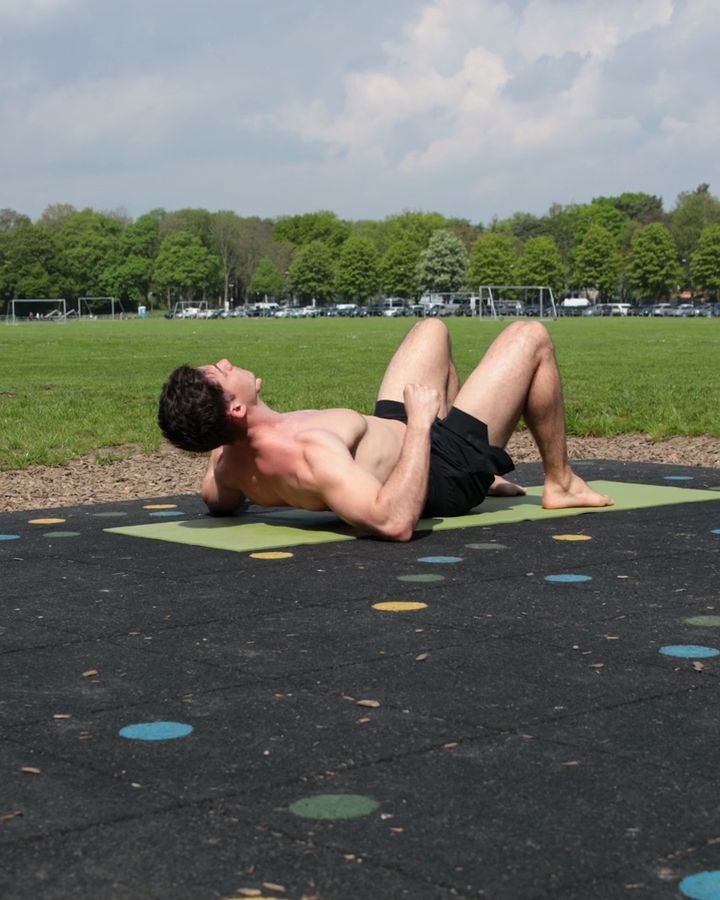
Elbow Press
The Elbow Press is a dynamic exercise that primarily activates the rear shoulders, upper back, and neck, while the core muscles provide stability. The body is lifted in a controlled manner using the elbows, while the glutes and feet remain on the floor. The legs are bent during the movement. This exercise can be considered an advanced variation of Table Rocks and the Reverse Plank. The Elbow Press is an excellent choice for anyone looking to effectively train their back—completely without equipment.
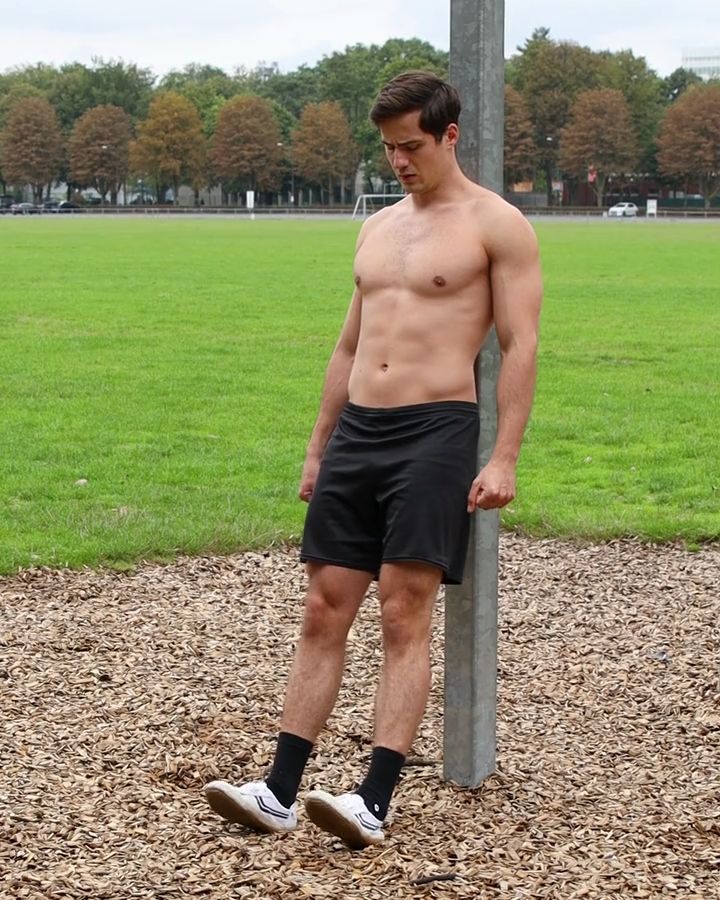
Tib Raises
Tib Raises are an effective exercise for strengthening the anterior shin muscles. Performed while standing, the toes are lifted while keeping the heels on the ground. This movement helps promote muscular balance in the lower leg and can prevent overuse injuries such as shin splints. Tib Raises serve as the counterpart to Calf Raises, where the heels are lifted to target the posterior lower leg muscles. Together, these exercises provide a well-rounded lower leg training routine.
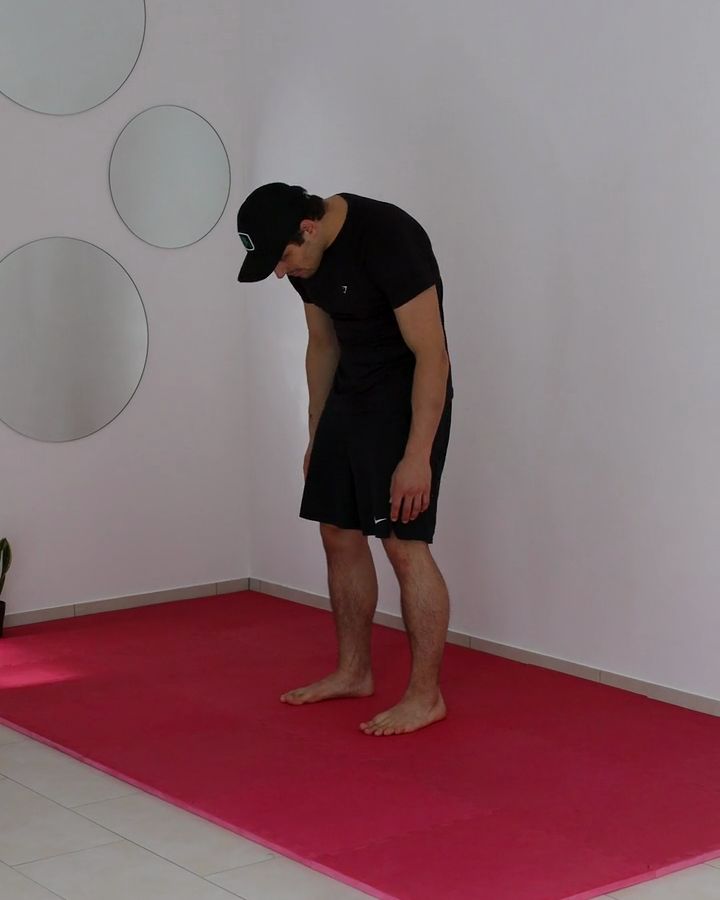
Spine Waves for Beginner
Spine Waves, also known as Spinal CARs or Spinal Waves, are flowing movements that mobilize and strengthen the spine. They promote flexibility, release tension in the back, and enhance body control. The spine is moved in a wave-like motion from top to bottom, engaging each vertebra individually. In comparison, the Cat-Cow Exercise also mobilizes the spine with a flowing motion but moves all vertebrae simultaneously and is performed in a quadruped position. Another complementary exercise is the Cobra Pose, which stretches the spine and strengthens the back muscles. In this exercise, you lie on your stomach and lift your upper body, specifically improving back flexibility.
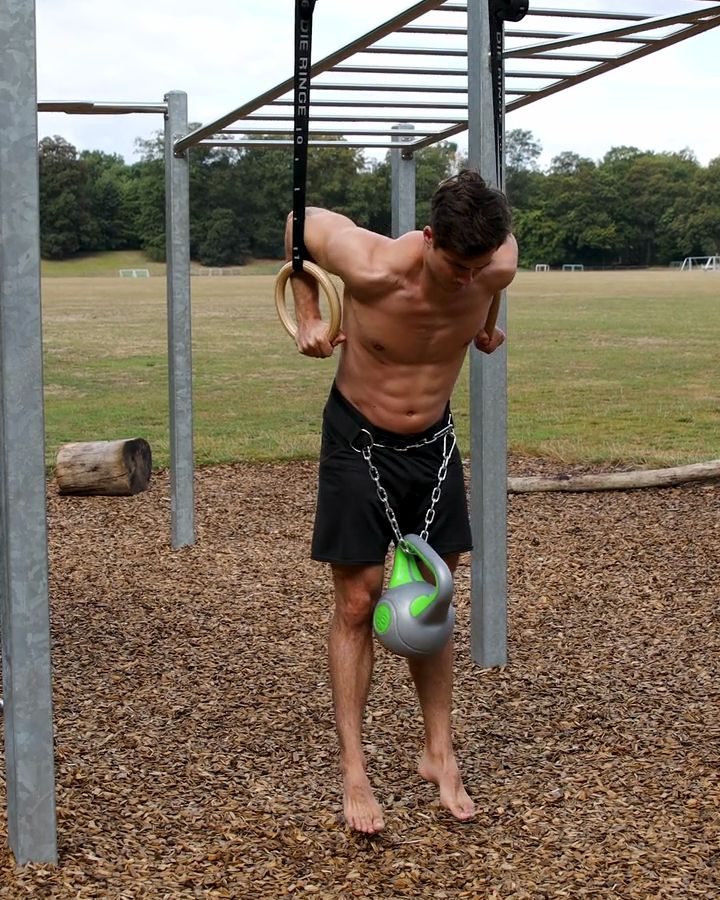
Weighted Ring Dips
Weighted ring dips are an advanced variation of classic dips, where the additional weight significantly increases intensity. This exercise primarily targets the chest, shoulders, and triceps, with the instability of the rings often meaning that less weight can be managed compared to dips on parallel bars. However, many trainees feel their chest muscles working more intensely when training on rings. In addition to regular ring dips, Bulgarian ring dips offer another challenging ring dip variation.
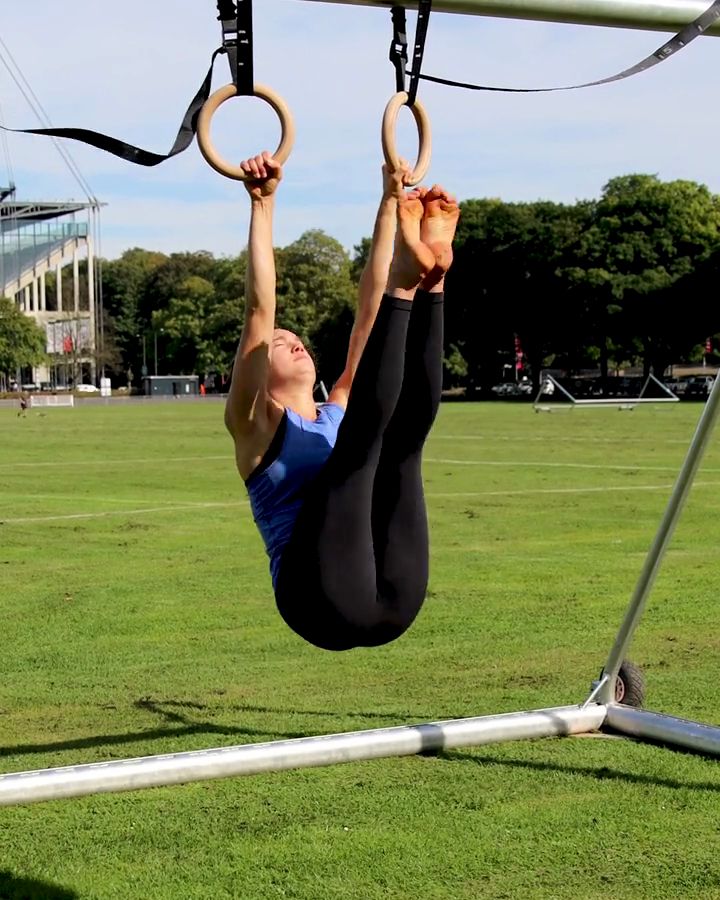
Toes To Rings with gym rings
Toes to rings effectively train the entire core, especially the abdominal muscles and hip flexors. Compared to the classic version on the bar, rings provide a slightly modified option. This exercise can be considered an advanced version of knee raises on the rings. If you want to target your abs, perform the exercise without momentum—unless you’re training for a CrossFit competition. A helpful side effect of this exercise: the L-sit will become easier.
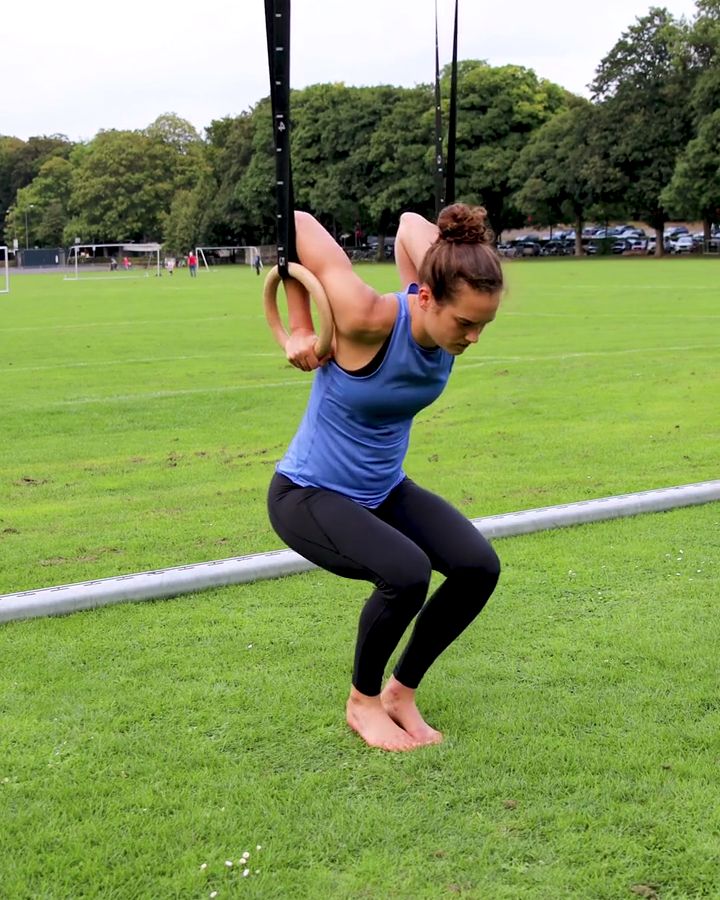
Assisted Dips with gym rings
Assisted ring dips with feet on the ground are a beginner-friendly version of classic ring dips that help build strength in the chest, shoulders, and triceps. The foot support on the ground allows for safe practice of the movement and stability while partially reducing body weight. This exercise is excellent preparation for unassisted ring dips, giving beginners a chance to develop the coordination and body tension needed for more challenging ring dips.
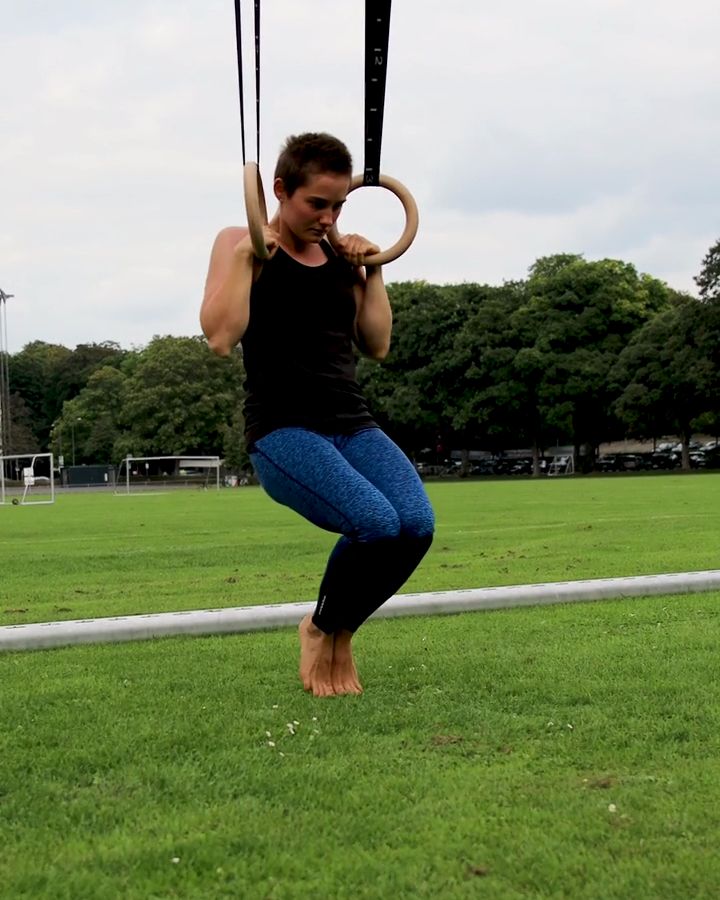
Negative Ring Muscle Ups
Negative ring muscle-ups focus on the eccentric part of the classic ring muscle-up. By taking advantage of the fact that we’re stronger during the lowering phase than the pull-up, this movement can be practiced even before achieving a full muscle-up. The exercise allows targeted training of the negative phase, building strength and helping to learn the complex movement sequence. It strengthens the back, shoulders, and arms and is an excellent precursor to the full ring muscle-up. Compared to negative ring dips, this exercise incorporates the transition, which particularly challenges shoulder mobility and strength.
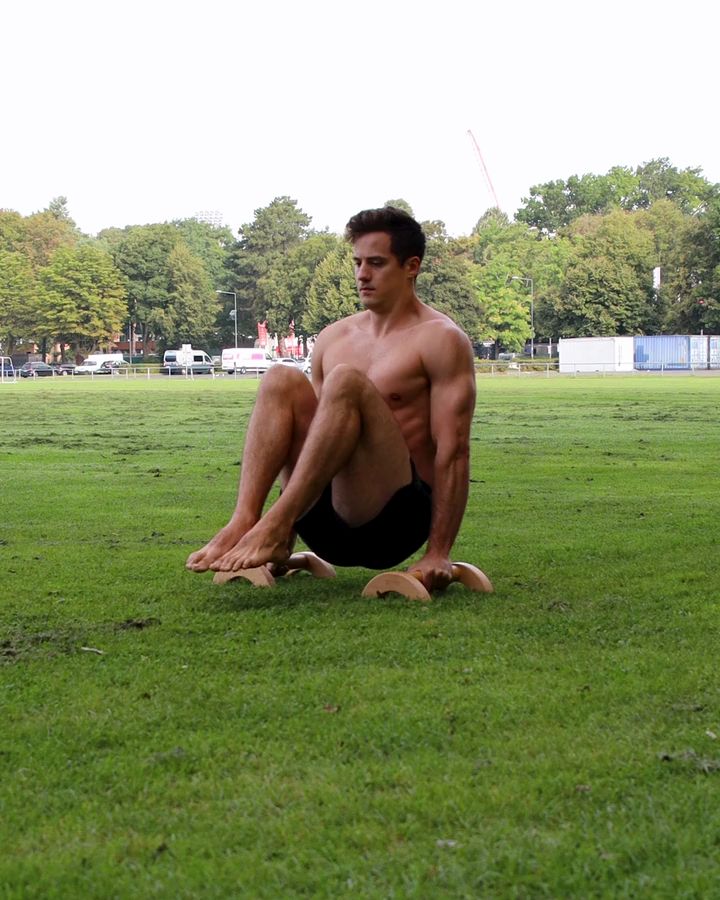
Tuck L Sit
The Tuck L Sit is an effective preparation exercise for the L Sit, helping you build the body tension and strength you need. While doing the exercise, the core muscles — especially the straight and side abdominal muscles — are very active. The triceps, the back part of the shoulders, and the hip flexors also work hard. This exercise also improves body tension, shoulder joint stability, and activates the deep stabilizing muscles.
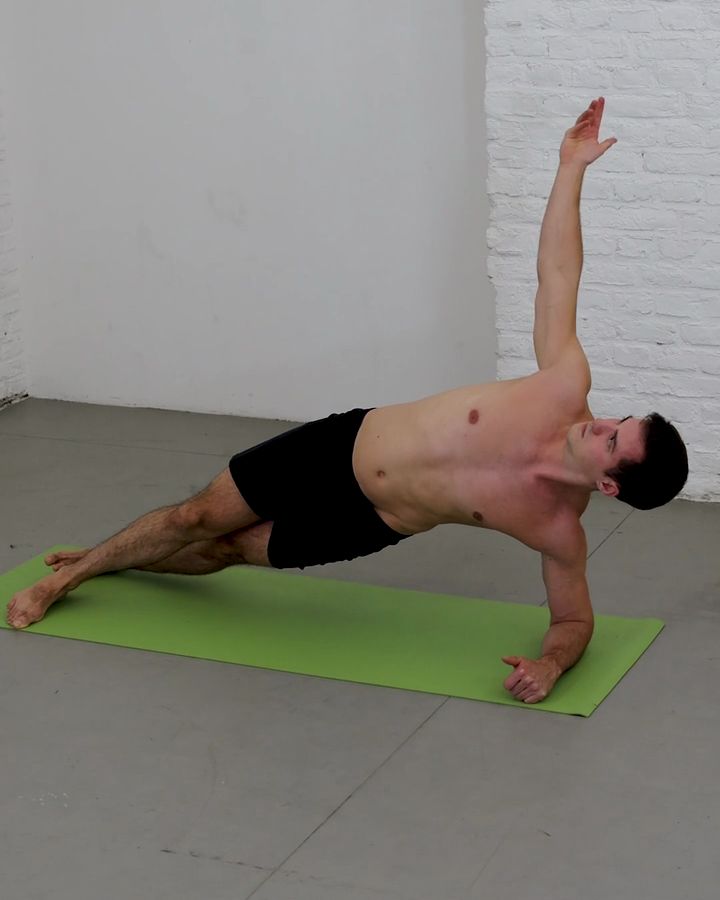
Side Plank Rotation
The Side Plank Rotation is a dynamic exercise that strengthens the oblique abdominal muscles. From the side plank position, you rotate your torso in a controlled manner to touch the floor with your elbow. This movement enhances core stability and spinal mobility. In contrast, the Static Side Plank involves holding the plank position without movement. Another dynamic variation is the Side Plank Crunches, which specifically train lateral flexion, the side bending of the spine.
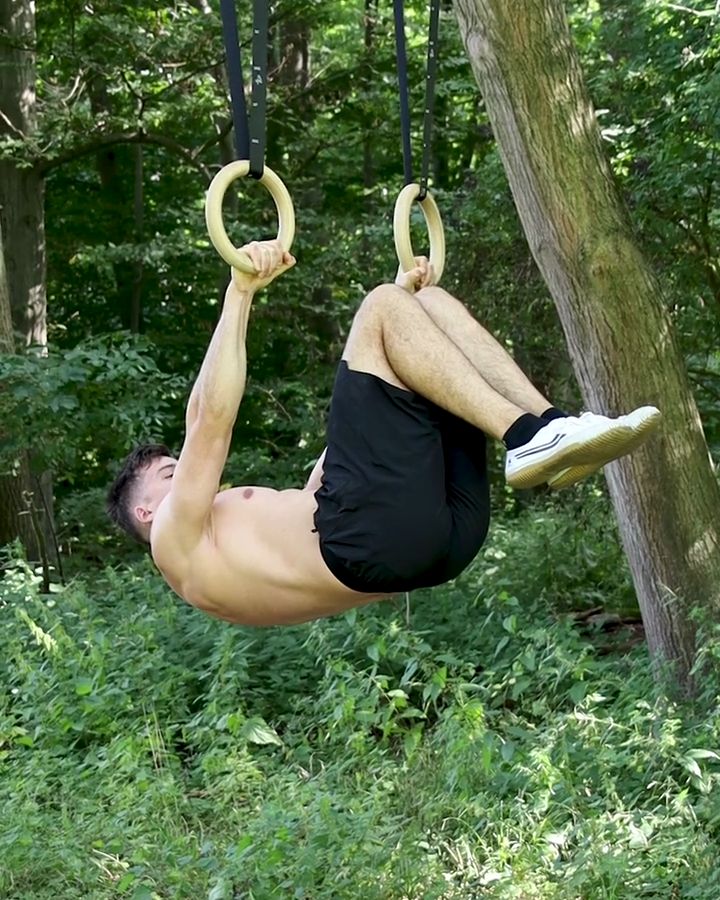
Advanced Tuck Front Lever with gym rings
The advanced tuck front lever is a preparatory exercise for the front lever that intensely engages the core and back muscles. Unlike the simpler tuck position, where the knees are closer to the chest, the legs in the advanced tuck remain only slightly bent. This adjustment changes the leverage, making the exercise more challenging and requiring more strength. The advanced tuck is an intermediate step between the tuck front lever and the single leg front lever.
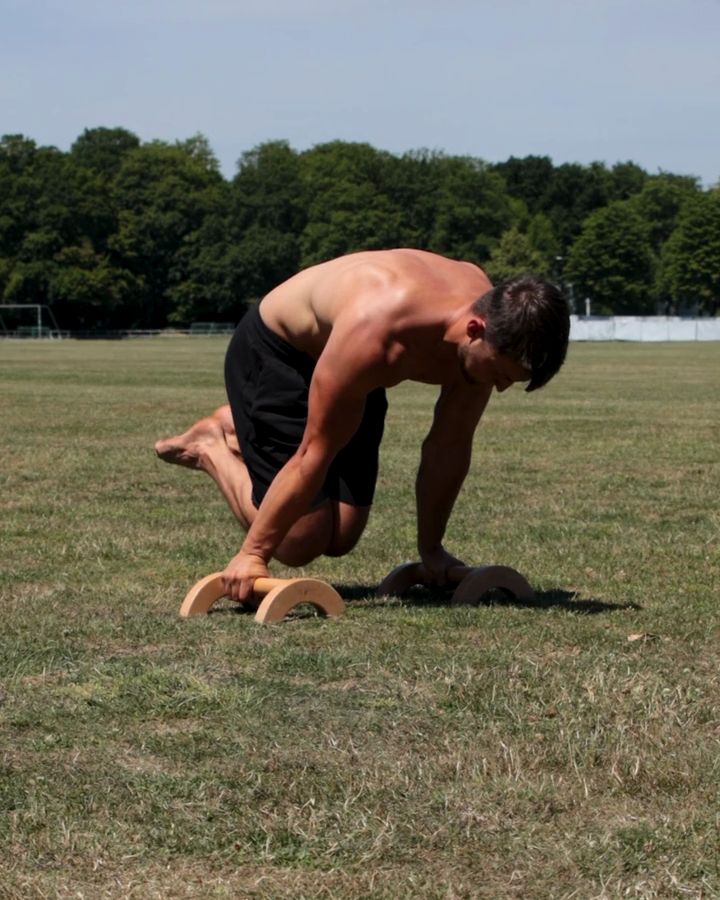
Advanced Tuck Planche with parallettes
The Advanced Tuck Planche is a challenging variation of the Planche. Compared to the basic Tuck Planche, where the knees are close to the chest, the legs in the Advanced Tuck are only slightly bent, which requires more strength and body control. This exercise serves as a transition to the Full Planche and is an important progression for calisthenics athletes looking to improve their Planche technique.
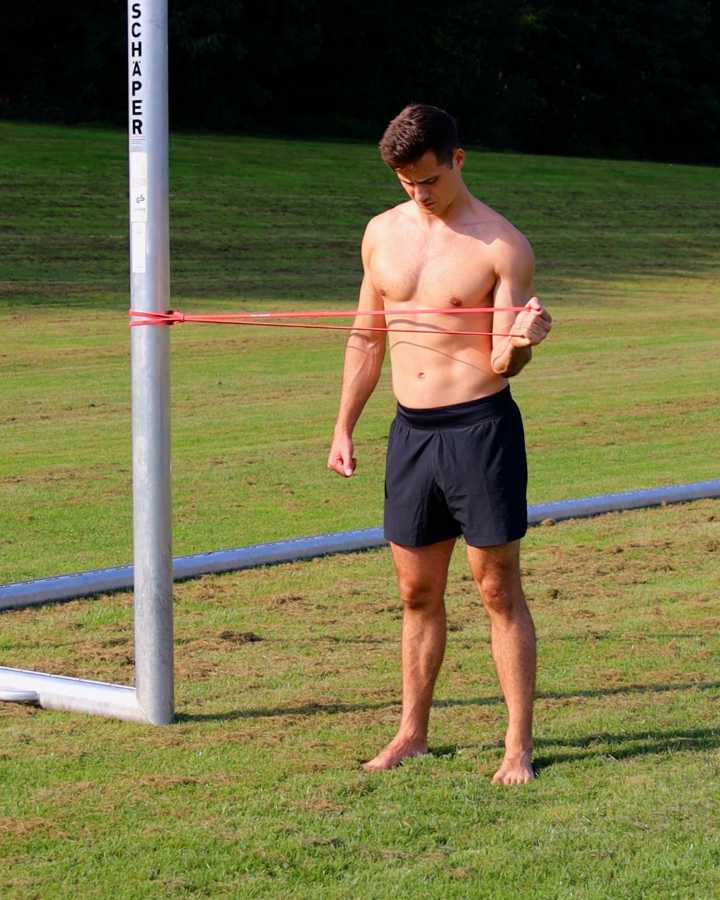
Banded External Shoulder Rotations with a Band
Band external rotations are an effective exercise for strengthening the rotator cuff, especially the external rotators (infraspinatus and teres minor), which rotate the upper arm outward in the shoulder joint (away from the body center, or backward). This exercise improves shoulder joint stability and helps prevent injuries. To perform it, anchor a resistance band at a fixed point, and with a 90° bend in the elbow, rotate the arm outward while keeping the upper arm close to the body. Band rotator training is an ideal complement to pressing exercises like shoulder presses or dips and is excellent as a warm-up before strength training or as an accessory exercise afterward. Alternatively, face pulls are also beneficial, as they similarly engage and strengthen the shoulder's external rotators.
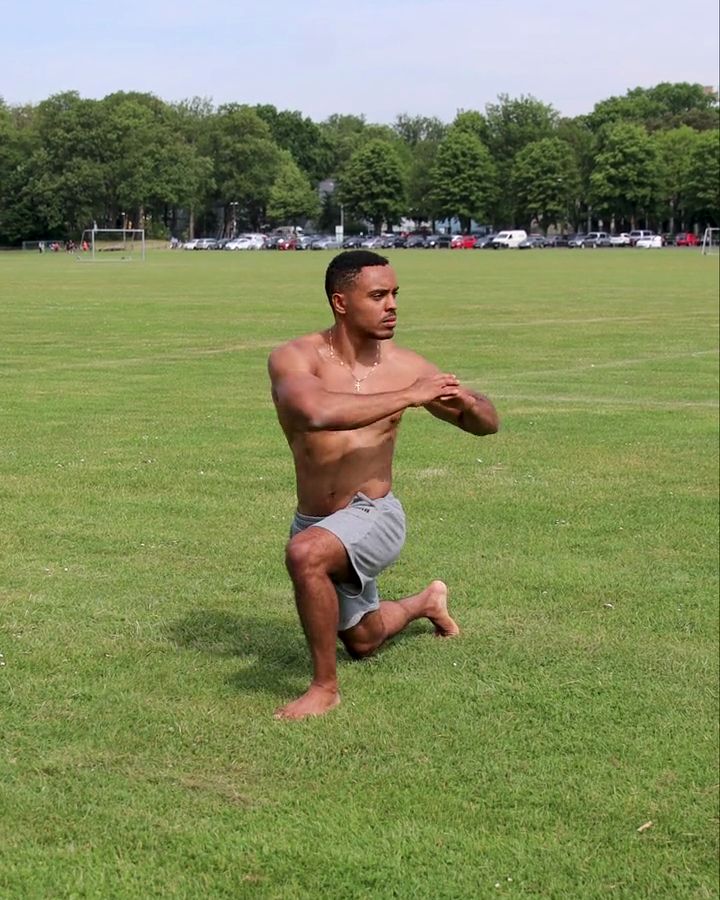
Lunge Rotation
The Lunge with Rotation combines the classic leg exercise with a torso twist, training not only the legs but also the abdominal muscles and spinal mobility. The main load is on the thighs and glutes, while the rotational movement specifically engages the core muscles. Compared to a regular lunge, this variation challenges stability more, as the added twist further tests balance.
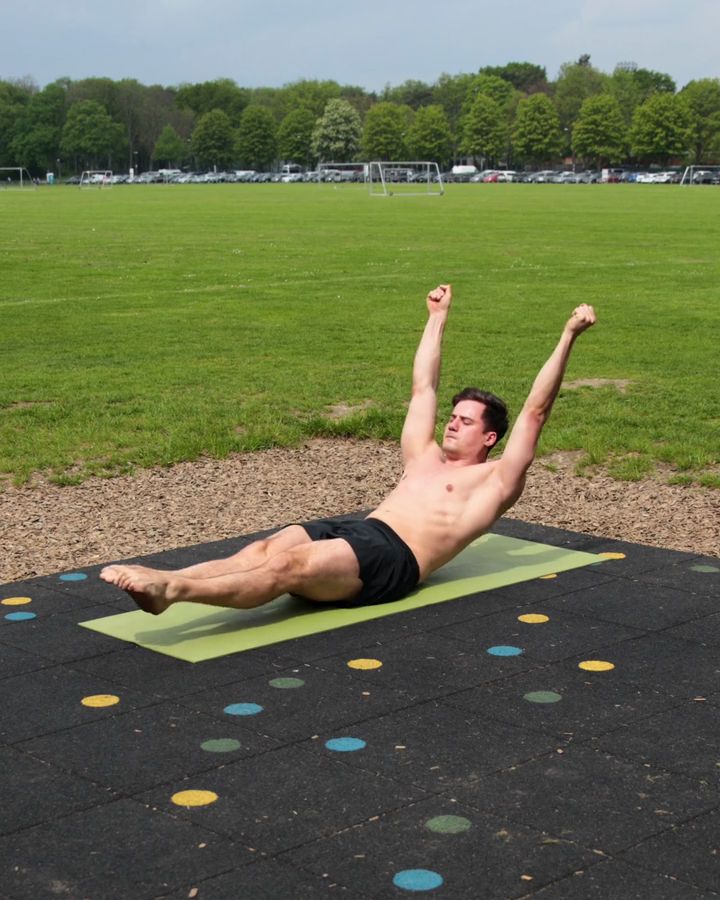
Hollow Body Rocks
Hollow body rocks are an effective core exercise in which the body performs rocking movements while maintaining a stable, curved position. This exercise primarily strengthens the abdominal muscles and is especially suited for sports like calisthenics or gymnastics, as it requires strong body tension and control. A good preparatory exercise is the hollow body hold, which is also often considered a foundation for handstand training.
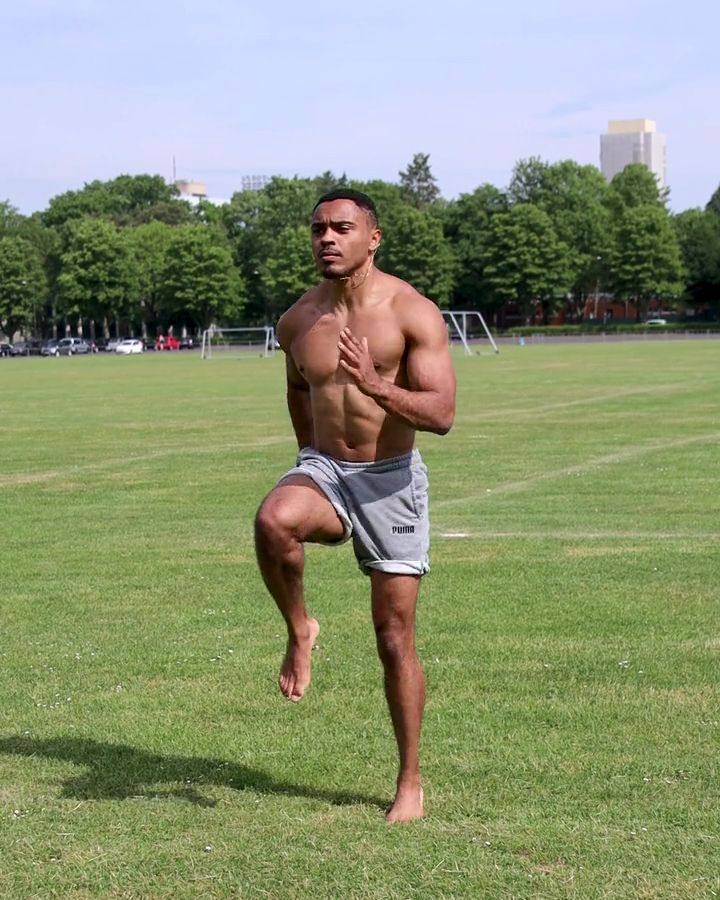
Knee Lifts
Knee Lifts also called High knees are a simple yet effective cardio exercise where you alternately pull your knees towards your chest in a controlled manner while standing in place. It is well-suited as a warm-up exercise to get the circulation going or as part of athletic training that includes running-specific drills.
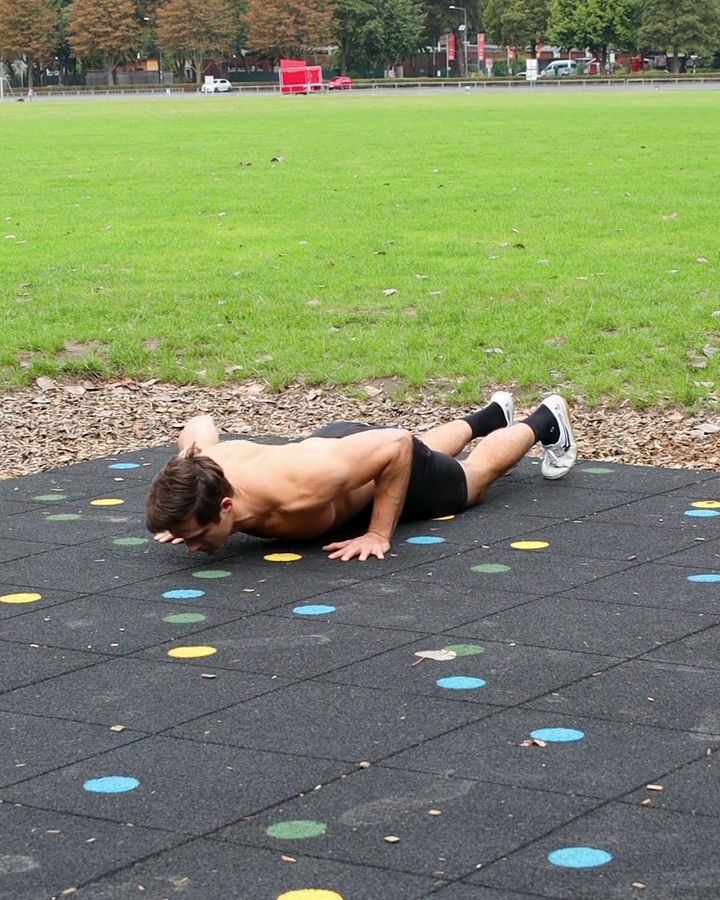
Kneeling Push Ups
Kneeling push-ups are a simplified version of classic push-ups, where the knees stay on the ground to reduce intensity. This exercise strengthens the chest, triceps, and shoulders and is especially suitable for beginners or as a gentle reintroduction after an injury. In addition, kneeling push-ups are an excellent preparatory exercise for regular push-ups: anyone able to do more than 20 clean reps can progress to the next level, negative push-ups. This helps build a solid foundation for gradually transitioning to classic push-ups.
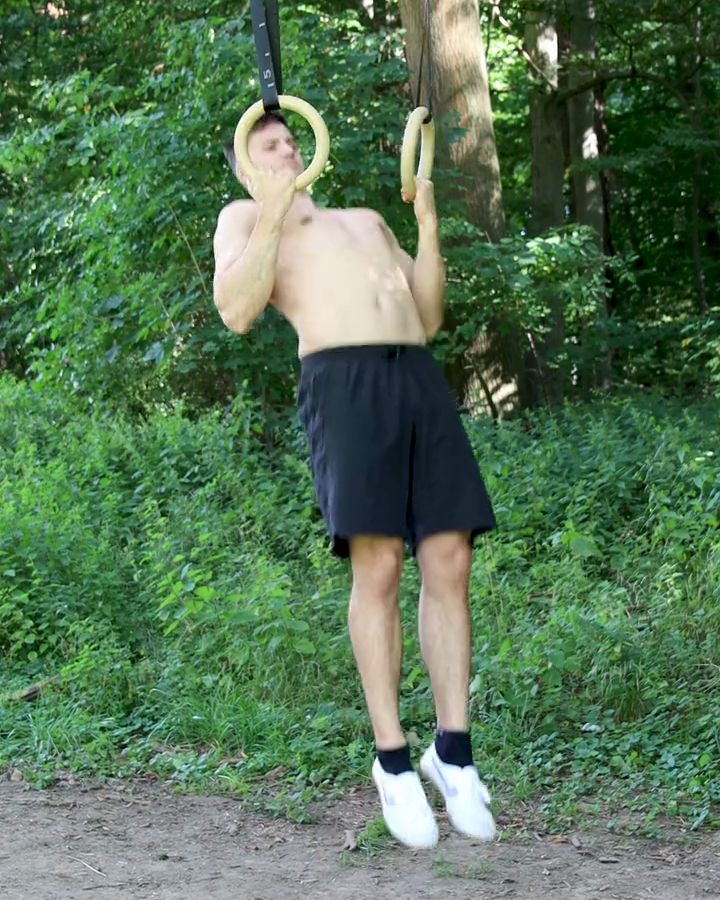
Chest Chin Ups with gym rings
Chest-to-ring pull-ups are a challenging variation of the classic pull-up, where the pull is performed until the chest reaches the rings. This exercise intensely engages the back muscles and biceps. The free movement of the rings allows for a grip position that is most comfortable for the athlete. This variation is ideal for advanced athletes looking to further develop their strength, body tension, and coordination. Chest-to-ring pull-ups are also a great preparation for more complex movements like the muscle-up.
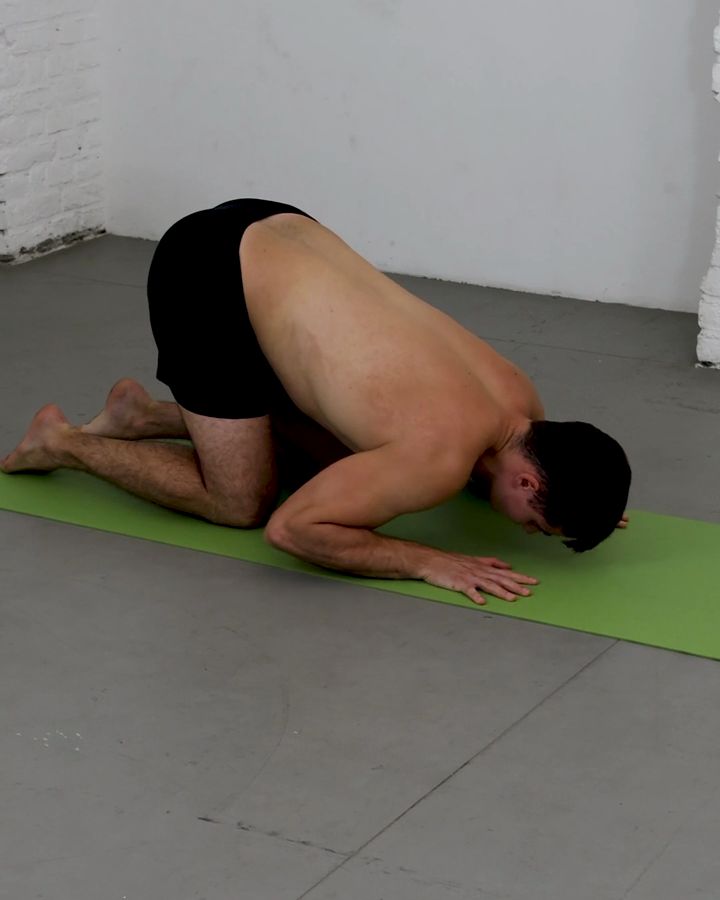
Elbow Push Ups
Elbow push-ups are an easier variation of the classic push-up and are mainly used as a warm-up and mobility exercise.
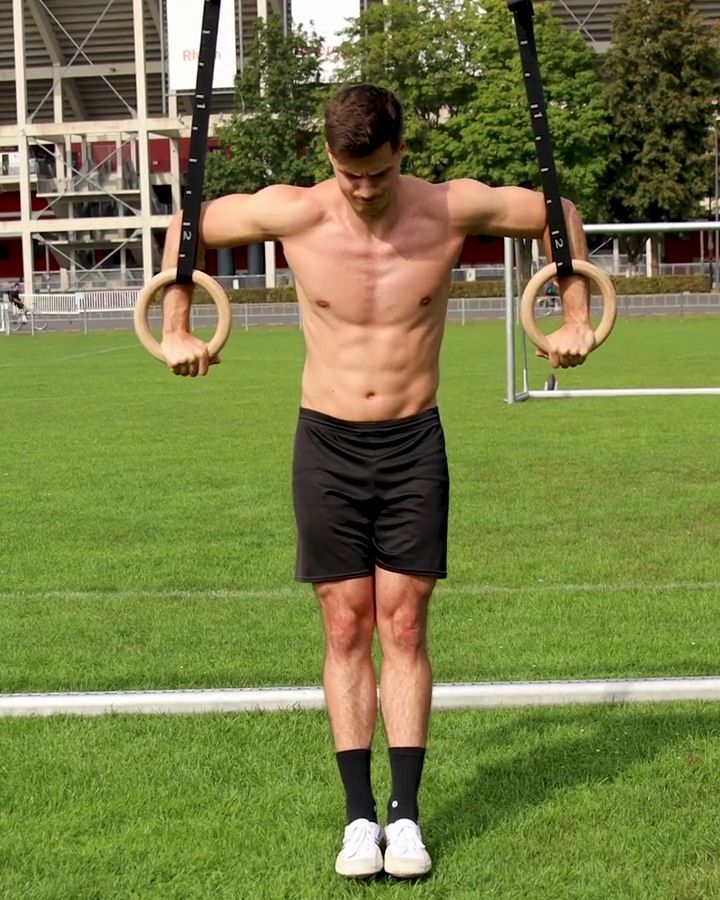
Bulgarian Dips with gym rings
Bulgarian ring dips are a challenging exercise that intensely targets the chest muscles. Compared to regular bar dips, the rings allow for a greater range of motion, leading to a deeper stretch of the chest. The upper arms are brought further outward, which intensifies the chest stretch even more. This exercise is an advanced variation of the classic ring dips.
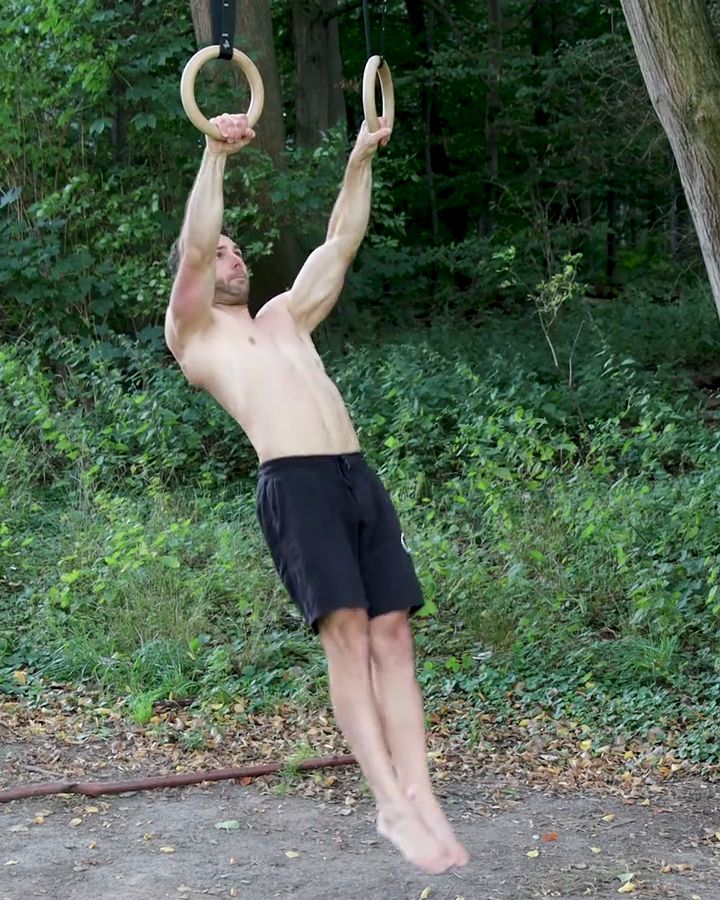
Front Lever Pulls with gym rings
Front lever pulls intensely strengthen the back, triceps, and core. In this exercise, the body is repeatedly pulled from a hanging position through the horizontal front lever position up to an inverted hang—a movement that requires tremendous body tension and strength. This exercise is one of the most challenging straight-arm pulling exercises and is an important component of training for the front lever.
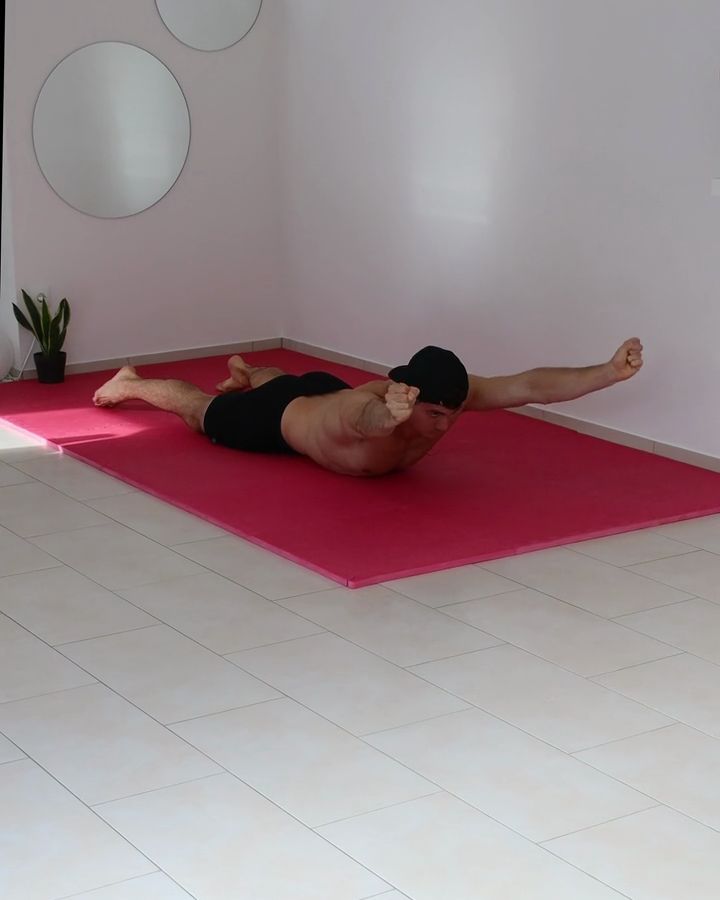
Superman Rocks
Superman Rocks is an exercise that focuses on strengthening the upper and lower back muscles, particularly the spinal extensors. You lie flat on your stomach and simultaneously lift your chest and arms to achieve a "flying" position. This exercise can help improve posture. A similar exercise is the Superman Exercise. In this variation, you remain in the flying position but do not lift the arms in front of the body.
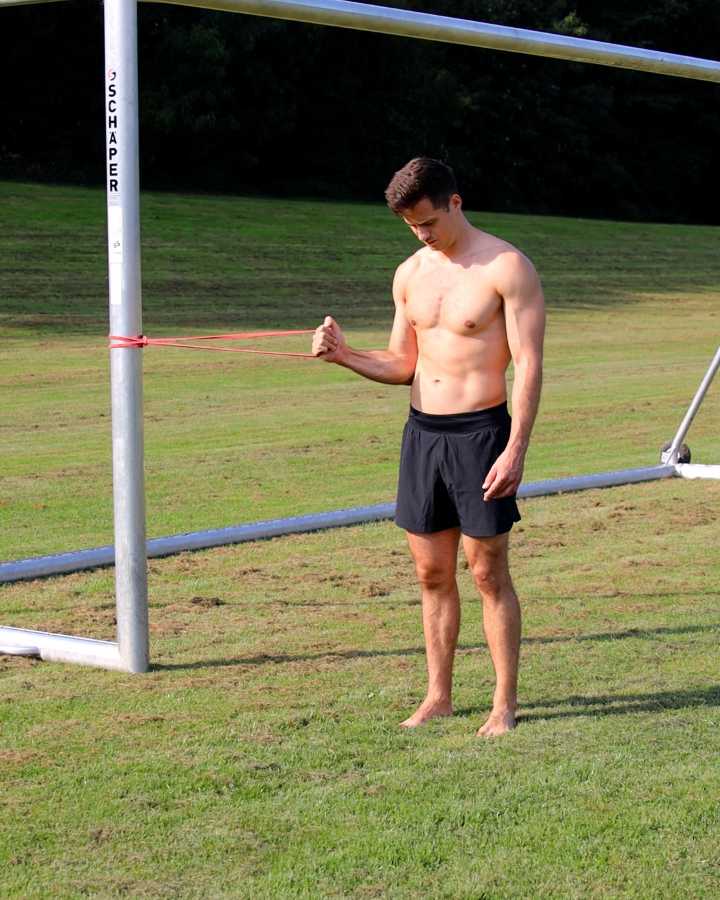
Banded Internal Shoulder Rotations with a band
The shoulder exercise Internal Rotations with a band is designed to specifically strengthen the rotator cuff, especially the internal rotators. This exercise trains the internal rotation of the shoulder joint against resistance, improving the strength and control of the shoulder muscles. A similar exercise is the external rotation with a band. This exercise targets the external rotators of the shoulder (mainly the infraspinatus and teres minor muscles), which act as antagonists to the internal rotators.
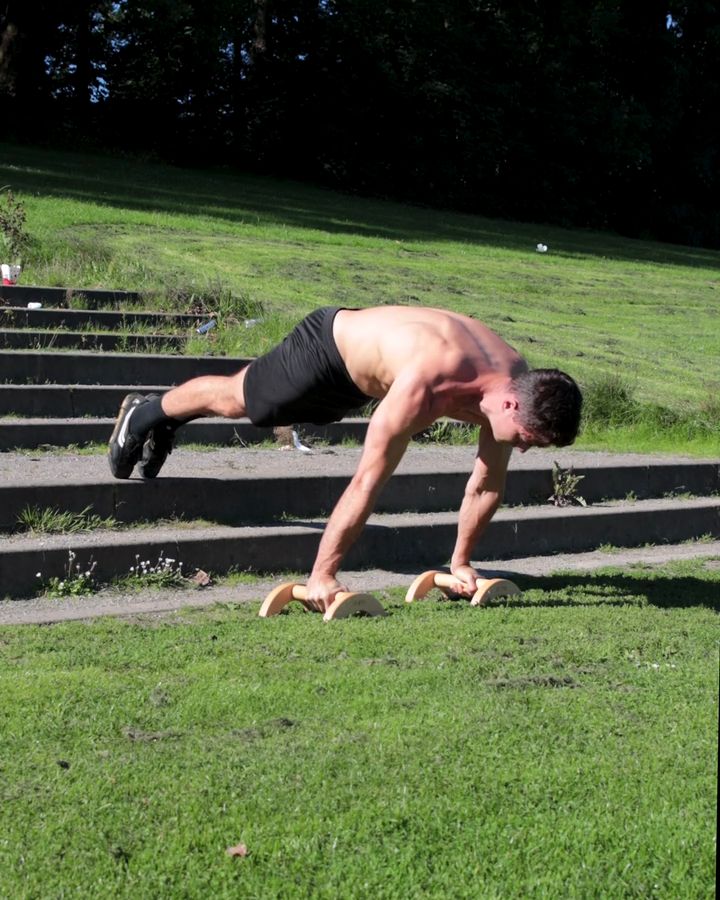
Elevated Planche Lean
The Elevated Planche Lean is a challenging variation of the Planche Lean designed to prepare for the Planche. In this exercise, the feet are elevated, making it more demanding as more body weight is supported by the arms. Parallettes can reduce strain on the wrists and provide a more stable grip.
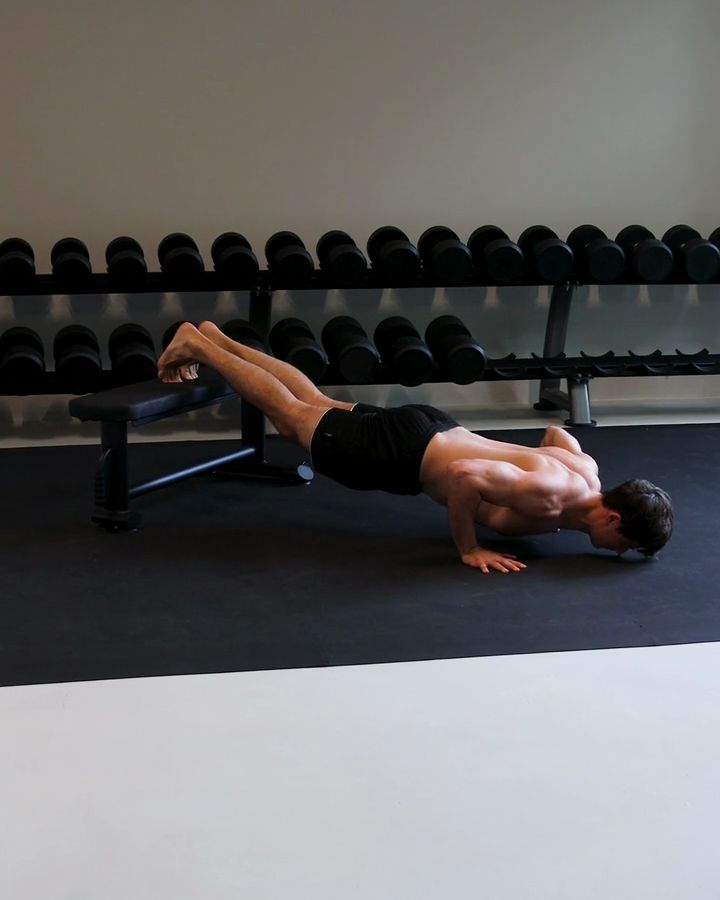
Push Up for upper chest
When you elevate your feet during push-ups, you shift the training focus more toward the upper part of your chest muscles. This version is similar in how it works your muscles to the incline bench press, which has been proven to stimulate the upper chest more effectively than the flat bench press. Even without extra weight, this variation is harder than regular push-ups, because the new angle makes you use more strength. At the same time, it stays easy on your joints and is very versatile. It’s perfect for anyone who wants to train their upper chest — even without equipment. Use the intensity of this version to push closer to muscle failure and support muscle growth.
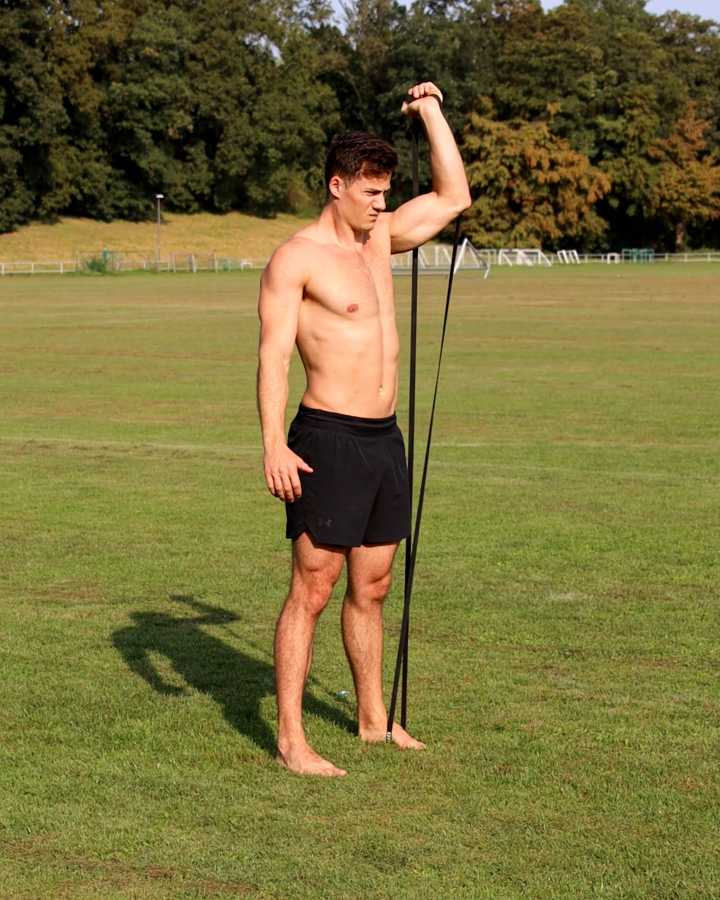
Banded Shoulder Press with a band
The shoulder press with a resistance band is an effective exercise for strengthening the shoulder muscles, especially the front shoulders. The band is anchored under the feet while the arms are stretched upwards. Unlike the classic shoulder press with dumbbells, the resistance band provides variable resistance, which challenges the muscles more intensively, especially in the final phase of the movement. Additionally, it activates the core muscles more since the band's instability requires greater balance and stability in the upper body. This variation is excellent for flexible training, as it requires little equipment and can easily be adjusted to different difficulty levels.
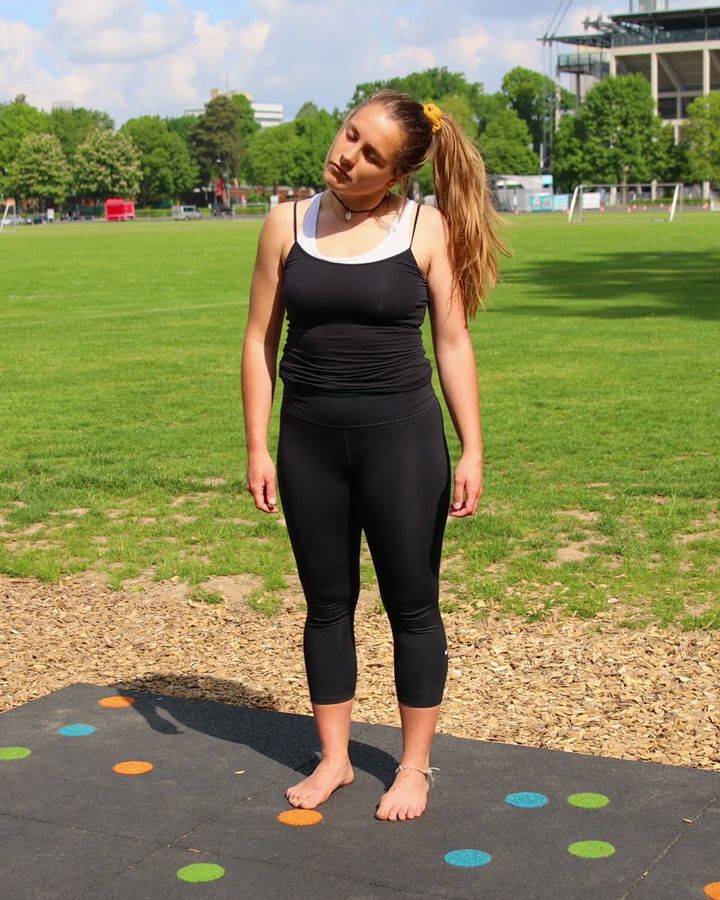
Head Cars
Head CARs (Controlled Articular Rotations) improve neck mobility and strengthen the surrounding muscles. The head is moved slowly and in a controlled manner in all directions – forward, backward, to the sides, and in rotation. This exercise supports joint health, promotes coordination, and helps relieve tense muscles. Spine CARs follow the same principle but involve the entire spine. By consciously moving individual sections, flexibility is improved, posture is stabilized, and the back muscles are activated. Regular practice ensures a supple and resilient spine.
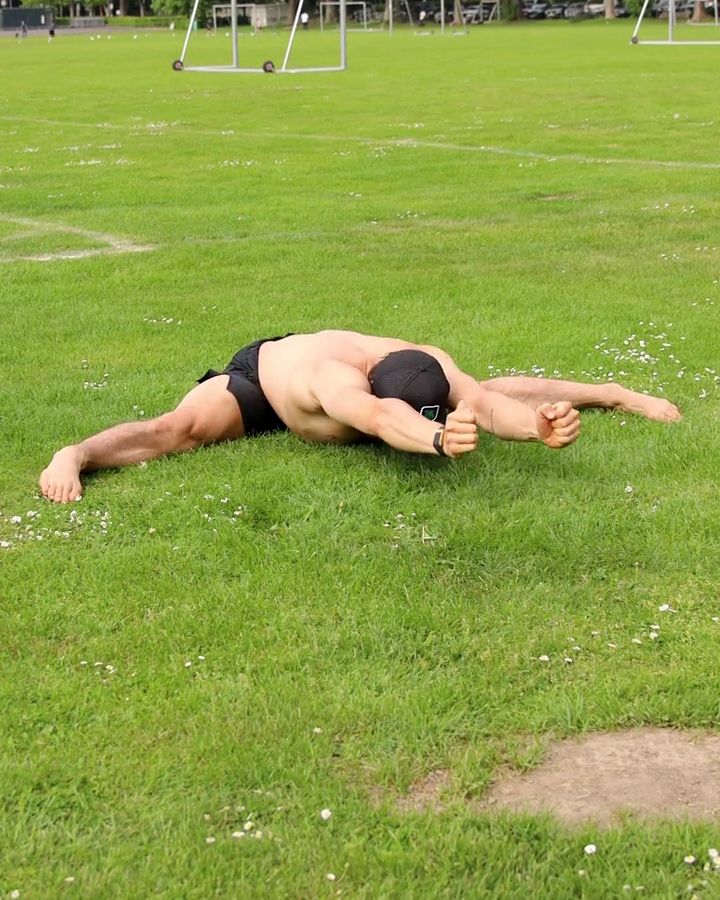
Pancake Good Mornings
Pancake Good Mornings strengthen and mobilize the posterior chain, especially the lower back, glutes, and hamstrings. This exercise combines the forward bend of the Pancake Stretch with the hip extension of classic Good Mornings. It’s particularly useful for improving hip and hamstring flexibility and is an advanced version of regular Good Mornings, as it requires greater mobility.

Quadruped Scapular Push Ups
The Quadruped Scapular Push-up is an exercise that mainly trains the muscles around the shoulder blades. You start in a hands-and-knees position and move your shoulder blades together and apart on purpose, without bending your arms. This controlled movement helps improve the stability and mobility of the shoulder blades. A similar exercise is the Scapula Rows, which trains the opposing muscles of the movement.
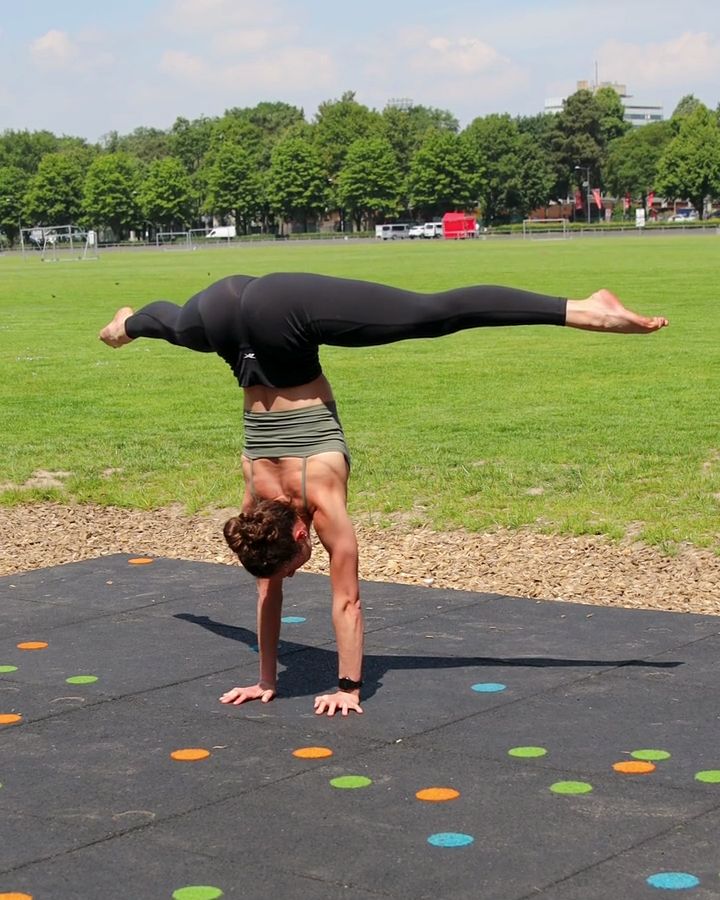
Straddle Handstand
A straddle handstand is a handstand variation where the legs are spread apart in the air. It can be argued that this form of handstand is easier to balance than the handstand with closed legs, as spreading the legs lowers the body’s center of gravity. A lower center of gravity, closer to the ground, makes balancing easier because small adjustments in position have less impact on stability. The straddle handstand serves as a foundation for advanced handstand exercises like the Straddle Press Handstand. Beginners can practice the straddle handstand with support from a wall or a spotter to develop a safe sense of balance.
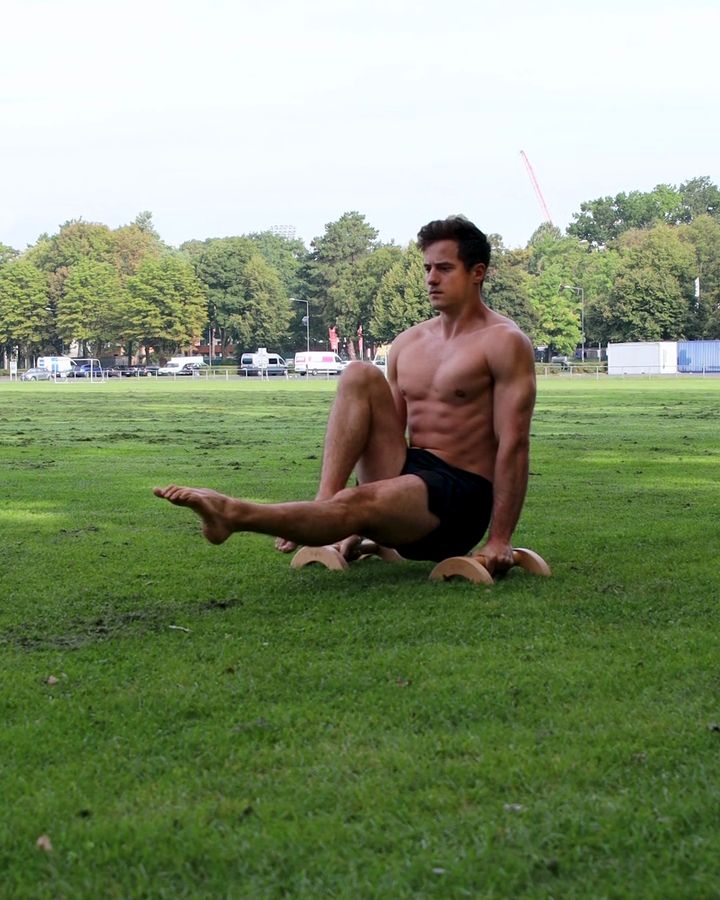
One Leg L Sit
The One-Leg L-Sit on the parallettes is a challenging exercise that primarily targets the abdominal muscles, hip flexors, and supporting muscles. In this exercise, the athlete assumes an L-position, keeping one leg straight while bending the other. It requires a high level of body tension, strength, and balance. The one-legged variation serves as a preparatory exercise for the classic L-Sit, where both legs are extended. Holding this position engages the abdominal muscles even more intensely. An even easier progression is the Tuck L-Sit, where both legs are bent and pulled close to the body. This reduces the lever arm, making it easier to hold the position while still engaging the core and supporting muscles.
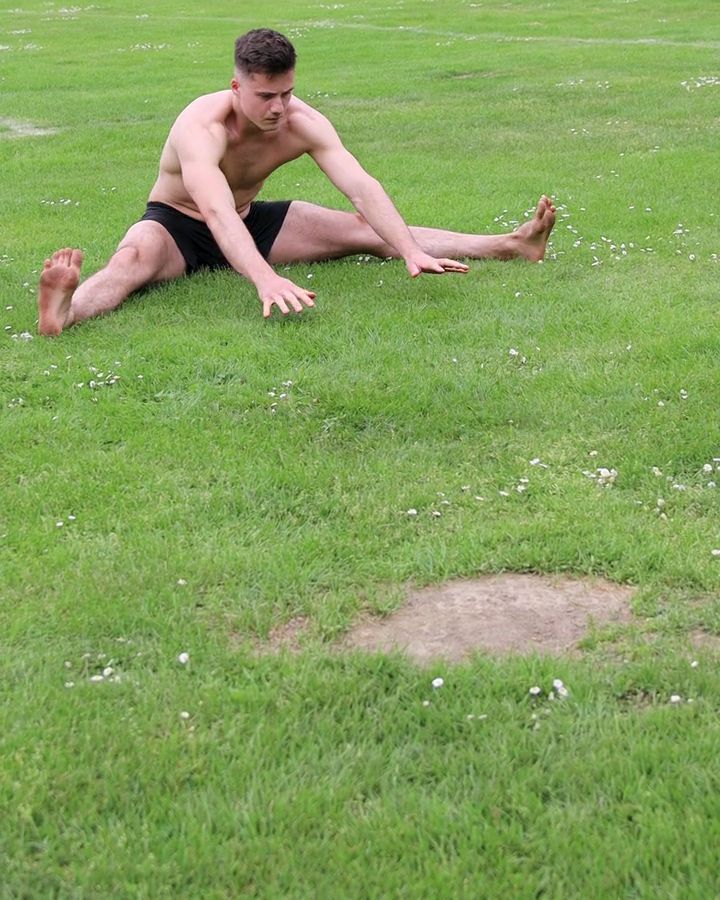
Pancake Walk
Pancake Walks on the hands enhance flexibility in the hips and hamstrings. The exercise starts in a wide-legged forward fold, similar to the Pancake Stretch. You move forward, using your hands for support, and straighten up as you go. This allows you to work within your current range of motion in the hips and hamstrings. This exercise is a great preparation for both the Pancake and the Pancake Good Morning.
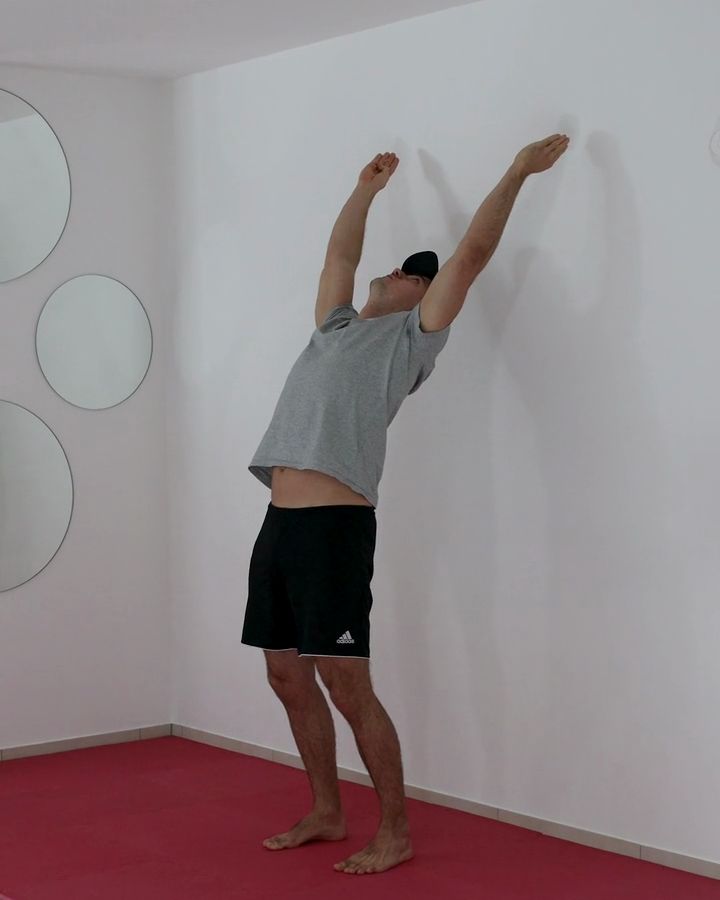
Standing Backbend
The Standing Backbend, known as the "Backbend" and as "Anuvittasana" in yoga, is an exercise where the upper body is bent backward. It is an essential part of yoga practice, as it enhances spinal mobility and strength, improves posture, and provides numerous physical and mental benefits. Backbends stretch the chest and abdominal muscles, strengthen the back muscles, and stimulate key areas in yoga, such as the respiratory muscles and digestive system. When performed correctly, they can alleviate back pain, deepen breathing, and improve the flow of energy throughout the body. Myths like "backbends worsen a swayback" or "are unsuitable for older adults" are false. Backbends are accessible to everyone and highly beneficial. A more advanced variation of backbends is the bridge, which many recognize from gymnastics. With mindfulness and patience, you can gradually work toward this more intense exercise to increase flexibility and strength over time.
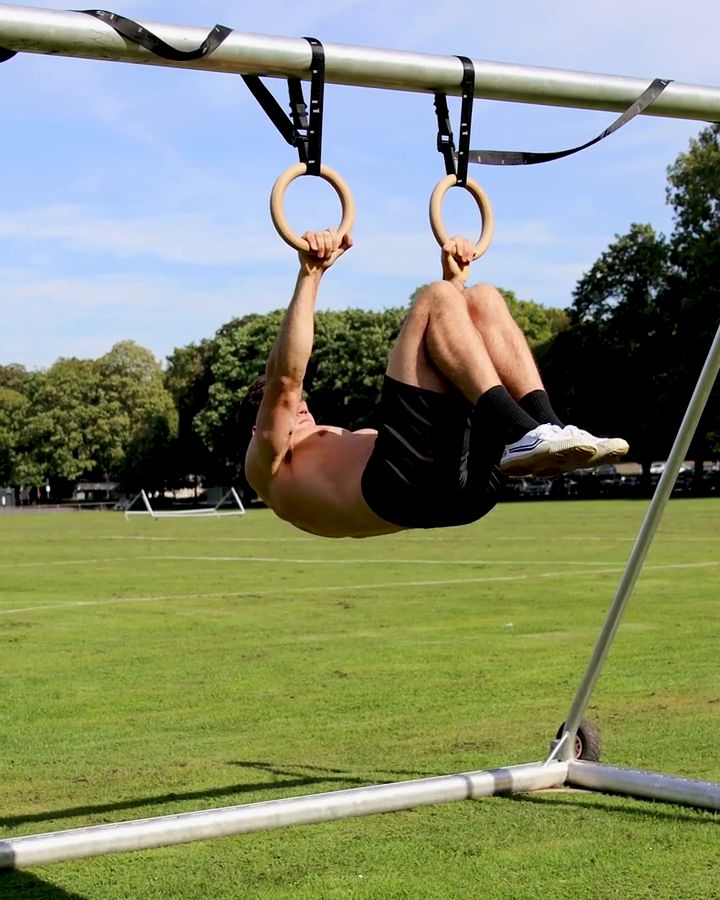
Negative Tuck Front Lever with gym rings
The Negative Tuck Front Lever is a variation of Front Lever Pulls, where you pull from a dead hang into an inverted hang on the rings and then slowly lower back to the hang in the Tuck Front Lever position. This exercise takes advantage of the fact that muscles are stronger in the eccentric phase than in the concentric phase, as explained here: [Eccentric Muscle Training](https://dieringe.com/blog/eccentric-muscle-training). It allows you to train the Front Lever position even if you don’t yet have the strength to hold it statically. The Negative Tuck Front Lever is an excellent preparatory exercise for the Front Lever Pull.
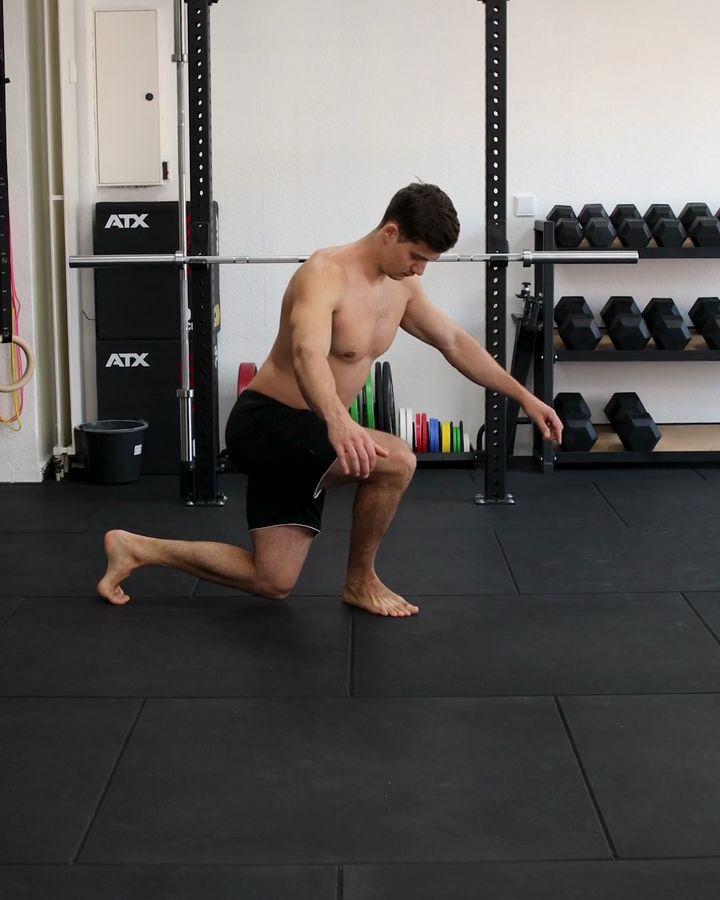
Curtsey Lunges
Curtsey lunges are a variation of the classic lunge, where the back leg is crossed behind the body. This movement particularly targets the outer thighs and glutes, especially the side glute muscles. The crossing motion also promotes knee joint stability and improves coordination. Compared to the normal lunge, curtsey lunges work the side muscle groups more intensively, making them an effective exercise for balanced leg training.
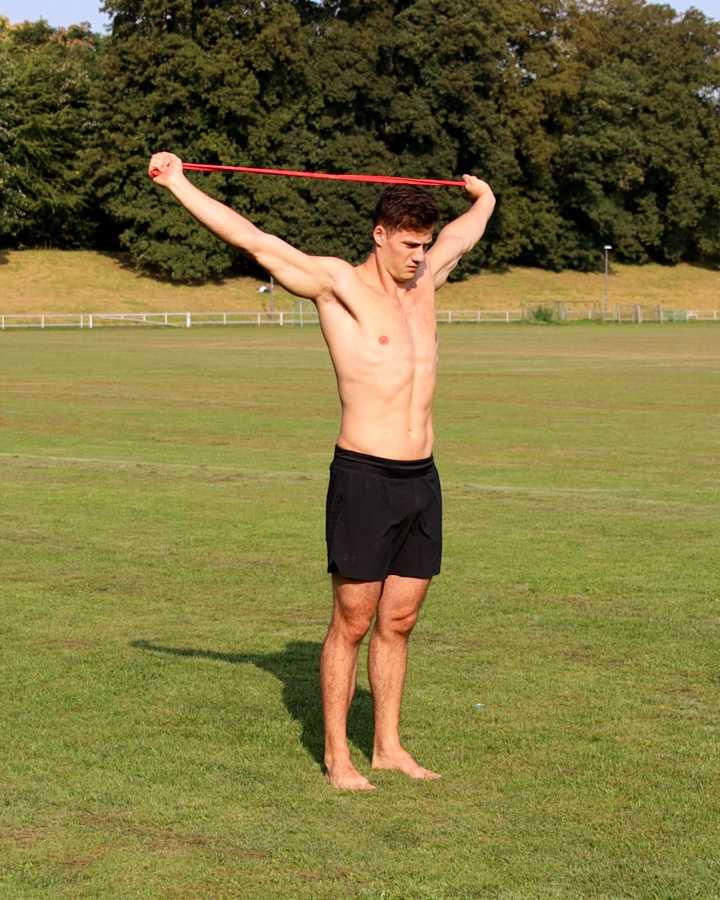
Banded Shoulder Dislocates
Arm Circles with a Band, also known as Banded Shoulder Dislocates, are a warm-up and mobility exercise that specifically targets stretching in the front shoulders and chest. As the shoulders circle, the band stays under tension, leading to an especially deep stretch in the shoulders and chest when the band is pulled behind the head. This exercise is ideal for warming up or promoting shoulder health and can be used as an alternative or addition to classic Arm Circles forward or backward without a band.
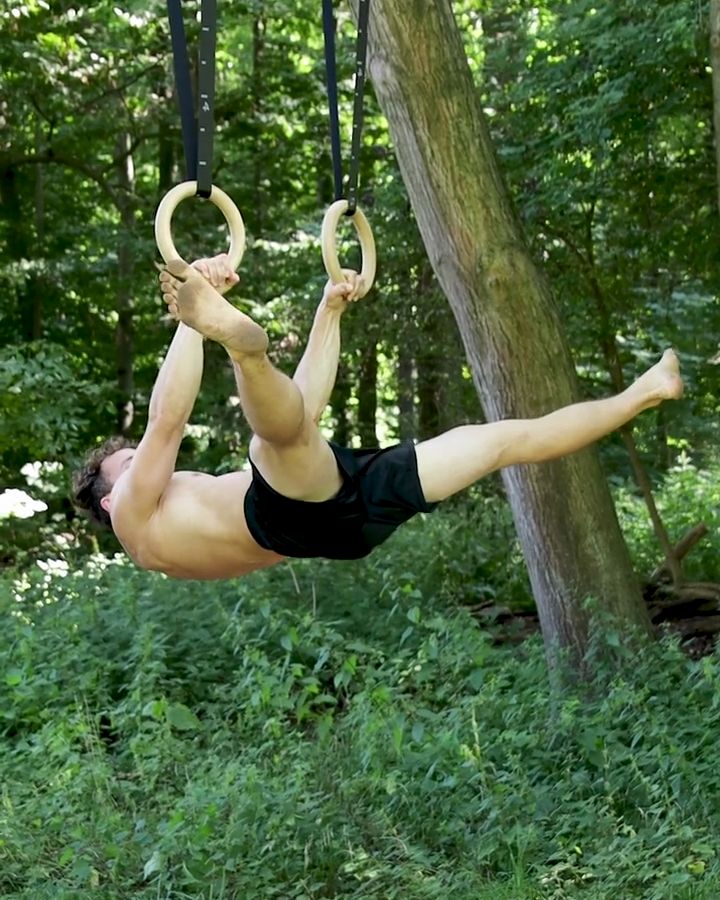
Straddle Front Lever
The Straddle Front Lever on the gymnastic rings is a challenging full-body exercise that primarily engages the core and back muscles. In this position, the body is held parallel to the ground while the legs are spread apart. This reduces the leverage compared to the fully extended version, making balance easier, but it still requires significant body tension and core strength. An easier alternative is the Tuck Front Lever, where the legs are bent. This variation is especially suitable for beginners, as it shortens the leverage further and reduces the strain. For advanced athletes, the Full Front Lever presents the greatest challenge. In this version, the body remains fully extended, demanding maximum strength and stability in the core and back.
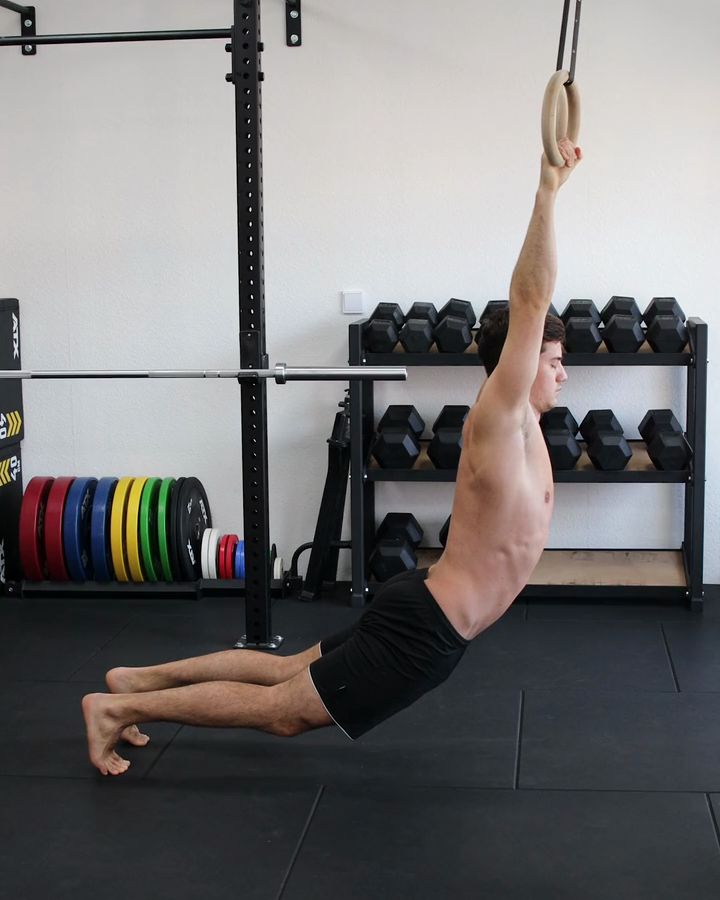
Cobra Pose Strech with gym rings
The cobra stretch on gymnastic rings is a variation of the classic cobra stretch, using the rings to support and intensify the stretch. This exercise mobilizes the spine and stretches the shoulder and chest muscles, making it especially beneficial for people with sedentary jobs. By performing it on the rings, the shoulders and chest can be stretched at an angle that isn’t possible with the traditional cobra push-up on the floor.
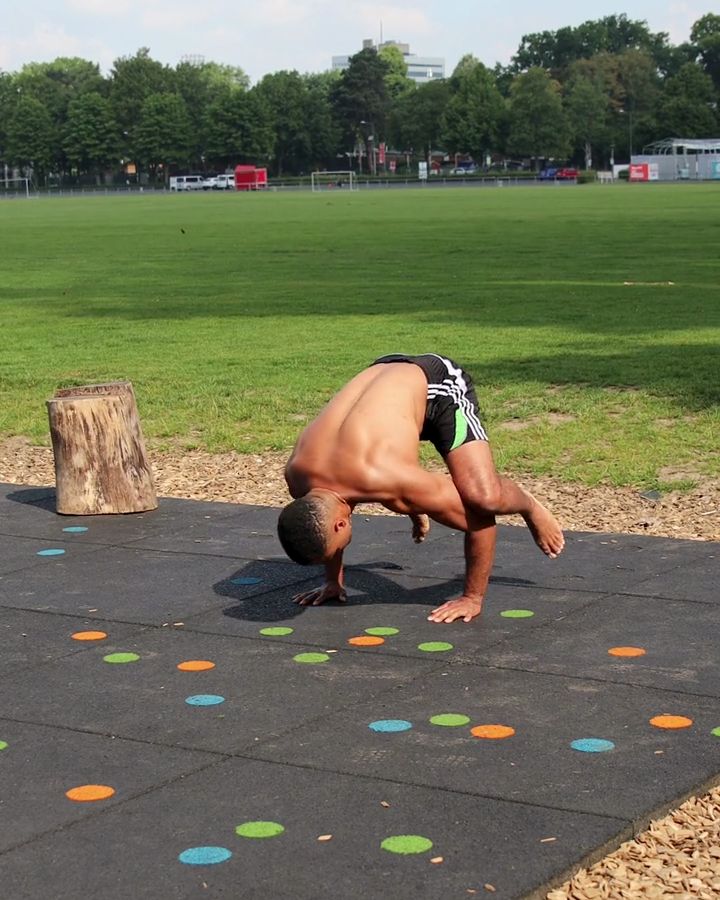
Crow / Frog to Handstand
The Crow to Handstand, also known as the Frog to Handstand, is a more challenging version of the Crow Pose because you push up from the Crow position into a handstand using the strength of your shoulders and arms. This transforms the balance exercise into one that requires significant upper body strength and is suited for advanced practitioners.
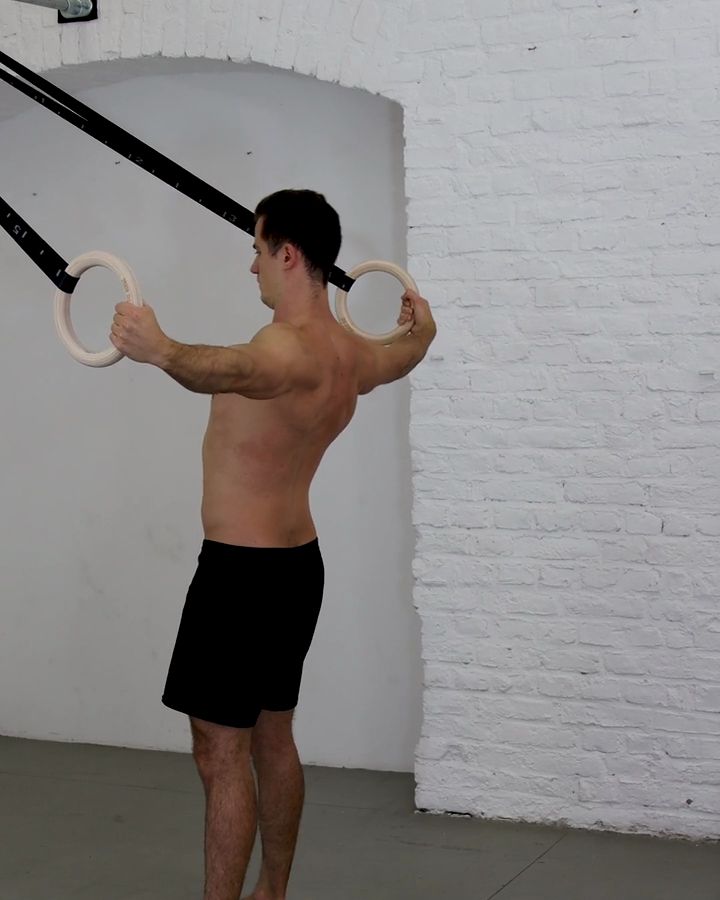
Butterfly Row with gym rings
Butterfly Row on the gymnastic rings is an effective exercise for the upper back and rear shoulders. A similar exercise is the Butterfly Reverse with Dumbbells, where the dumbbells are moved out to the sides. This variation allows for easy resistance adjustment by increasing the weight. When performing the exercise on gymnastic rings, you can change the intensity by moving forward or backward, which affects how much body weight you have to lift.
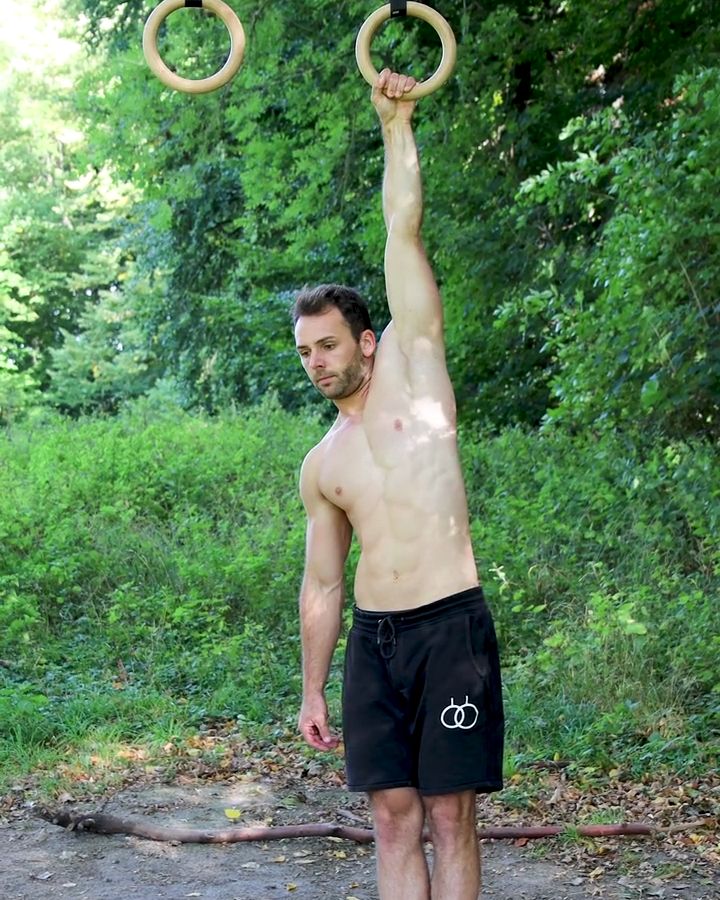
One Arm Hang with gym rings
The one-arm hang is an advanced exercise for strengthening grip strength. Compared to the classic hang with two hands, it demands significantly more forearm strength, as the entire body is supported by just one arm. This exercise not only improves grip strength but also strengthens the shoulder muscles, which play a key role in balancing the body. The one-arm hang is an excellent preparation for more complex exercises like the one-arm pull-up and can be performed in various positions, such as active or passive hanging, to target different muscle groups.
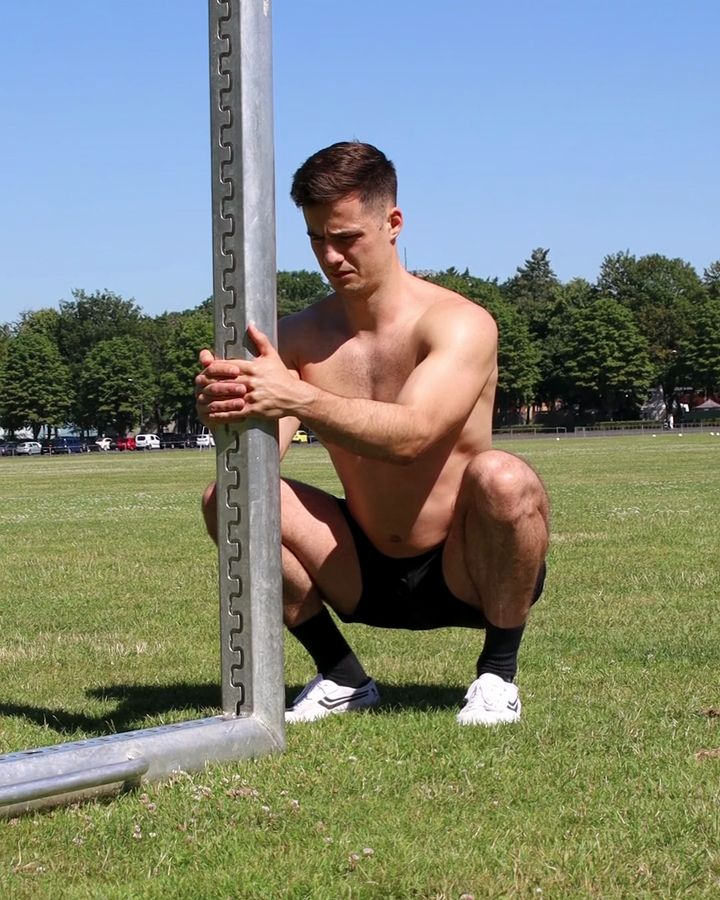
Supported Deep Squat
The supported deep squat is ideal for practicing the deep squat when mobility is lacking. Limitations in the ankles and hips often make it difficult to keep the heels on the ground. Using a stable object for support helps stabilize the position and gradually improve it. This variation is especially suitable for beginners, as it promotes mobility and flexibility. Even those who cannot yet perform the deep squat can use this method to slowly increase their range of motion. Regular practice strengthens the joints and improves mobility in the hips, knees, and ankles—building a healthy foundation for greater freedom of movement.
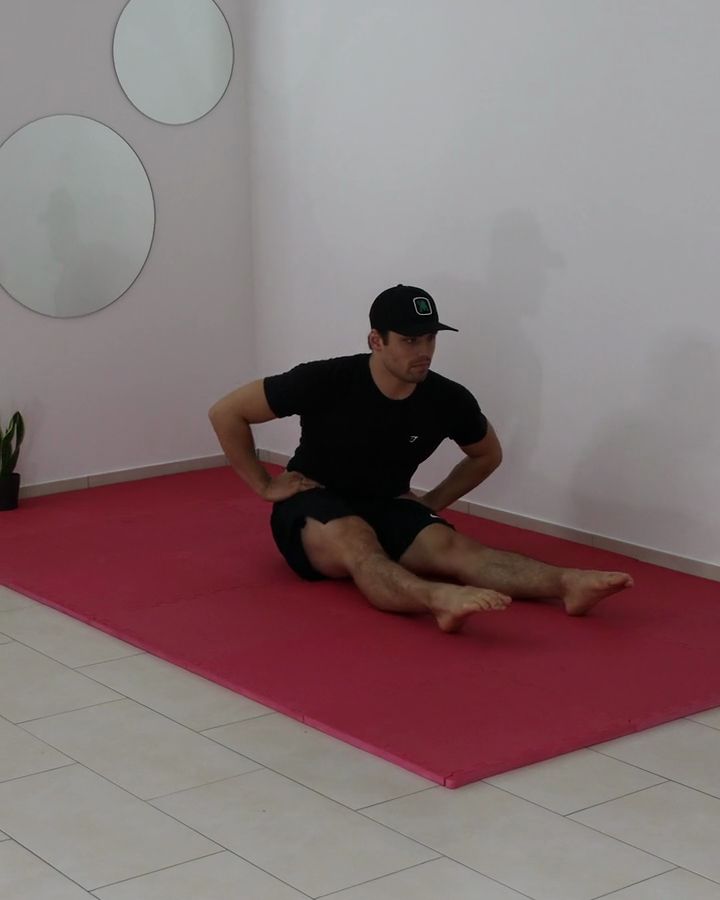
Hamstring Walk
The Hamstring Walk is a mobility exercise that’s not often seen. It mobilizes and strengthens the entire lower body, especially the muscles around the hips and lower back. You sit with your legs extended and try to move forward and backward by lifting your legs. The exercise looks easier than it is—after just a few repetitions, you’ll feel how challenging it is. The Hamstring Walk is often used to prevent lower back pain or to relieve blockages, as the many small, intense movements specifically mobilize the hips and lower back.
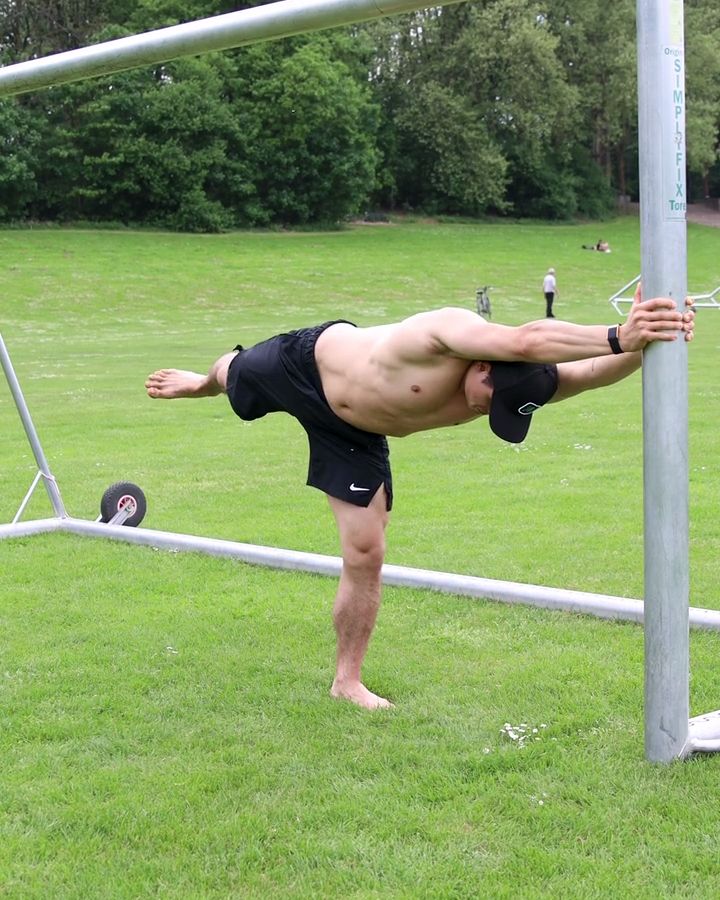
Hip Airplane
The Hip Airplane is an effective exercise to improve mobility and stability in the hips. It especially helps with symmetry in hip rotation, which is important for avoiding imbalances during strength training. The exercise can be adjusted as needed: to enhance mobility, lower the pelvis to promote internal hip rotation; for stability, work on controlling the single-leg stance. The Hip Airplane can be used as preparation for squats or deadlifts or as active recovery on rest days. Thanks to the rotational plane, the exercise targets muscle groups that are often neglected in traditional strength exercises.
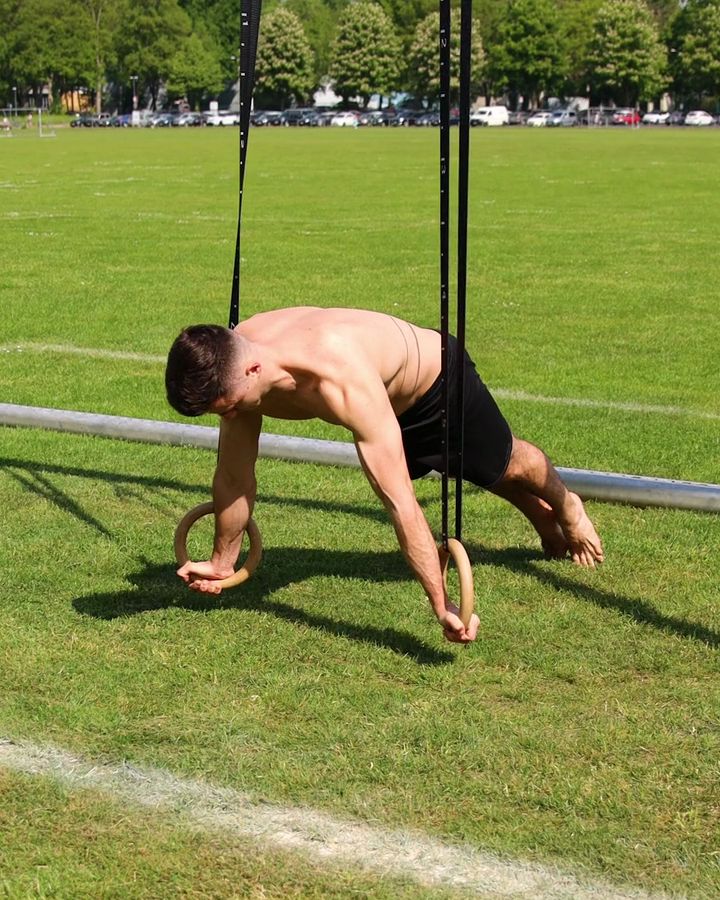
Pseudo Planche Lean with gym rings
The Pseudo Planche Lean, also known as the Pseudo Planche Hold, on gymnastic rings strengthens the biceps and front shoulders and prepares you for advanced skills like the Planche. Hold the rings shoulder-width apart, rotate them slightly outward, and lean forward in a controlled manner. Engage your biceps to protect your elbows, and gradually increase the lean angle as your strength improves.
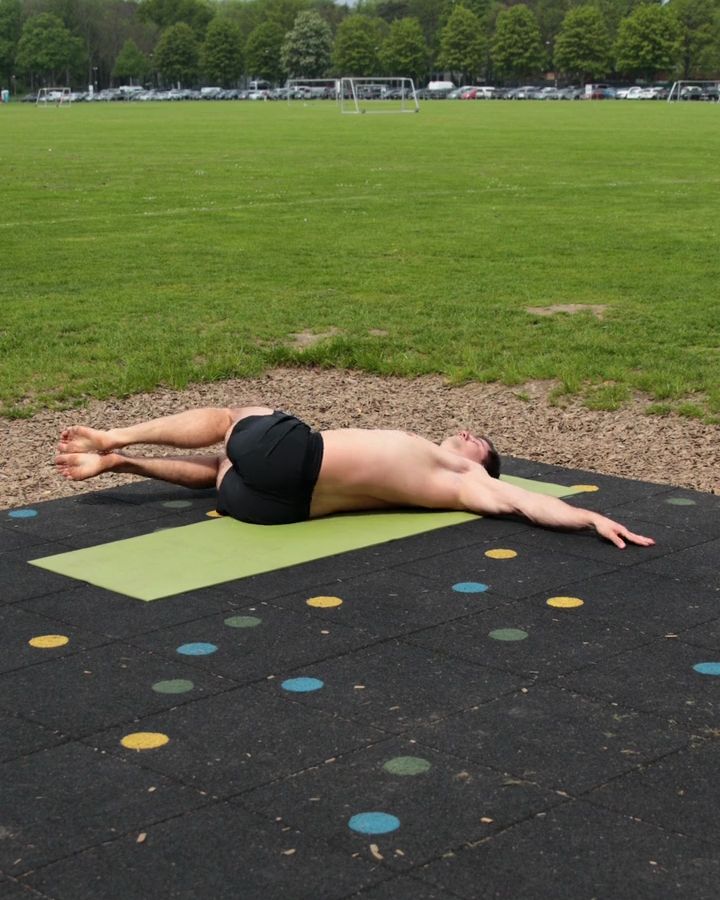
Knee Wipers
Knee wipers are an exercise that targets the core muscles, especially the obliques. You lie on your back, stretch your arms out to the sides, and slowly move your bent legs from one side to the other. This movement not only improves core stability and flexibility but also strengthens the connection between the abdominal and back muscles. It's important to keep your shoulders on the ground throughout the movement to maintain proper form and focus on the abdominal muscles. The motion should be performed in a controlled manner to effectively activate the muscles and prevent injuries. Russian Twists are a similar exercise, as they also train the obliques. In this exercise, you sit on the floor, lift your feet so only your hips touch the ground, and twist your upper body from side to side in a controlled motion.
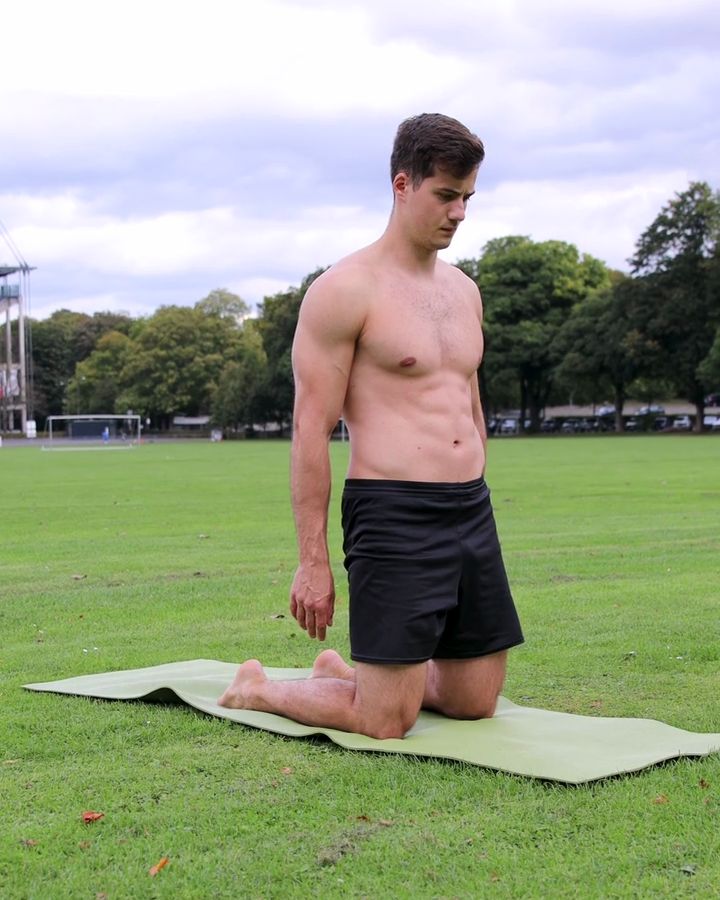
Kneeling Position
The kneeling position is a yoga posture where you sit on your heels. This pose stretches the thigh muscles and promotes flexibility in the knees and ankles. It also helps relieve tension in the back and lengthen the spine. The kneeling position can easily be integrated into breathing exercises, promoting relaxation. In Japan, this position is called Seiza, meaning "proper sitting," as it was traditionally the standard way of sitting in old Japan before chairs became common. The cross-legged sitting position is another seated yoga posture, but it focuses more on opening the hips.
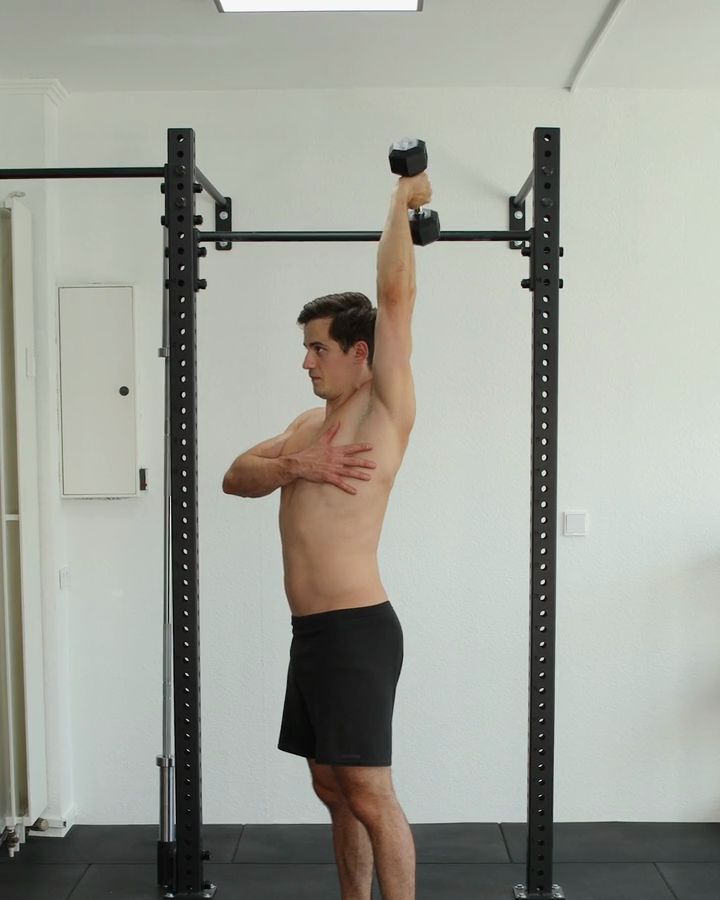
Single Arm Triceps Extensions with a dumbbell
One-arm dumbbell triceps extensions are an exercise to strengthen the triceps. In this exercise, you hold a dumbbell in one hand and extend your arm above your head. By lowering and raising the dumbbell, the triceps are specifically targeted. This exercise is ideal for isolating and training the triceps. A similar exercise without dumbbells is the triceps extensions with gymnastic rings.
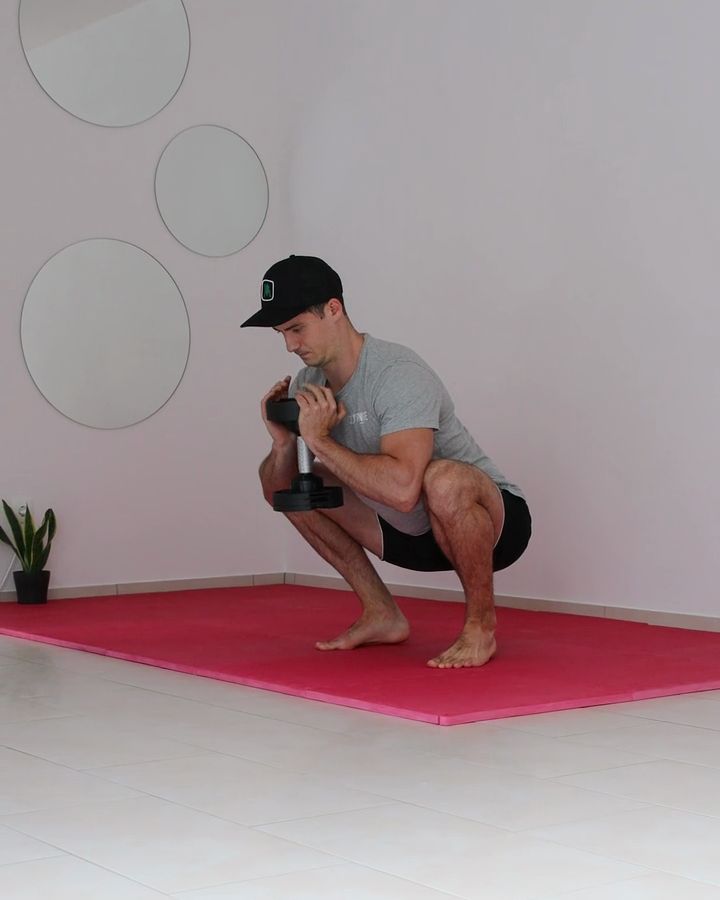
Goblet Squat Hold
The Goblet Squat Hold is an excellent exercise to improve mobility in the squat and prepare optimally for training. This mobility exercise requires little time and is particularly effective when performed while holding a light weight. The added weight helps you sink deeper into the squat than you could with just body weight, making the stretch more intense. Once in the deep squat position, you can enhance the exercise by slowly pushing one knee forward over your toes until you feel a comfortable stretch in your calf. Hold this position for 5-10 seconds and repeat the movement 4-5 times on each side. Make sure to keep your back straight and your heels as flat on the ground as possible. This exercise is ideal for improving mobility in the hips, ankles, and knees. At the same time, it helps release tension in the lower back muscles and stabilizes your posture in the squat. After practicing the Goblet Squat Hold, you’ll notice how much smoother and more controlled your squats feel. Give it a try and integrate this exercise into your warm-up routine to benefit from better technique and mobility in the long run!

Elevated Pike Pushups
Elevated Pike Push-Ups increase the load on the shoulders and triceps by positioning the feet on a raised surface. This variation enhances shoulder dominance compared to regular Pike Push-Ups, as the steeper angle to the ground shifts more body weight onto the arms. The exercise simulates the movement pattern of the Handstand Push-Up and serves as an excellent progression towards it.
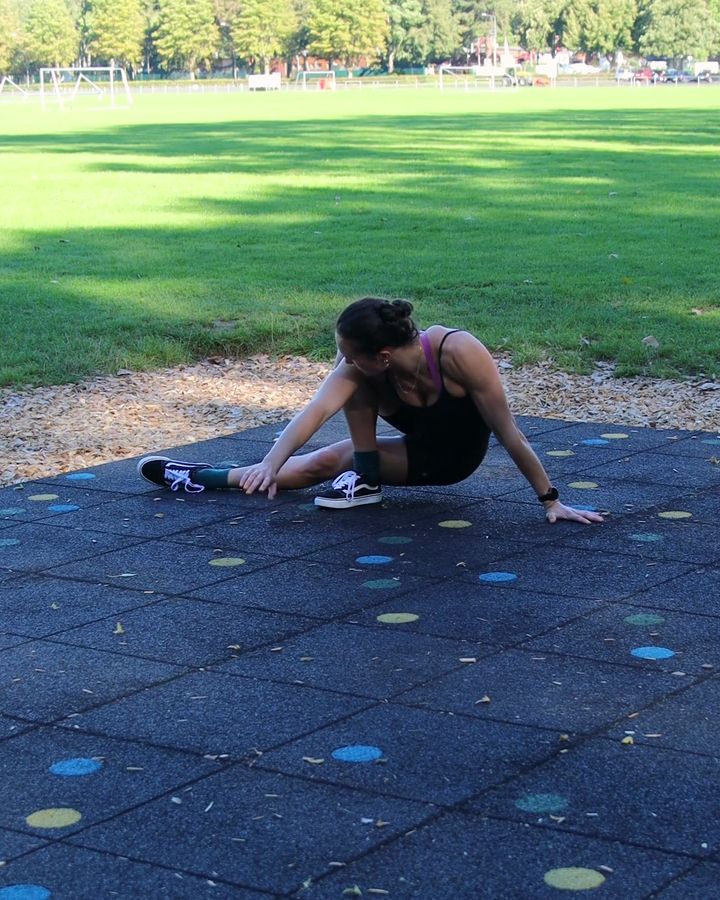
Dragon Leg Raises
Dragon Leg Raises are an advanced exercise that strengthens the adductors while challenging flexibility and lower-body strength. It combines mobility, strength, and control through the full range of motion. As an ideal preparation for Dragon Squats, it helps address deficits in adductor strength, which often make mastering this skill more difficult.
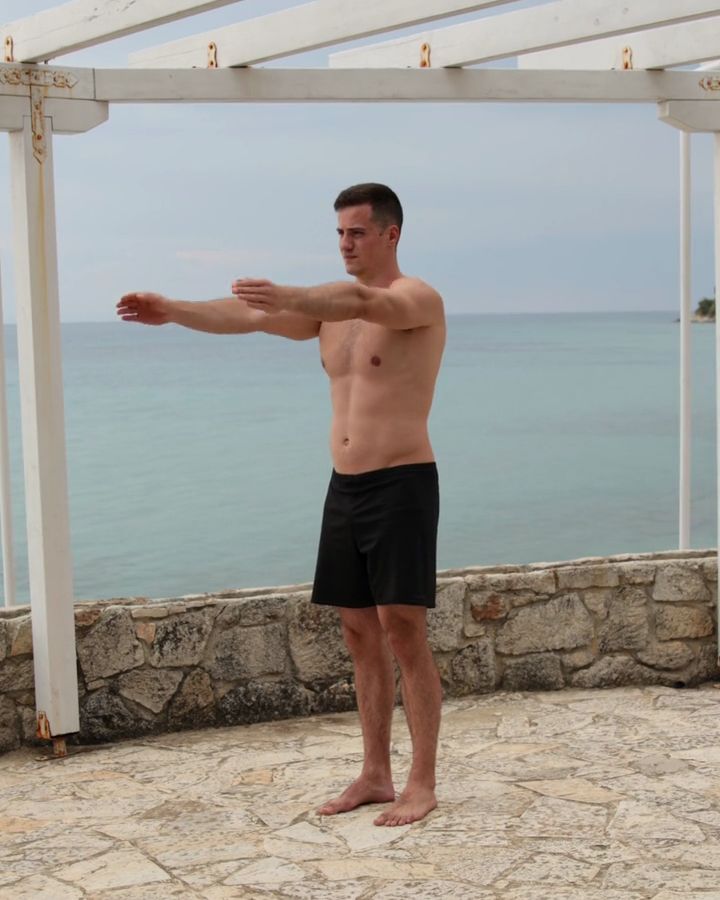
Arm Circles Forward
Forward Arm Circles focus on the front shoulder and chest muscles while also mobilizing the upper back and rotator cuff. This exercise is often part of a warm-up routine and prepares the shoulders for upcoming activity by improving mobility and activating the muscles. Alternatively, this exercise can be done as Arm Circles with Band to add extra resistance and enhance shoulder muscle activation. The band increases tension during the movement, creating a stronger stretch in the chest and shoulders.
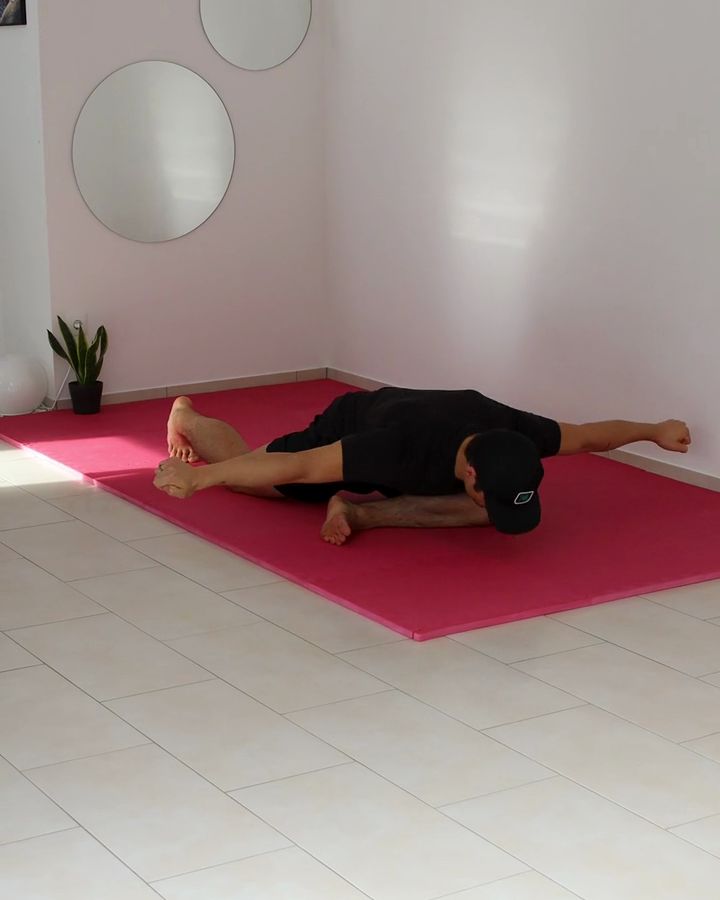
Pigeon Pose Good Mornings
Pigeon Pose Good Mornings combine the hip stretch of the Pigeon Stretch with the forward bend of traditional Good Mornings. This exercise improves hip mobility while simultaneously strengthening the lower back and glutes. The upright posture and controlled forward bend specifically target hip flexibility and core stability. Pigeon Pose Good Mornings are an advanced variation of classic Good Mornings and an extremely effective mobility exercise. They allow for active engagement with load through the full range of motion, optimizing both mobility and stability.
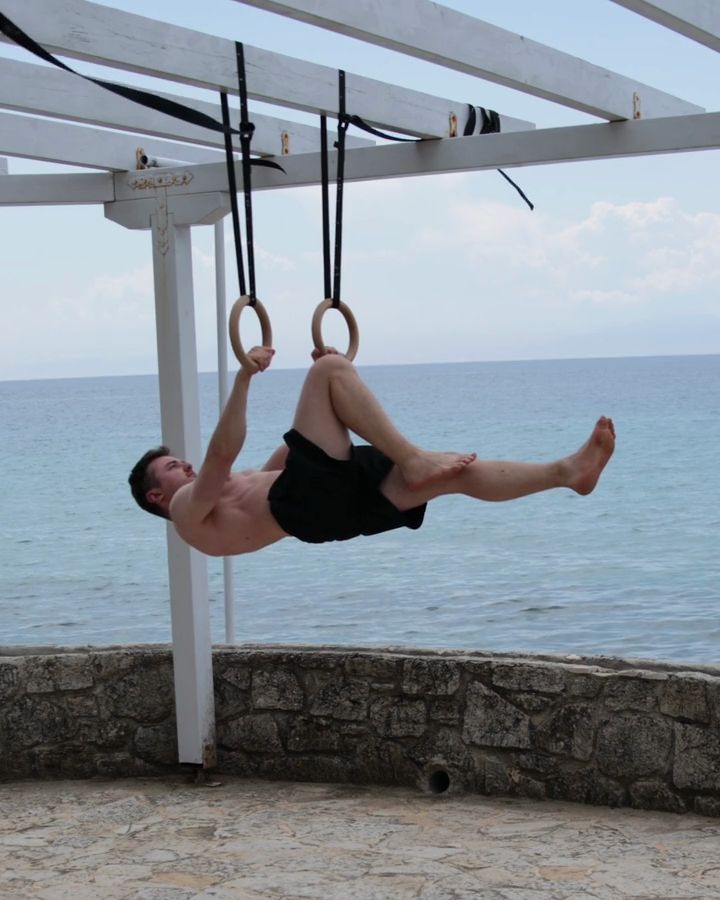
One Leg Front Lever with gym rings
The One Leg Front Lever on the gymnastic rings is a popular preparatory exercise for the Full Front Lever, where both legs are fully extended. In the One Leg Front Lever, however, only one leg is stretched out, as the name suggests. The difficulty of this exercise can be adjusted: the closer you pull the bent leg or knee towards your body, the easier it gets. On the other hand, if you push the bent leg further forward, the exercise becomes more challenging. The One Leg Front Lever is one of the best-known progressions on the way to the full Front Lever. Another useful step in between is the Straddle Front Lever.
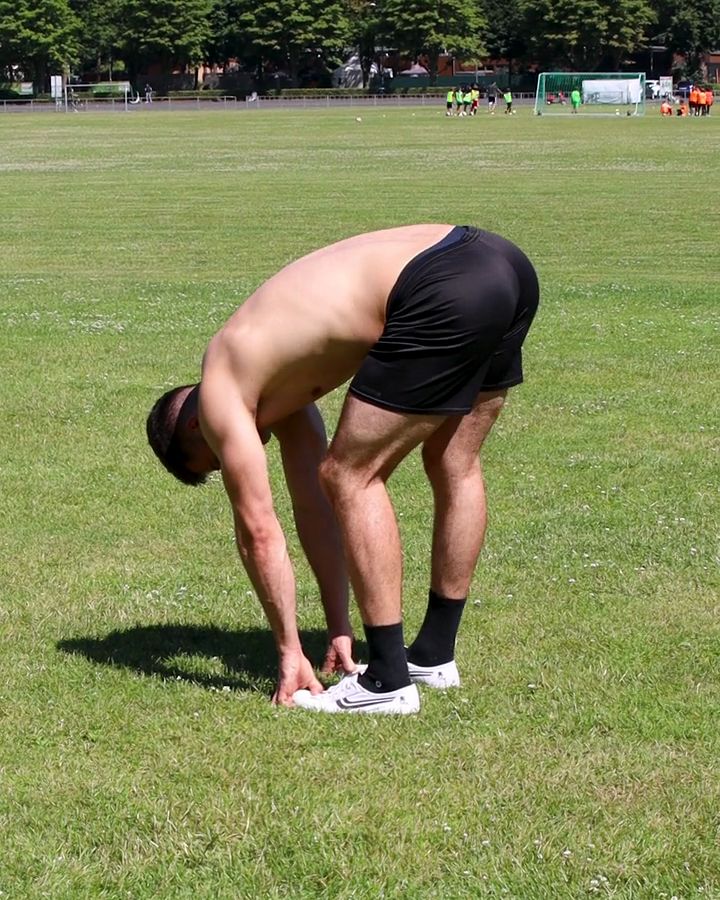
Elephant Walk Stretch
The Elephant Walk stretch (also called the Hamstring Stretch) is an exercise that improves hamstring flexibility. In a bent-over position, you try to keep your hands on the ground. Meanwhile, you alternate between straightening and bending your legs, creating a dynamic stretch.
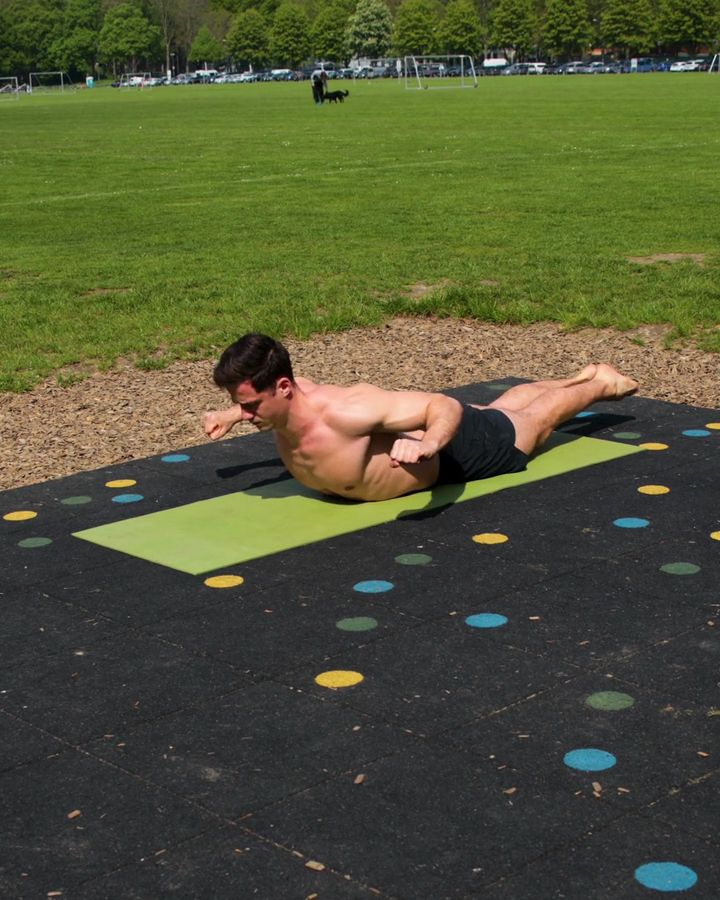
Lying Pull Ups
The lying pull-up is an exercise where you lie on your stomach and lift your upper body by engaging your back, glutes, and core muscles. The goal is to lift your upper body off the floor until your chest leaves the mat. This primarily works the lower back and glutes while actively drawing the shoulder blades together. This exercise is similar to the Superman Lift but involves a more intense back engagement and is often used as part of back training or to improve back extension strength.
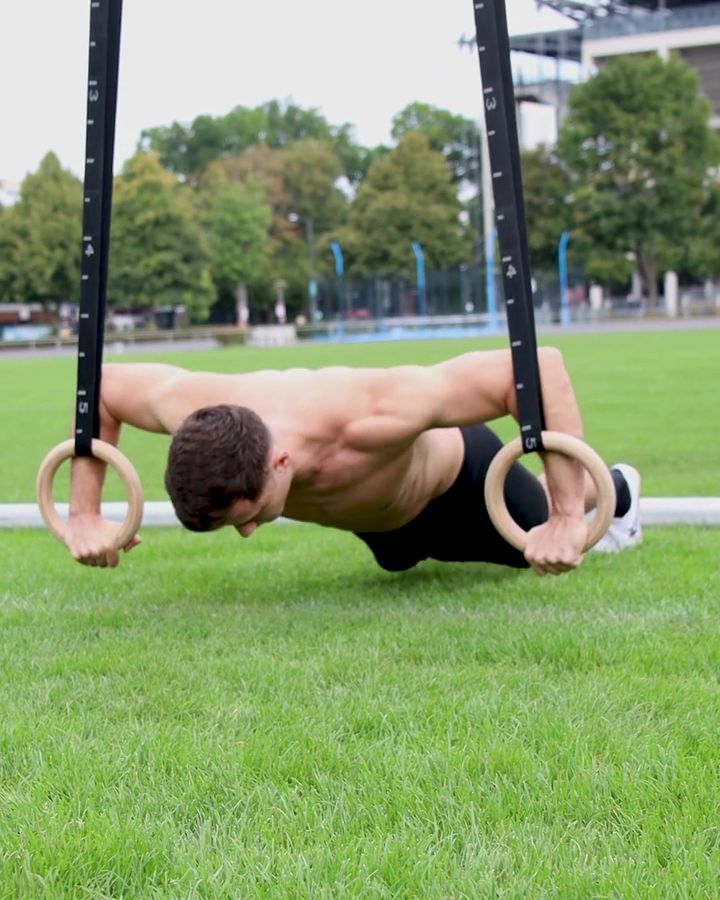
Bulgarian Push Ups with gym rings
Bulgarian Push-Ups on gymnastic rings are an advanced variation of classic Ring Push-Ups. Intentionally flaring the elbows provides an intense stretch in the chest and effectively activates the chest muscles. Few exercises offer a comparable combination of stretch and training depth. Since this variation requires solid foundational strength and familiarity, it’s important to start gradually to avoid overuse injuries.
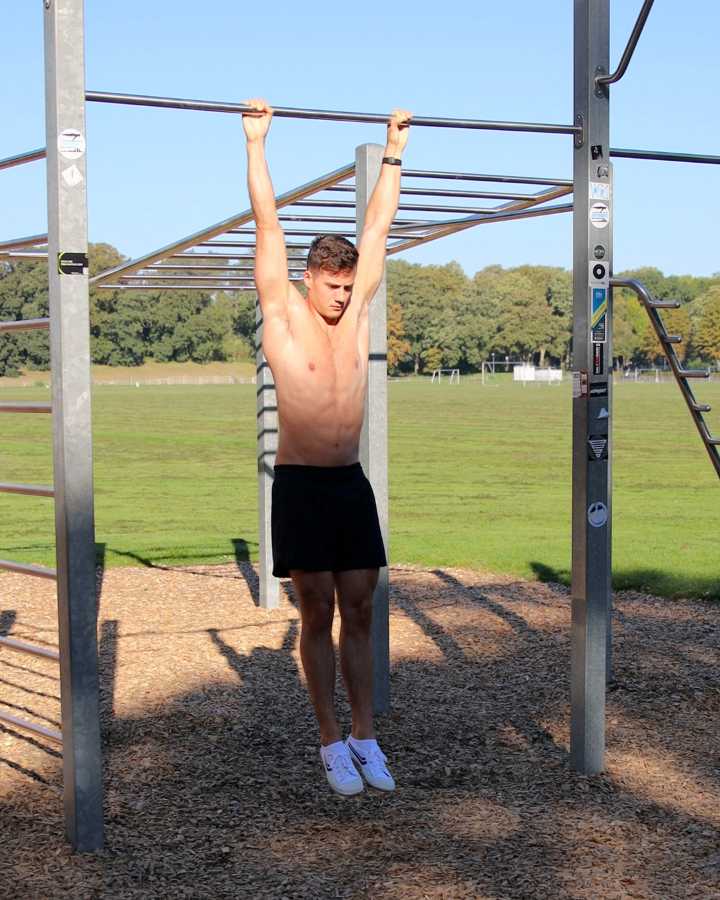
Passive Hang
The Passive Hang strengthens grip while also relieving the shoulders and spine. In this exercise, the body hangs relaxed from a bar, with the arms remaining straight. This hang supports shoulder health and improves upper body mobility. It also serves as a preparatory exercise for more challenging hanging exercises, such as Scapular Pull-Ups.
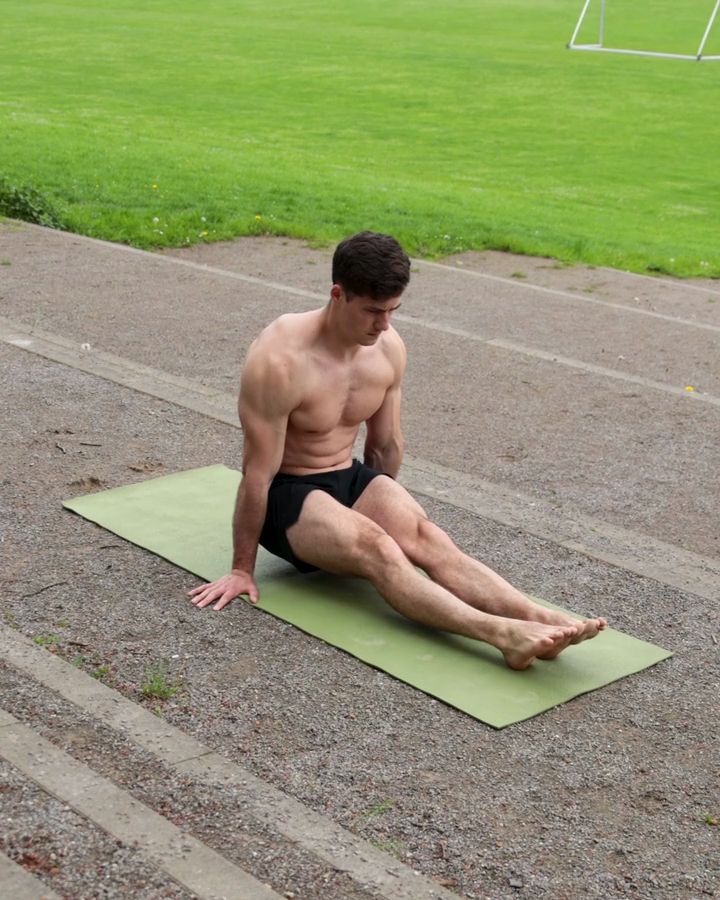
Assisted L Sit
In the supported L-Sit, the legs are extended with the heels resting on the ground. Compared to the regular L-Sit, where the legs are fully lifted off the ground, the supported version is ideal for beginners, as it requires less core strength while still preparing the upper body for the proper L-Sit. Another easier variation is the Tuck L-Sit, where the knees are drawn toward the chest.
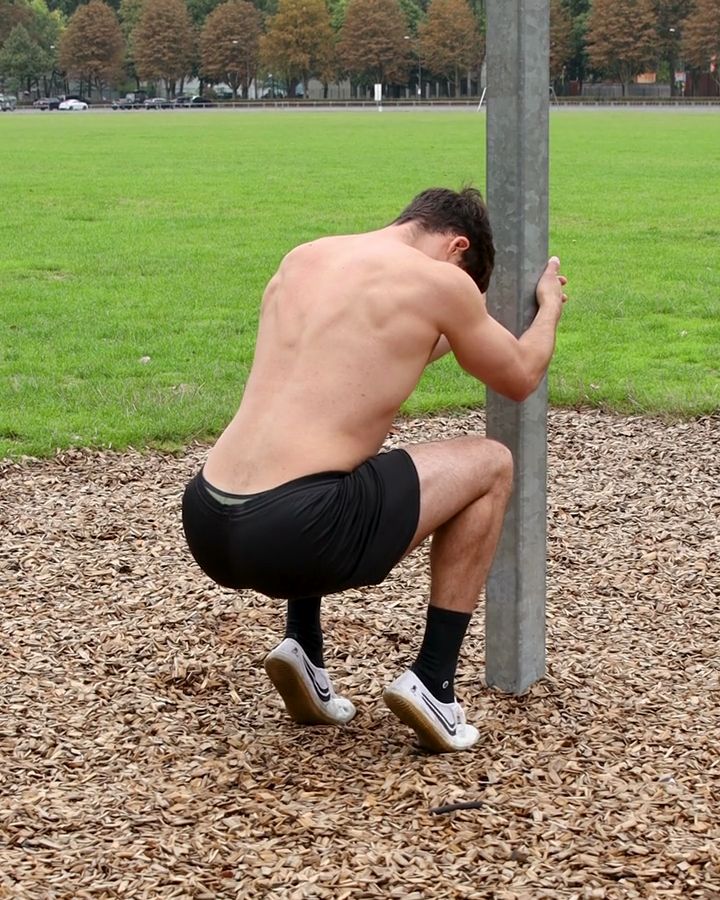
Squat Calf Raise
Calf raises are an effective exercise for strengthening the calf muscles. In squat-position calf raises, you lift your heels in a controlled way from a deep squat, keeping your toes firmly on the ground. This variation focuses on building calf strength. However, recent studies show that the classic standing calf raise is even more effective for muscle growth in the calves. Standing calf raises primarily target the gastrocnemius muscle, intensively building functional strength and overall calf growth. In contrast, seated calf raises isolate the soleus muscle and allow for lifting heavier weights, which specifically promotes growth in the soleus. This targeted approach is beneficial for well-rounded calf muscle development.
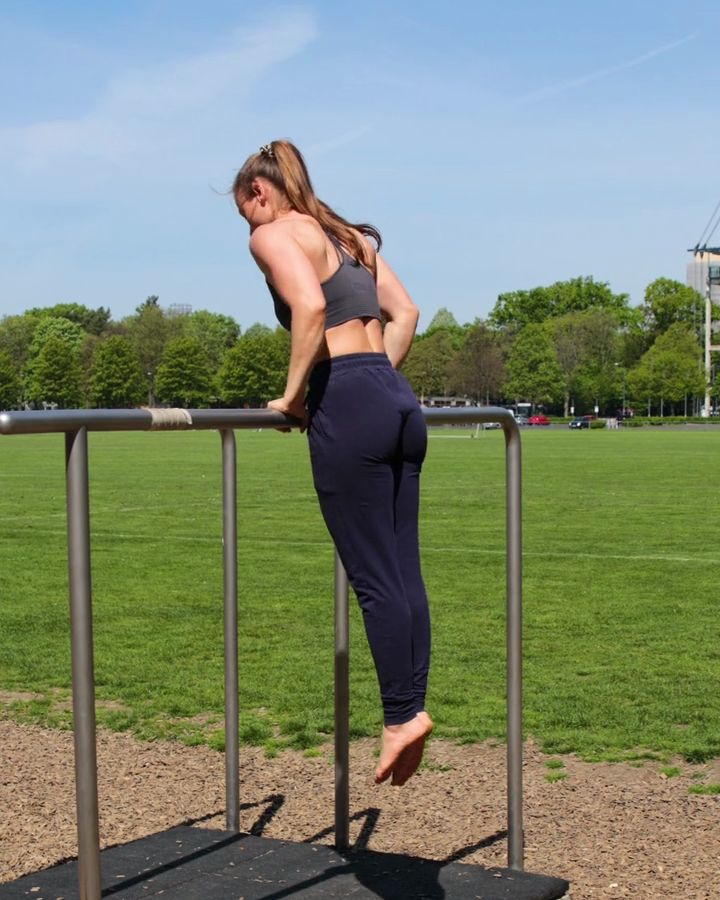
Jumping Bar Muscle Ups
Jumping Bar Muscle-Ups are a dynamic preparatory exercise for learning the classic Muscle Ups. The jumping component in this variation helps initiate the movement with power and makes the transition from the pulling to the pushing phase easier. This exercise is especially useful for beginners working on their transition to the full muscle-up technique.
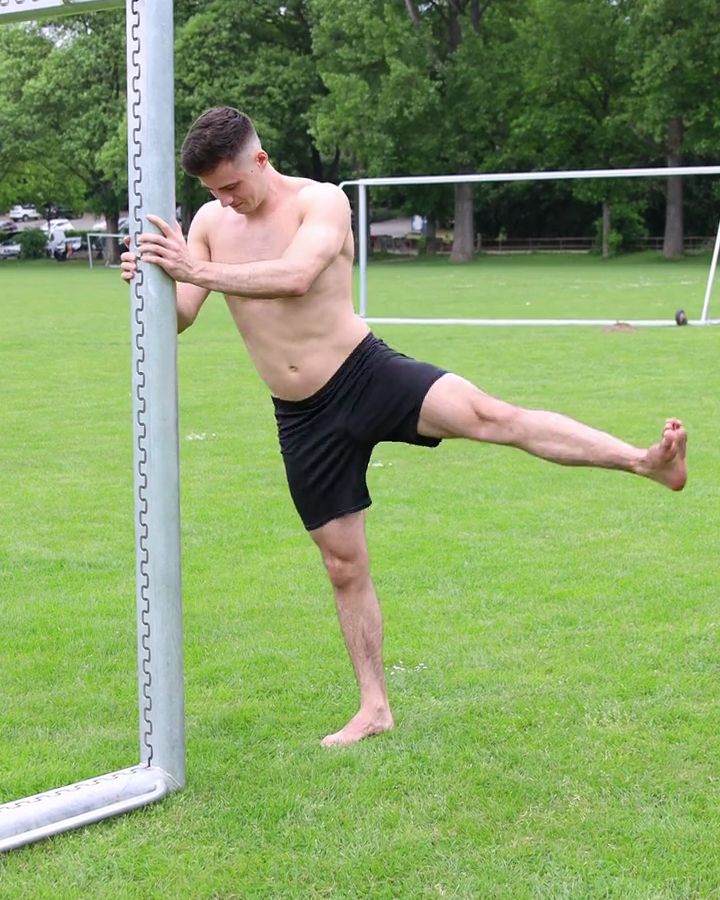
Lateral Leg Swings
Lateral Leg Swings are dynamic movements that specifically mobilize the hip and leg muscles. They improve hip flexibility and mobility and are often used as a warm-up exercise. While standing, you swing one leg side to side, maintaining balance. Similar to Cossack Squats, they primarily target the adductors. Frontal Leg Swings, on the other hand, focus more on the hamstrings.
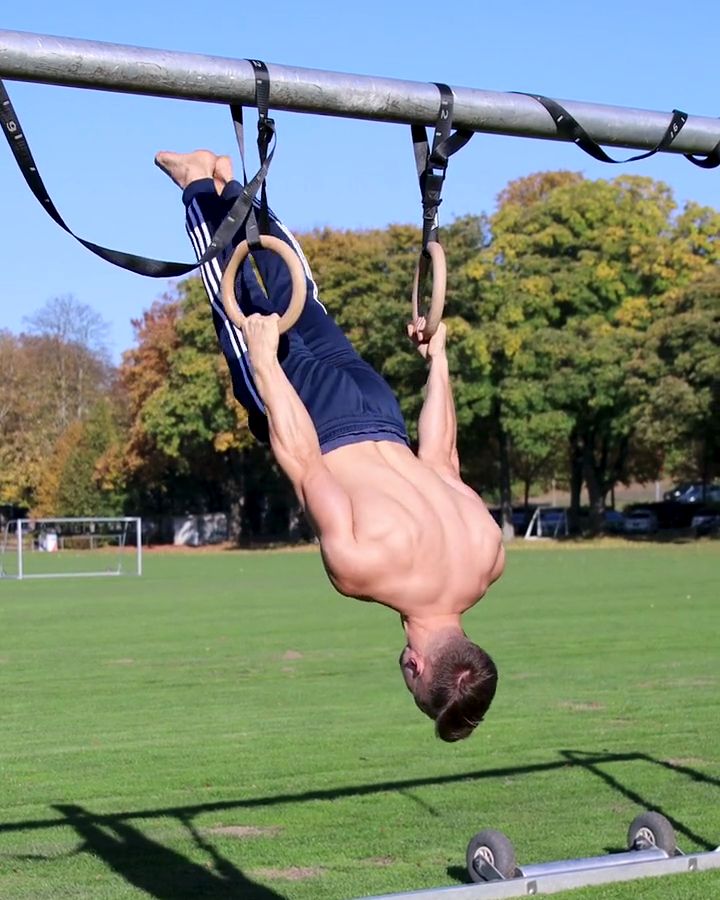
Back Lever Pulls with gym rings
Back Lever Pulls on the rings are an advanced exercise that requires you to already have a solid Back Lever. In this movement, you control your body from the German Hang up to the horizontal Back Lever position. This exercise intensely engages the entire upper body, especially the back, shoulders, and biceps. The Back Lever Pull demonstrates maximum control in the Back Lever and is often used to transition between strength elements, such as the Back Lever and Front Lever.
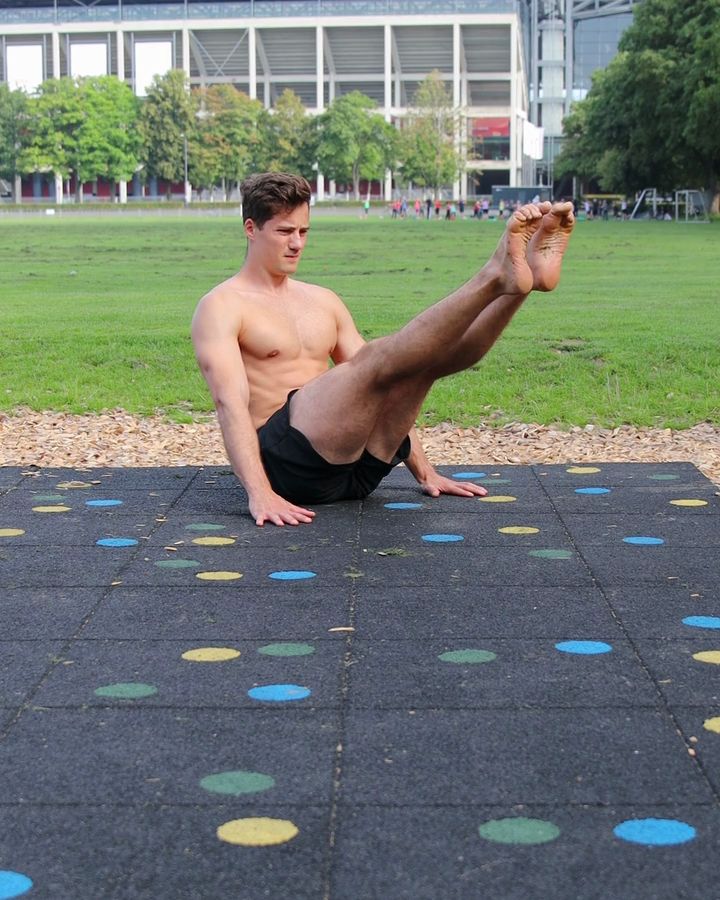
Boat Pose, V Up Hold
The Boat Pose is a mobility exercise (also called Navasana in yoga) that strengthens the core muscles and improves balance. In this exercise, you lift both your legs and upper body at the same time while seated, creating a "V" shape.
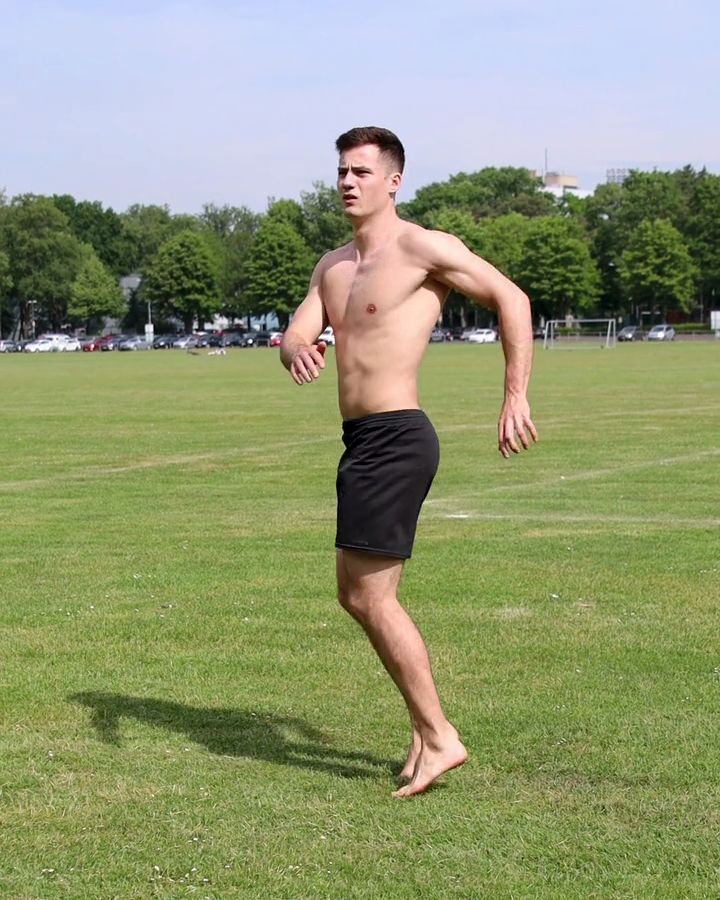
Twist Jumps
Twist Jumps are a dynamic jumping exercise that, similar to Jumping Jacks, trains the core muscles, legs, and coordination. In this exercise, you jump slightly and twist your upper body in the opposite direction of your hips to create a controlled rotation. This exercise is ideal for warming up and strengthening the core muscles.
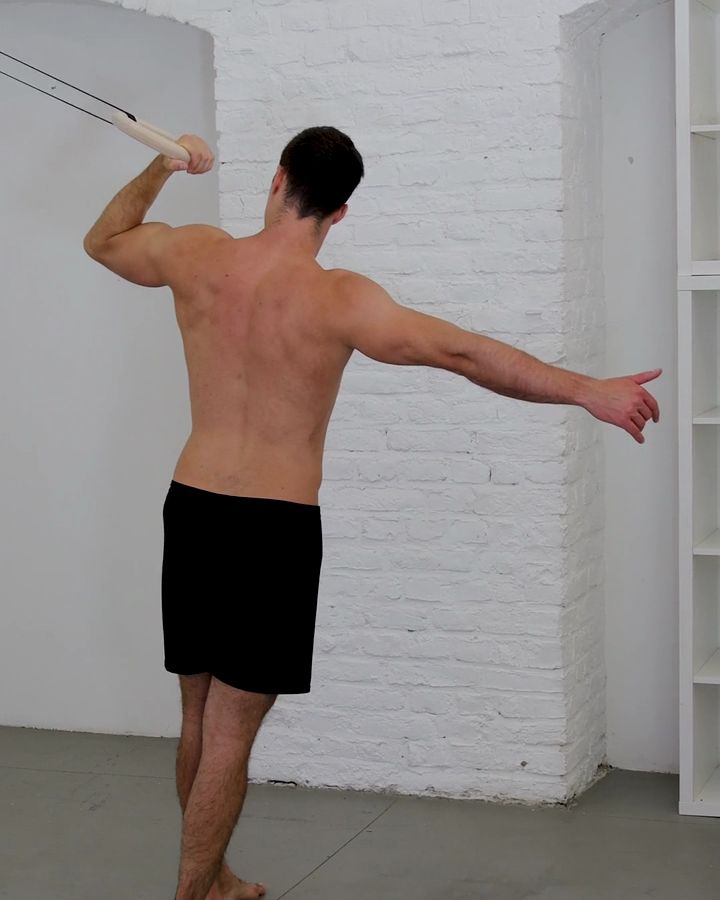
One Arm Biceps Curls with gym rings
One-Arm Bicep Curls on gymnastics rings are an effective exercise for targeted bicep strengthening. The intensity of the exercise can be adjusted by changing the angle of the upper body: the more horizontal the body position, the greater the load on the biceps, as more body weight has to be lifted. Compared to regular Ring Bicep Curls, the one-arm variation allows for isolated muscle training. This exercise is a great alternative to classic dumbbell bicep curls or barbell bicep curls when only gymnastics rings are available.
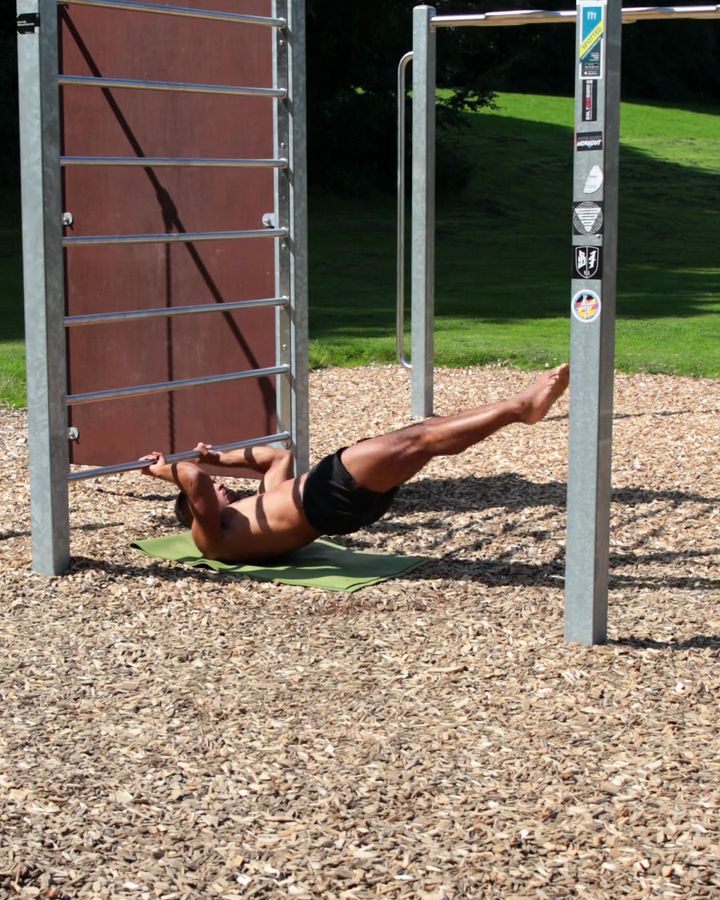
Dragon Flag Raises
Dragon Flag Raises are an advanced core exercise where the body is kept straight and lifted and lowered in a controlled manner, with only the upper back touching the ground. This movement requires extremely strong core muscles and a high level of body control.
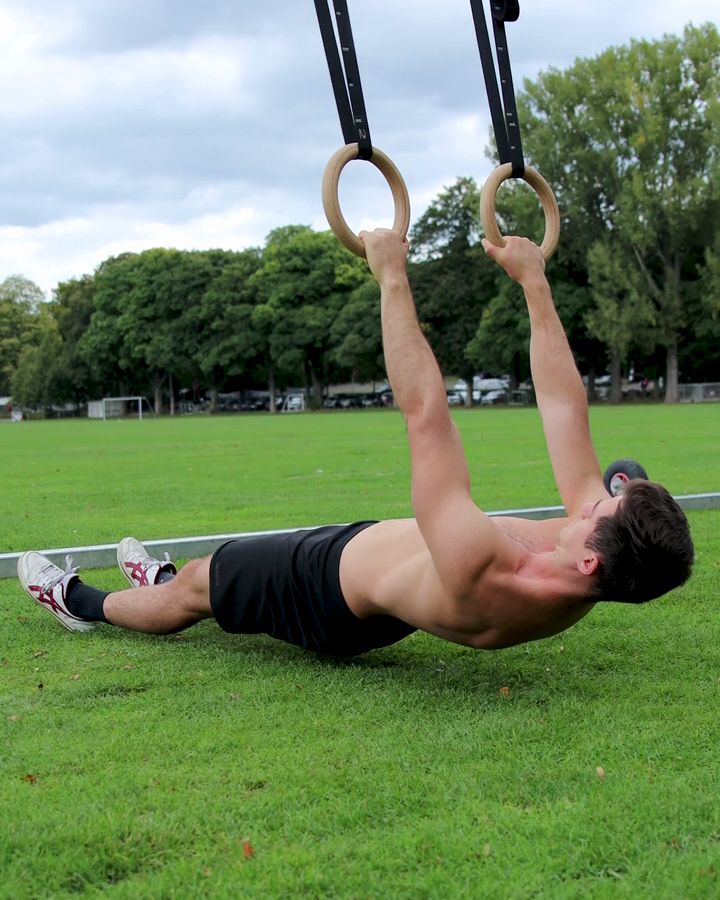
Scapular Row with gym rings
Scapular Rows, also known as Shoulder Blade Rows, strengthen the upper back, especially the muscles around the shoulder blades. In this exercise, you first spread the shoulder blades apart (scapular protraction) and then bring them back together (scapular retraction). This exercise promotes precise shoulder blade coordination and provides a solid foundation for other rowing exercises.
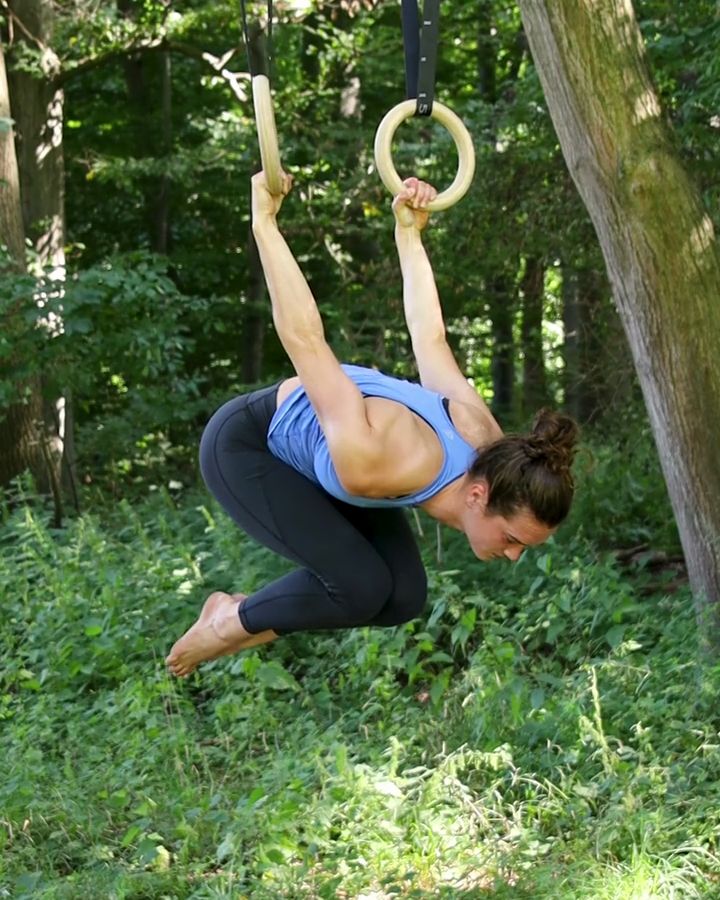
Tuck Back Lever with gym rings
The tuck back lever is an advanced calisthenics exercise that challenges the entire upper body, especially the lower back, front shoulders, chest, and biceps. Unlike the straight back lever, the body is held in a tucked position here, which reduces the difficulty level—making it ideal as preparation for the full back lever. The next progression levels are the one leg back lever and the straddle back lever, where the legs are spread apart, eventually leading to the full load in the full back lever.
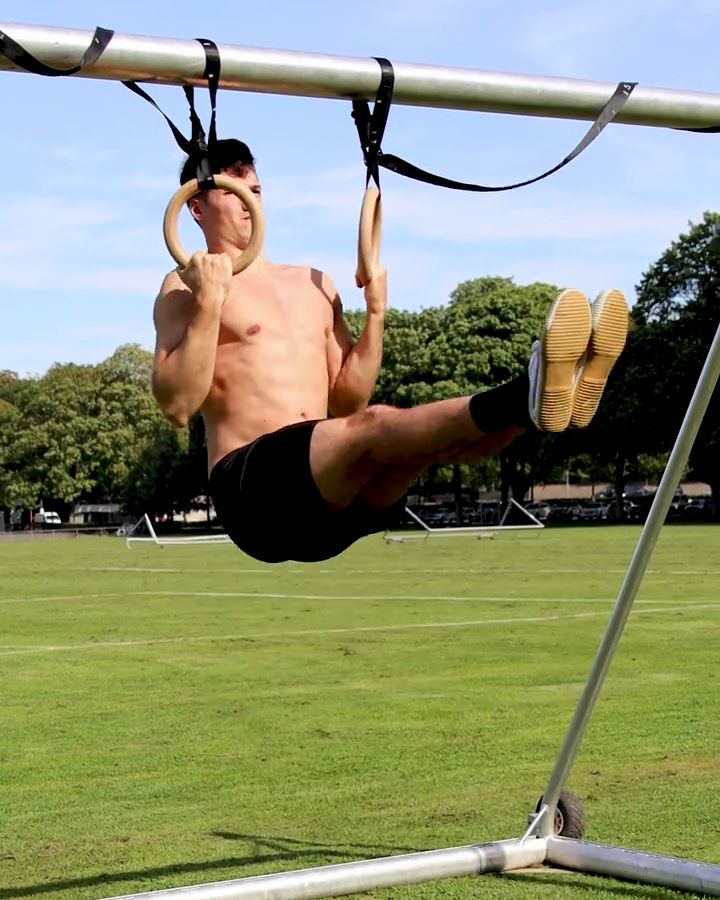
L Sit Pull Ups, L Sit Chin Ups with gym rings
L-Sit Pull Ups combine the L-Sit with the Pull-Up and provide an intense workout for the back, abs, and hip flexors. With your legs extended in front of your body, you achieve maximum tension in the core and a deep stretch in the latissimus, especially in the lower range of motion (hang with straight arms), where pulling up is the most challenging. In addition to strengthening the back and biceps, this exercise trains the abs isometrically and improves body tension—perfect for progress in the Front Lever. Perform the exercise with proper form, whether on rings or a bar. A detailed execution guide can be found below.
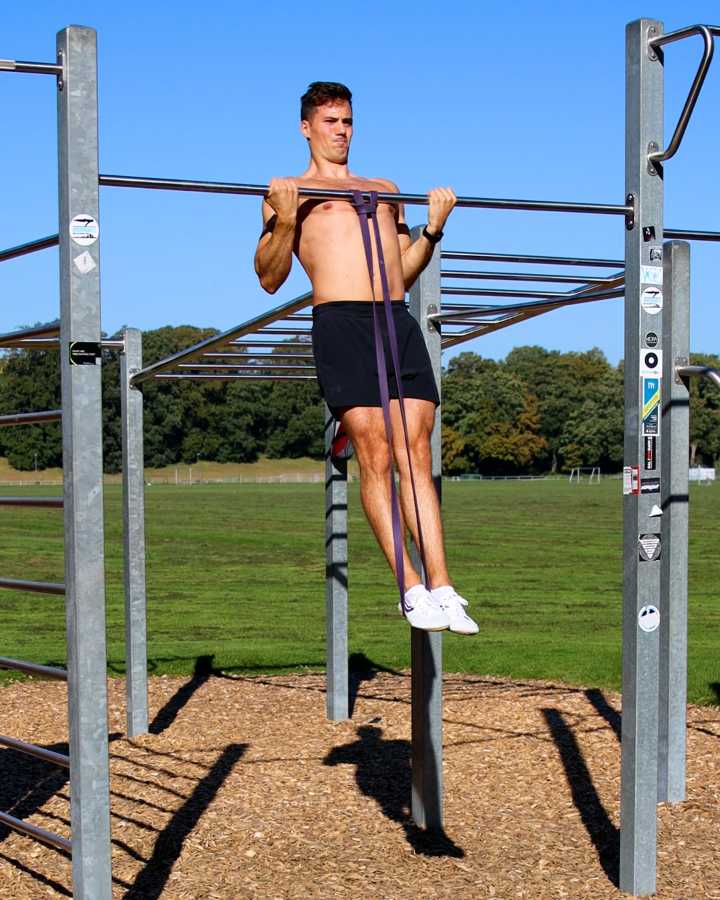
Banded Chin Ups
Underhand grip pull-ups with a band are a supported variation of classic Chin-Ups, where a resistance band reduces body weight to make the movement easier. This exercise is ideal for beginners learning to perform their first pull-up. Although there are slight differences in muscle activation between Chin-Ups and Pull-Ups, such as greater biceps and chest engagement in chin-ups and more activation of the lower trapezius in pull-ups. These differences are hardly noticeable for beginners. Both exercises follow a similar activation sequence and are equally effective unless you're pursuing advanced bodybuilding goals.
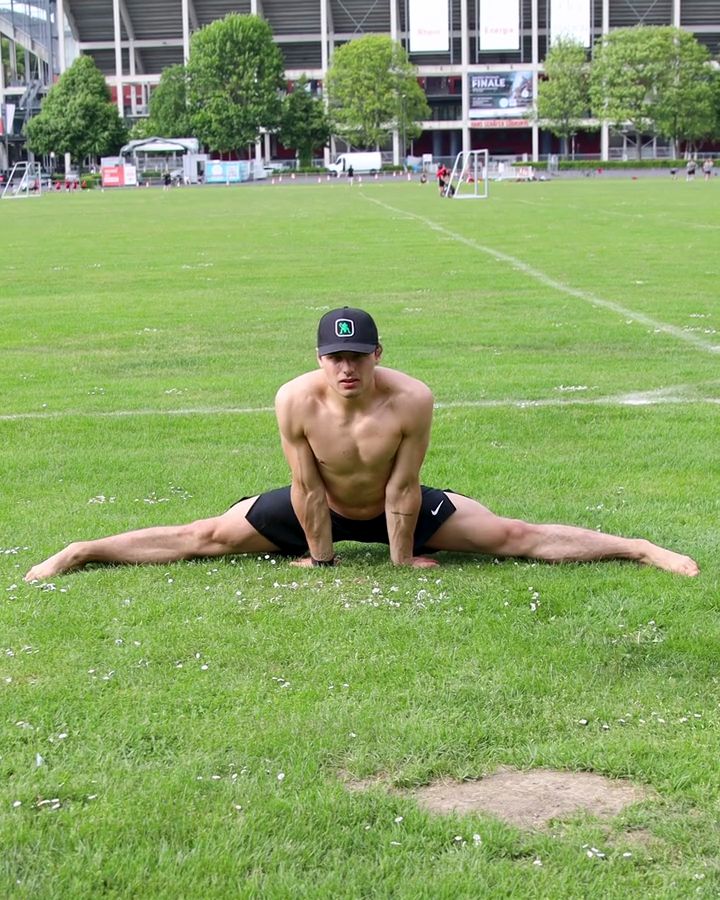
Side Splits
The split, specifically the side split or middle splits, requires significant flexibility in the hips and adductors. In this position, both legs are spread sideways from the body. The side split is not only popular in dance and gymnastics but also offers benefits in calisthenics training, as it facilitates advanced skills like the Straddle Planche or the Press Handstand. The side split is similar to the straddle position, also known as the Pancake. However, in the Pancake, there is an added focus on intensely stretching the hamstrings. Both exercises complement each other well to improve flexibility and mobility.
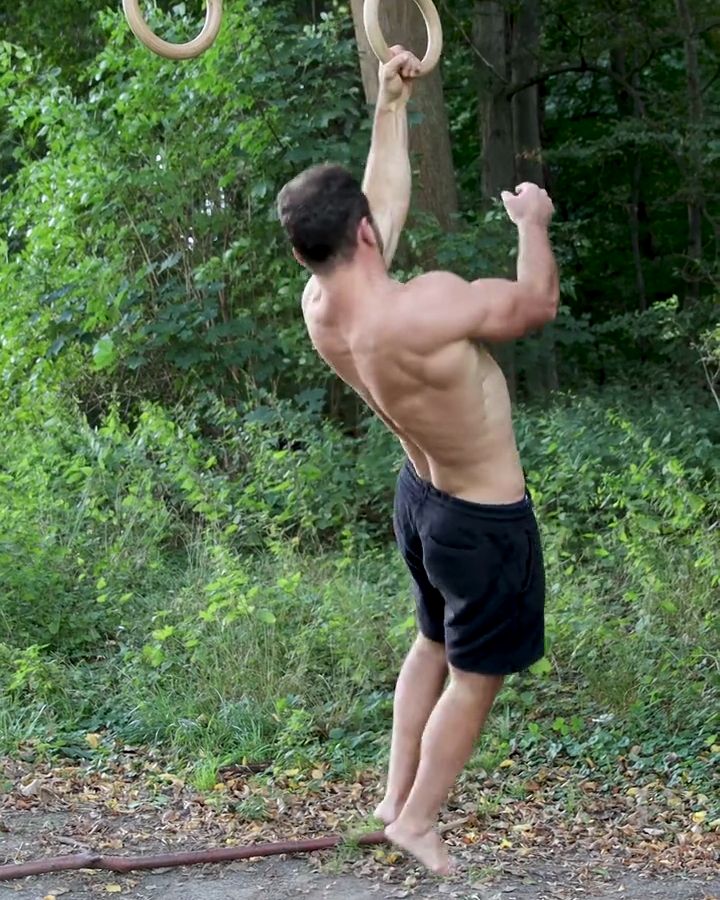
One Arm Pull Ups / One Arm Chin Ups
One-arm pull-ups on gymnastic rings are among the most challenging pull-up exercises out there. Anyone who can already handle high loads in weighted pull-ups or perform multiple clean repetitions of archer pull-ups has a solid foundation to start learning the one-arm pull-up. When training for the one-arm pull-up, it's important to progress slowly and systematically to avoid overuse injuries, such as elbow or shoulder pain.
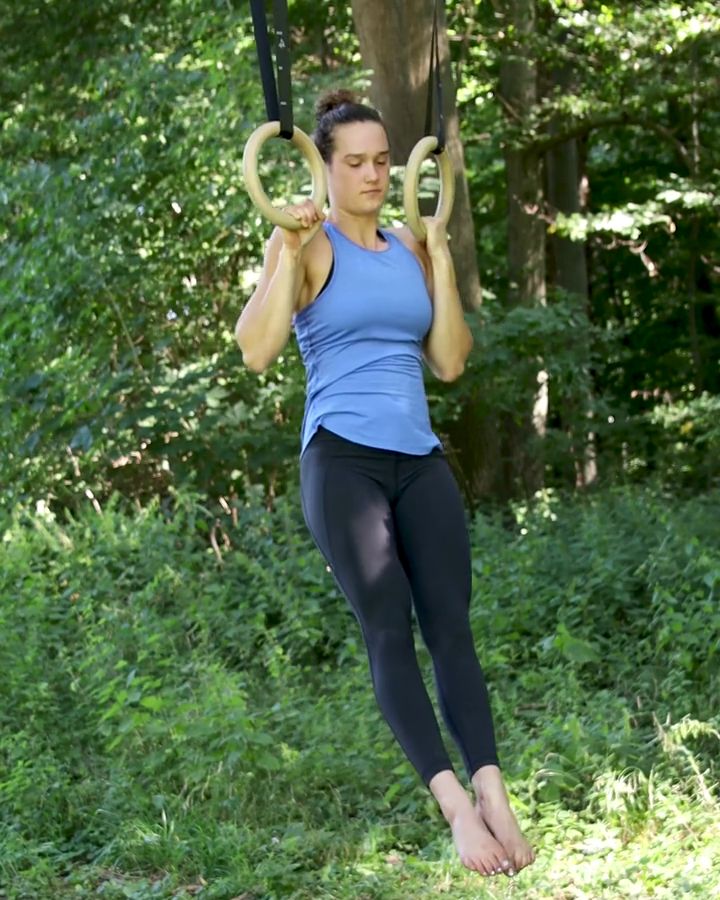
Mixed Grip Pull Ups
Mixed Grip Pull-Ups, also called Mixed Grip Chin-Ups, are one of the first exercises that prepare you for the One Arm Pull Up. In this pull-up variation, one hand uses an underhand grip (palm facing you) and the other uses an overhand grip (palm facing away from you). This grip combination creates uneven tension, helping you build more strength on one side – an important step toward doing a one-arm pull-up.
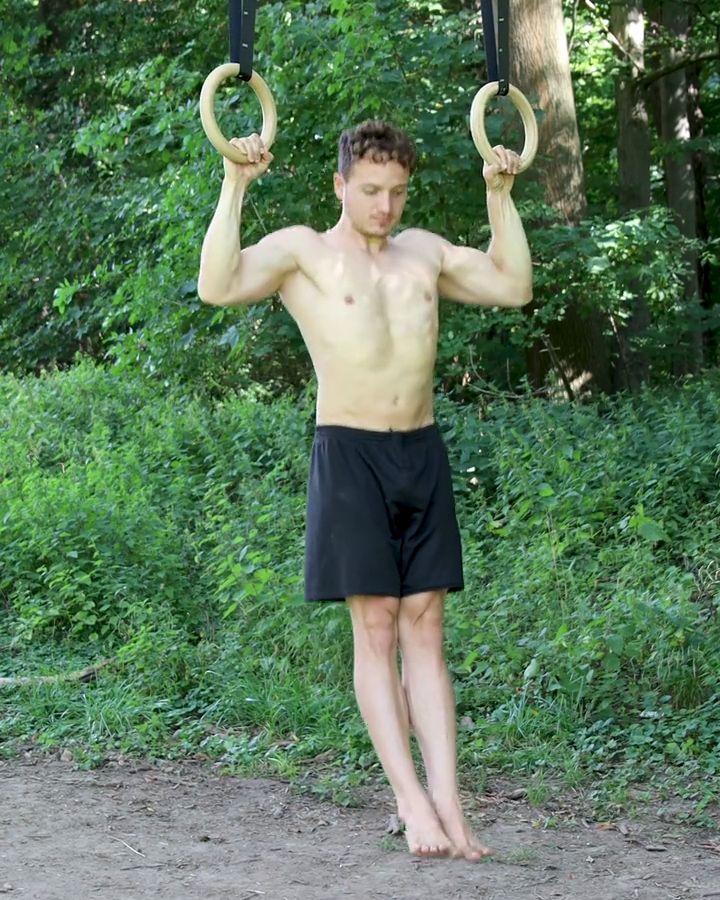
Bulgarian Pull Ups with gym rings
The Bulgarian Pull-Up is an advanced variation of the classic Pull-Up that particularly strengthens the shoulder girdle and improves upper body stability. Unlike the regular pull-up, the arms are pulled outward rather than kept close to the body, requiring additional control and specifically targeting the shoulders, trapezius, back muscles, as well as the biceps and forearms. This exercise is performed on gymnastics rings and provides an intense stimulus for the entire back.
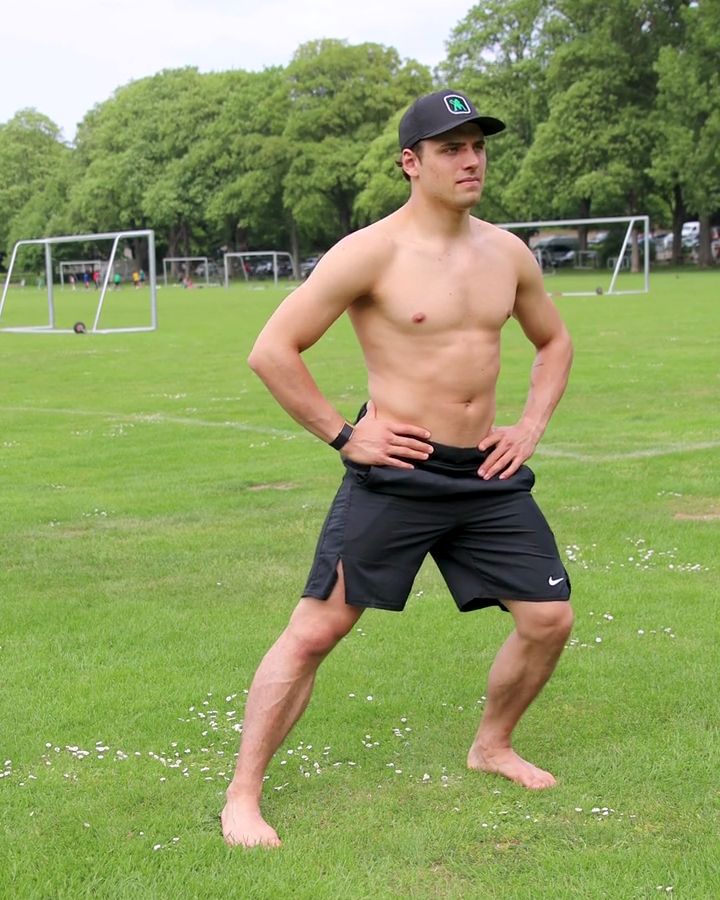
Knee CARs
Knee CARs are controlled articular rotations, similar to Hip CARs or Spine CARs. They aim to improve the mobility and stability of the knee joint by actively engaging the muscles and nervous system in the movement. Unlike static stretches, CARs involve active rotational movements at the outer edge of the range of motion. This not only enhances flexibility but also improves neurological control and joint stability. CARs stimulate adaptations in the joint and train the body to control movements at the extremes of the range of motion. Each repetition is performed with tension to signal the muscles and brain that these movements are safe and manageable. This active control helps prevent injuries and enhances movement quality. In Knee CARs, the goal is to consciously use the full range of motion of the knee joint without assistance from other joints. The circular movements are performed with maximum precision to train control and stability. They are excellent for warm-up routines, promote kinesthetic awareness, and support long-term joint health.
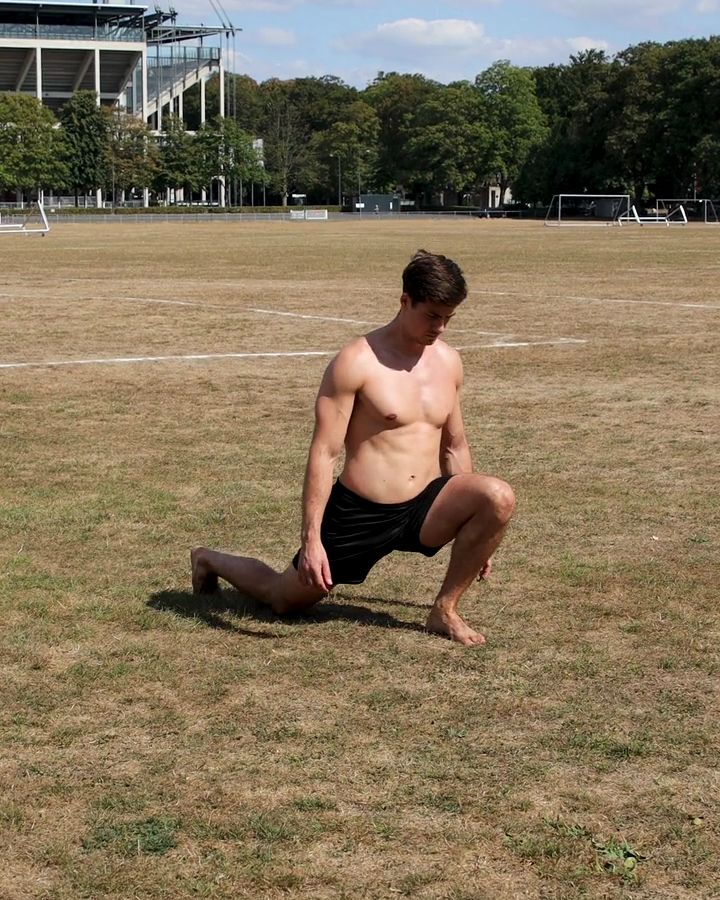
Long Lunges
Long lunges strengthen the legs and promote hip mobility. You take a large step forward, keeping the back leg straight and shifting your weight further forward. This variation particularly targets the leg and glute muscles while also improving hip flexibility, especially the mobility of the hip flexor. Additionally, the ankle joints are mobilized as the knee is pushed as far forward as possible over the toes. Unlike the classic lunge, the long lunge shifts the focus more forward, stretches the hip more intensively due to the extended back leg, and results in greater knee flexion.
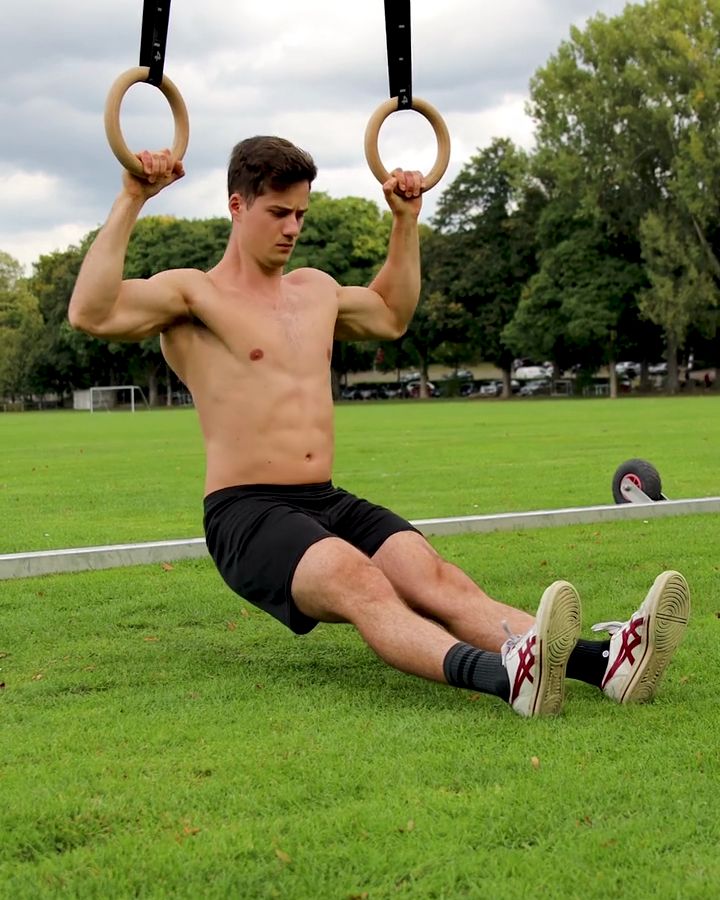
Hinge Rows with gym rings
Hinge Rows are a challenging exercise that specifically strengthens the upper back, shoulders, and arms. They enhance the strength of the trapezius muscles, activate the lats, and promote shoulder blade stability. Using gymnastic rings or TRX straps set at hip height, the body is kept in a straight line. During the pull, the hips are slightly pushed back until the torso is upright, and the elbows are aligned with the shoulders. The movement remains controlled, with deliberate retraction of the shoulder blades. Hinge Rows are ideal for building strength for Pull-Ups and Rows, effectively targeting the back muscles.
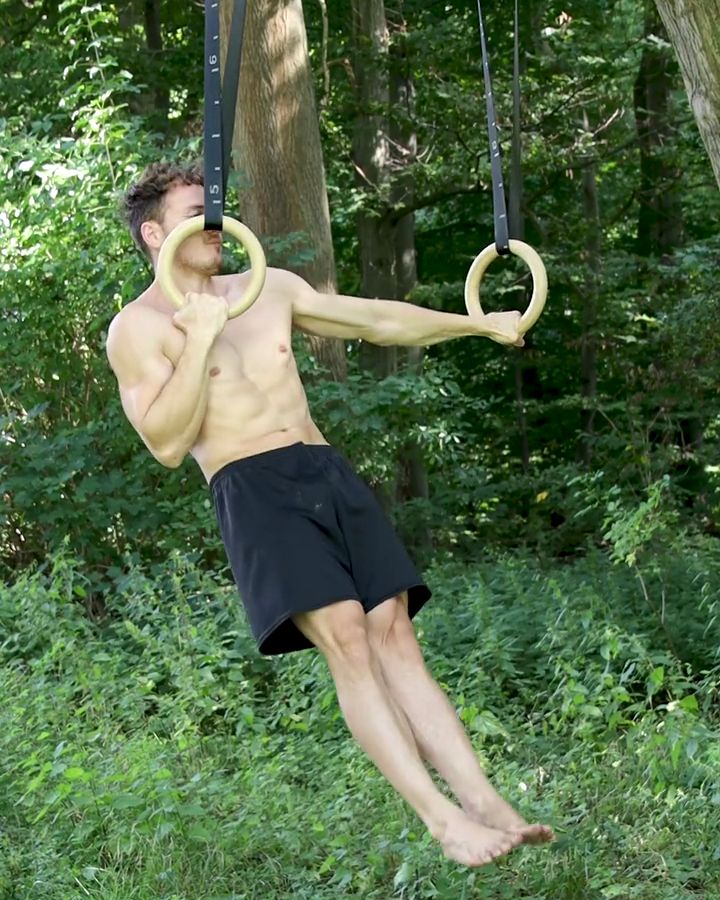
Archer Pull Ups, Archer Chin Ups with gym rings
Archer pull-ups are a challenging variation of the classic pull-ups where one arm bears more weight in an alternating pattern—similar to drawing a bow. This exercise specifically strengthens the back and bicep muscles. Archer pull-ups (overhand grip) and archer chin-ups (underhand grip) differ only in the grip used and are excellent preparation for one-arm pull-ups.
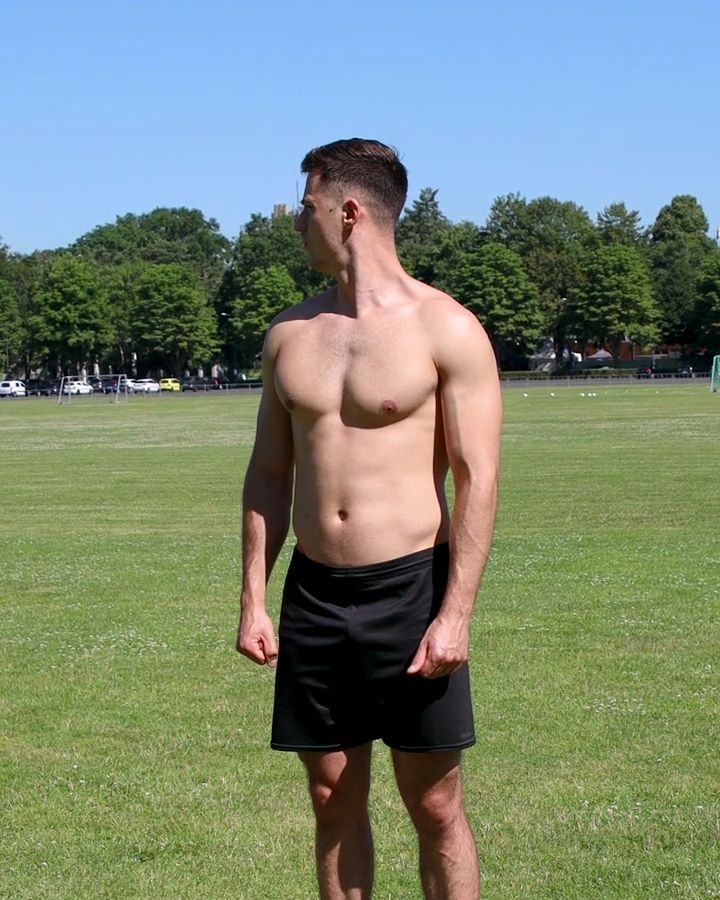
Head Rotation
The Head Rotation is an exercise designed to stretch and strengthen the neck and upper back muscles. By gently turning the head from side to side, it promotes mobility in the cervical spine. This exercise can also help relax the muscles after prolonged sitting.
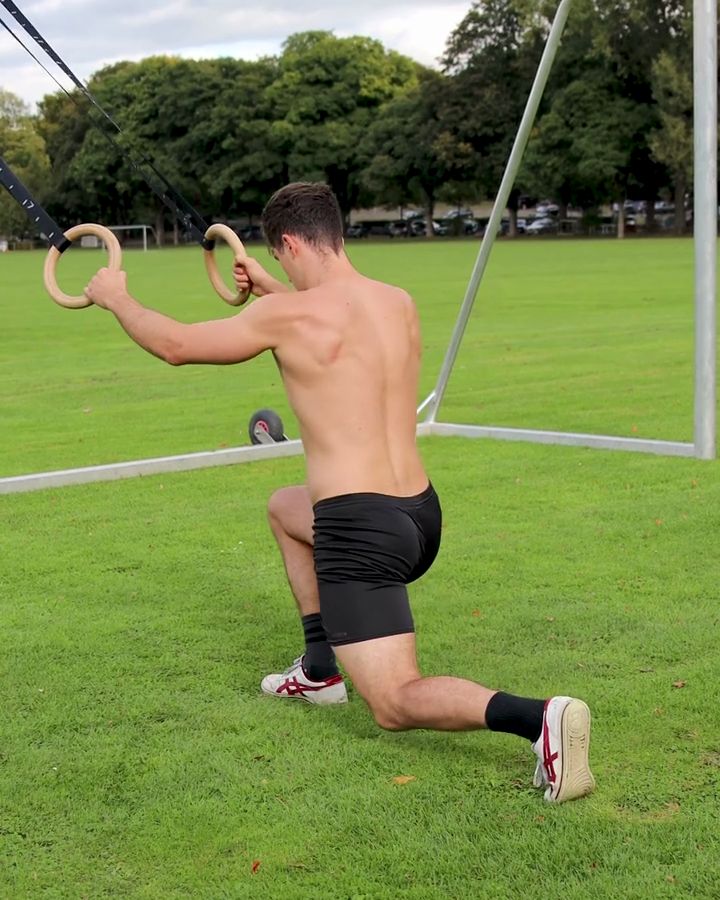
Assisted Lunges
Supported lunges with gymnastic rings are an excellent exercise, especially for beginners. They specifically target the leg muscles, particularly the quadriceps and glutes, while the rings provide additional stability and balance. This support reduces the risk of injury and makes it easier to perform the exercise correctly. At the same time, the movement promotes hip mobility and increases leg strength, forming the foundation for more advanced exercises. A variation of this exercise is performing regular lunges without support or with added weight. Unlike supported lunges, these require more balance and greater control of movement.
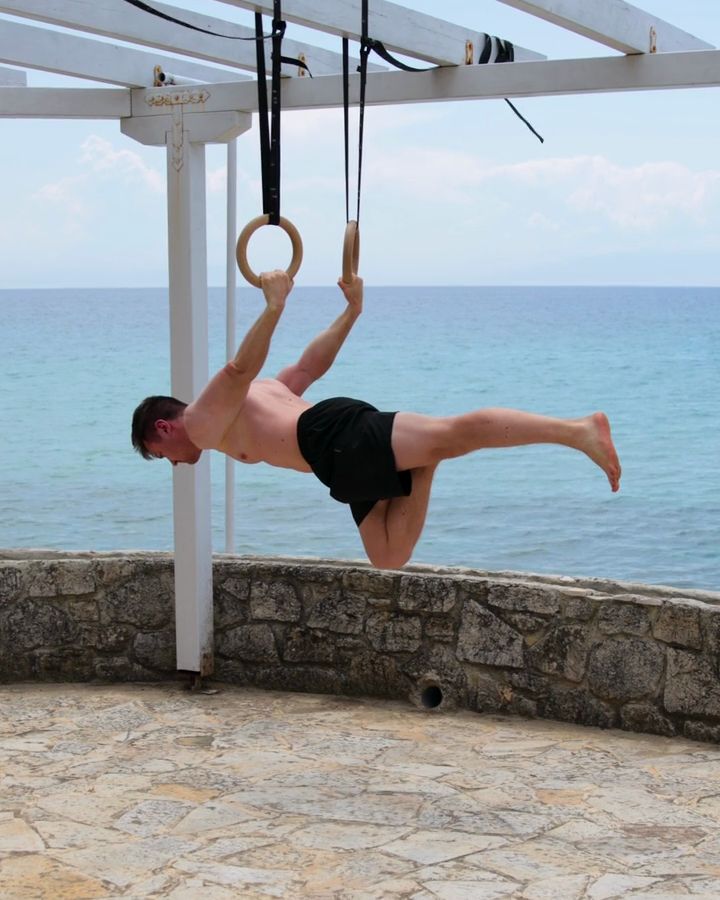
One Leg Back Lever with gym rings
The One Leg Back Lever is a progression exercise in calisthenics that prepares you for the full Back Lever. In this variation, one leg remains straight while the other is bent, reducing the lever arm and making the exercise easier. This variation demands significant strength in the shoulders, biceps, chest, and lower back. Proper technique is crucial: keep your core, glutes, and arm muscles engaged to prevent injuries and perform the exercise effectively.
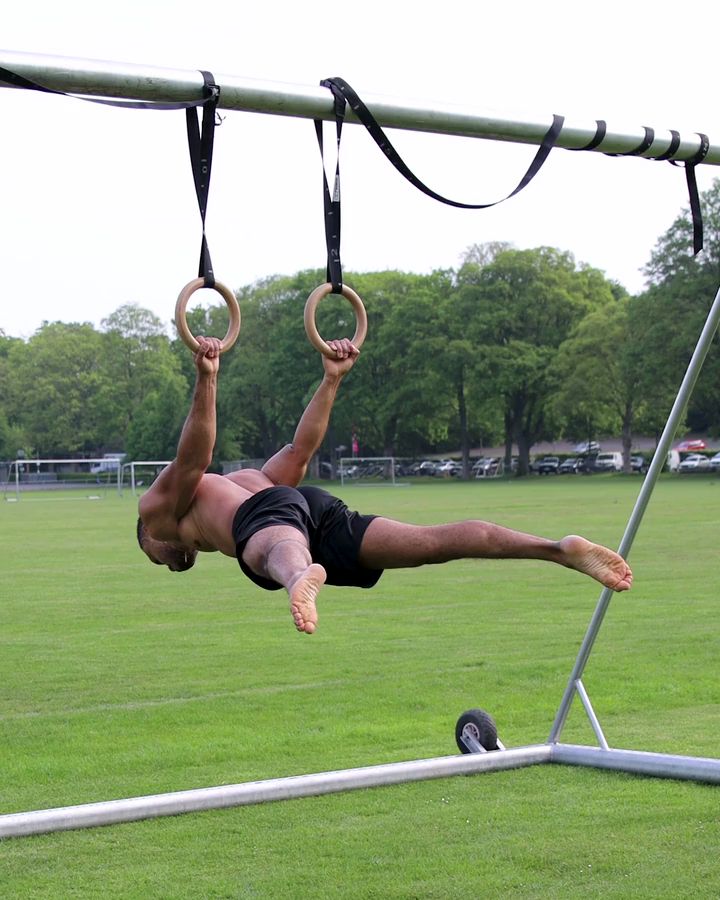
Straddle Back Lever with gym rings
The Straddle Back Lever is a progression exercise in calisthenics that prepares you for the full Back Lever. In this variation, the legs are spread apart to reduce the lever arm, making the exercise easier compared to the full version. This exercise requires strength in the shoulders, chest, biceps, and lower back. Proper technique is essential: keep your core, glutes, and arm muscles engaged to prevent injuries and perform the exercise effectively.
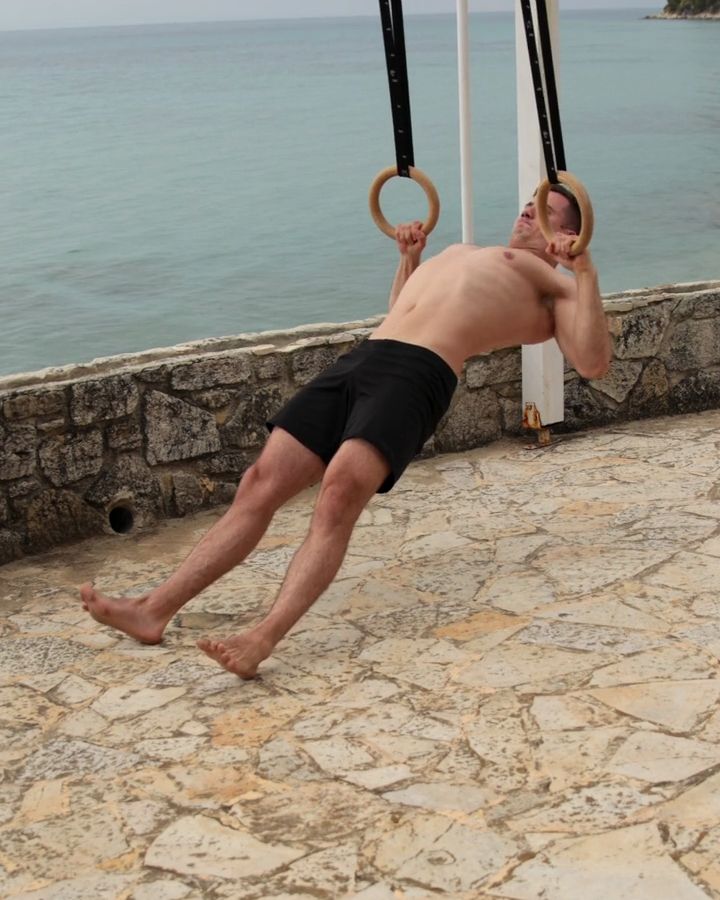
Bulgarian Row with gym rings
Bulgarian Rows on gymnastic rings are an advanced variation of classic ring rows. In this exercise, the elbows are intentionally flared outward to specifically target and intensify the engagement of the upper back muscles.
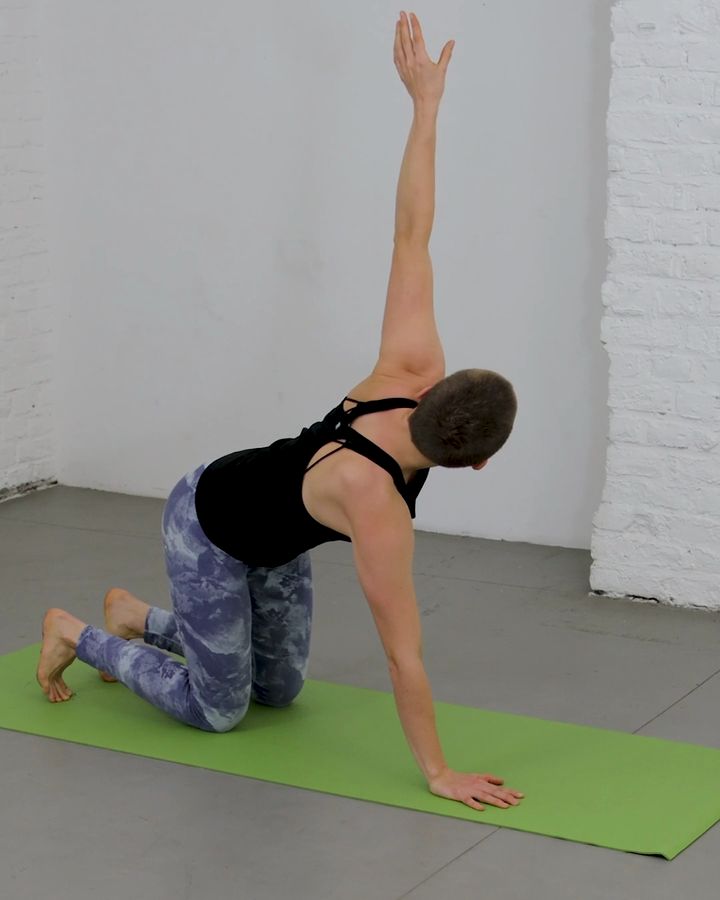
Quadruped Rotation
The quadruped rotation is an effective mobility exercise that primarily improves the flexibility of the thoracic spine and shoulders. From the quadruped position, one arm is slowly stretched out to the side and rotated until the hand points toward the ceiling. This exercise loosens the upper back, promotes core mobility, and is excellent as a warm-up before strength exercises like shoulder presses or pull-ups, where good upper body mobility is essential.
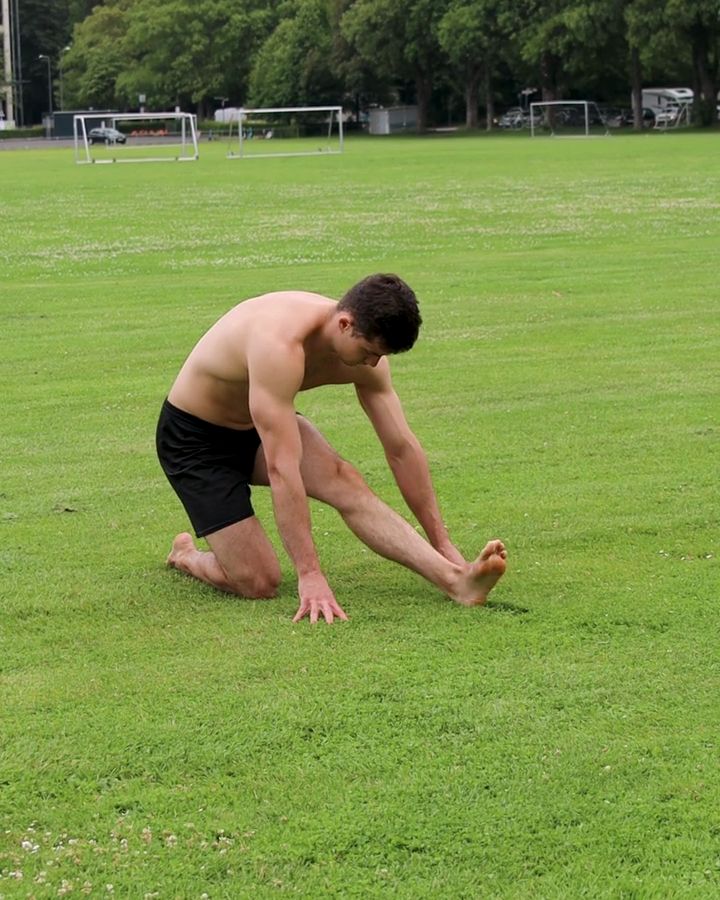
Dynamic Lunge Stretch
The Dynamic Lunge Stretch is a mobility exercise that specifically stretches and mobilizes the hip flexors and hamstrings. From a lunge position, you dynamically alternate between two stretch positions. This exercise is ideal as a warm-up for activities requiring a high degree of hip mobility.
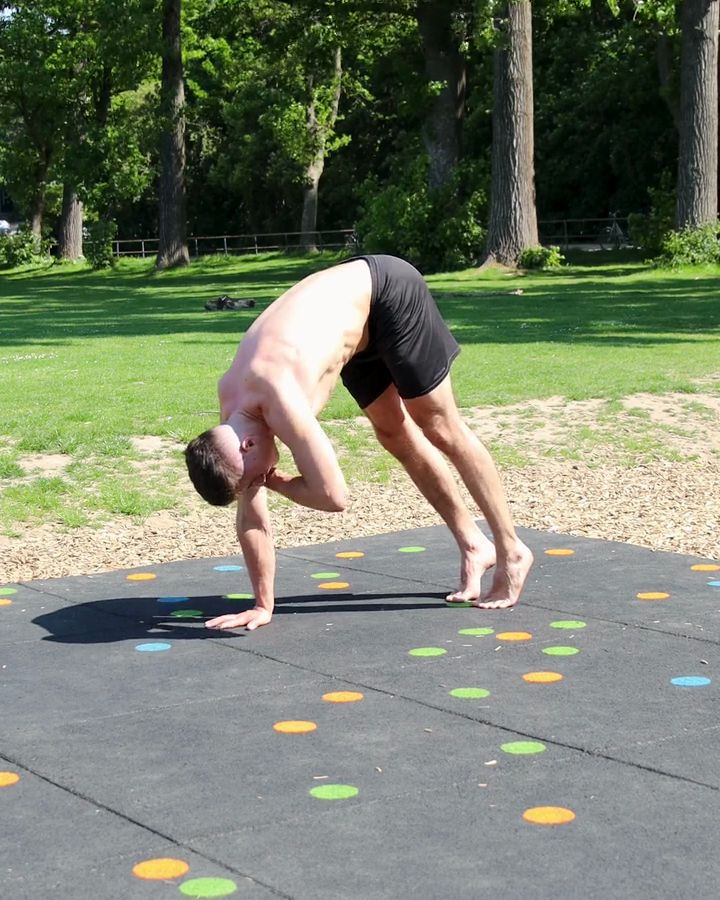
Pike Shoulder Taps
Pike shoulder taps are an effective exercise for strengthening the shoulders and serve as preparation for the strength required in a handstand. In this exercise, you take a pike position—a sort of inverted V, with hands and feet on the ground and hips lifted. From this position, you lift one hand at a time to tap the opposite shoulder while maintaining balance. This exercise intensively activates the shoulders and simultaneously enhances core tension and stability, making it an excellent preparation for the handstand.
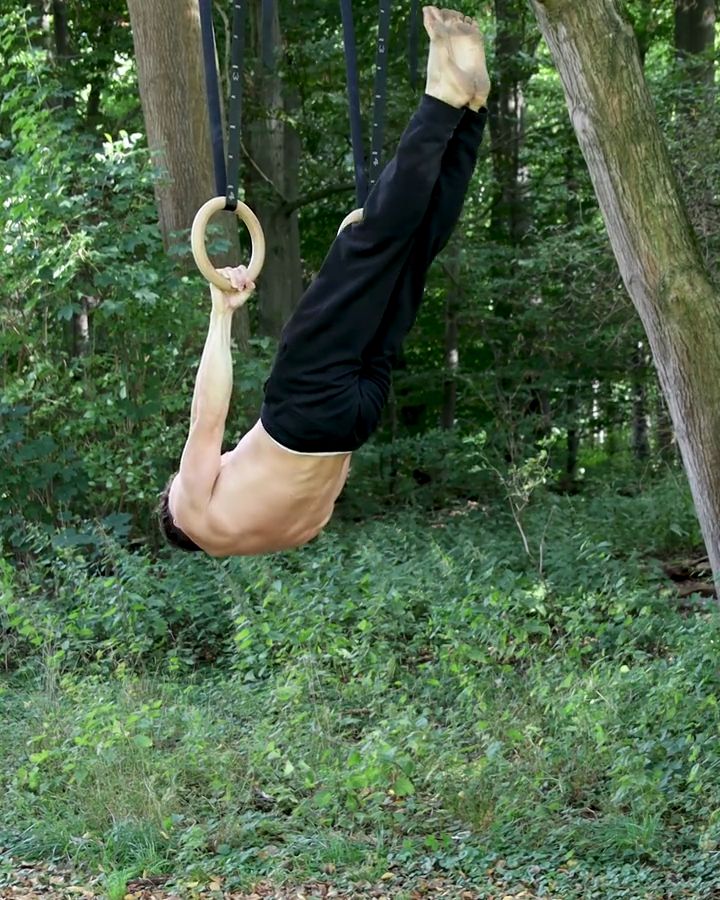
Negative Front Lever with gym rings
The negative front lever on the gymnastics rings is an advanced variation of front lever pulls, training the front lever through the entire range of motion. The exercise begins in a dead hang, from which you slowly lower yourself into the front lever position and eventually end in a hang. This slow descent, also called the negative or eccentric phase, is the key part of the exercise and gives it its name. In the eccentric phase, the body is particularly strong, allowing you to hold the front lever position even if this is not yet possible during the concentric phase (pulling up). This creates an effective training stimulus that specifically strengthens the core, back, and triceps muscles. Negative front levers are therefore ideal for preparing for the full front lever and front lever pulls.
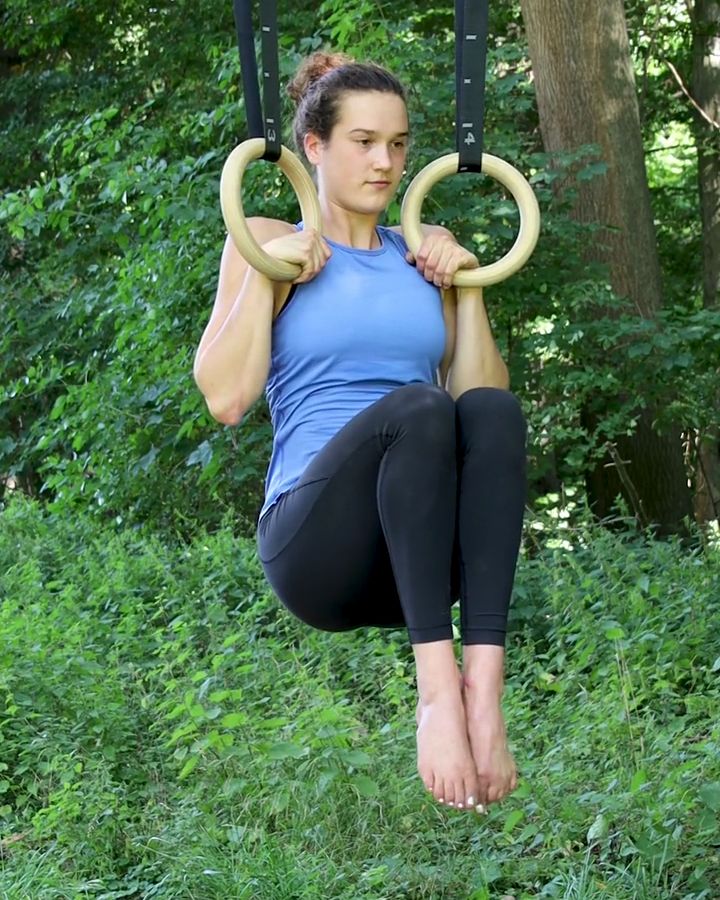
False Grip Hang with gym rings
The false grip is a special gripping technique in calisthenics, where the hand is placed far over the bar or rings. This technique is essential for exercises like the ring muscle-up, as it positions the hands correctly to ease the transition into the dip position. The grip can initially feel difficult and painful, as it puts considerable strain on the wrist muscles and skin. To practice the false grip, start slowly and gradually increase intensity to allow the skin and muscles to adapt. Accessories like grip tape or chalk can also help improve hold.

Deep Squat Rotation
The deep squat rotation is an exercise that enhances hip mobility and thoracic spine flexibility. You enter a deep squat and combine this position with an upper body rotation and arm extension. This exercise became well-known through Ido Portal's squat routine and is now a popular mobility exercise in the deep squat position.
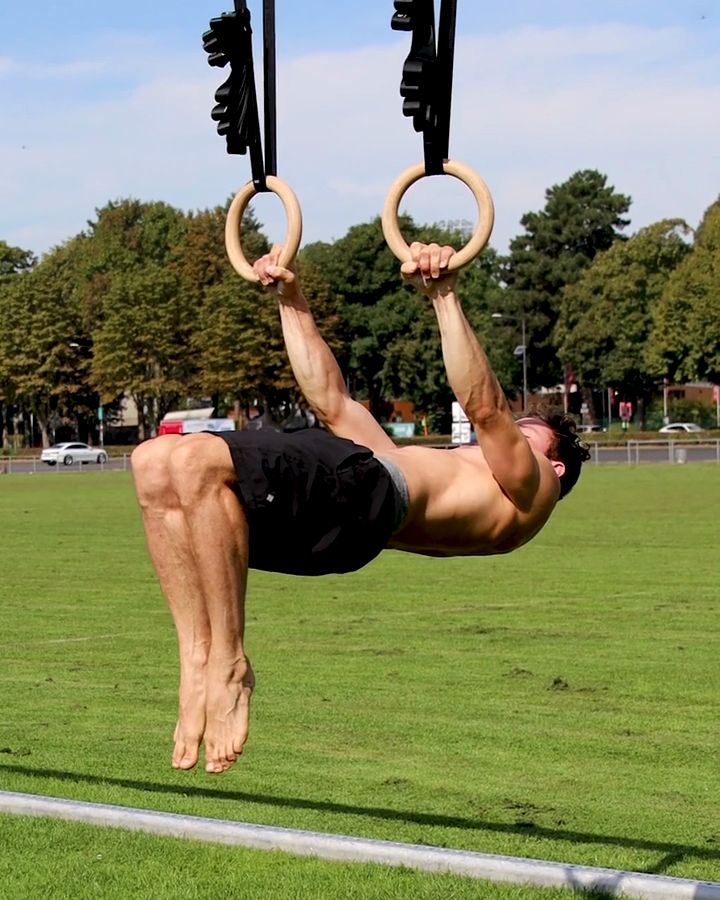
Half Lay Front Lever with gym rings
The Half Lay Front Lever is an easier variation of the Full Front Lever. In this exercise, the body is held horizontally, while the lower legs are bent, and the hips remain in a straight position. Compared to other progressions like the Tuck Front Lever, the Half Lay requires more strength in the back muscles because the straight hips make the lever significantly longer, making the exercise more challenging.
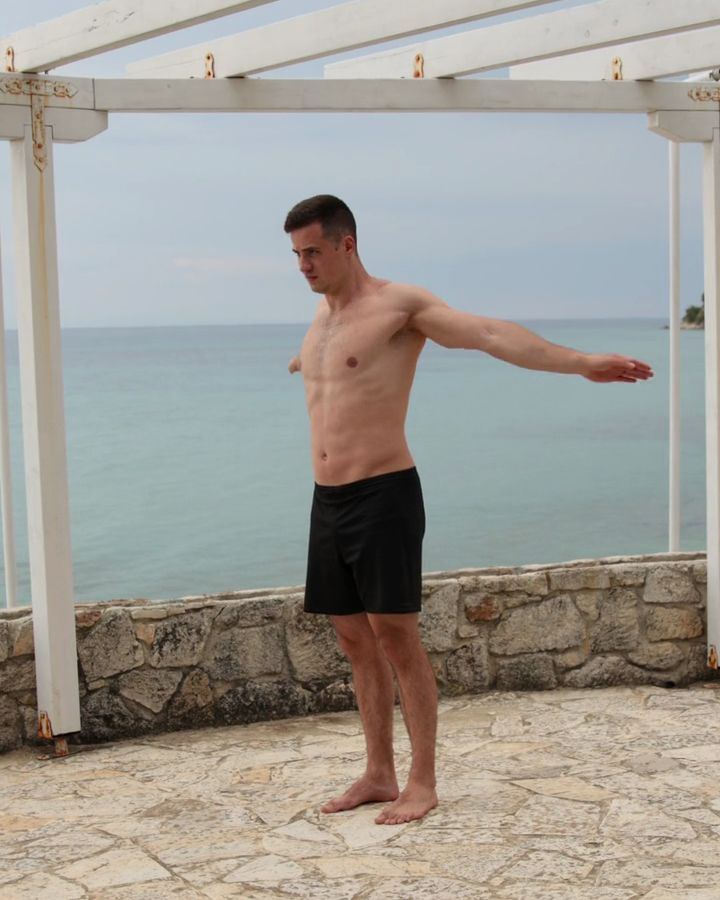
Arm Circles Backward
Backward arm circles are ideal for mobilizing and warming up the shoulder area. The backward circular movements improve flexibility and help release tension, especially in the upper back and neck. This exercise is perfect for warming up and pairs well with forward circles.
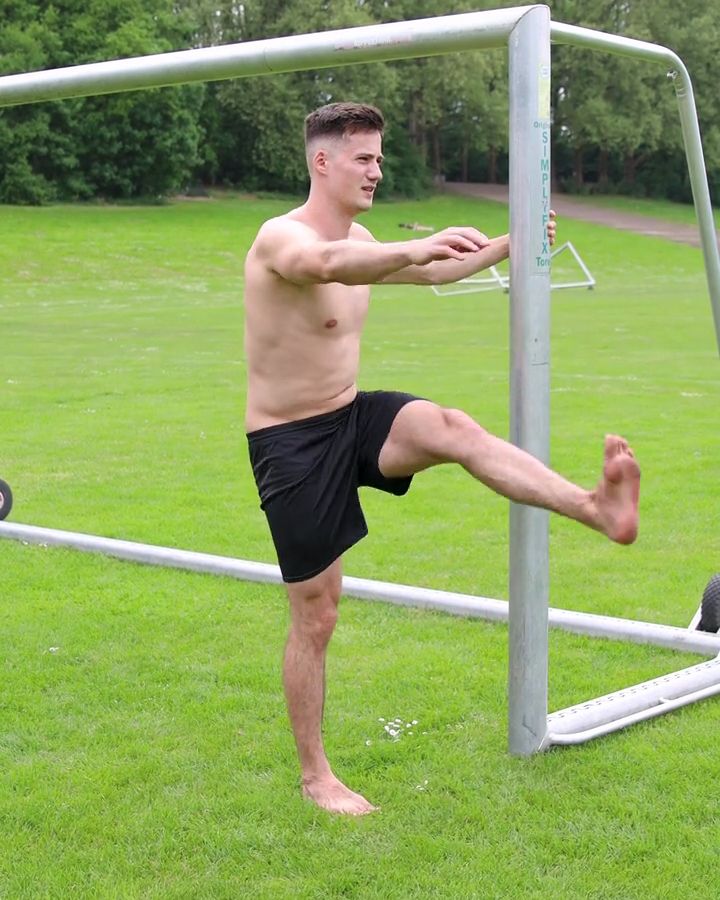
Frontal Leg Swings
Frontal leg swings, also called leg swings, are a dynamic exercise to mobilize the hip and leg muscles. In this exercise, one leg is swung forward and backward while the standing leg remains stable. This movement is ideal as part of a warm-up routine, especially before leg or full-body training.
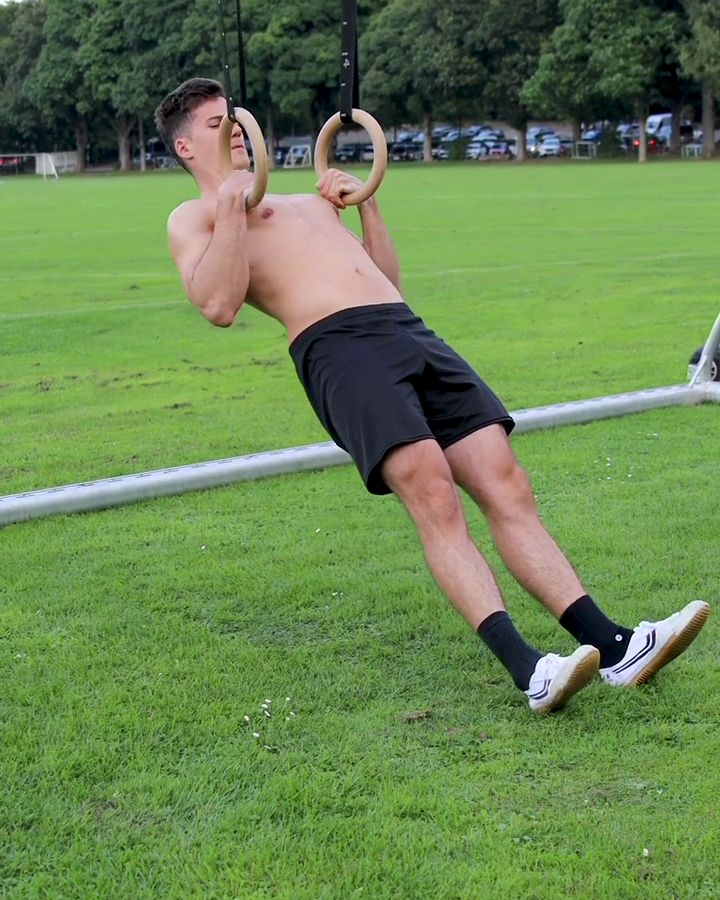
False Grip Row with gym rings
The False Grip Row is very similar to classic rowing on the gymnastic rings, with the difference that the False Grip is used. The False Grip, where the palms extend over the rings, is a technique that is important for exercises like the Ring Muscle Up, as it positions the hands correctly to make the transition to the dip position easier. The grip can initially feel difficult and painful because it puts significant strain on the muscles and skin of the wrist. To train the False Grip, one should start slowly and gradually increase intensity, allowing the skin and muscles to adapt. Accessories like grip tape or chalk can also help improve grip.
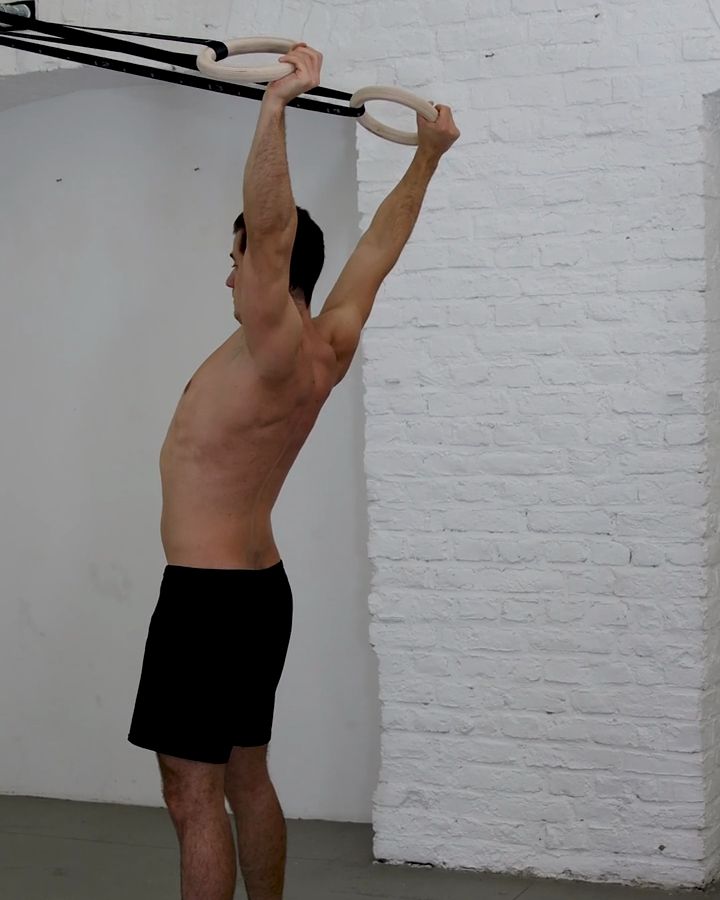
Y Row
The Y Row on the gymnastic rings is often done using a TRX or another suspension trainer. This version of rowing mainly focuses on strengthening the back muscles. You pull your arms into a Y shape, which works your shoulders and upper back, especially the middle and lower parts of the trapezius. The movement is similar to the Face Pulls. Even though there are some similarities, the Y Row is quite different from the classic row.
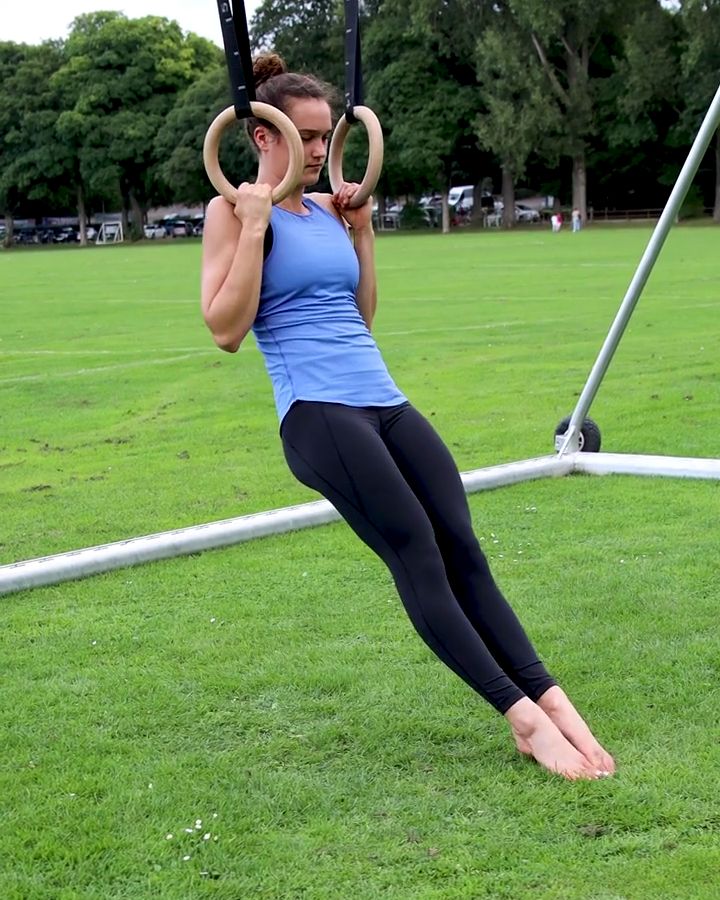
Sitting Pull Ups with gym rings
Sitting Pull Ups on the gymnastic rings are an effective pull-up exercise for your back and biceps. Your feet stay on the ground during the movement, which makes the pull-ups a bit easier than full Pull Ups. This makes the exercise great for learning how to do a free pull-up. If Sitting Pull Ups are too hard for you, assisted Pull Ups might be a better fit.
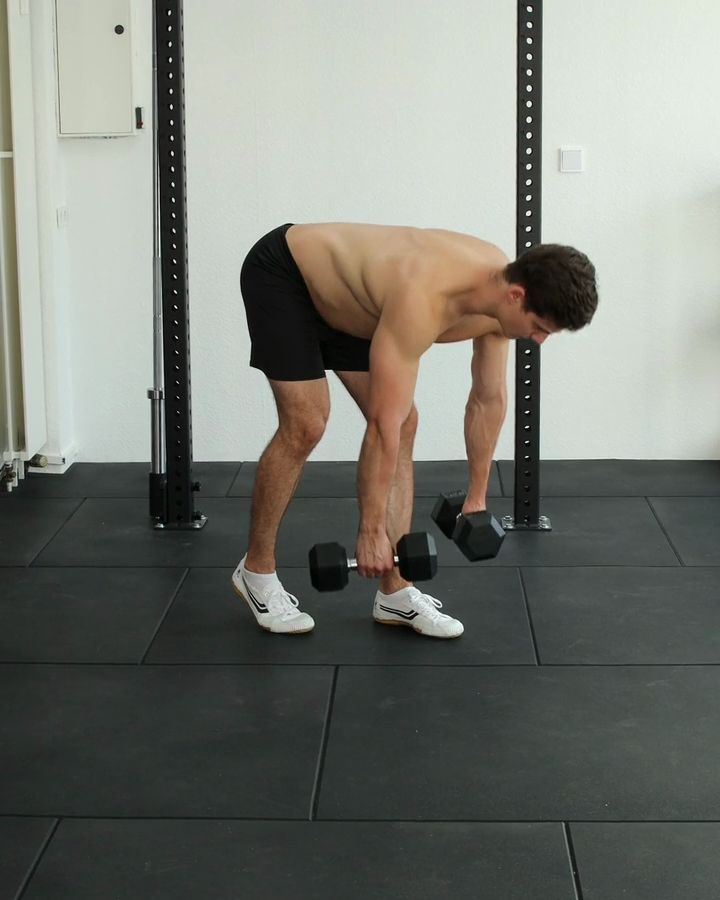
Split Stance Romanian Deadlift with dumbbells
The Split Stance RDL, also called Split Stance Romanian Deadlift, is an effective exercise for strengthening the glutes, back extensors, and hamstrings. The split stance position allows for targeted activation of one leg while the other leg provides stability. This is the advantage of this variation compared to the single-leg deadlift, where there is no stabilizing leg for support. However, both exercises train the muscles in the same way. Another related exercise is the RDL (Romanian Deadlift) where both feet remain on the ground.
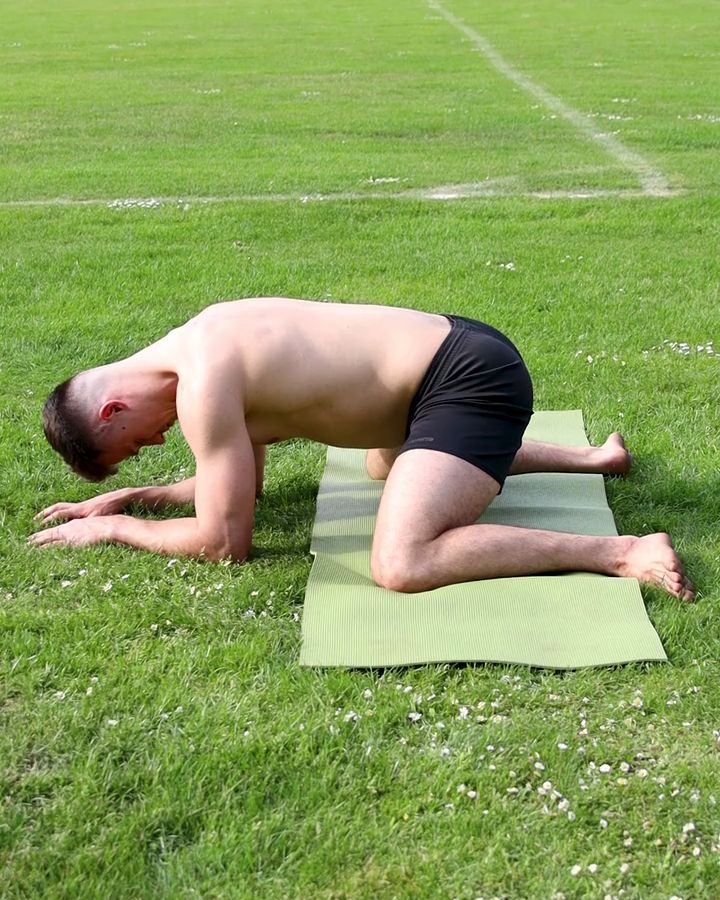
Frog Pose
The Frog Position, also known as Frog Pose or Mandukasana in yoga, is an effective exercise that specifically stretches the hips and groin area. Often referred to as the frog stretch or frog sit, it is popular in both yoga and stretching routines. This pose offers numerous benefits, from improving digestion to relieving lower back tension. To perform the frog position, kneel on the ground, spread your legs sideways, and lean your upper body forward. It’s an excellent way to promote hip flexibility and release tension. A perfect complement to this exercise is the Pigeon Stretch. While the frog position stretches the inner hips, the pigeon stretch targets the opposing muscles and the outer hips. Together, these exercises provide a balanced and effective routine.
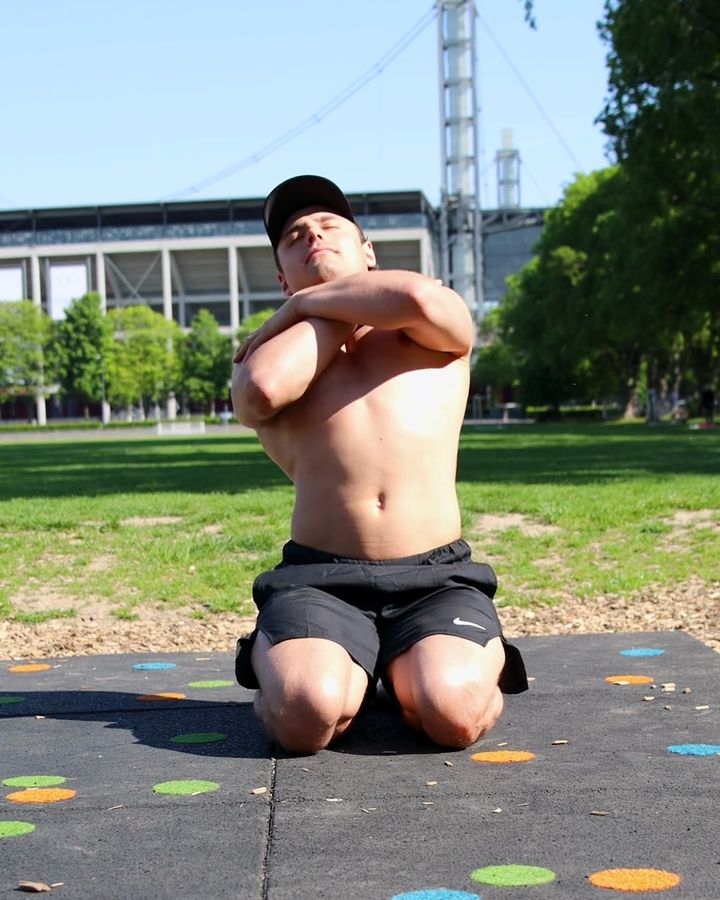
Spine CARs
Spinal CARs, also called Spine CARs or Controlled Articular Rotations of the spine, are exercises designed to improve spinal mobility and control. They involve slow, rotating movements that extend through the entire length of the spine. These exercises are often integrated into mobility routines to promote spinal health and maintain flexibility and stability. Similarly, Cat-Cow-Exercises also help improve spinal mobility. In this exercise, the spine moves between a flexed and an extended position. Thoracic Rotations are another exercise that specifically targets the thoracic spine. They enhance mobility and rotational ability in the upper back.
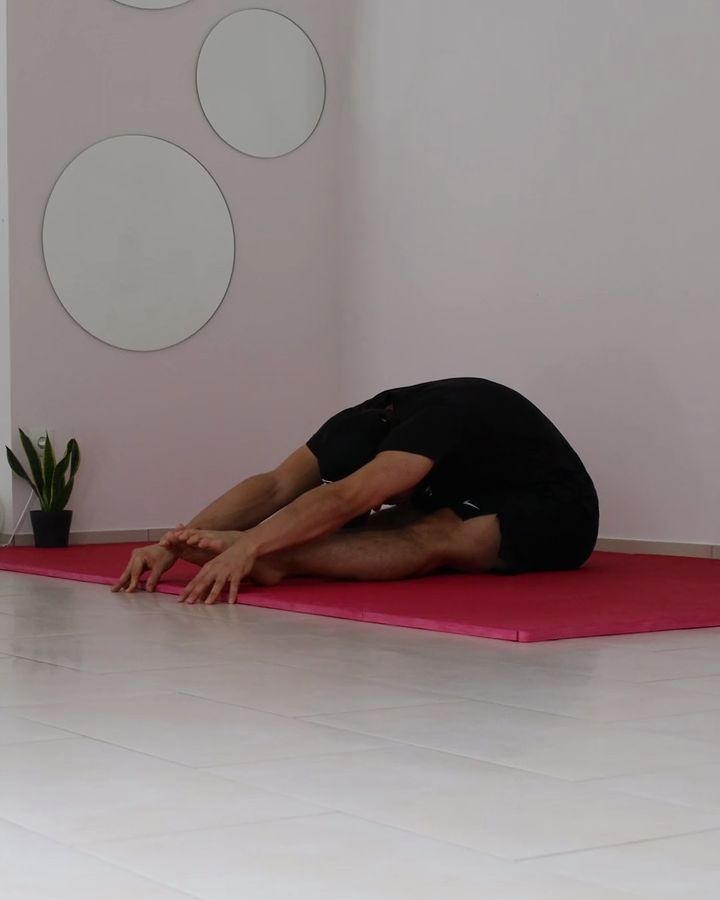
Paschimottanasana - Seated Forward Bend
The seated forward bend, also known as Paschimottanasana, is a yoga exercise that stretches the back of the body, including the lower back and the back of the legs. You sit with your legs extended and bend your upper body forward to reach for your feet or legs. Similarly, the Standing Forward Bend, also known as Jefferson Curls, involves letting the upper body hang down from a standing position to stretch the back of the body as well. Another variation is the forward bend with spread legs, also known as Pancake, where the legs are spread to the sides to additionally stretch the inner thighs.
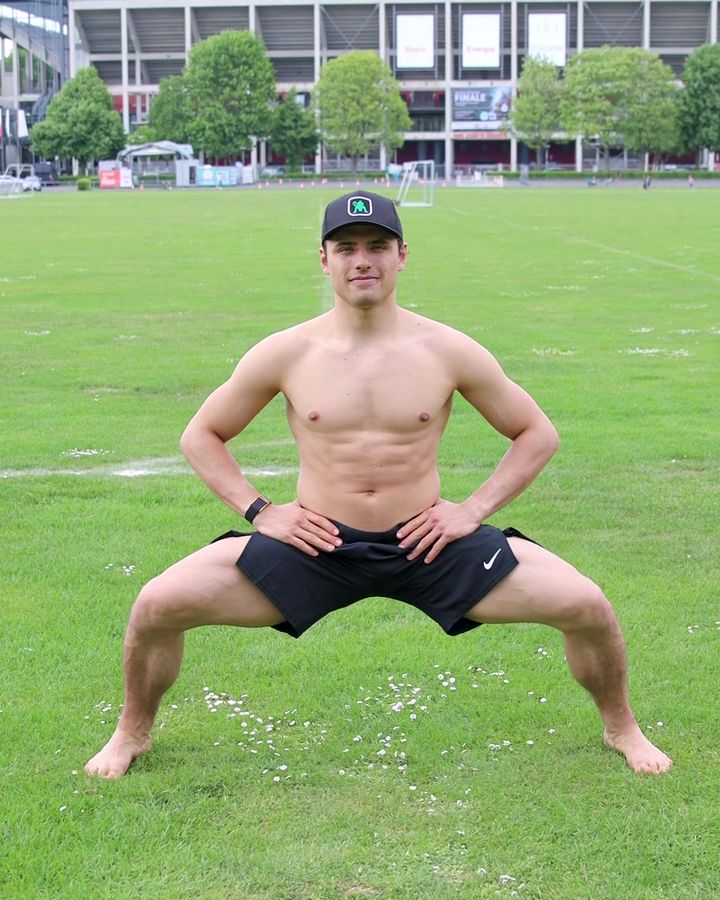
Horse Stance
The Horse Stance, also known as Mǎbù, is a common posture in Asian martial arts and an effective exercise for strengthening both body and mind. This stance improves strength, endurance, and flexibility while promoting mental resilience. Start in a wide squat with your thighs parallel to the ground. Keep your back straight, push your hips slightly back, and press your knees outward. This isometric position engages the muscles of the hips, adductors, glutes, and legs. The Horse Stance enhances hip and leg mobility through "static strength stretches." This combination of stretching and strength training sustainably increases flexibility and strengthens the muscles in their end range.
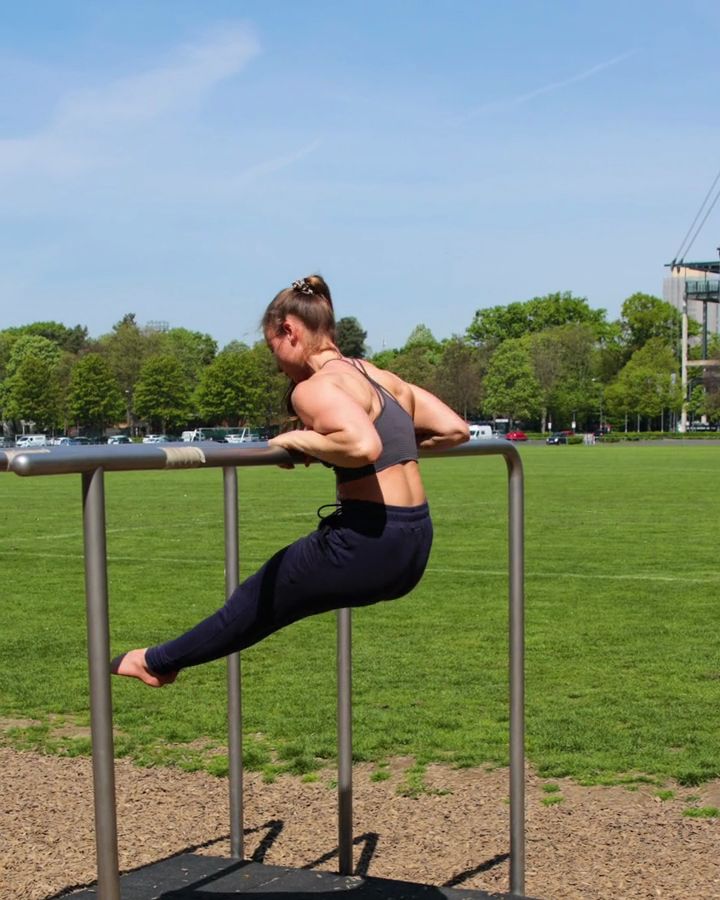
Negative Bar Muscle Ups
Negative Bar Muscle Ups are an excellent preparatory exercise for the Bar Muscle Up. You jump from a standing position to get into the top position on the bar, then lower yourself slowly and with control. This exercise is often combined with explosive pull-ups. Together, these exercises form the most important foundation for effectively learning the Bar Muscle Up.
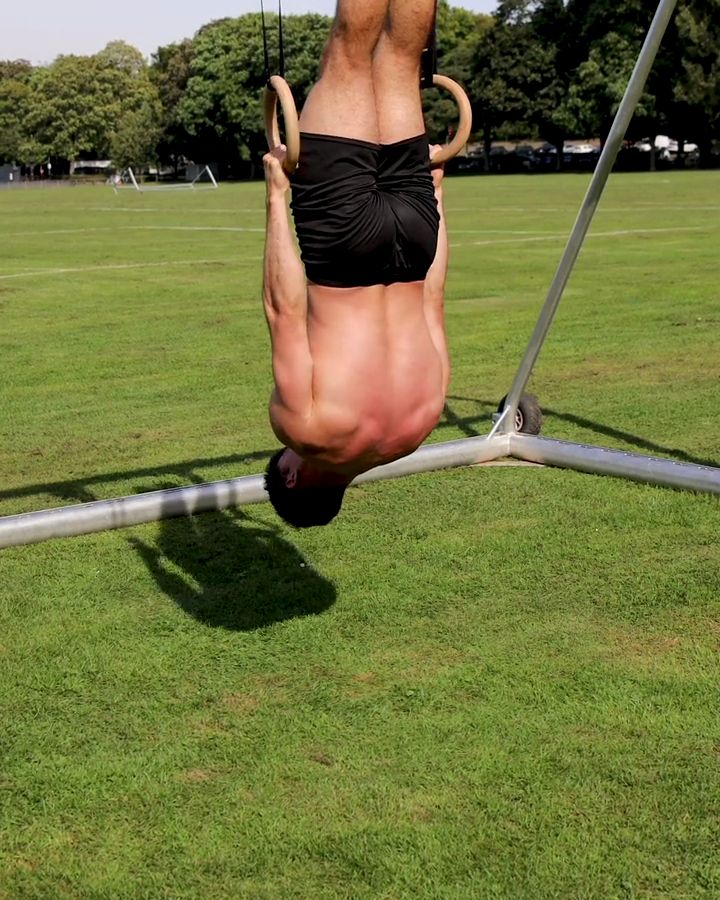
Upside Down Pull Ups with gym rings
Upside Down Pull Ups target the muscles in the upper back, neck, and biceps. They are often performed on gymnastic rings or a bar and require the body to hang upside down. Although the exercise has Pull Up in its name, traditional pull-ups focus much more on the latissimus and less on the upper back and neck.
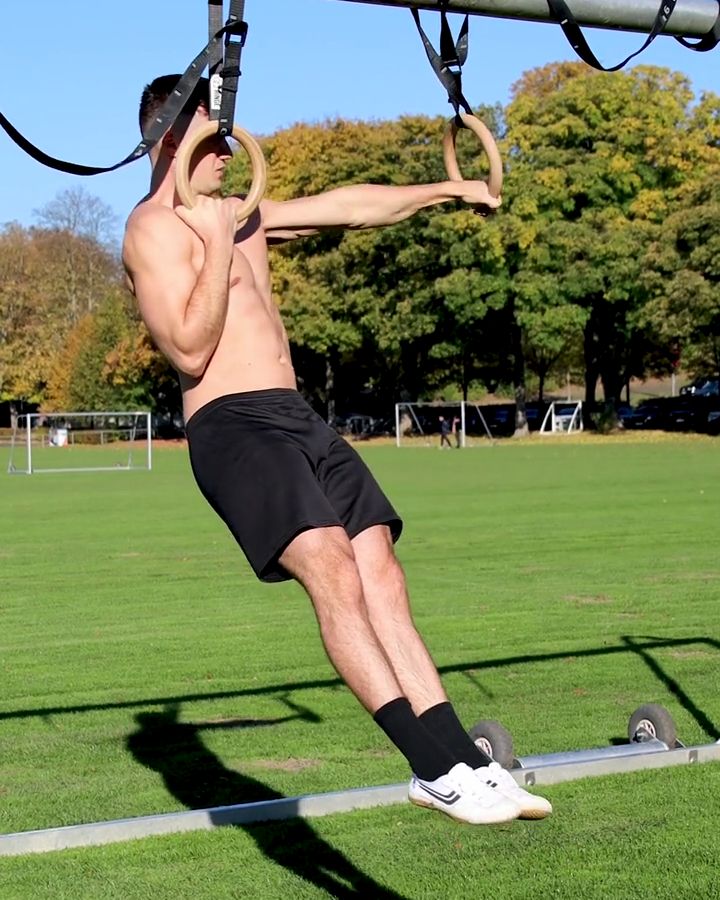
Typewriter Pull Ups
Typewriter Pull Ups are a Pull-Up variation where you alternately extend the left and right arm to the side while hanging in a bent-arm position. Typewriter Pull Ups look similar to Archer Pull Ups, but they are much easier.
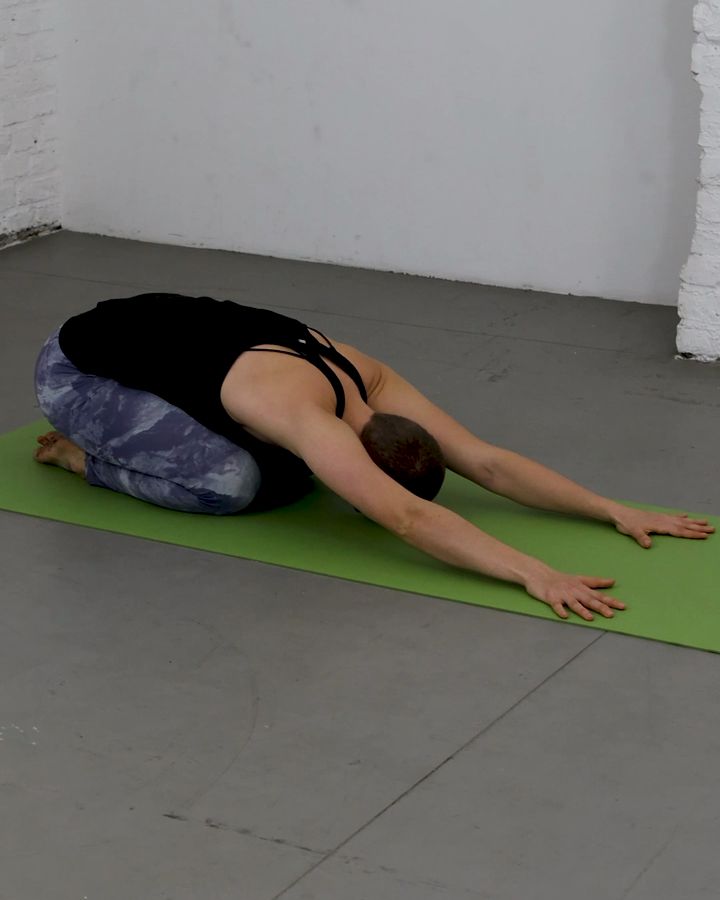
Balasana, Child Pose
Balasana, also known as Child's Pose, is a relaxing yoga exercise. It gently stretches the back, hips, and thighs. You kneel on the ground and bend your upper body forward with your arms extended. It is a calming pose that can help reduce stress. A related exercise is the Spine Twist, which gently stretches and relaxes the lower back muscles.
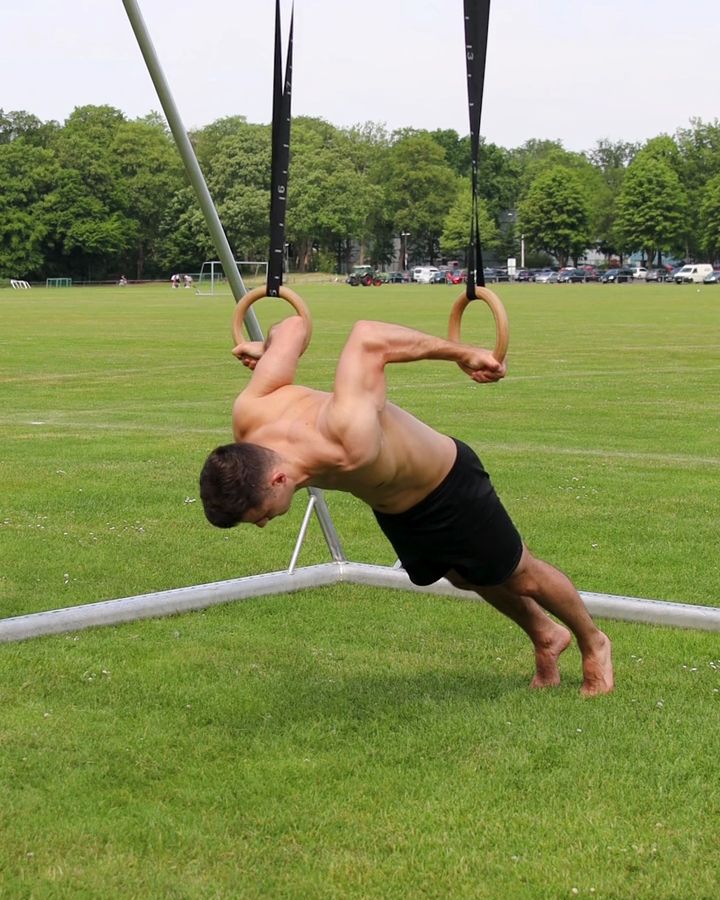
Pelican Curls with gym rings
All bicep curls are excellent for building strong and large biceps, but few exercises offer a similar combination of chest, shoulder, and bicep stretch as the Pelican Curl. This exercise trains the biceps in an extremely stretched position, making it particularly effective for building strength and muscle mass. The Pelican Curl is performed on rings. The intense stretch not only targets the biceps but also mobilizes the shoulder muscles. It takes time to adapt to the strain of this exercise, especially in the shoulders and elbows. Start slowly with a higher body position or a less steep angle. Controlled movements are crucial to avoid injuries and get the most benefit from the exercise. The Pelican Curl is ideal for advanced athletes looking to take their bicep training to the next level while also stretching their chest and shoulder muscles. Incorporate it into your routine to simultaneously increase strength and flexibility.
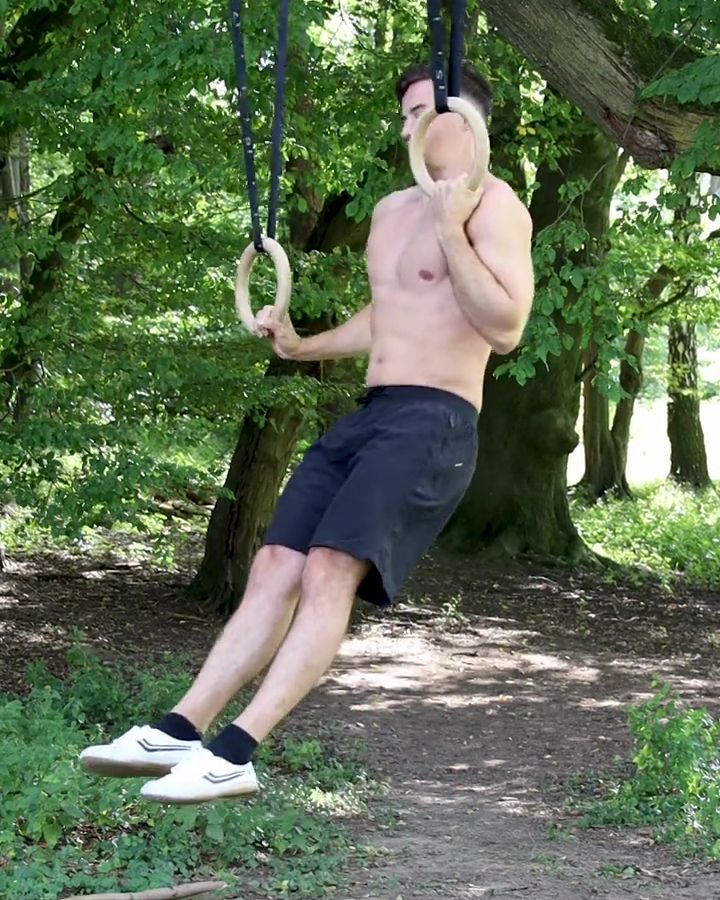
Uneven Pull Ups
Uneven Pull Ups, also called Uneven Chin Ups, are an effective exercise for the back and arm muscles when performed on gymnastic rings. The rings are set at different heights, creating an uneven load and making the workout more intense. This exercise is a great preparation for one-arm pulling movements like the One Arm Pull Ups or the Archer Pull Up.
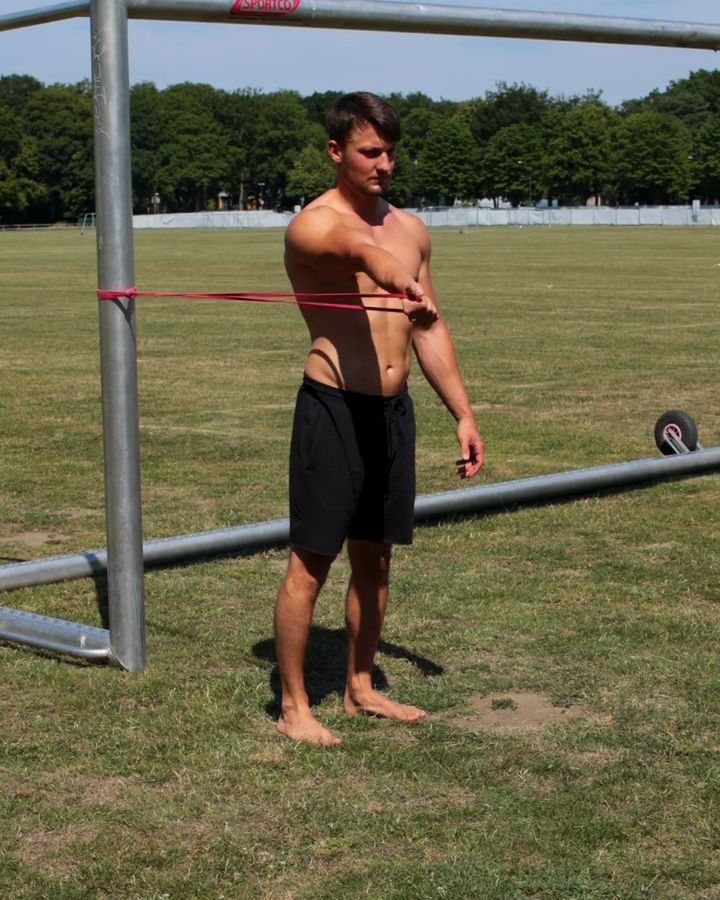
Front Raises with a band
Front raises with a band are an exercise that specifically targets the shoulder muscles, particularly the front deltoids. A resistance band is used, creating constant tension as you lift your arms forward and upward. In calisthenics, front raises are often used as a warm-up for Planche training. The exercise warms up the shoulder flexion—the same movement pattern that plays a key role in the Planche. Regularly practicing front raises helps prepare the shoulders for high-intensity exercises while also minimizing the risk of injury.
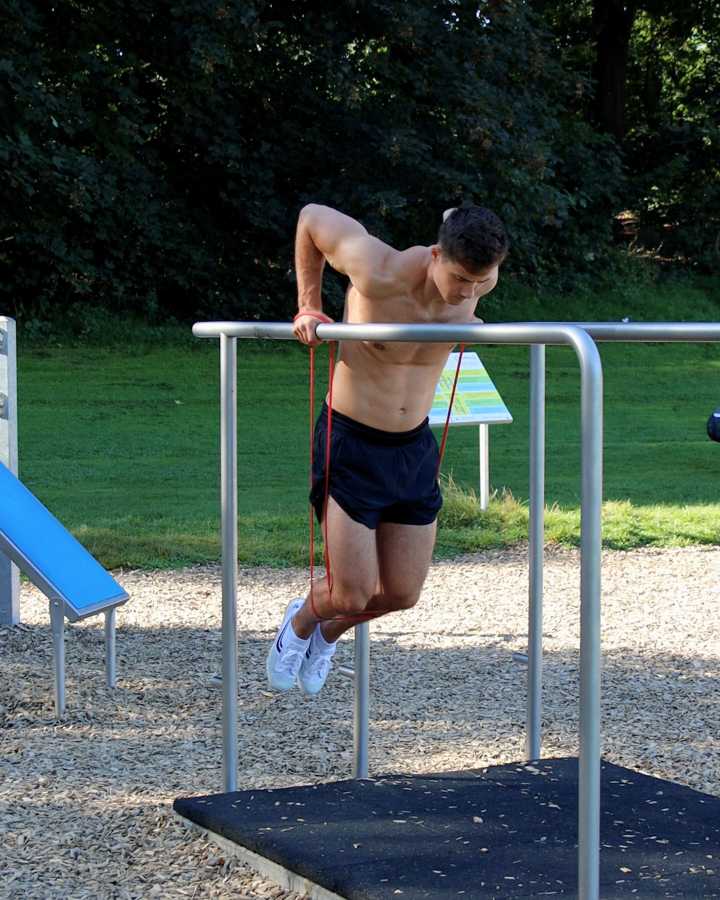
Band Assisted Dips
Parallel bar dips with the support of a resistance band are an ideal way to learn or improve the technique for Dips. The band reduces body weight, making the exercise more accessible and allowing for proper execution. It is particularly beneficial for beginners to build the necessary strength in the chest, shoulders, and triceps without risking overuse injuries. Additionally, different resistance bands can be used to make the exercise easier or harder. This variation is suitable for both beginners and advanced practitioners looking to increase their number of repetitions.
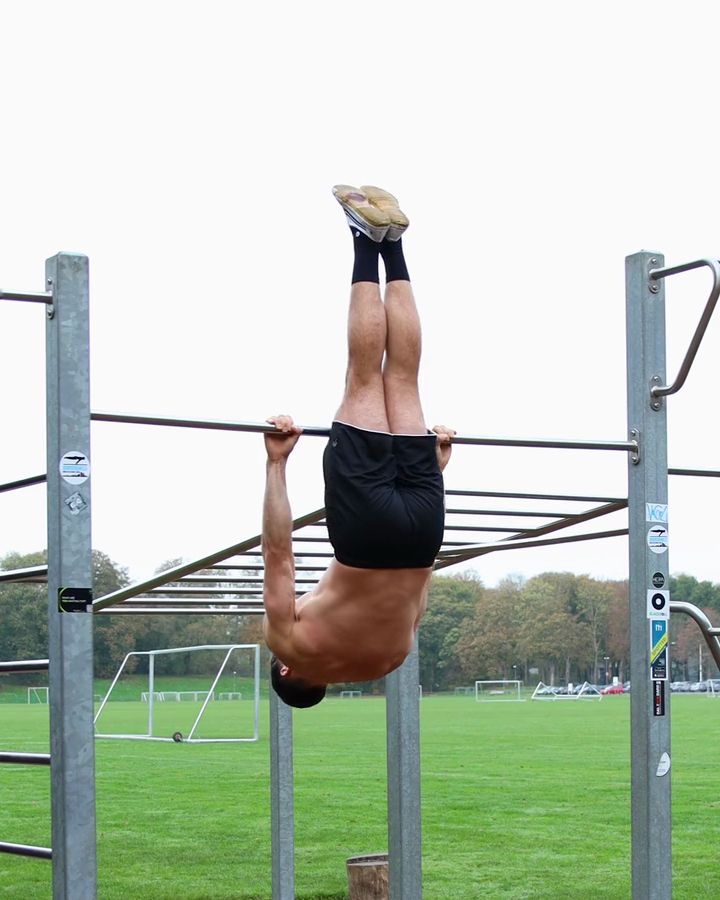
Reverse Deadlift, Inverted Deadlift
The Inverted Deadlift, also known as the Reverse Deadlift, is an effective exercise to improve body control, core stability, and strength. It serves as a foundation for advanced skills like the pullover or various Front Lever variations. In addition to the abdominal muscles, it specifically targets the latissimus and the long head of the triceps through retroversion of the upper arm.
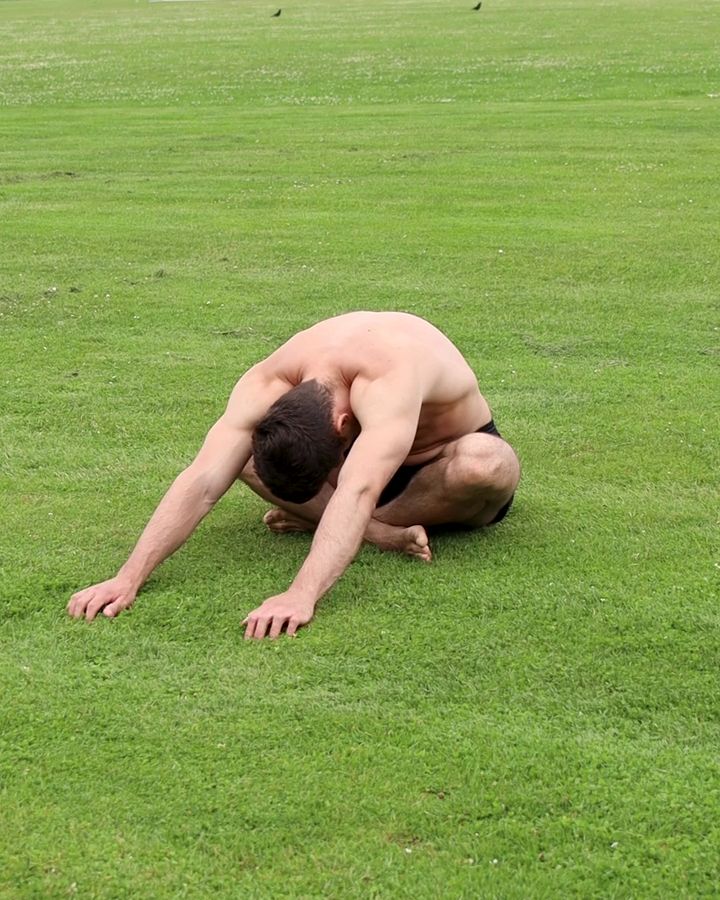
Cross Legged Sitting
The cross-legged sitting position is a simple yet effective posture often used in yoga, meditation, and as a stretching exercise. In this position, the legs are crossed in front of the body so that the knees point outward and the feet rest beneath the thighs. This position promotes hip flexibility and strengthens the core muscles, as it requires an upright posture. For beginners or individuals with limited hip mobility, placing a cushion or block under the hips can make the position more comfortable and sustainable. The cross-legged sitting position is excellent for improving hip joint mobility and gently stretching the leg muscles. Practicing this position regularly can help enhance sitting posture and develop body awareness. The kneeling position is another seated yoga posture, but it focuses more on knee flexion.
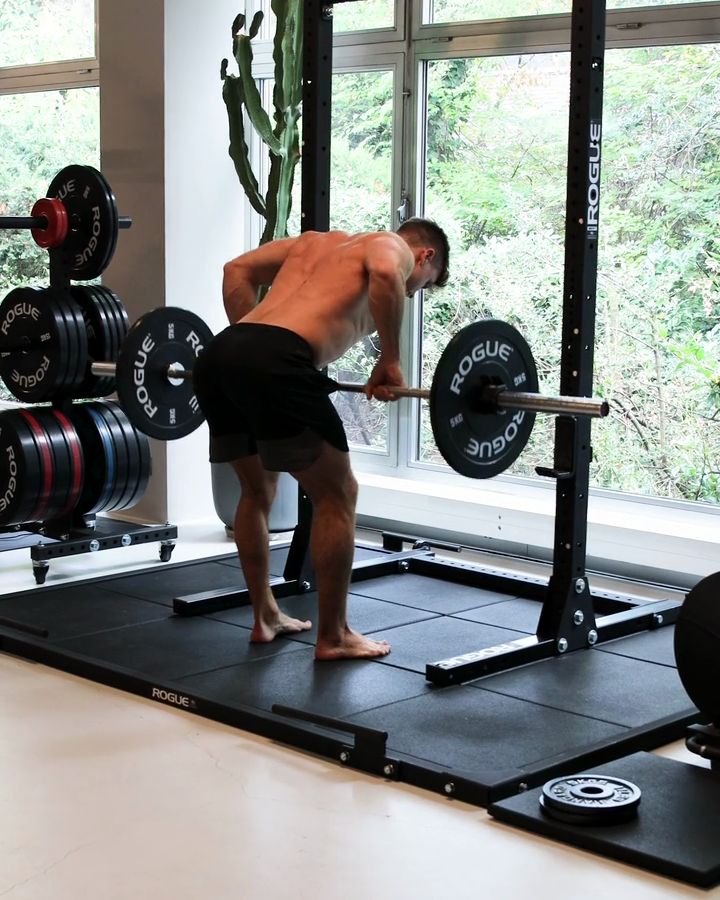
Bent Over Rows with a Barbell
The bent-over row with a barbell is a fundamental exercise for the upper back, latissimus, and rear shoulder muscles. The upper body is leaned forward while the barbell is pulled in a controlled manner toward the lower abdominal area. This exercise can also be done with dumbbells.
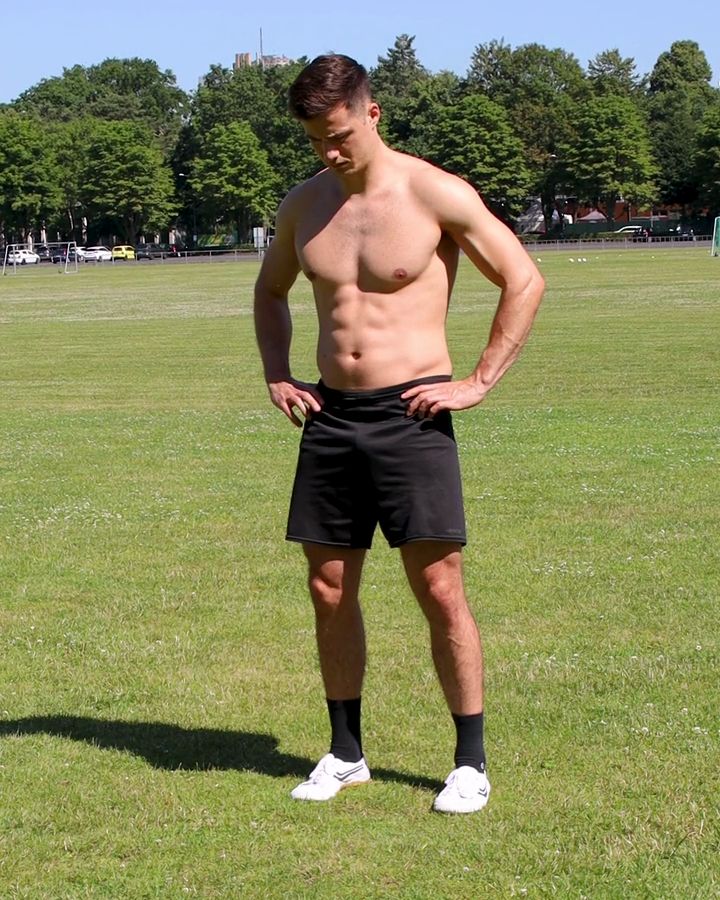
Anterior and Posterior Pelvic Tilt
The control of pelvic positioning is crucial for a healthy posture and efficient movement execution. An exercise that specifically improves mobility and awareness of pelvic control is the transition between anterior and posterior pelvic tilt while standing (APT to PPT). Mastering this movement pattern is essential for countless calisthenics and gymnastics exercises, such as the Handstand, Hollow Body Hold, or Front Lever.
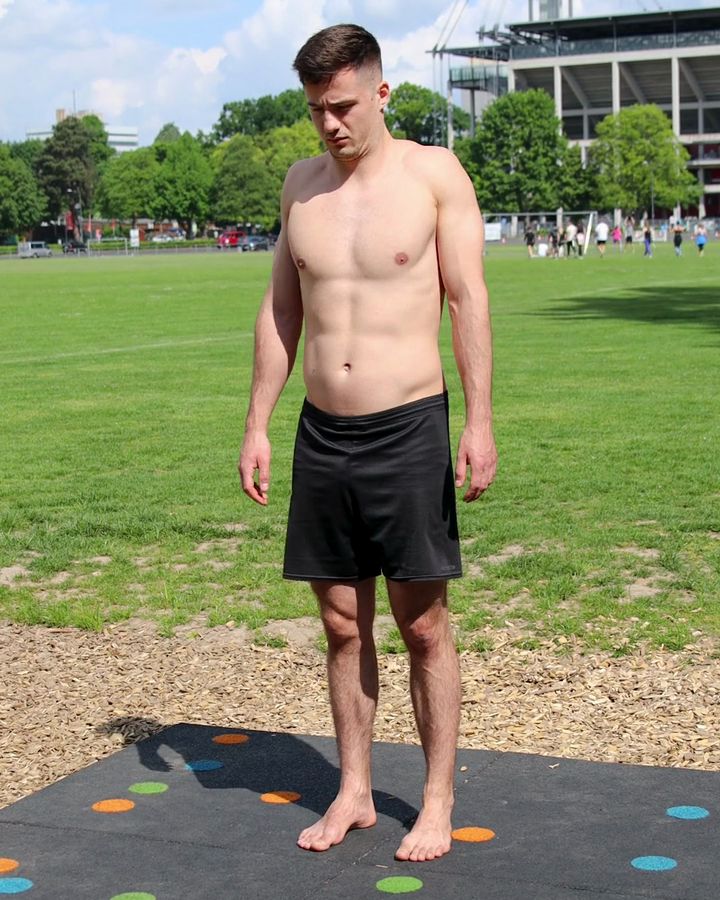
Shoulder Circles
Shoulder Circles, also known as shoulder rolling, are a simple but very effective mobility exercise for the shoulder joint. You let your arms hang loosely at your sides, slowly lift your shoulders up, and then move them in a smooth, circular motion—backwards, down, and up to the front again. This exercise loosens tight muscles, boosts blood flow, and improves mobility in the shoulder and neck area. It’s perfect as part of a warm-up before training or for active recovery on rest days. Especially after sitting for a long time—like at the office—a few minutes of shoulder circles can work wonders. As an alternative, you can try Arm Circles, where you draw big or small circles in the air with your arms extended. This also activates your arms and chest muscles.
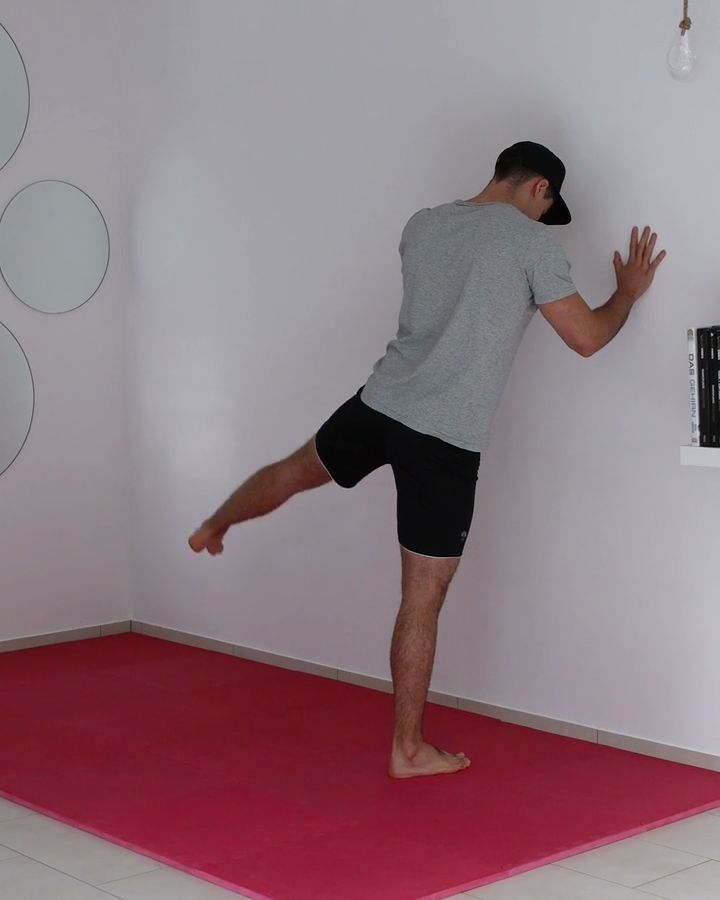
Side Leg Raises
Side Leg Raises are an exercise that mainly trains the hip abductors. You stand, hold on to something for balance, and lift one leg out to the side while the other stays on the ground. This exercise helps with hip flexibility and makes your hip muscles stronger. It is especially good for improving active flexibility for the Spide Split. A similar exercise is Lateral Leg Swings, but these are mostly used as a warm-up.